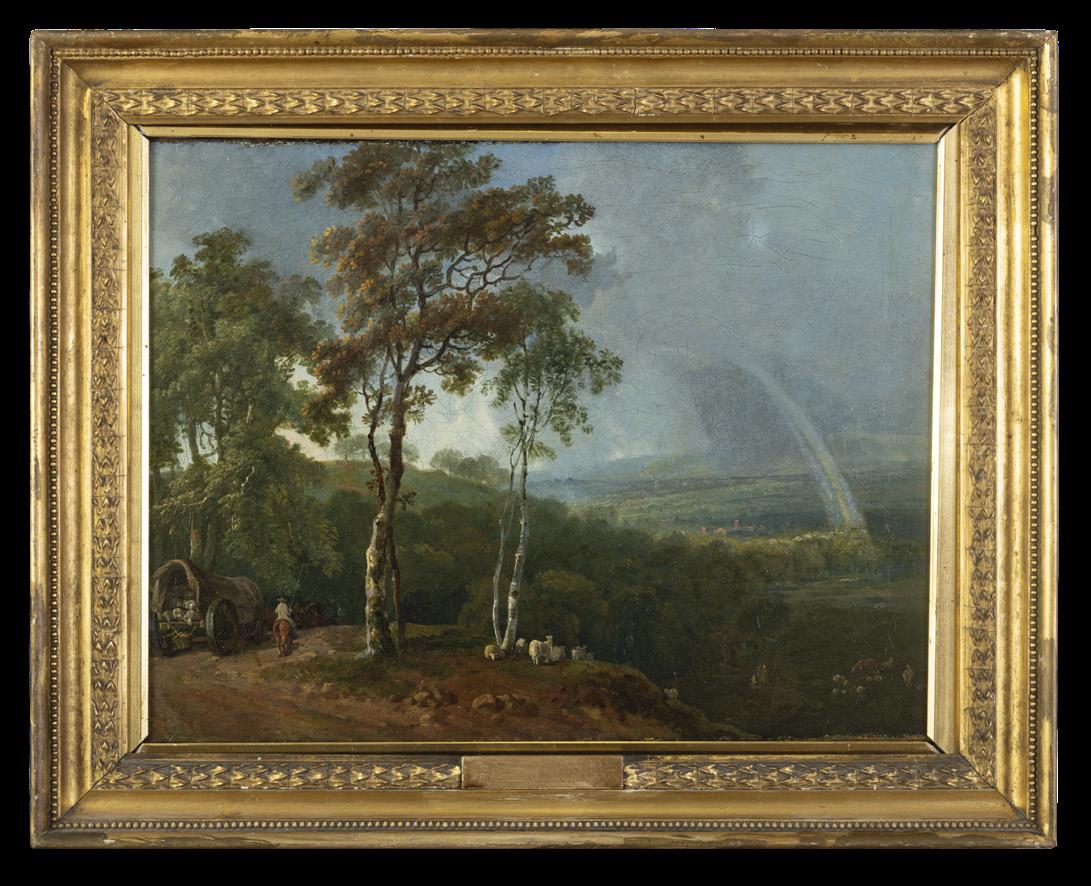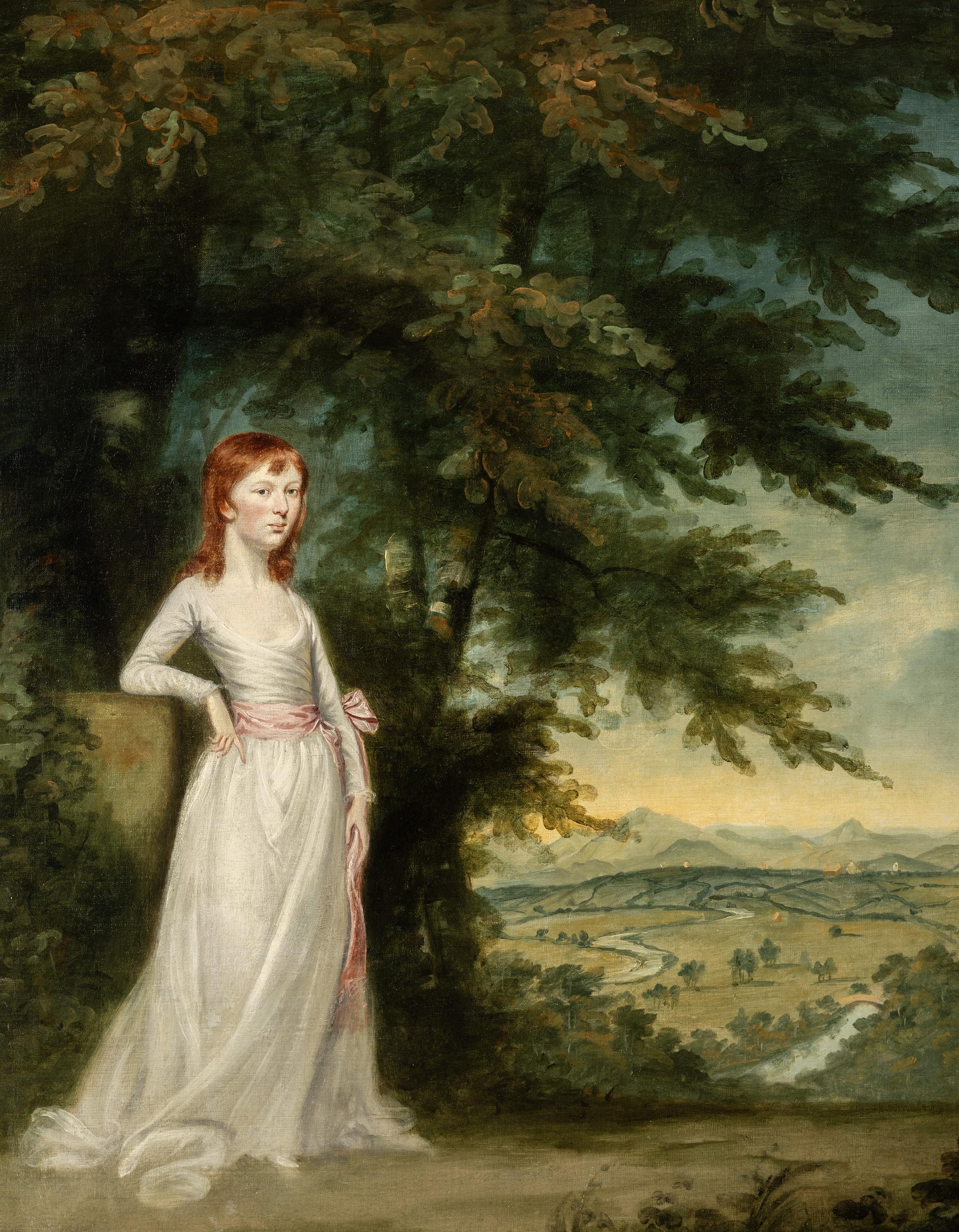
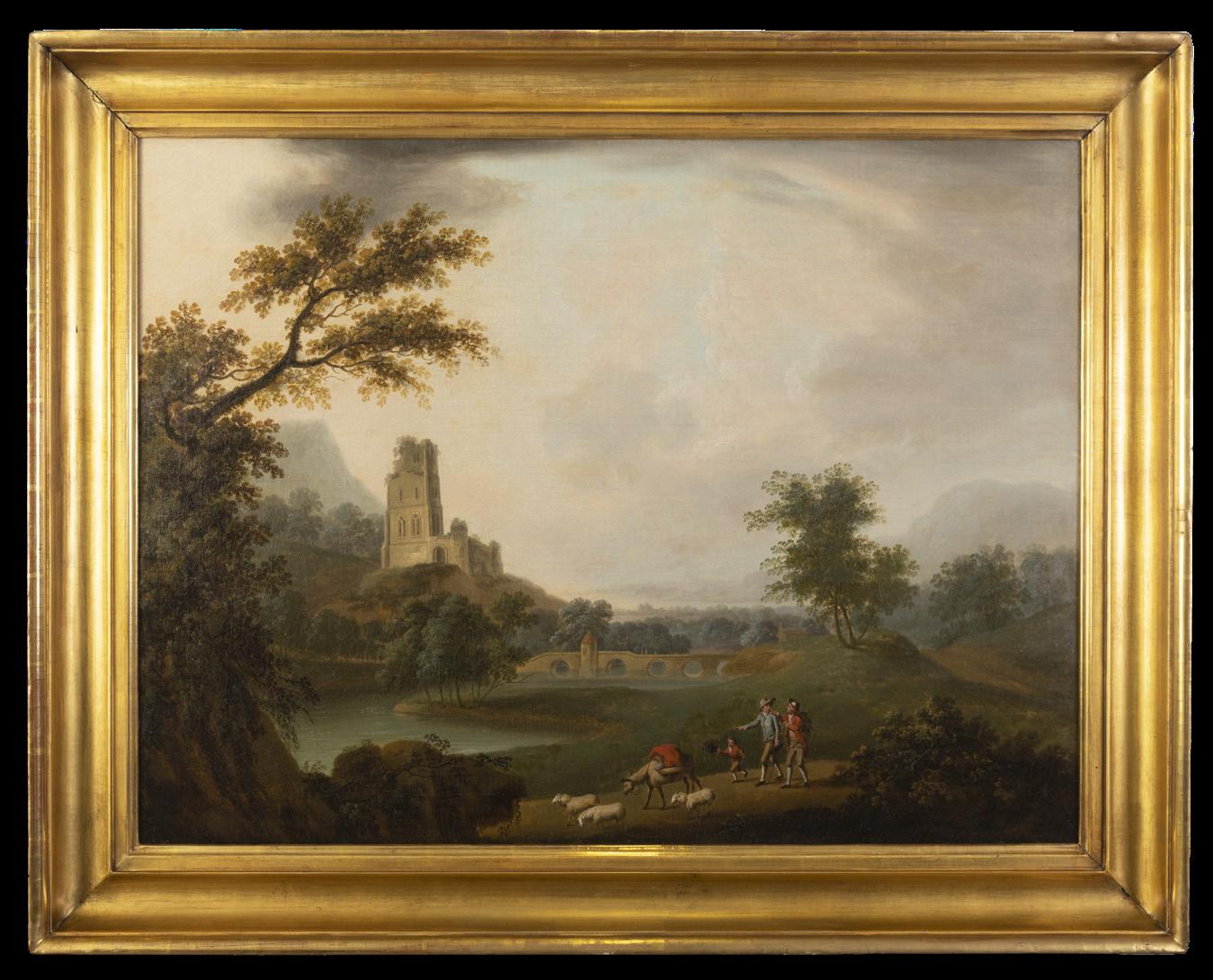
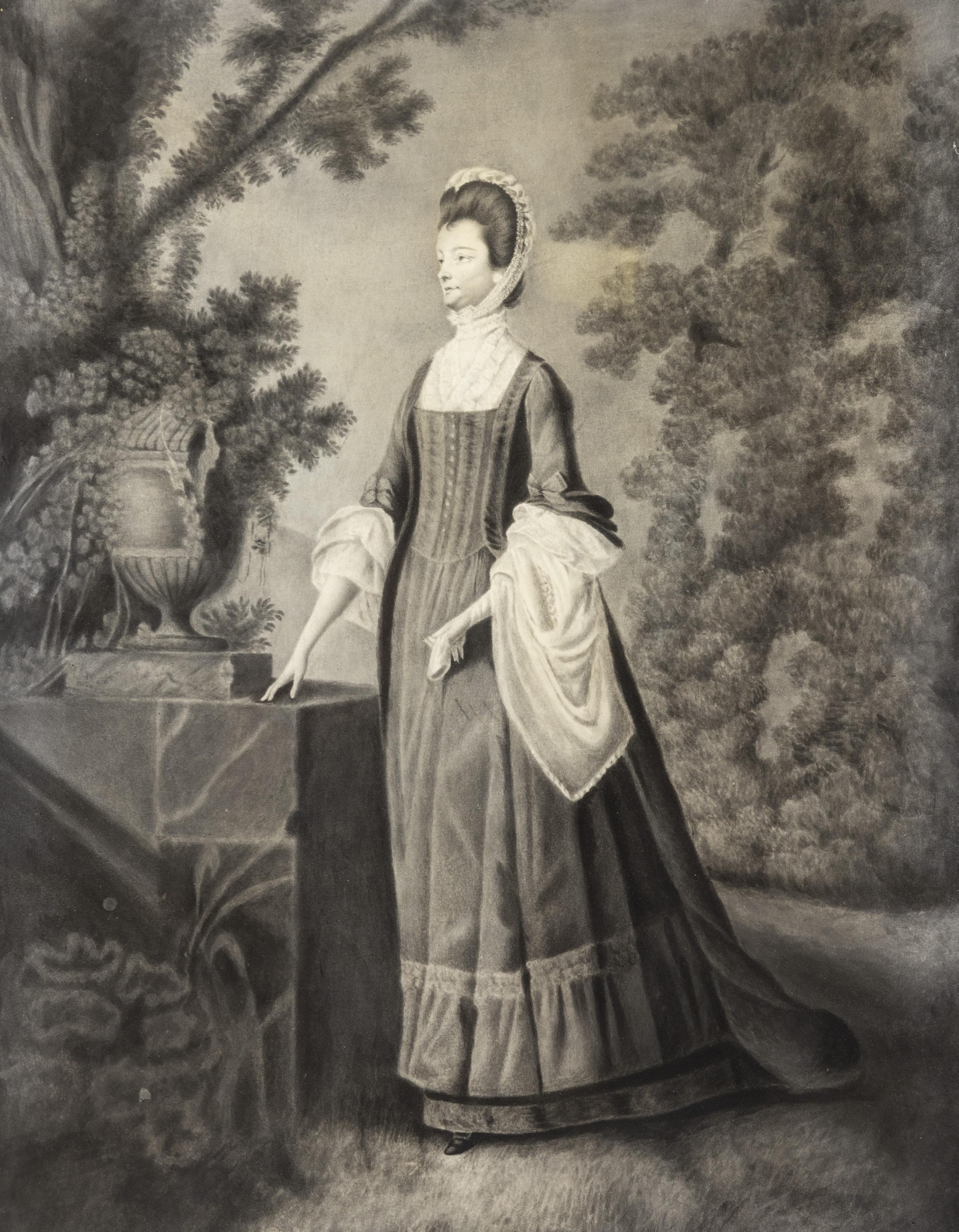
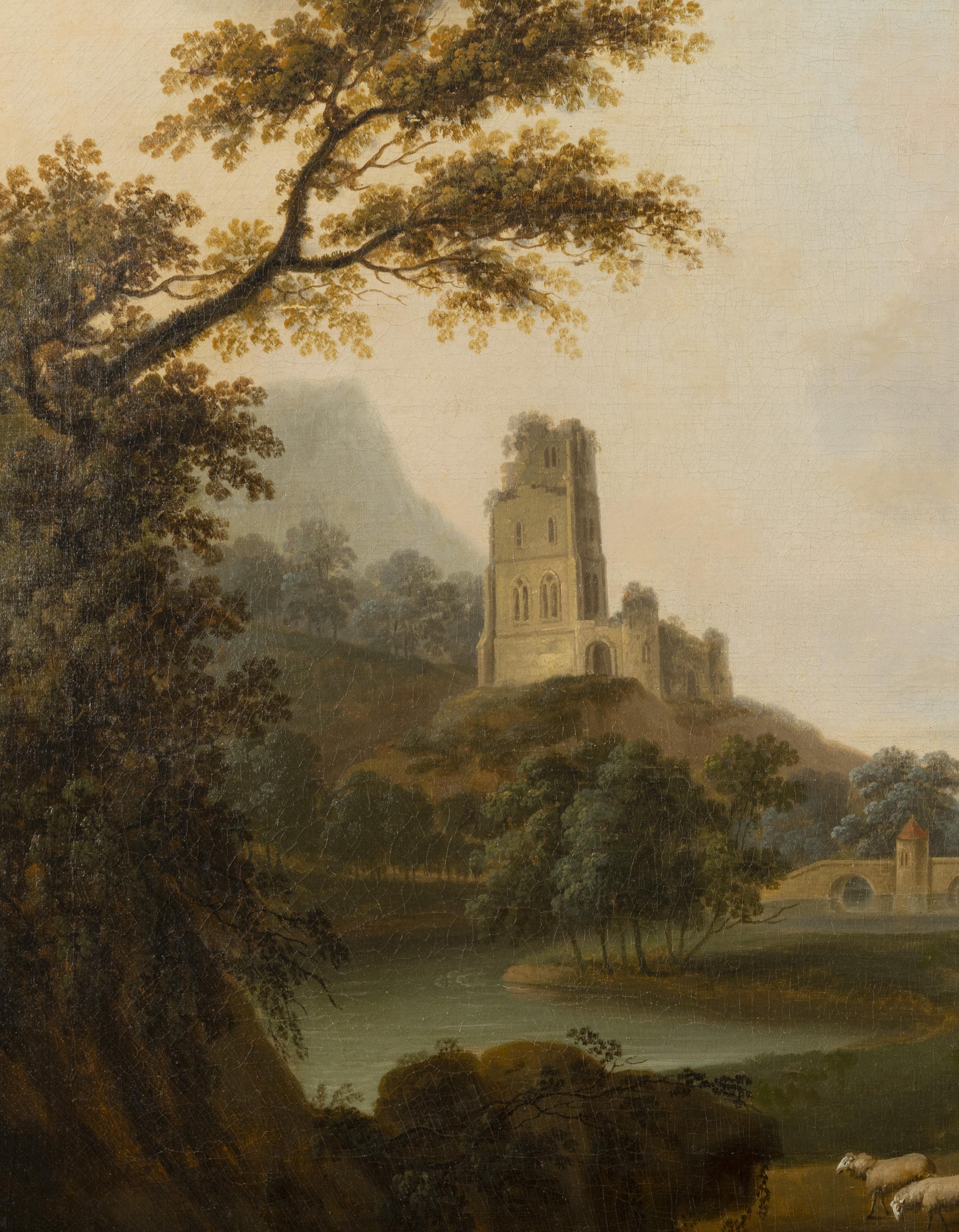
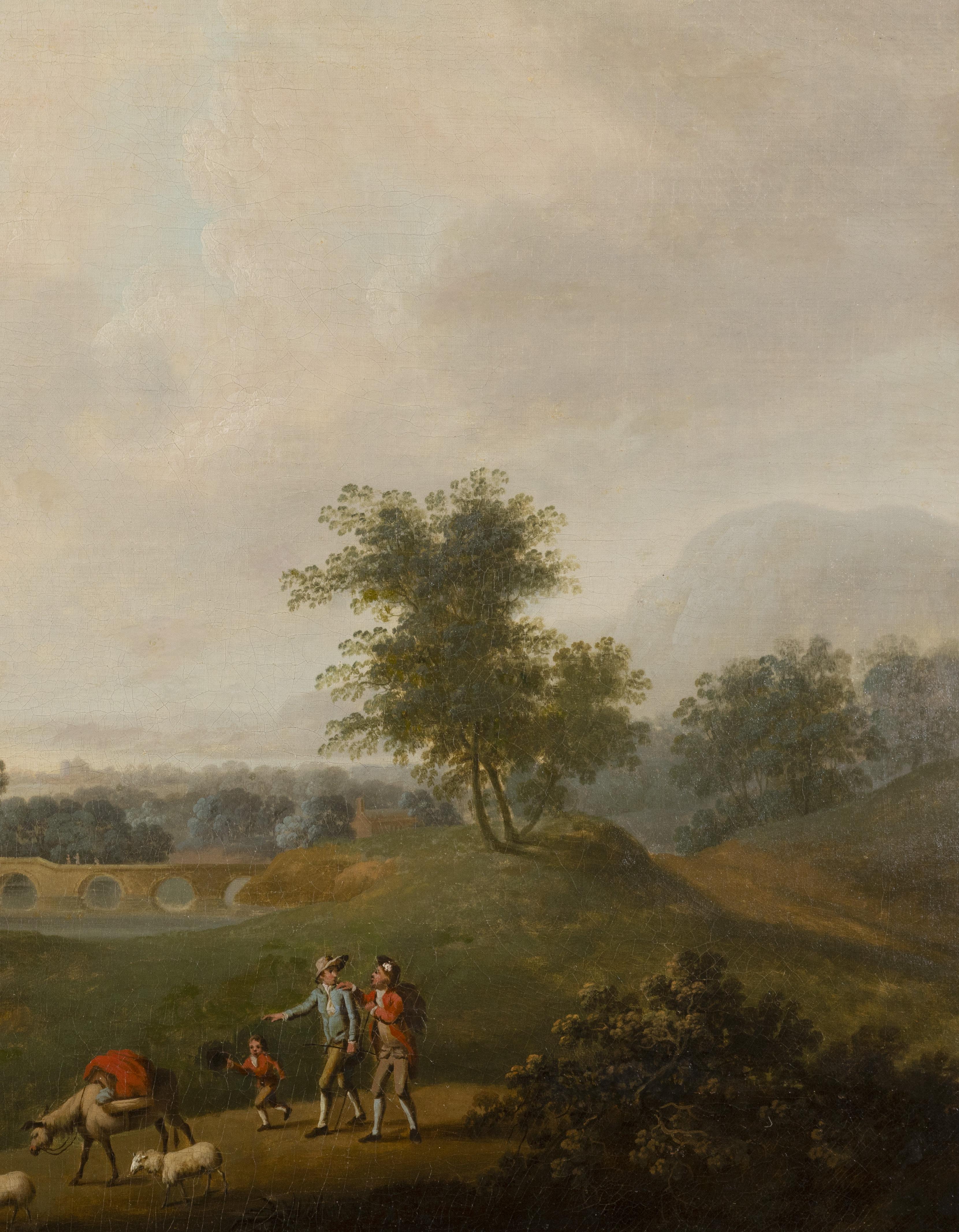
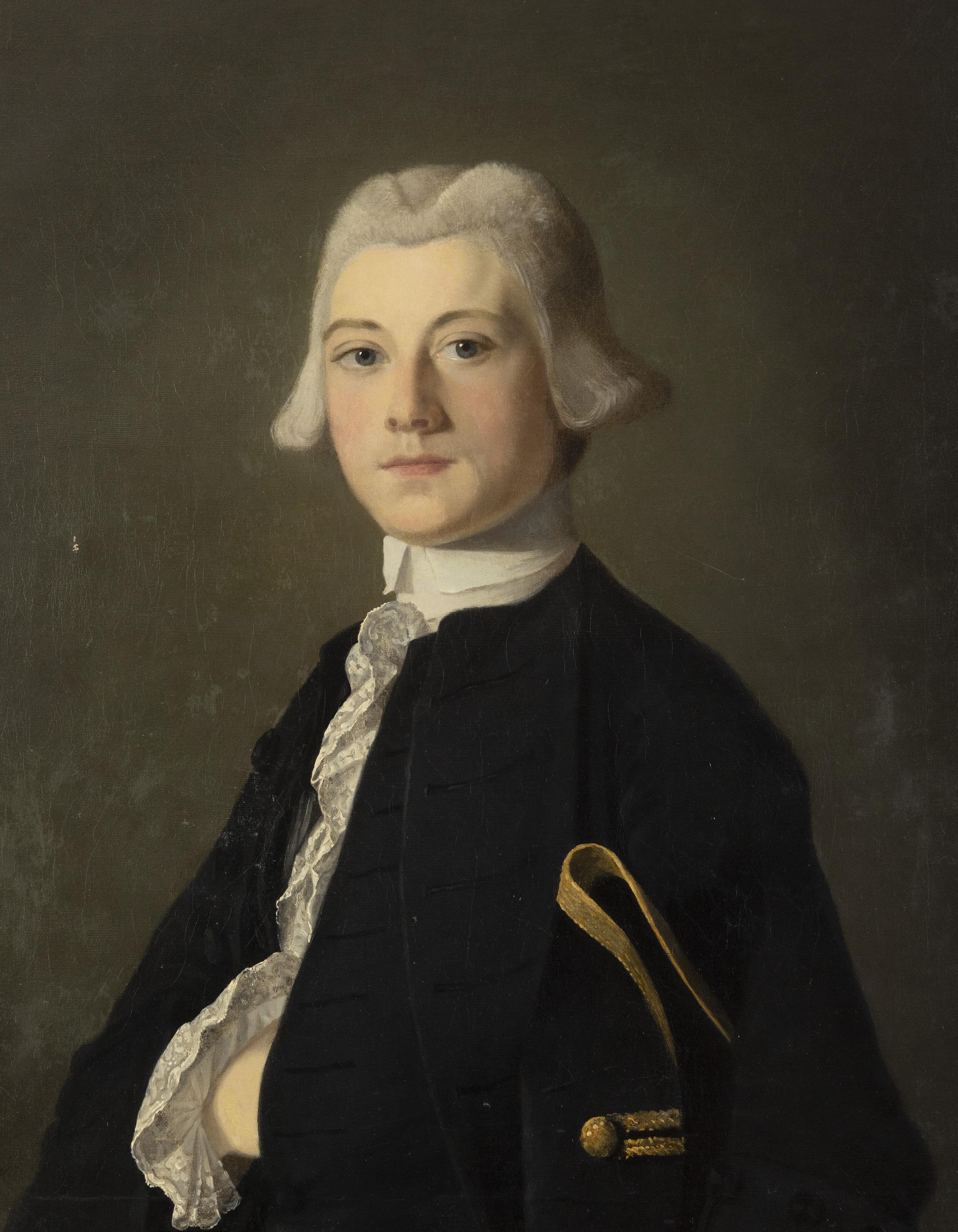








James O’Halloran BA FSCSI FRICS DIRECTOR j.ohalloran@adams.ie

Stuart Cole MSCSI MRICS MANAGING DIRECTOR s.cole@adams.ie

Nicholas Gore Grimes DIRECTOR nicholas@adams.ie

Amy McNamara BA MA ASSOCIATE DIRECTOR amymcnamara@adams.ie
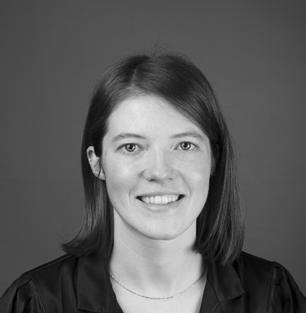
Niamh Corcoran BA FINE ART DEPARTMENT niamh@adams.ie

Adam Pearson BA SALEROOM CURATOR a.pearson@adams.ie

Ronan Flanagan HDip WAREHOUSE MANAGER r.flanagan@adams.ie

Eamon O’Connor BA FINANCIAL DIRECTOR e.oconnor@adams.ie
Follow Us




adams.auctioneers
Adam’s Auctioneers
@Adams1887
Adams Auctioneers
AUCTION
Thursday 15th May 2025 at 6pm
26 St. Stephen’s Green, Dublin 2. Ireland , D02 X665 +353 (01)6760261 adams.ie FOLLOW US @Adams1887 #Adams.Auctioneers

ALL AUCTION VIEWINGS ARE FREE AND OPEN TO THE PUBLIC
Thursday 8th May 10.00am–5:00pm
Friday 9th May 10.00am–5:00pm
Saturday 10th May 1.00pm– 5.00pm
Sunday 11th May 1.00pm – 5.00pm
Monday 12th May 10.00am–5:00pm
Tuesday 13th May 10:00am - 1.00pm
Wednesday 14th May 10.00am–4:00pm
Thursday 15th May 10.00am–4:00pm
Please refer to the Buying At Auction section in this catalogue, or adams.ie for further details on bidding in this auction, including absentee bidding.

26 St. Stephen’s Green, Dublin 2. Ireland +353 1 676 0261 info@adams.ie | www.adams.ie
Go to www.adams.ie. Choose the auction you wish to view from the Auctions/Forthcoming auctions menu, and you will be offered a range of ways to view. You may choose to view a digital version of the printed catalogue in the view e catalogue option or explore the virtual 3D option which allows you explore the saleroom with easy to navigate options or view the list view which opens automatically. This last option provides additional information and photographs of each lot as you choose the View Details button. Lastly, and only during office hours, there is a live chat button onscreen. If at any time you have a question whilst you are online, you can open a live chat and one our staff can help you.
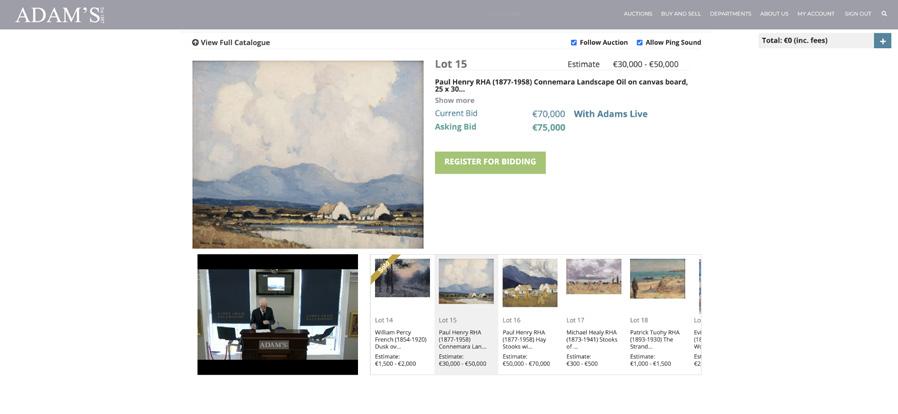
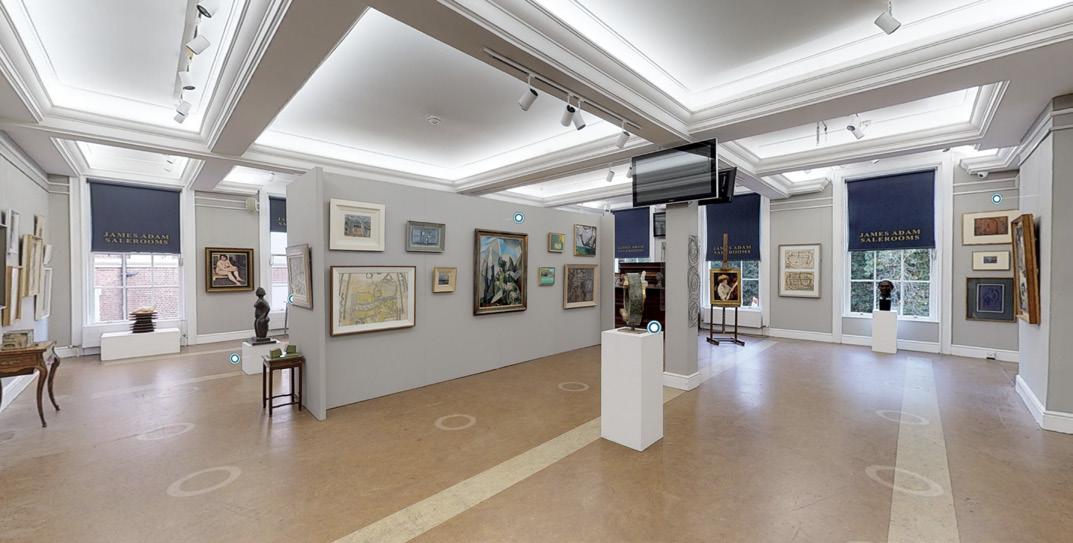
Log on to our web site www.adams.ie and create an account by signing up and registering your particulars online. The process involves supplying valid credit card information. This is a once off request for security purposes, and once the account is activated you will not be asked for this information again. The card information supplied is securely stored by Sage Pay. You can leave absentee bids online, and add, edit or amend bids accordingly as well as bidding over the internet in real time through ‘Adam’s Live’. You can also view your invoices, bid history, wish lists & other useful functions including paying your invoice and creating you very own personalised catalogue with search tags that will notify you once a catalogue is uploaded for your key word search.
We are delighted to advise that our own on-line bidding platform, Adam’s Live, is now fully operational for those who wish to bid online and watch the auction as it happens.
On the Live platform you can arrange to bid as the auction is taking place or at any time leave comission bids and the Adam’s Live platform will bid on your behalf.
Bidding through this portal will attract no additional internet surcharge for lots purchased so in effect those bidders will pay the same as a room bidder. Online bidding through the-saleroom.com and invaluable.com remains unaffected.
Sign up today for your own My Adam’s account and start saving on your on-line purchases.
These are shown below each lot in this sale. All amounts shown are in Euro. The figures shown are provided merely as a guide to prospective purchasers. They are approximate prices which are expected, are not definitive and are subject to revision. Reserves, if any, will not be any higher than the lower estimate.
All purchases must be paid for no later than Tuesday 20th May 2025. Please contact a member of staff to arrange collection/delivery of your purchases. Auctioneers commission on purchases is charged at the rate of 25% (inclusive of VAT). Terms: Strictly cash, card, bankers draft or cheque drawn on an Irish bank. Cheques will take a minimum of eight workings days to clear the bank, unless they have been vouched to our satisfaction prior to the sale, or you have a previous cheque payment history with Adam’s. We also accept payment by all major credit and debit cards. Please note a surcharge will apply of 2% of the invoice total for non-EU card types. For payments by bank transfer please ensure all bank charges are paid in addition to the invoice total, in order to avoid delays in the release of items. Goods will only be released upon clearance through the bank of all monies due.
Artists Resale Rights (Droit de Suite) is not payable by purchasers.
3. VAT Regulations
All lots are sold within the auctioneers VAT margin scheme. Revenue regulations require that the buyer’s premium must be invoiced at a rate which is inclusive of VAT. This is not recoverable by any VAT registered buyer.
Lots marked * are to be sold whilst subject to Temporary Admission (Import) regulations. For purchasers based in the Republic of Ireland - the hammer price will be subject to import VAT at the reduced rate, currently 13.5%, and the Buyer’s Premium will be subject to VAT at the standard rate, currently 23%. For purchasers outside of the Republic of Ireland, please contact our Accounts Department for further details.
It is up to the bidder to satisfy themselves prior to buying as to the condition of a lot. In relation to Condition Reports, whilst we make certain observations on the lot, which are intended to be as helpful as possible, references in the condition report to damage or restoration are for guidance. The absence of such a reference does not imply that an item is free from defects or restoration, nor does a reference to particular defects imply the absence of any others. The condition report is an expression of opinion only and must not be treated as a statement of fact. Please ensure that condition report requests are submitted before 12 noon on Wednesday 14th May 2025 as we cannot guarantee that they will be dealt with after this time.
5.
We are happy to execute absentee or written bids for bidders who are unable to attend or bid online themselves and can also arrange for bidding to be conducted by telephone. However, these services are subject to special conditions (see conditions of sale in this catalogue). All arrangements for absentee and telephone bidding must be made before 5pm on the day prior to sale. Bidding by telephone may be booked on all lots. Early booking is advisable as availability of lines cannot be guaranteed.
6.
We would like to acknowledge, with thanks, the assistance of Brendan Rooney, Dr. Logan Morse, Ruth Kenny and William Laffan, in the preparation of this catalogue.
7.
ALL LOTS ARE BEING SOLD UNDER THE CONDITIONS OF SALE AS PRINTED IN THIS CATALOGUE AND ON DISPLAY IN OUR SALEROOMS AND ON OUR WEBSITE.
James Barry, born on 11 October 1741 in Water Lane (now Seminary Road) in Cork, was the son of John Barry, a builder, innkeeper, and coasting vessel trader. Although his father encouraged him to join the family business, Barry pursued a different path, developing his artistic skills independently by copying engravings and receiving some instruction from the landscape painter John Butts.
At the age of twenty, Barry enrolled as a student at the Dublin Society’s Figure Drawing School, and in 1763, he earned a premium for The Baptism of the King of Cashel by St Patrick, one of the earliest recorded paintings of an Irish historical subject. An oil sketch for this work is now part of the collection of the National Gallery of Ireland.
In 1764, Barry left Ireland for London and subsequently traveled to France and Italy under the patronage of Edmund and William Burke. His artistic talent gained recognition, and in 1772 he became an associate of the Royal Academy, followed by his election as a full member in 1773. By 1782, he had been appointed Professor of Painting at the Academy.
One of Barry’s most significant achievements came in 1777 when he began work on a series of six monumental canvases for the Great Room at the Royal Society of Arts in London. This series, which depicts the progress of civilisation, is widely regarded as his magnum opus.
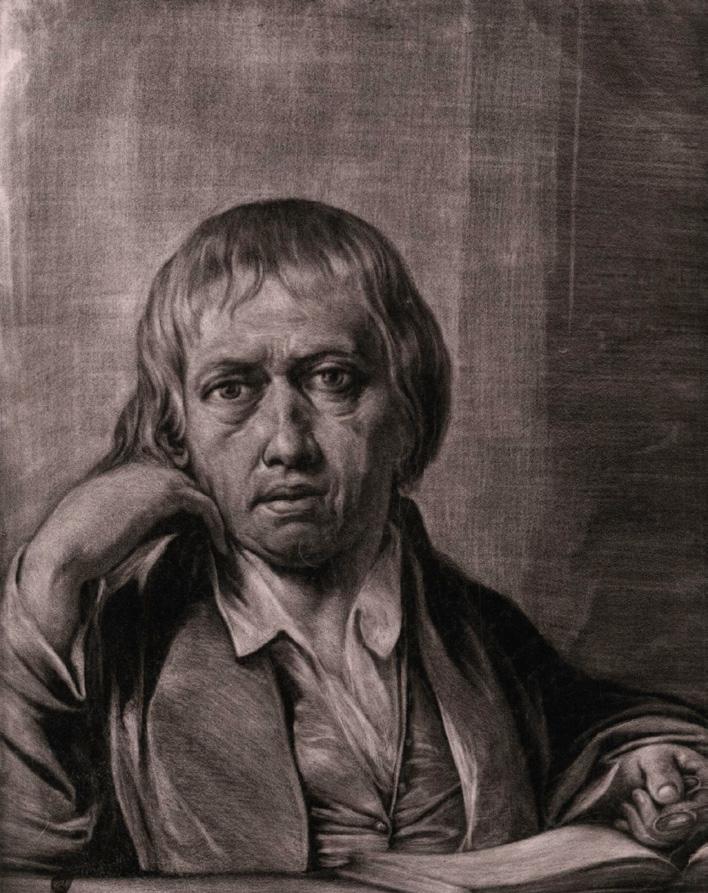
After completing the six canvases in the Great Room of the Royal Society of Arts, James Barry extended his work through a series of six large engravings in 1802. These prints revisited and expanded upon the themes explored in the original paintings, delving deeper into the ideas of human progress, virtue, and divine justice. The engravings were published under the title A Series of Etchings by James Barry, Esq., from his Original and Justly Celebrated Paintings in the Great Room of the Society of Arts.
Despite his early success, Barry became increasingly reclusive in his later years, and interest in his work declined. He died on 22 February 1806. His body lay in state at the Society of Arts and was later interred in the artists’ corner of St Paul’s Cathedral, a final recognition of his contribution to British art.
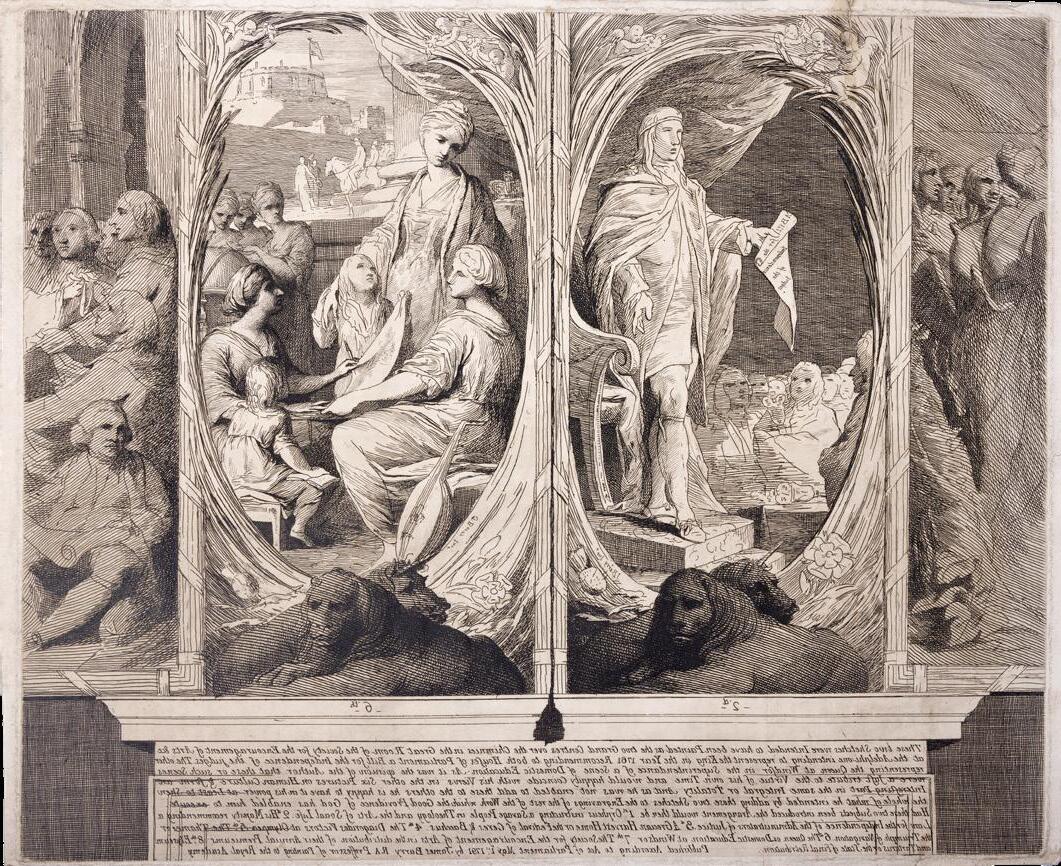
King George and Queen Charlotte
Etching and engraving, Pressly 1981.23 IV/V, 42 x 51.5cm (plate); 43.5 x 53.5cm (sheet) - Framed First published by James Barry 1792
Inscription: Lettered below the image as on a plaque with production detail "Published According to Act of Parliament May 1st. 1791 by James Barry R A Proffessor [sic] of Painting to the Royal Academy",
€ 500 - 800
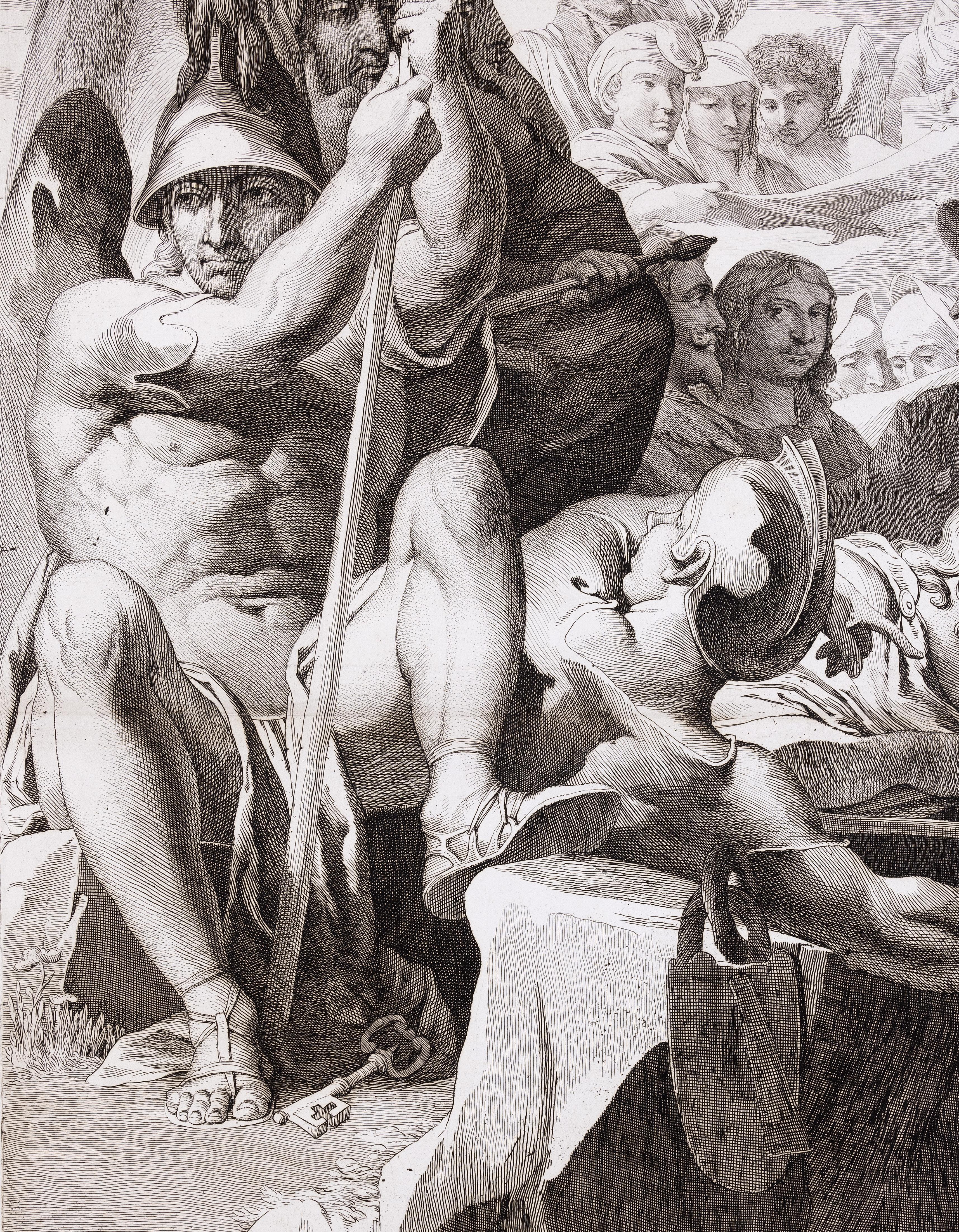
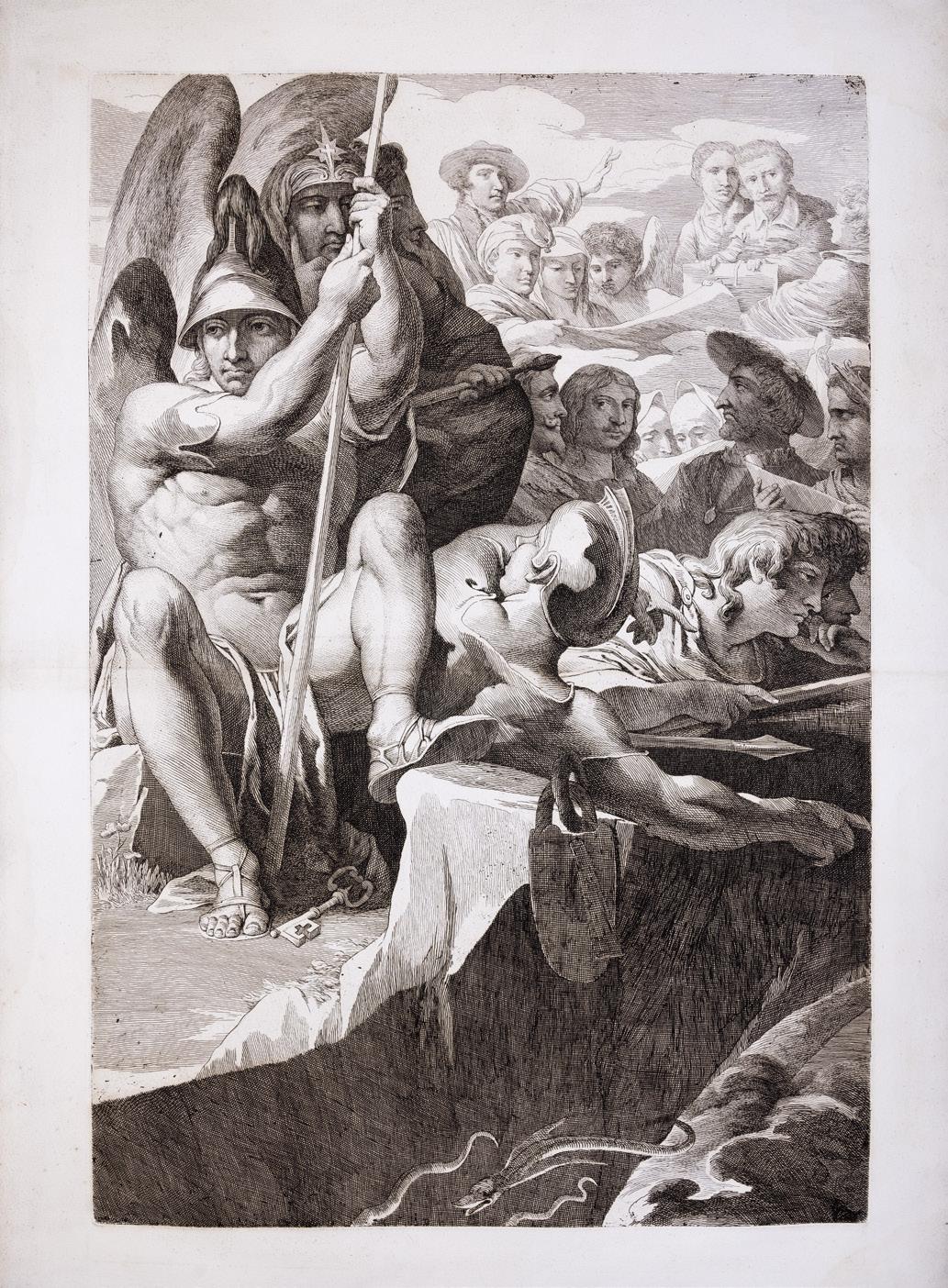
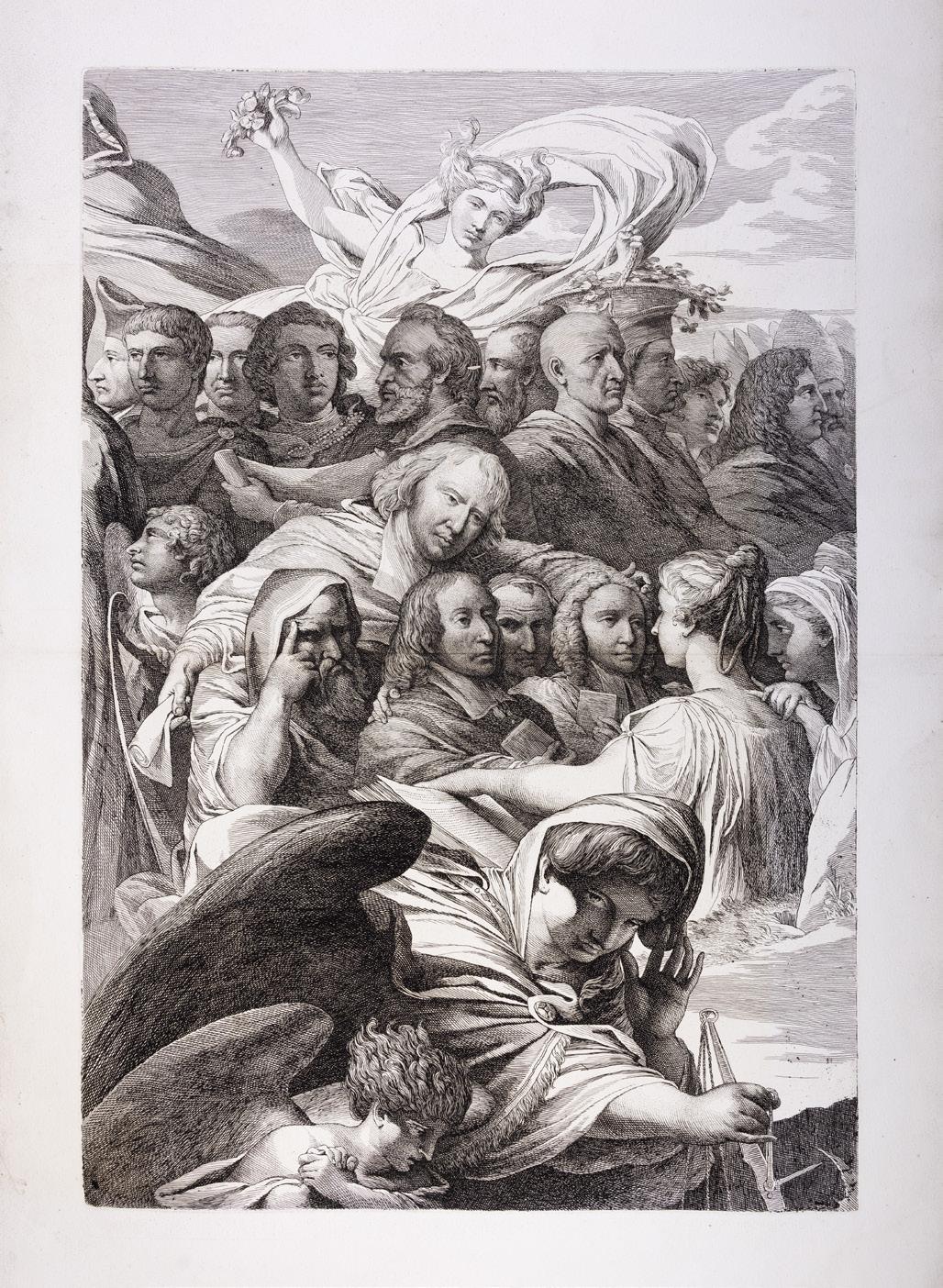
JAMES BARRY RA (1741-1806)
The Angelic Guards (from Elysium, or the State of Final Retribution)
Etching and engraving, Pressly 1981.34 IV/IV, 74.5 x 50cm (plate); 84.5 x 62cm (sheet); Framed First published by James Barry 1802; 1808 impression
€ 1,000 - 1,500
JAMES BARRY RA (1741-1806)
Divine Justice
Etching and engraving, Pressly 1981.33, 74.5 x 50cm (plate); 84.5 x 62cm (sheet); Framed
Published by James Barry c.1802; 1808 impression
€ 1,000 - 1,500
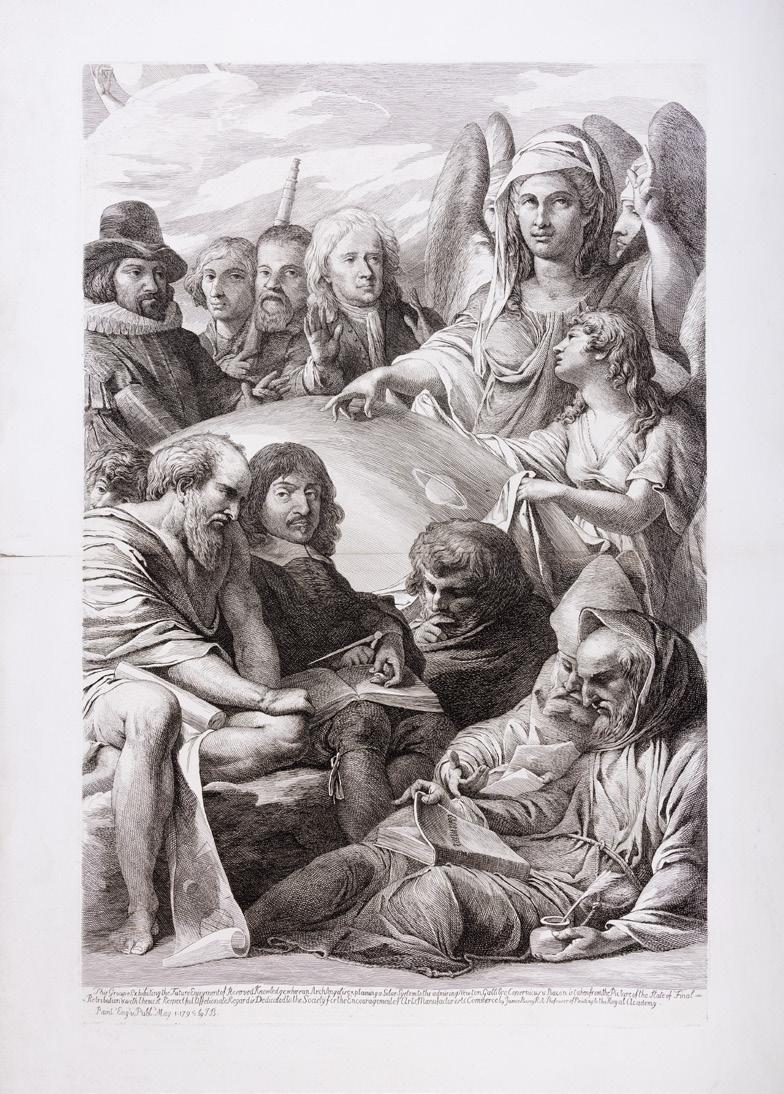
5 JAMES BARRY RA (1741-1806)
The Glorious Sextumvirate
Etching and engraving, Pressly 1981.30, 74.5 x 47.5cm (plate); 84 x 62.5cm (sheet) - Framed First published by James Barry 1795 image on shield: "Leuctra"
€ 1,000 - 1,500

4
JAMES BARRY RA (1741-1806)
Reserved Knowledge
Etching and engraving, Pressly 1981.29, III/III 44.5 x 48cm (plate); 83 x 62.5cm (sheet) - Framed First published by James Barry 1795; 1808 impression
€ 1,000 - 1,500
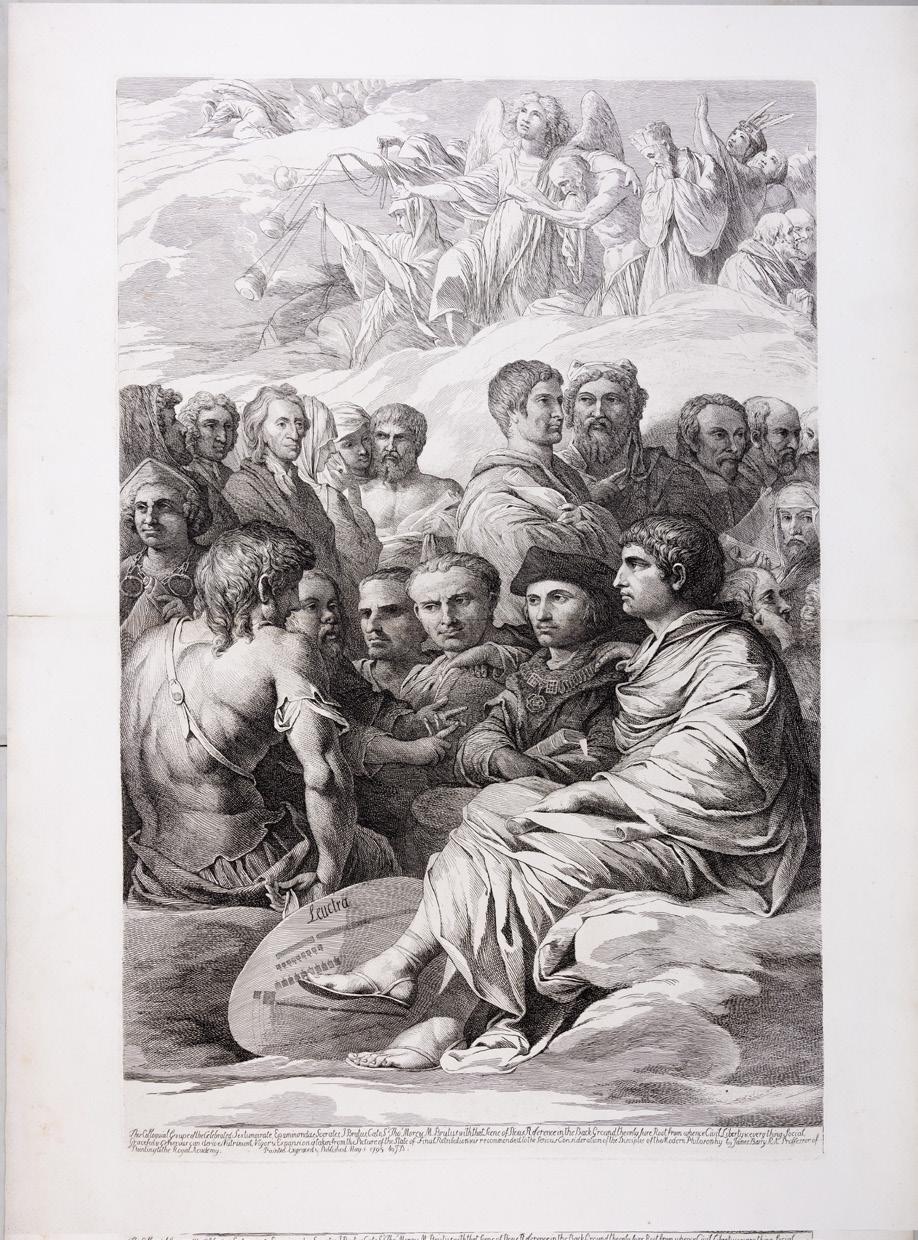
6
JAMES BARRY RA (1741-1806)
Detail of the Diagorides Victors
Etching and engraving, Pressly 1981.28 IV/IV, 74.5 x 47.5cm (plate); 85 x 62cm (sheet) - Framed
First published by James Barry 1795; 1808 impression
€ 700 - 1,000
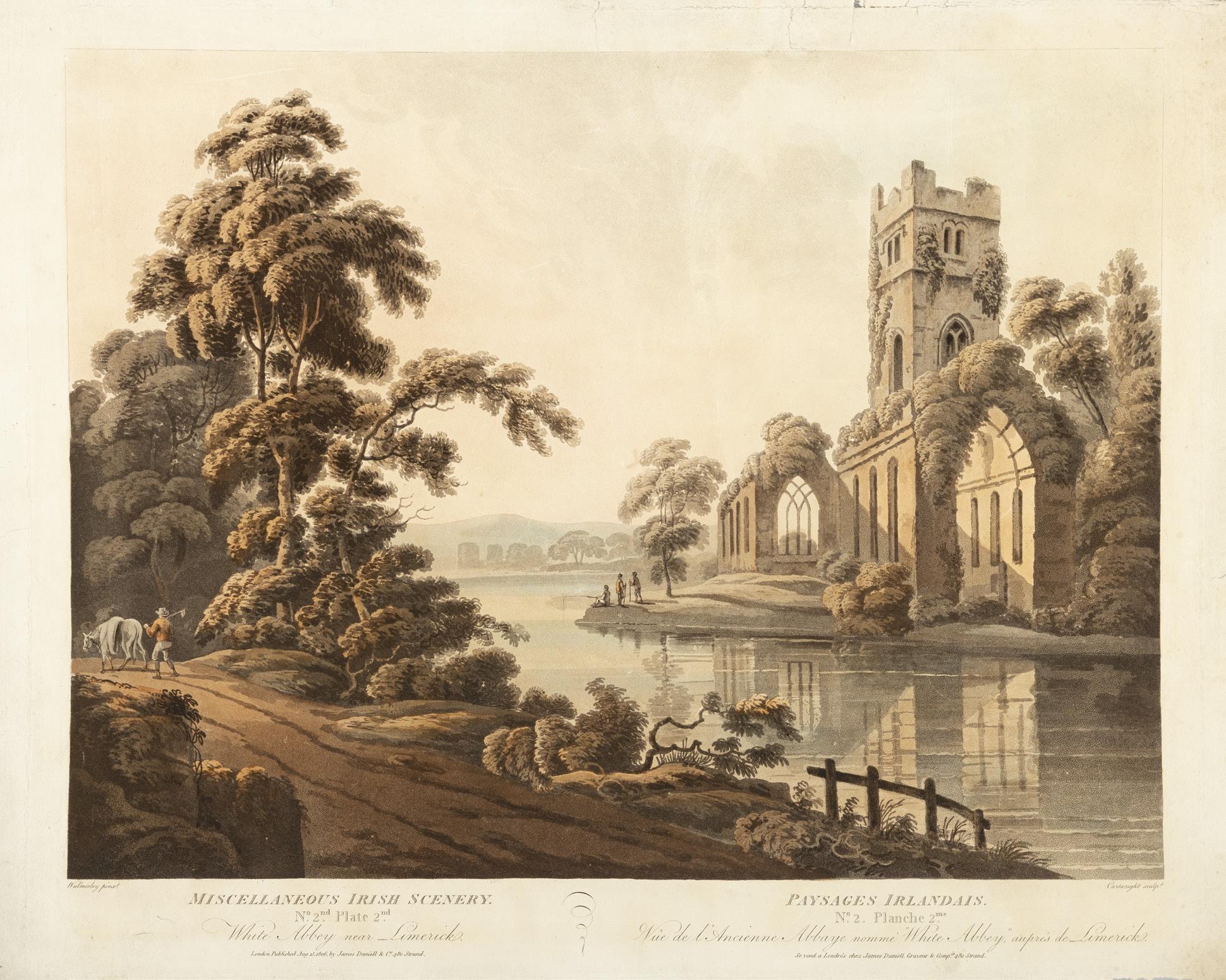
White Abbey near Limerick, Miscellaneous Irish Scenery No. 2 Plate 2nd
Aquatint and engraving, 48.5cm x 59.5cm (plate); 53 x 63cm (sheet)
Published by James Daniell, London; Thomas Walmsley, del.; R. Cartwright fecit (1806)
€ 200 - 300
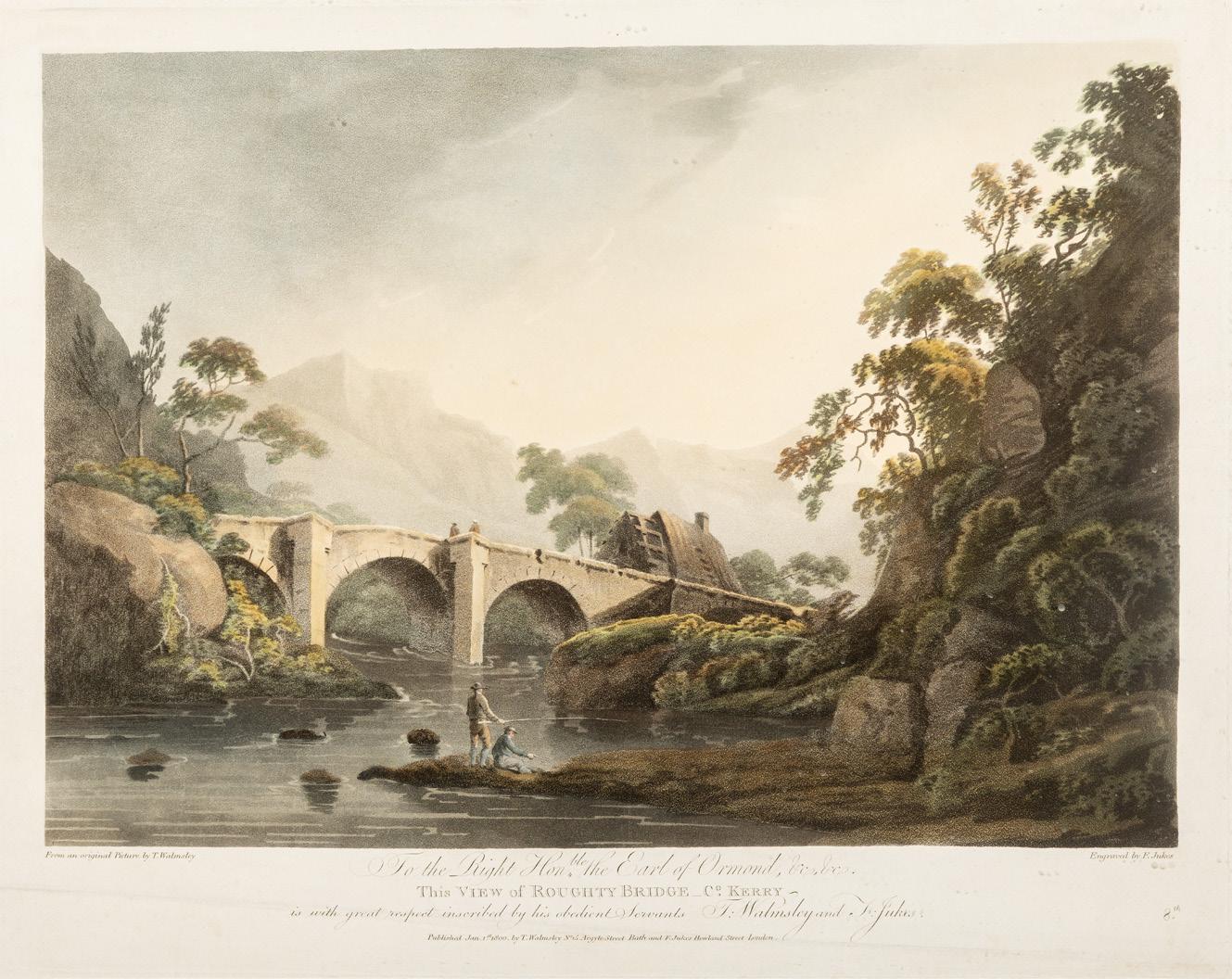
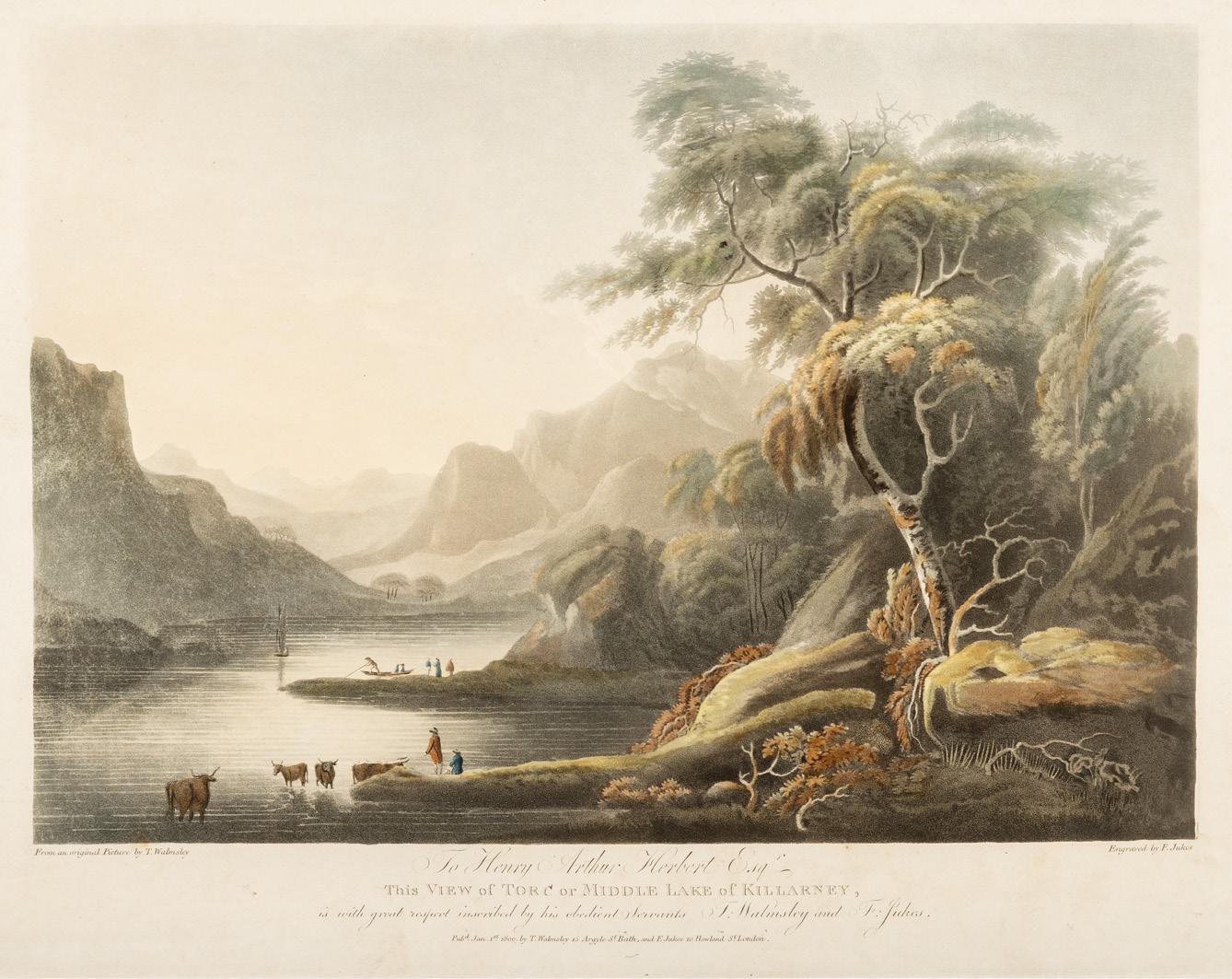
8 AFTER THOMAS WALMSLEY (1763–1806)
View of Roughty Bridge, County Kerry; View of Torc or Middle Lake, Killarney
A pair of hand-coloured aquatints, each 36.5 × 46 cm
From the series Views of Killarney (1795–1802), published: Roughty Bridge, County Kerry – 1 January 1800 by T. Walmsley, 15 Argyle Street, Bath, and F. Jukes, London; Torc or Middle Lake, Killarney – 1 March 1802 by James Daniell, London. T. Walmsley, del.; F. Jukes, fecit.T. Walmsley, del.; F. Jukes, fecit.
€ 600 - 1,000
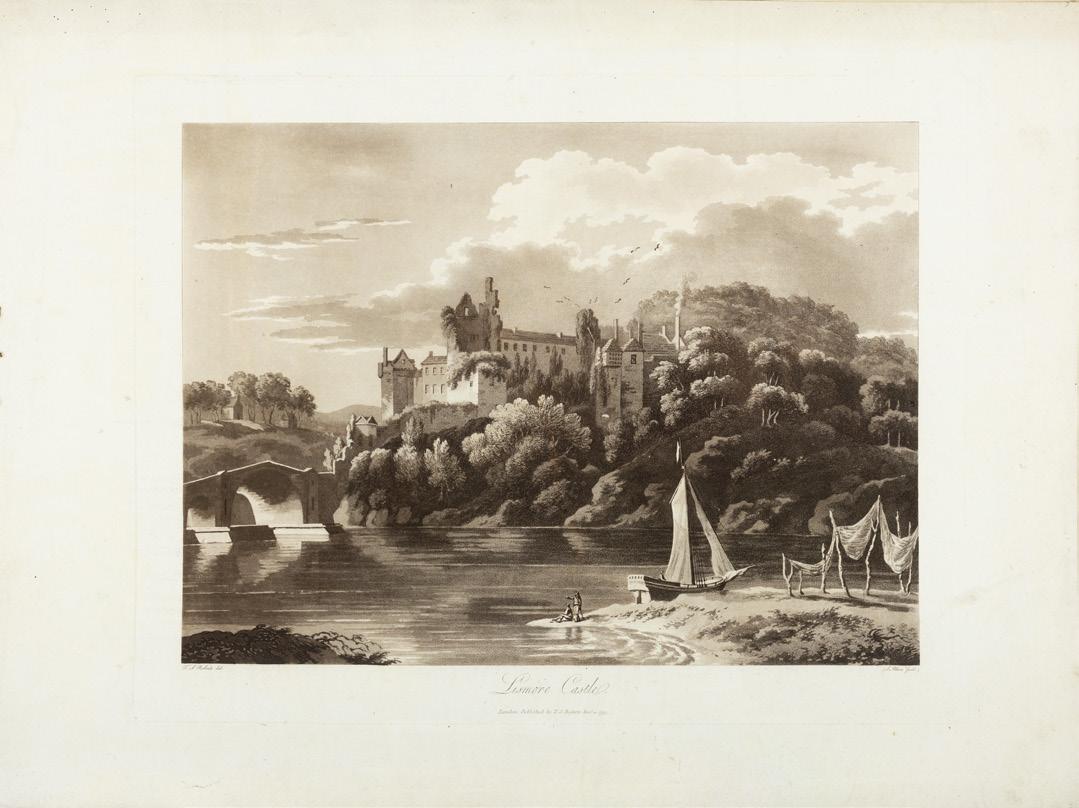
AFTER THOMAS SAUTELLE ROBERTS
Lismore Castle from Views in Ireland (Abbey Scenery 453)
Aquatint and etching, 37 x 48cm (plate); 47 x 63cm(sheet)
Published by T.S. Roberts, London; T.S. Roberts, del.; Samuel Alken fecit. (1795)
Together with Lismore Castle letter-press
48.5 x 69cm (2)
€ 200 - 300
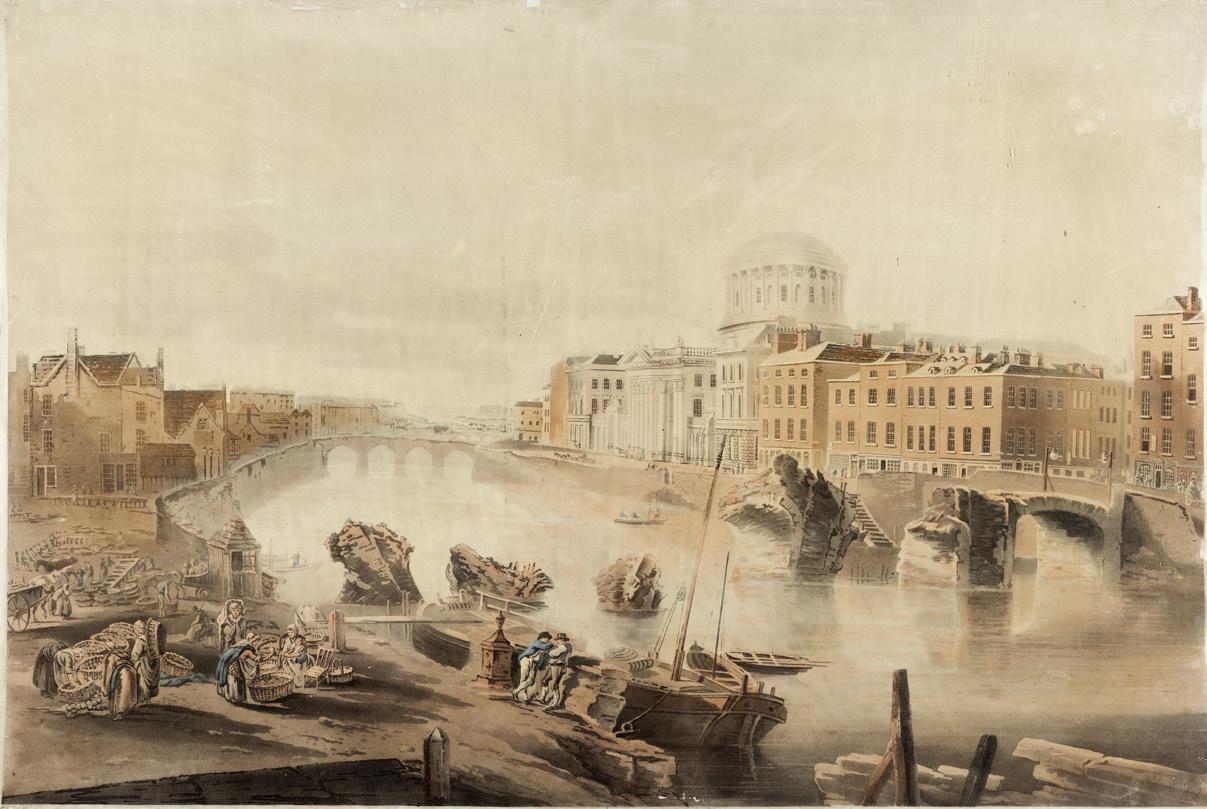
10
AFTER THOMAS SAUTELLE ROBERTS (1760-1826)
A South View on the River Liffey, Dublin / taken from the Coal Quay, or Fruit Market
Colour Lithograph, 59.5 x 89cm (trimmed & laid down on paper) - Framed
Published by R. Ackermann, London; T.S. Roberts, del.; J. Bluck fecit. (1807)
€ 800 - 1,000
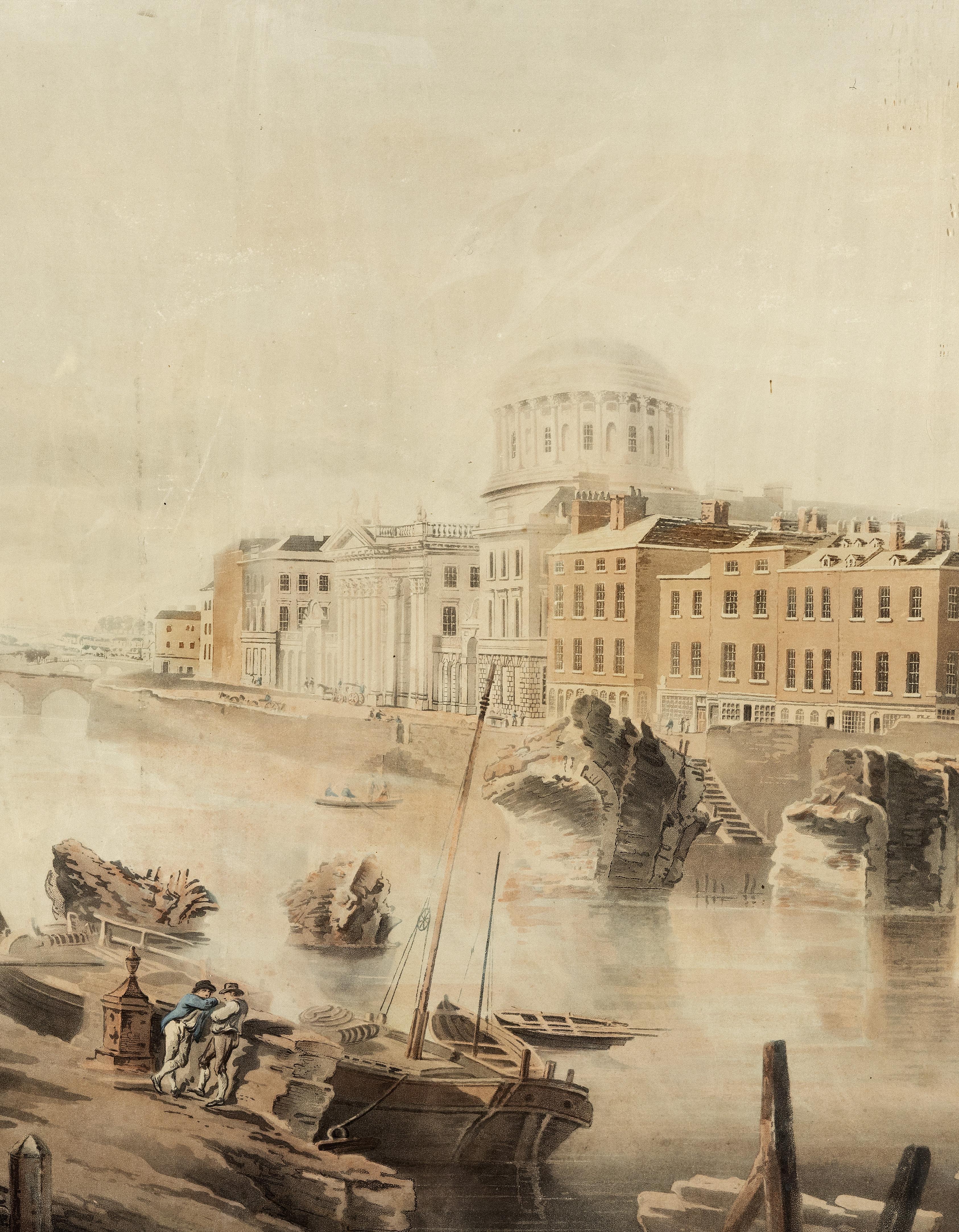
AFTER THOMAS SAUTELLE ROBERTS (1760-1826)
College Green Dublin
Coloured Aquatint, 46 x 61cm
Drawn by Thomas Roberts
Engraved by R. Have & Sons
Published 1816 by James Del Vecchio, Westmoreland Street Dublin
This is the second state of the print as ‘by their respectful and Obedient Servant,/ James Del Vecchio’ has been added after the dedication
€ 500 - 800
AFTER THOMAS SAUTELLE ROBERTS (1760–1826)
Castle of Dublin
Coloured aquatint, 44 x 60cm
T. S. Roberts, del.; R. Havell & Sons, fecit.
Published 1816 by James Del Vecchio, Westmoreland Street, Dublin.
€ 500 - 800
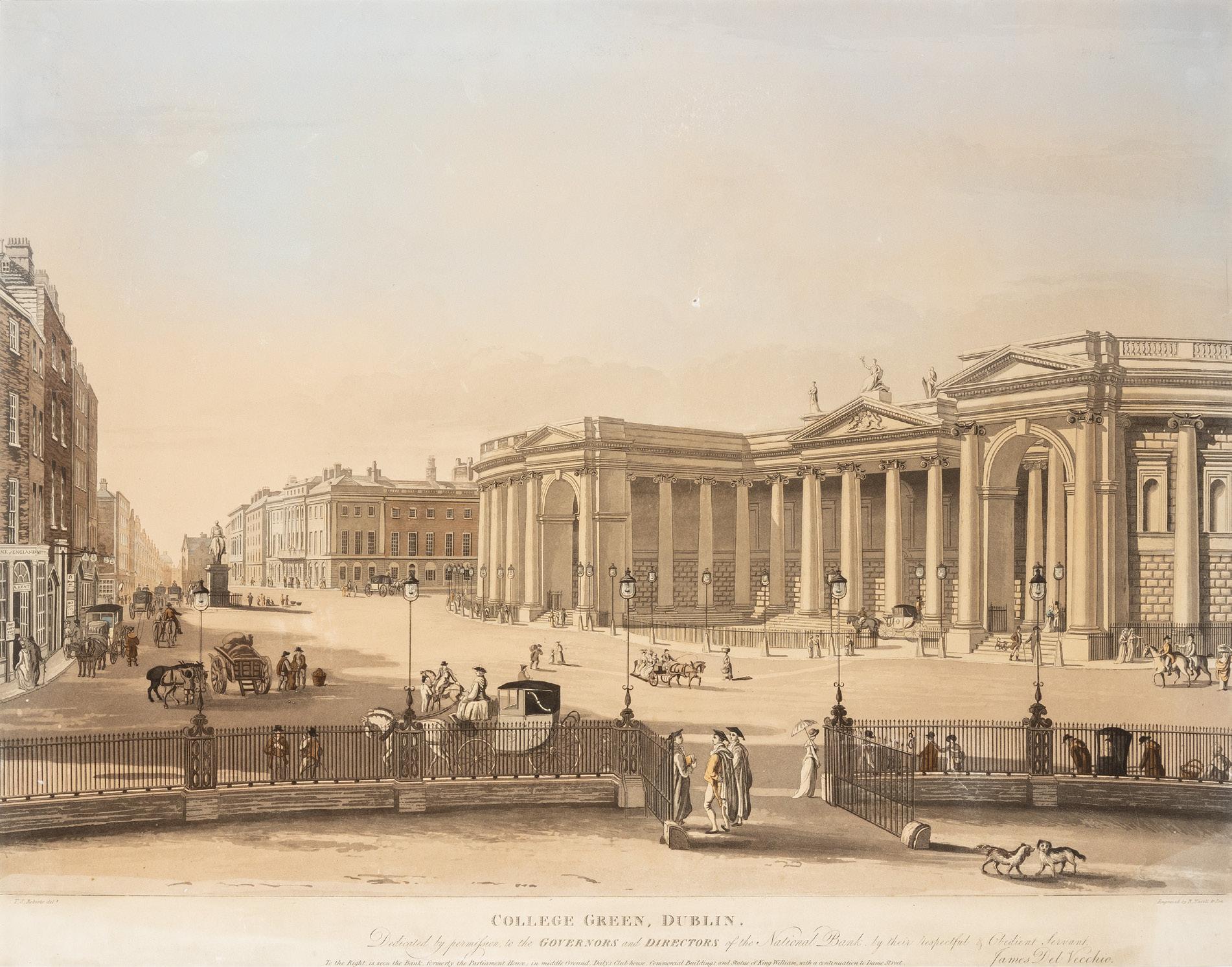
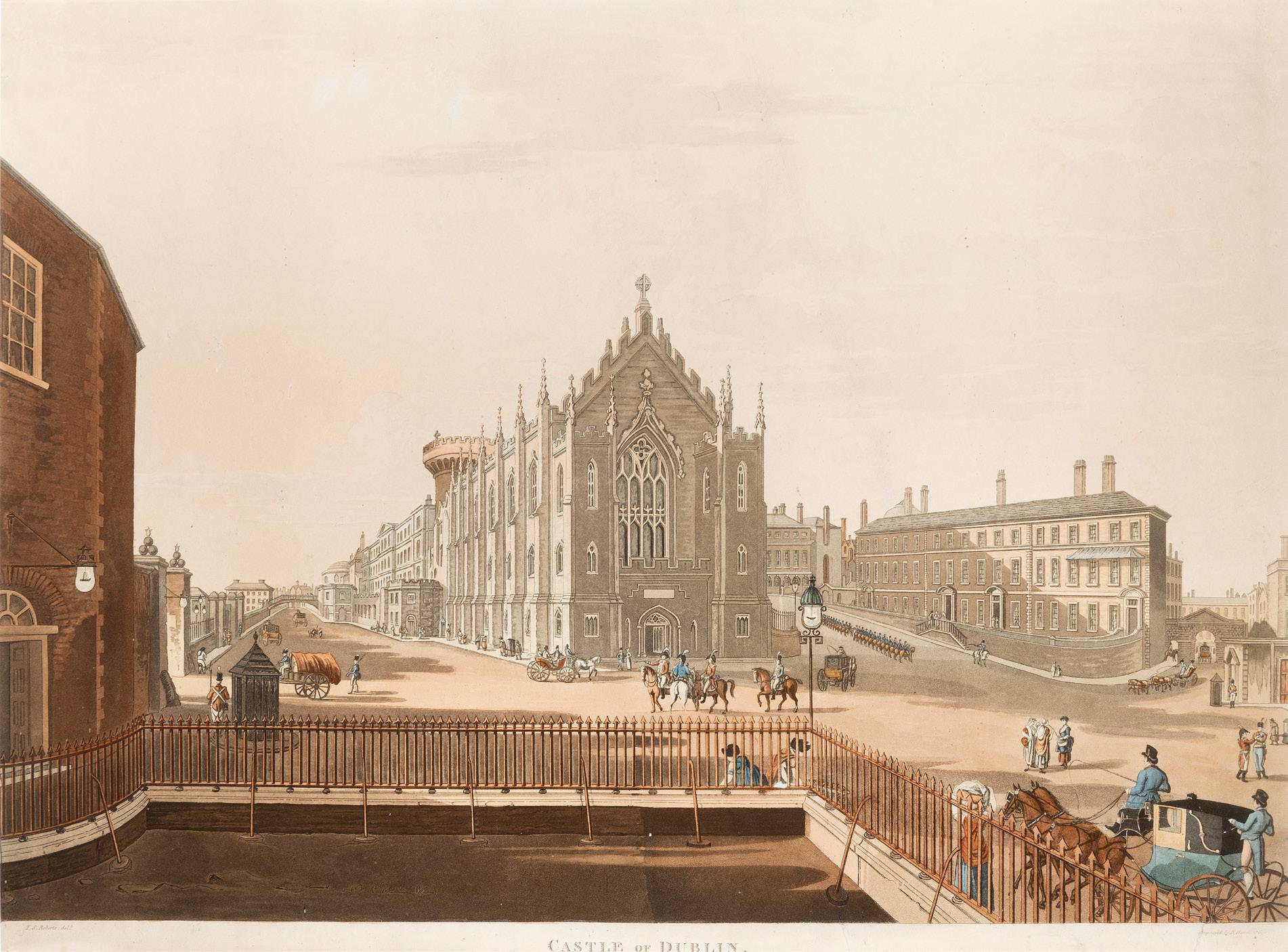
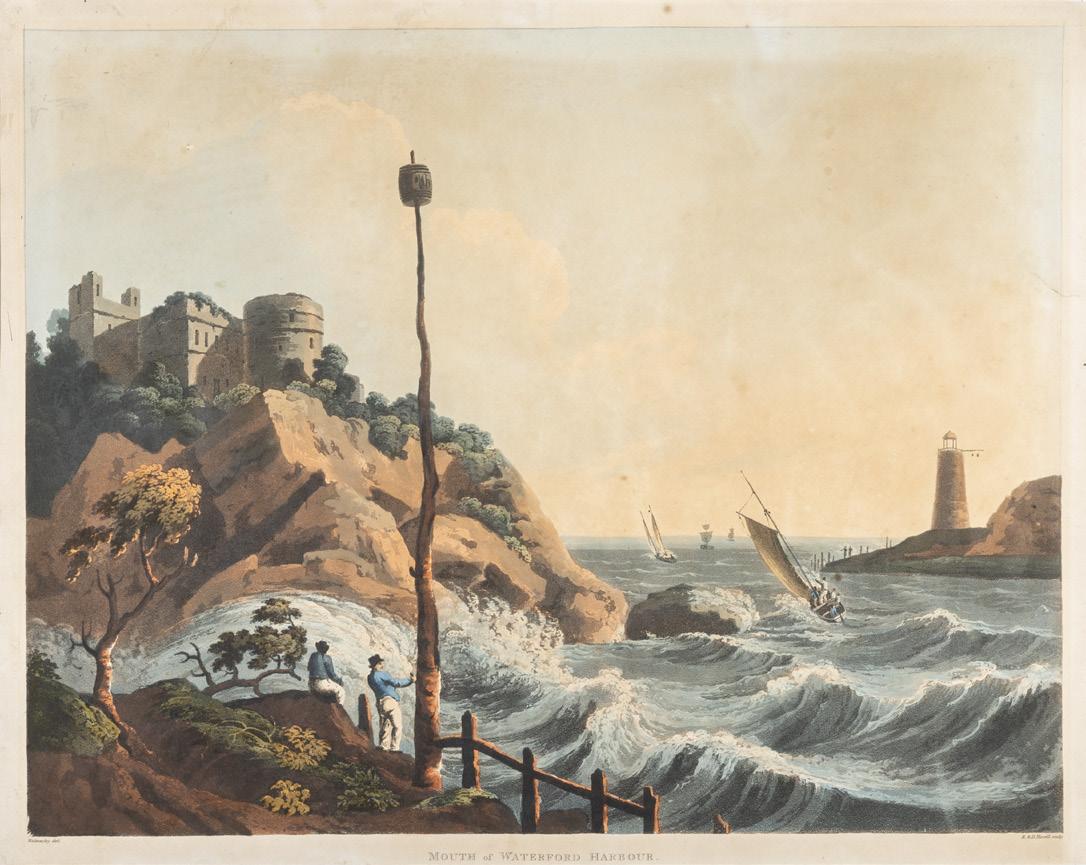
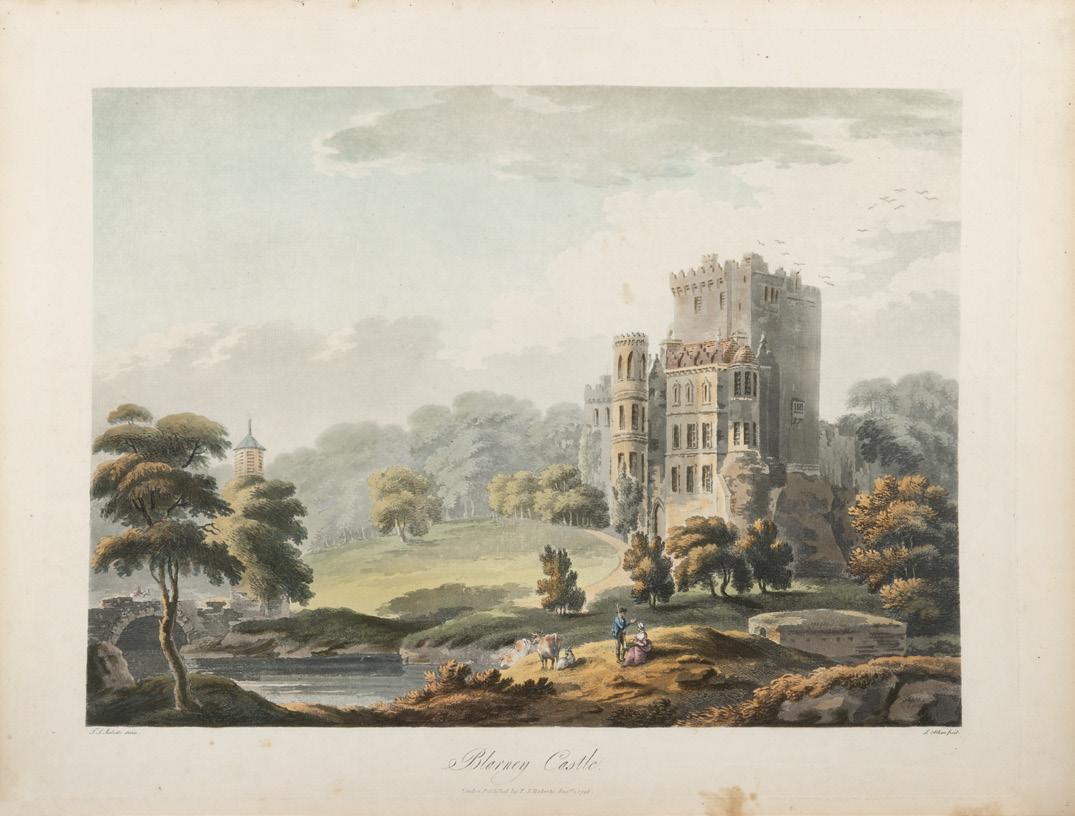
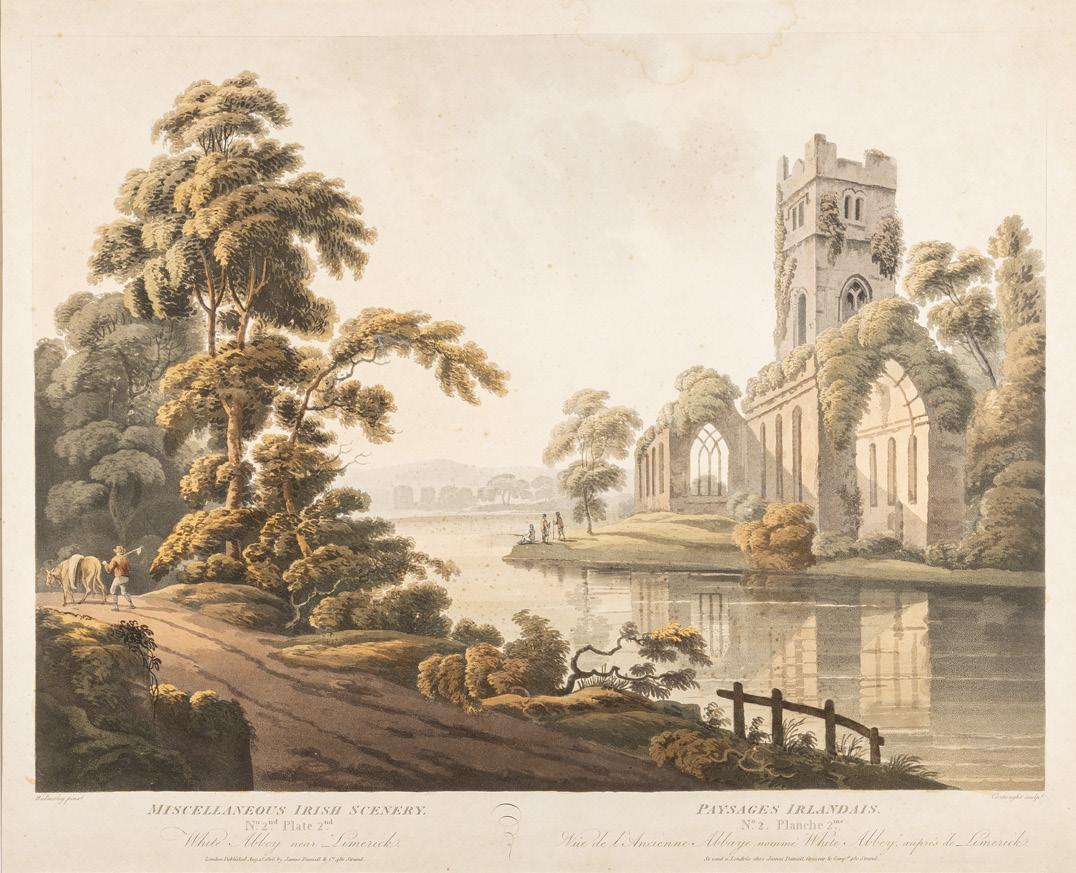
AFTER THOMAS WALMSLEY (1763–1806)
Mouth of Waterford Harbour
Coloured aquatint and engraving, 47 x 58cm
Published by John Murphy, 19 Howland Street, Fitzroy Square, and at G. Testolini’s, 73 Cornhill, London; 1809. T. Walmsley, del.; R. Havell, fecit. Ref: Elmes & Hewson, 1751TD
€ 300 - 400
AFTER THOMAS SAUTELLE ROBERTS (1760-1826)
Blarney Castle
Coloured aquatint engraving, 36 x 47cm (plate); 39.5 x 51.5cm (sheet)
Published by R. Ackermann, London; T.S. Roberts, del.; S. Allen fecit.
€ 200 - 300
15
AFTER THOMAS WALMSLEY (1763-1806)
White Abbey near Limerick, Miscellaneous Irish Scenery No. 2 Plate
Coloured aquatint and engraving, 48.5cm x 59.5cm (plate); 51 x 66cm (sheet)
Published by James Daniell, London; Thomas Walmsley, del.; R. Cartwright fecit. (1806)
€ 300 - 400
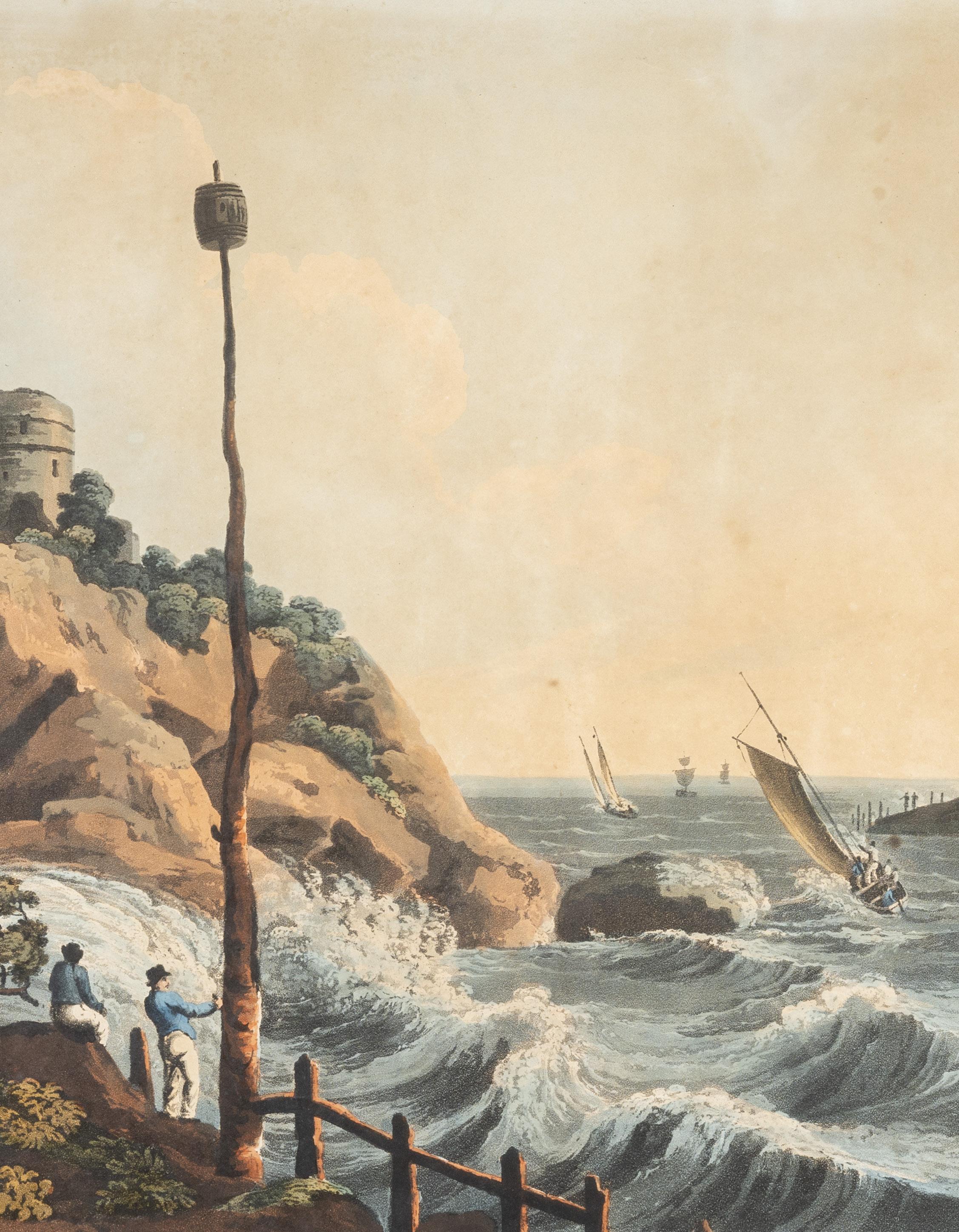
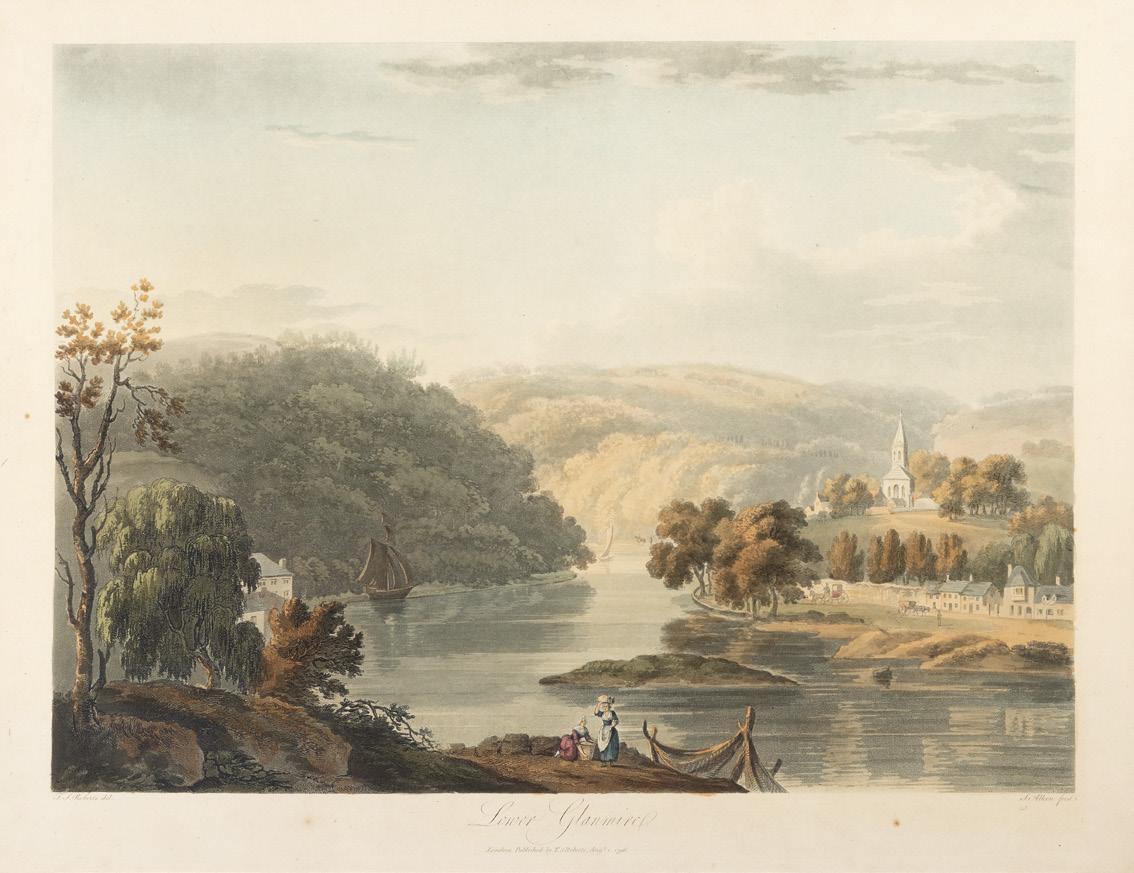
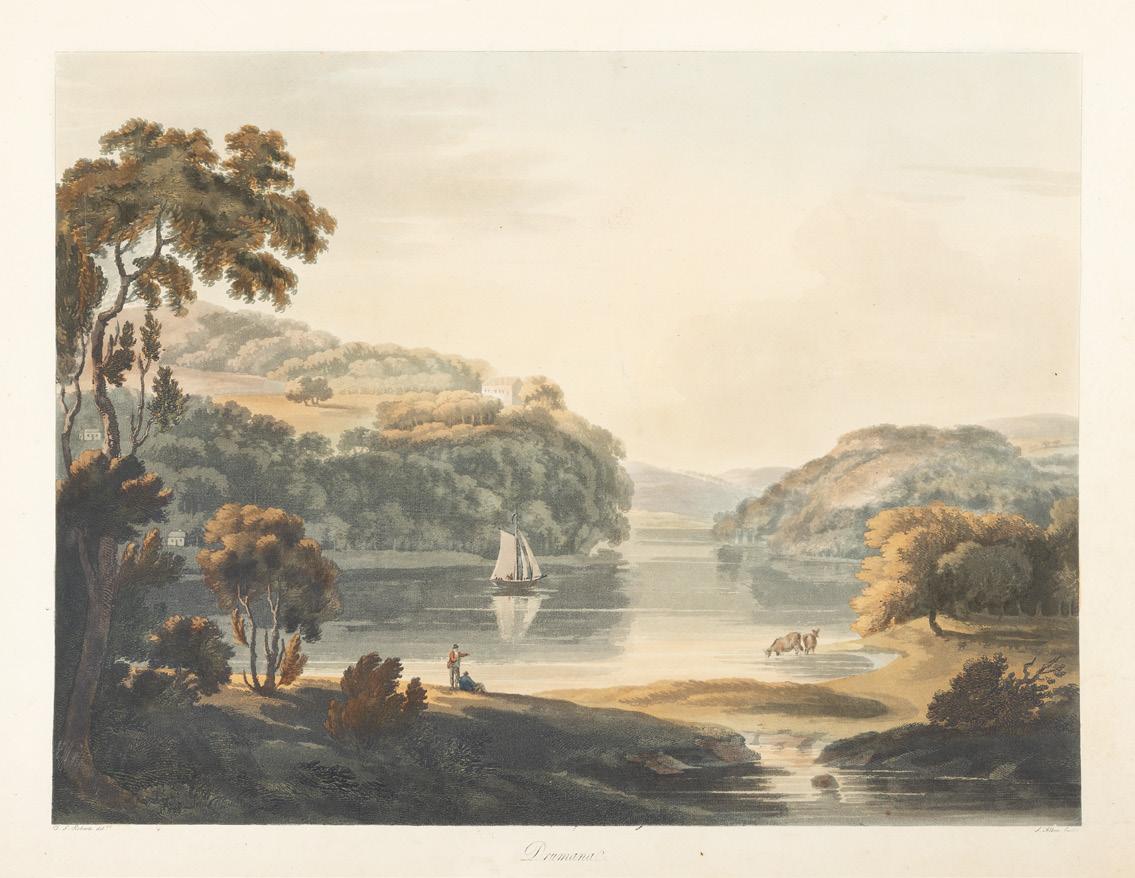
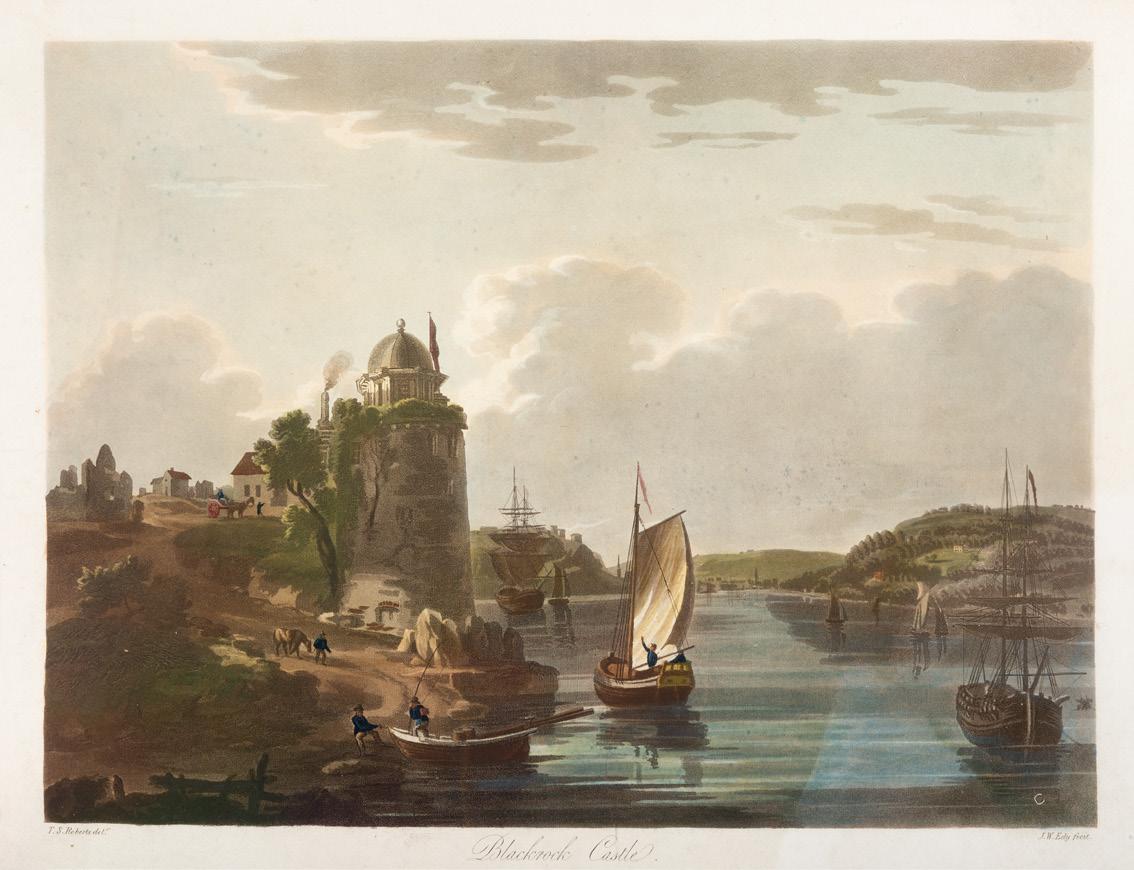
16
AFTER THOMAS SAUTELLE ROBERTS (1760-1826)
Lower Glanmire [Co. Cork] from Views in Ireland (Abbey Scenery 453)
Coloured aquatint engraving, 37x 48cm (plate); 38 x 51.5cm (sheet)
Published by R. Ackermann, London; T.S. Roberts, del.; S. Allen fecit.
€ 200 - 300
17
AFTER THOMAS SAUTELLE ROBERTS (1760-1826)
Dromana
Coloured aquatint engraving, 37.5 x 47.5cm (plate); 39.5 x 51.5cm (sheet)
Published by R. Ackermann, London; T.S. Roberts, del.; S. Allen fecit.
€ 200 - 300
18
AFTER THOMAS SAUTELLE ROBERTS (1760-1826)
Blackrock Castle from Views in Ireland (Abbey Scenery 453)
Coloured aquatint engraving, 35.5 x 46.5cm (plate); 45 x 55cm (sheet)
Published by T.S. Roberts, London; T.S. Roberts, del.; John William Edy fecit. (1796)
Part of a projected series which was never completed entitled Illustrations of the chief cities, rivers, and picturesque scenery of the Kingdom of Ireland
€ 200 - 300
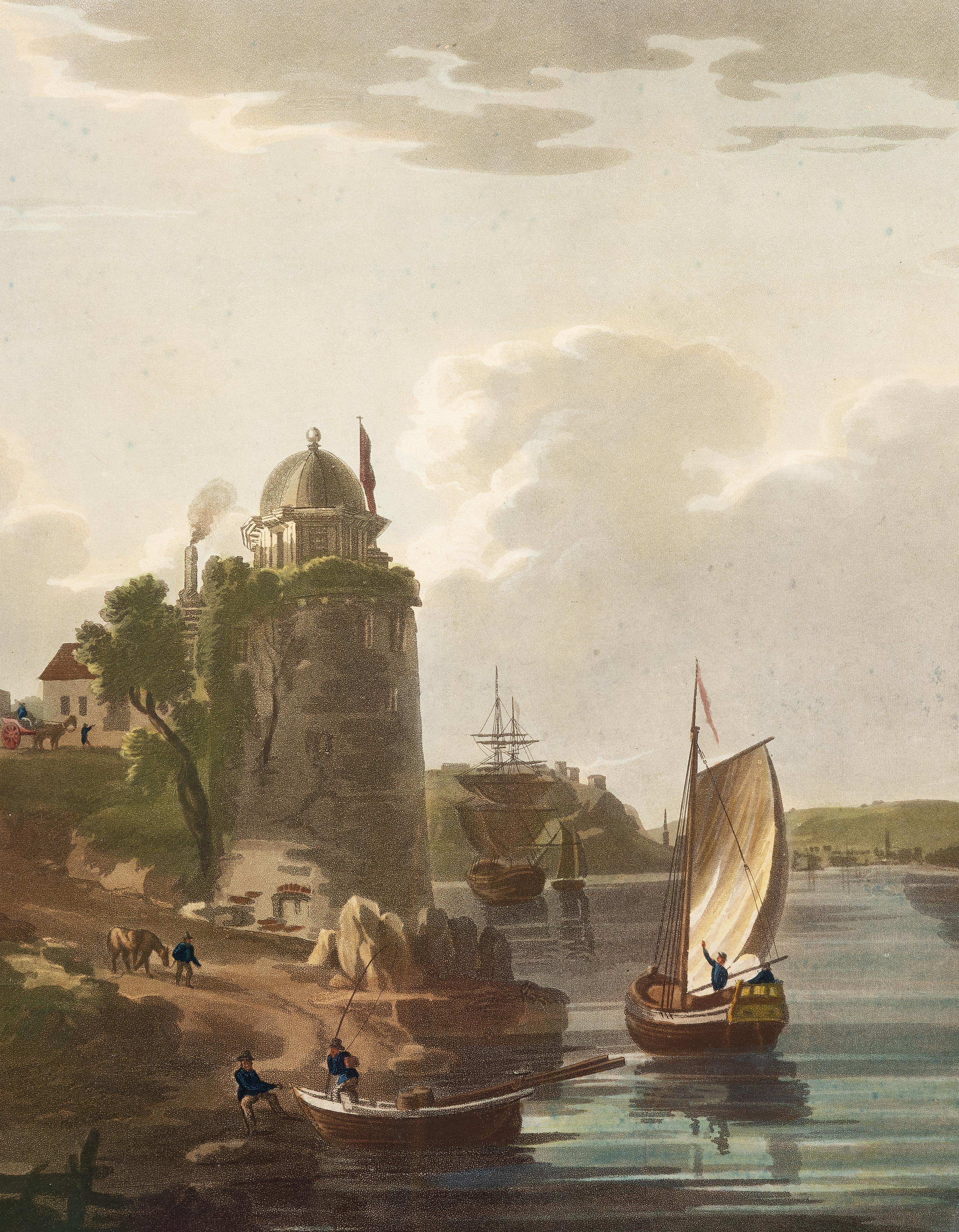
This aquatint of Blackrock Castle by Thomas Sautell Roberts depicts the original structure as it once stood along the banks of the River Lee, approximately half a mile east of Cork. The original tower, dating to the early 17th century, was part of Lord Mountjoy’s fortifications of Cork, alongside the first fort on Spike Island. Roberts’ portrayal shows the tower in a somewhat deteriorated and overgrown state, surmounted by a newer 18th-century octagonal wooden turret, which functioned as a navigation light for vessels travelling on the river. Several such ships are depicted in the scene, with a man aboard a lugger beside the castle raising his arm.
On the river’s north bank, a house situated within a wooded estate is likely Tivoli House. Additionally, the remains of a medieval fort, now destroyed, are visible atop a rocky promontory. The castle itself sustained significant damage in a fire in 1827. It had been leased by the Harbour Commissioners from the Corporation of Cork for 21 years, and by 1829, it was fully renovated. The structure was rebuilt in a Gothic style with additional turrets, and today it serves as Cork’s Astronomy Centre.
Thomas Sautell Roberts (c. 1760–1826), the son of Waterford architect John Roberts, followed in the footsteps of his brother, the painter Thomas Roberts, and his brotherin-law, George Richard Pain. After his brother’s death in Lisbon in 1778, Thomas Sautell took over his studio, completing unfinished works under his brother’s name. Renowned for his Romantic landscapes, Roberts frequently portrayed storms and seascapes in contrast to his brother’s more restrained style. Few of his oil paintings remain, but in 1801, he exhibited a series of watercolour views of Irish landscapes in Dublin, with a dozen of these scenes later reproduced as aquatint prints.
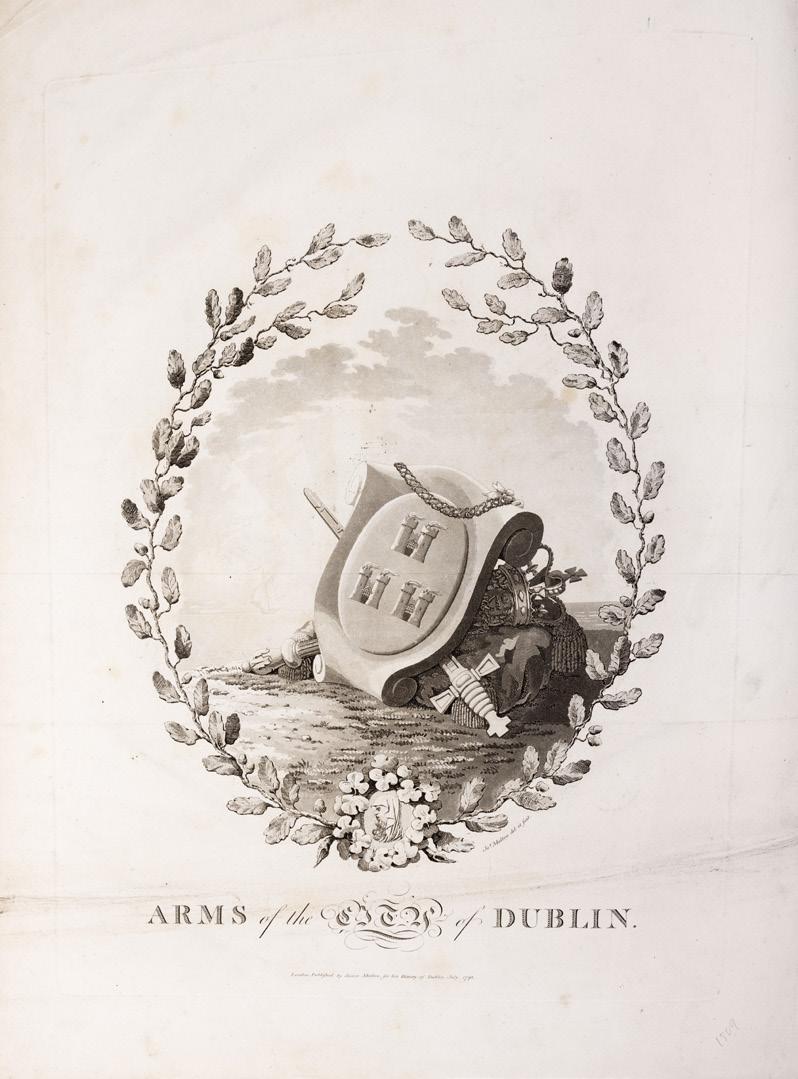
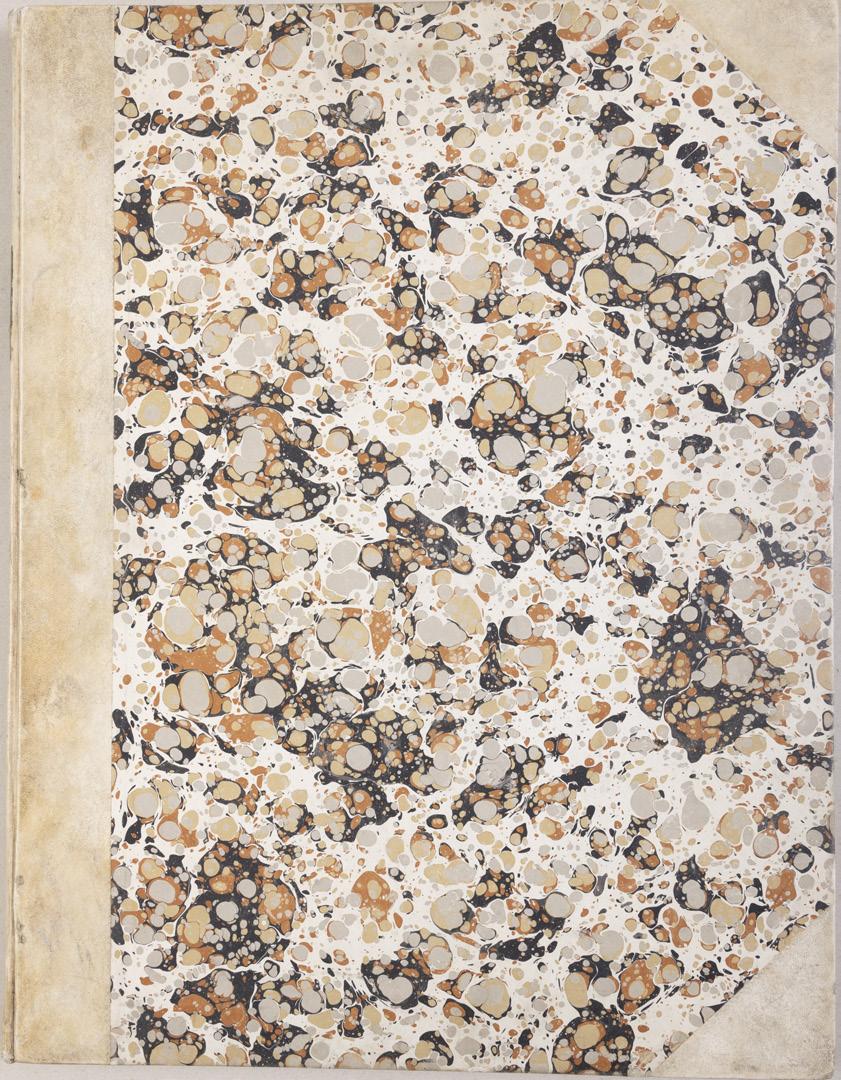
JAMES MALTON (1761-1803)
DESCRIPTIVE
In a series of the most Interesting Scenes taken in the year 1791. By James Malton. With a brief authentic history from the earliest accounts to the present time.
Oblong folio, 1809 edition, engraved titlepage and dedication, Arms of Dublin, A Correct Survey of Dublin as it stood in the year 1610, A Correct Survey of the Bay of Dublin 1795, and twenty-five plates of views. London: 1803.
The plates are as follows: Great Courtyard, Dublin Castle; The Parliament House; Trinity College; College Library; Provost’s House; St. Patrick’s Cathedral; West Front of St. Patrick’s Cathedral; Royal Exchange; Custom House; View of the Law Courts, looking up the Liffey; Tholsel; Old Soldiers Hospital, Kilmainham; Royal Infirmary, Phoenix Park; Blue Coat Hospital; Lying-in Hospital; Rotunda New Rooms; St. Catharine’s Church; Marine School; Leinster House; Charlemont House; Powerscourt House; View of Capel Street, looking over Essex Bridge; St. Stephen’s Green; Barracks; View of Dublin from the Magazine, Phoenix Park.
Dedicated to the Governors and Directors of the Hospital, including the College Library, dedicated to Edmund Burke. Besides the above twenty-five views the bound volume contains the Arms of Dublin, as frontispiece; Survey of the City of Dublin as it stood in 1610, taken from Speed’s Map; Survey of the Bay of Dublin, 1795, and a folding map of Dublin by Faden. At the end of the volume is a plate with two outline Keys - one of the smaller View of Dublin from the Park, the other of the smaller view of the Barracks. All the plates are inscribed James Malton del. et fecit
€ 8,000 - 10,000

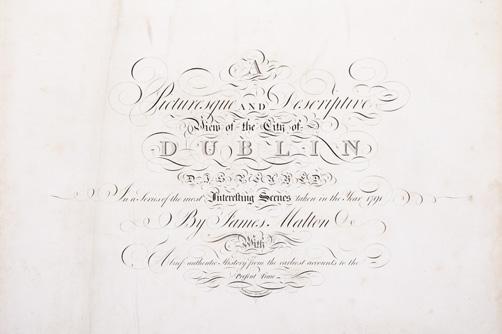
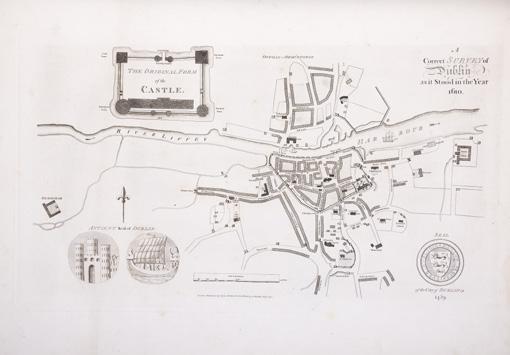
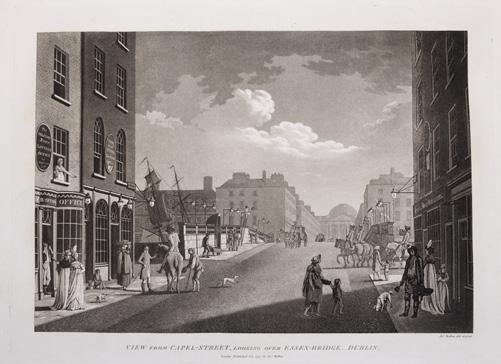
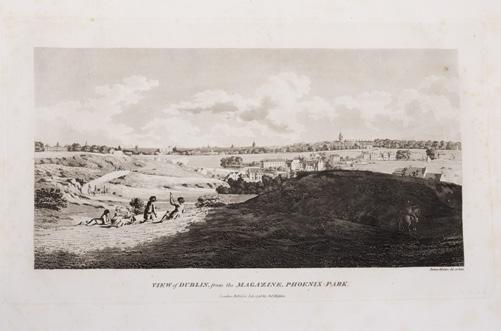
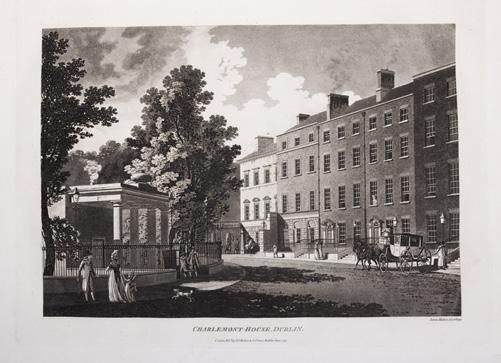
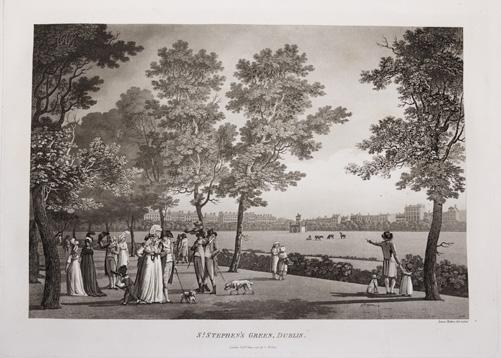
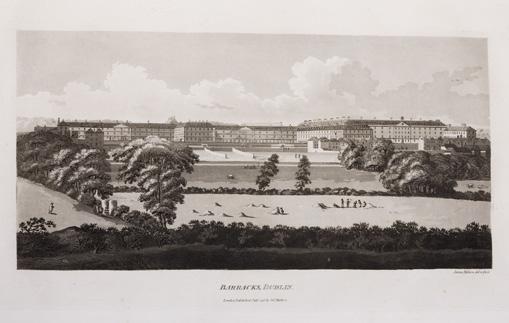
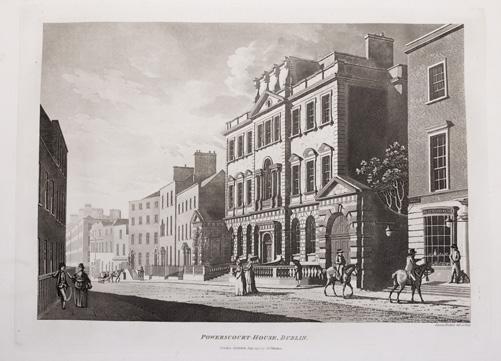
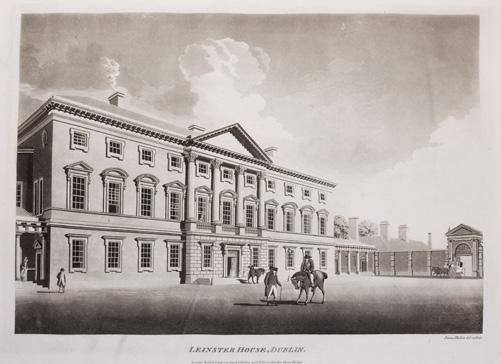
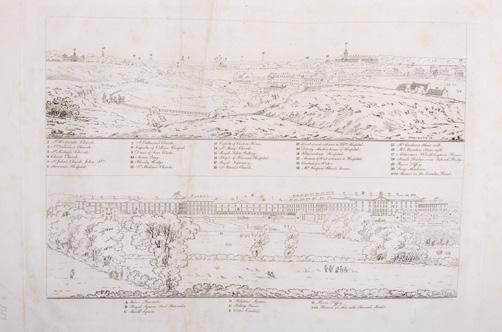
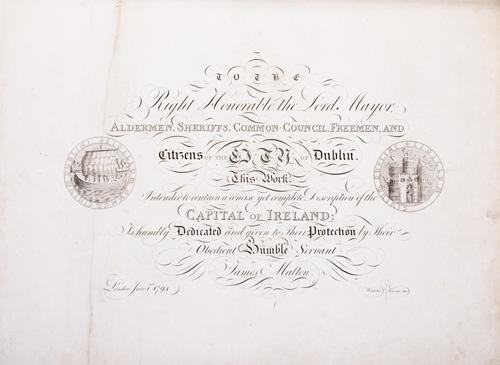
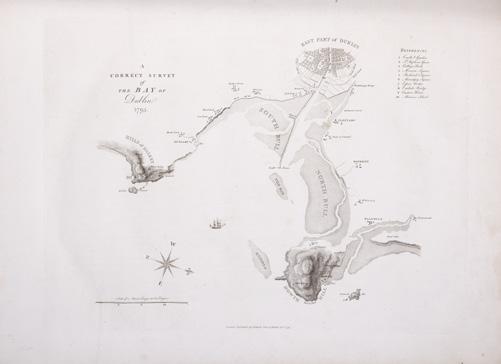
James Malton’s A Picturesque and Descriptive View of the City of Dublin (1799) constitutes a significant artistic and historical document, reflecting the author’s profound admiration for the city’s architectural grandeur. In the preface, Malton expresses his desire to bring Dublin into the cultural spotlight, believing it to be a capital that had been unjustly neglected. His work, however, emerges from a context marked by both professional turmoil and personal ambition.
“Few cities can boast more extensive conveniences, more eminent beauties, than Dublin… To convey to the curious inquirer adequate ideas of those objects; to diffuse information of a Capital so long undesertly unnoticed, and to give it that place in estimation with regard to others it merits, this work was undertaken.”
Preface, A Picturesque and Descriptive view of the City of Dublin, James Malton, 1799
Born in England in 1765, Malton was the son of Thomas Malton, a noted architectural draughtsman and instructor in geometry and perspective. The Malton family relocated to Dublin in 1769, where the elder Malton sought to establish himself within the city’s vibrant architectural scene. In 1781, through his father’s connections, James Malton secured a position as a drawing clerk under the esteemed architect James Gandon, who was then overseeing the construction of the Custom House, one of the city’s most important public buildings. Despite initial praise from Gandon, Malton’s tenure was short-lived; he was dismissed due to what Gandon described as breaches of professional trust and misconduct. This dismissal later culminated in an anonymous and caustic critique of Gandon’s architectural designs, published in 1787—a possible act of retaliation by Malton or his father.
That same year, Malton failed in his candidacy for the position of Master of the Dublin Society’s School of Architectural Drawing. Undeterred by these setbacks, Malton devoted himself to documenting the architecture of Dublin. By 1791, he had completed a comprehensive series of architectural drawings capturing the city’s most prominent buildings. These drawings vividly depicted Dublin’s Georgian streetscapes with great detail and accuracy. The engravings were issued in six installments between 1792 and 1799, with the final bound volume published that same year, complete with descriptive text.
Malton’s engravings are not merely technical records but are imbued with an artistic vision that animates the architecture of late eighteenth-century Dublin. His Picturesque and Descriptive View situates Dublin within the aesthetic discourses of the time, contributing to the visual and cultural representation of the city.
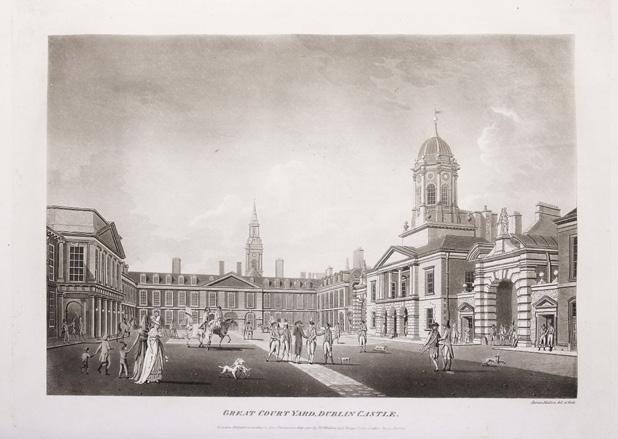
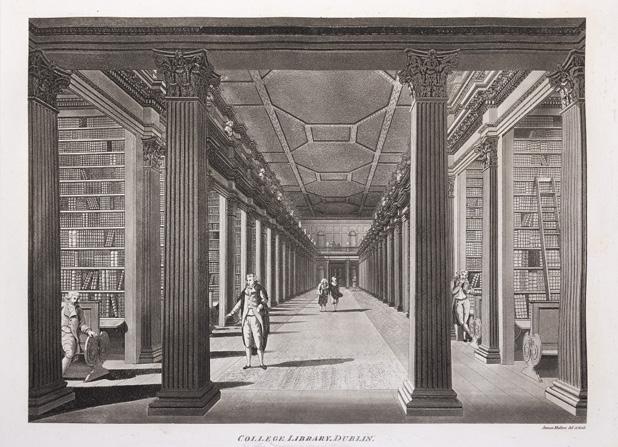
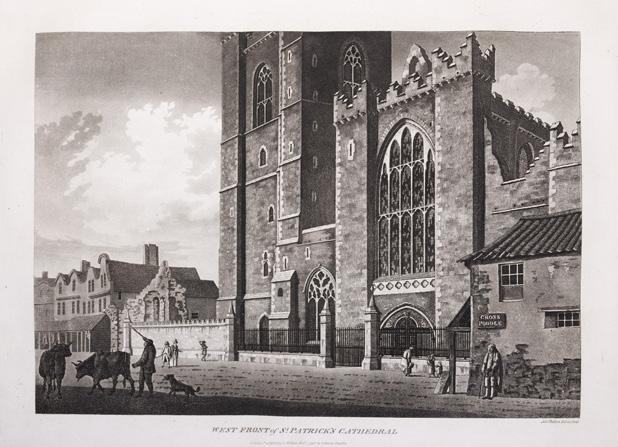
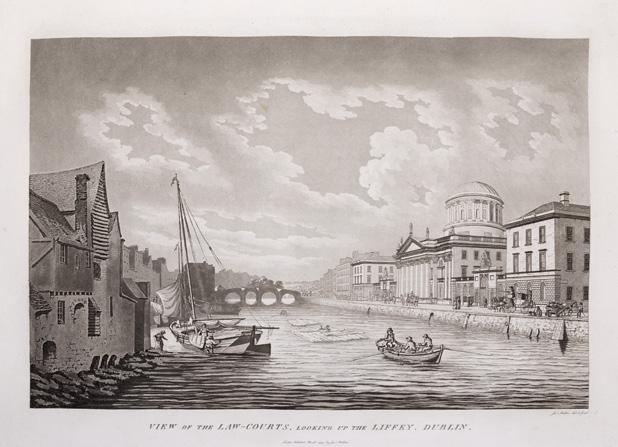


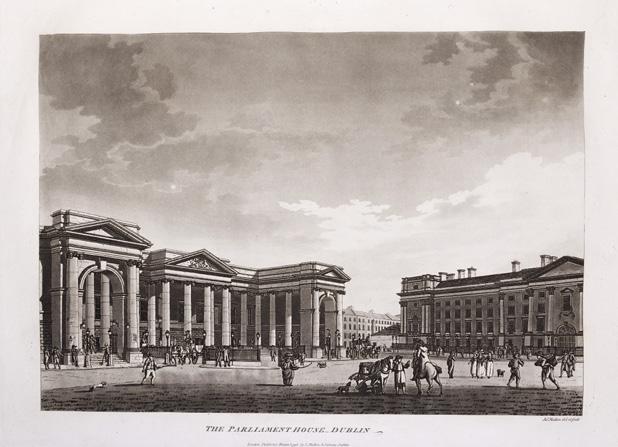


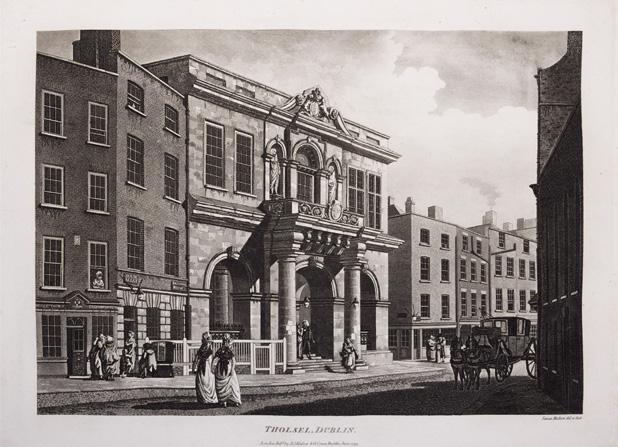
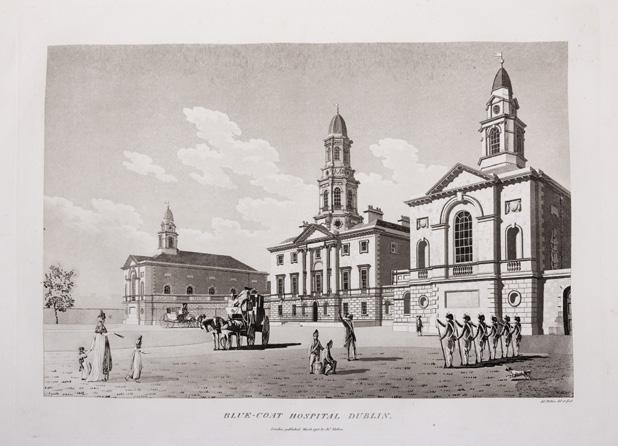
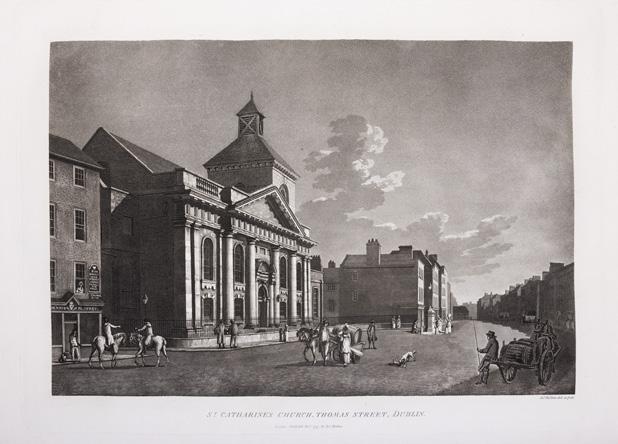
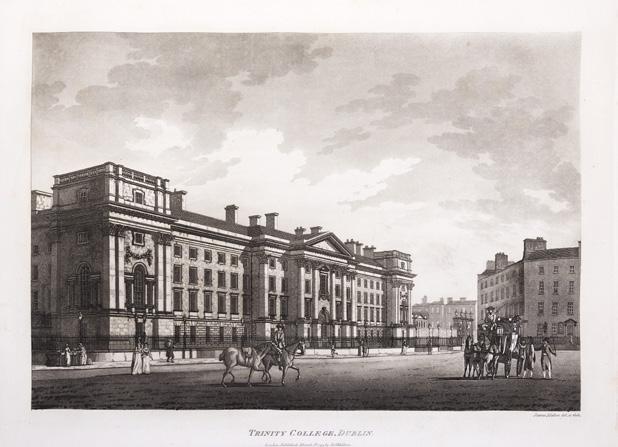

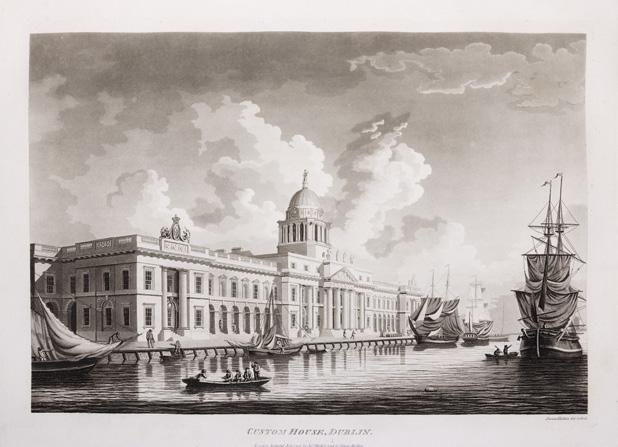
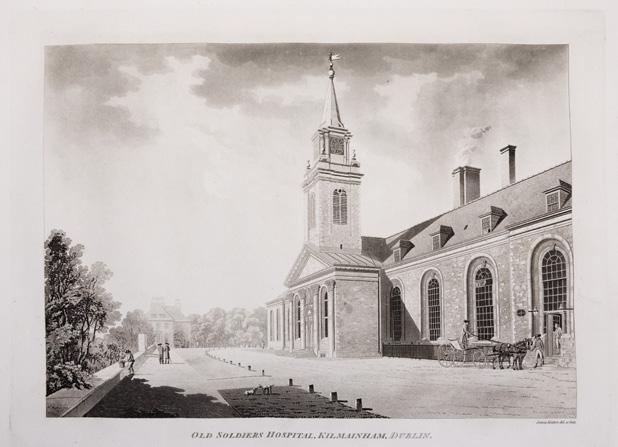
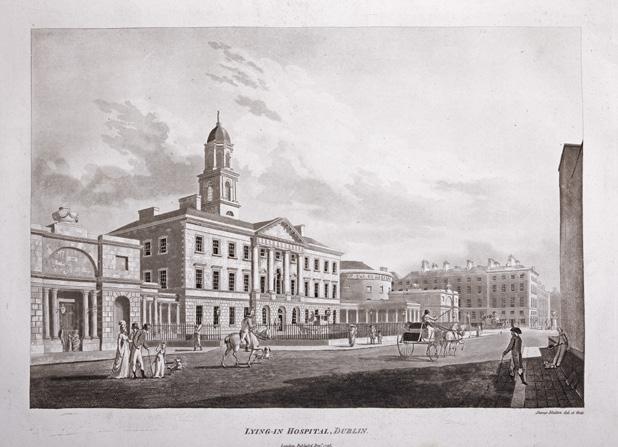
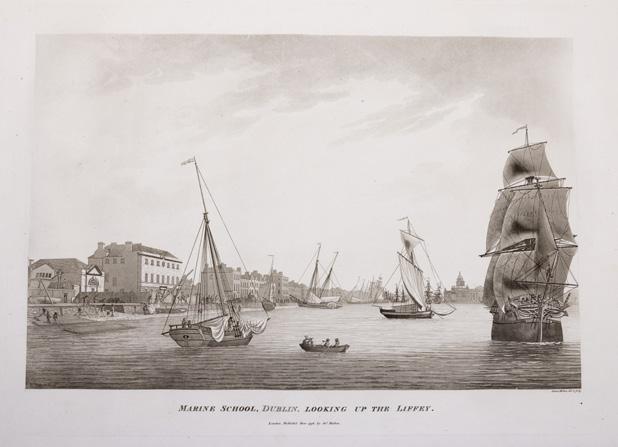
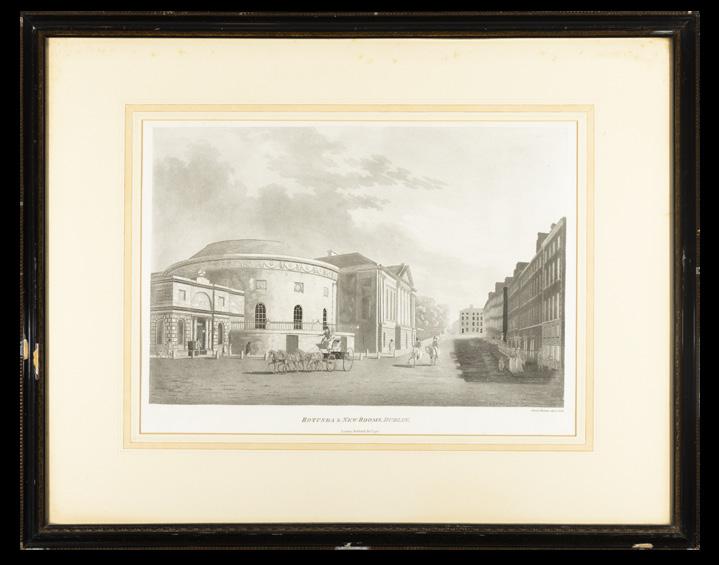

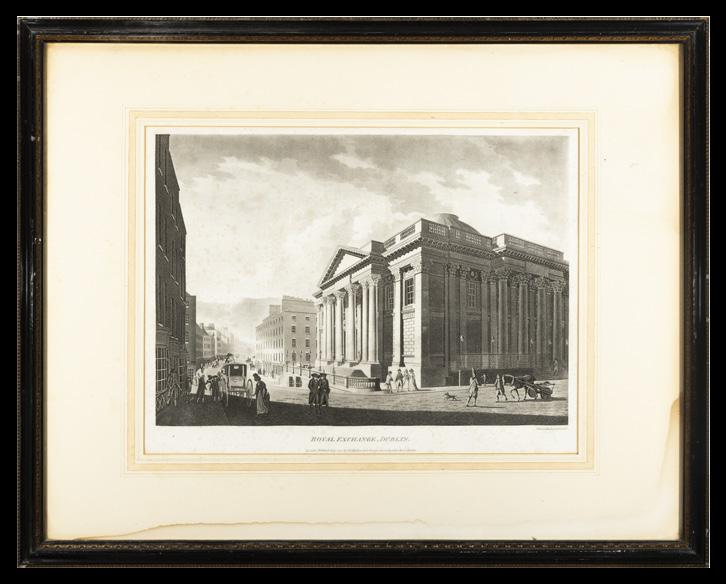
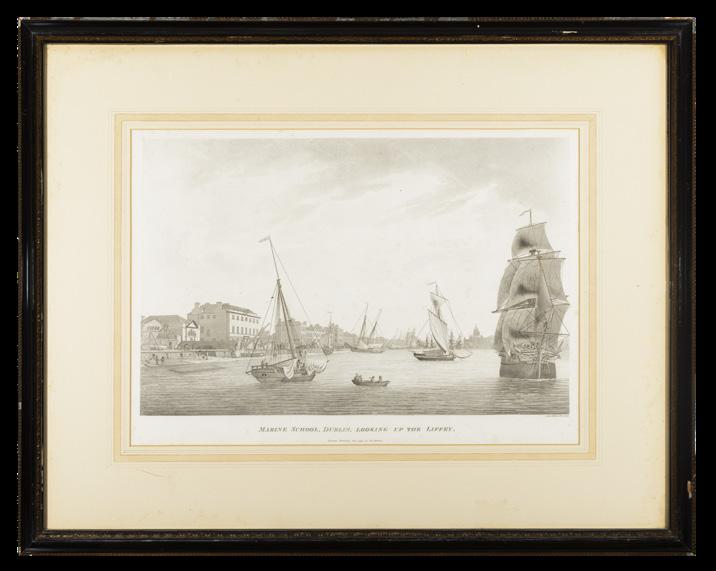
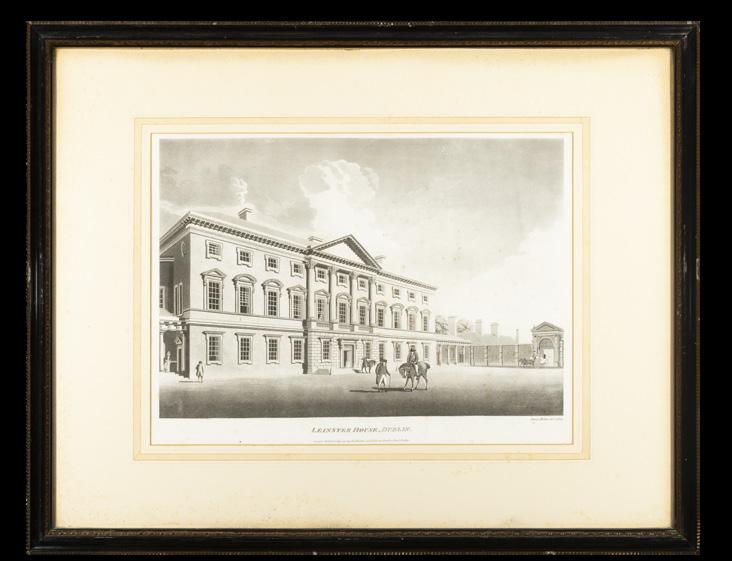

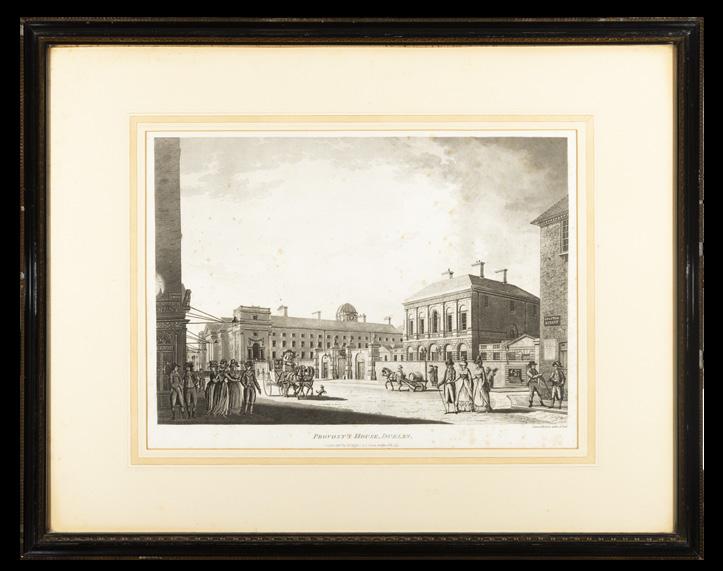
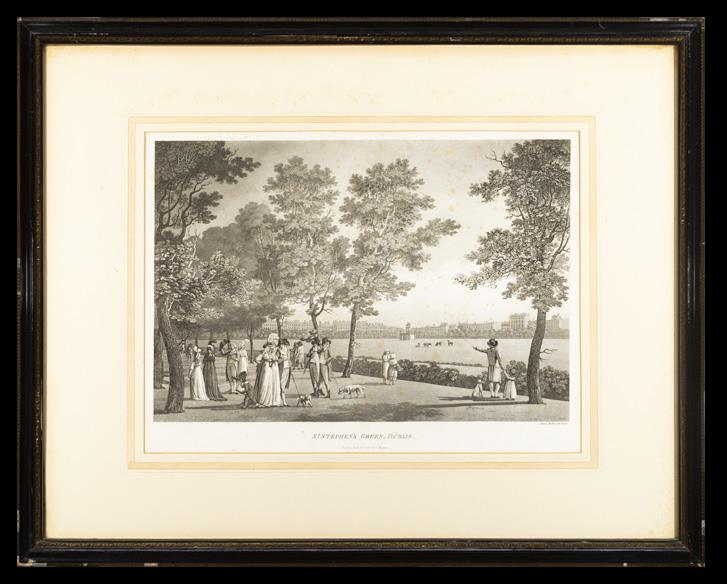
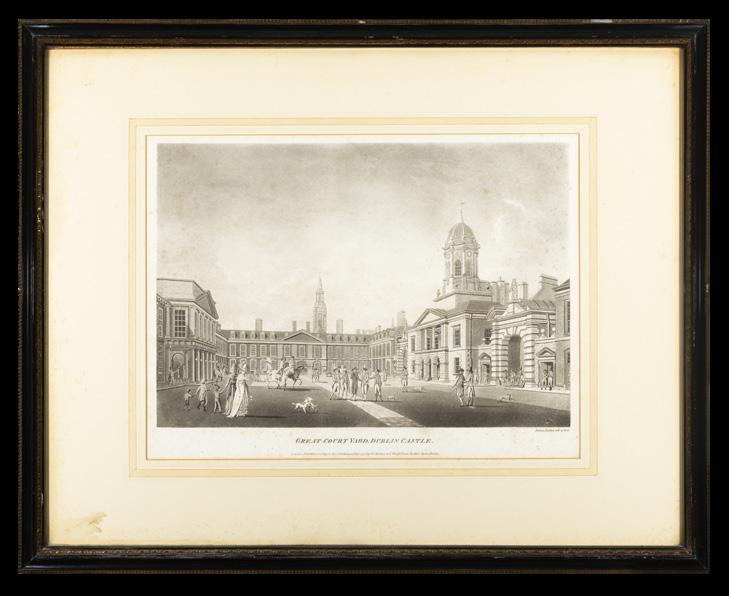
20
A picturesque and descriptive view of the city of Dublin
A set of 24 framed engravings
€ 5,000 - 7,000


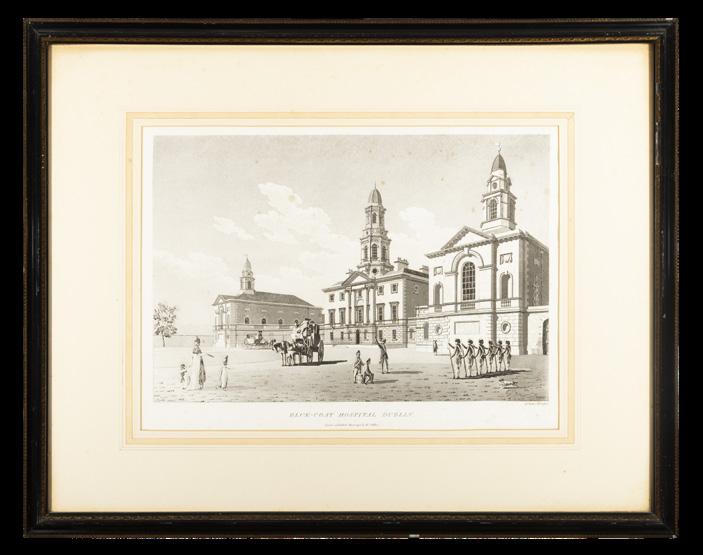
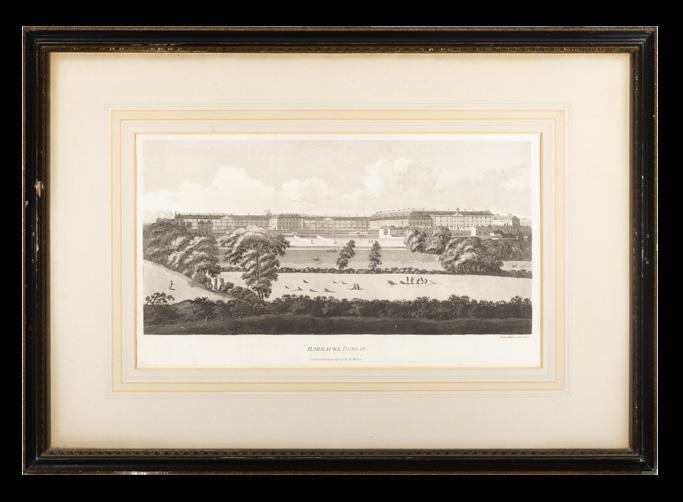
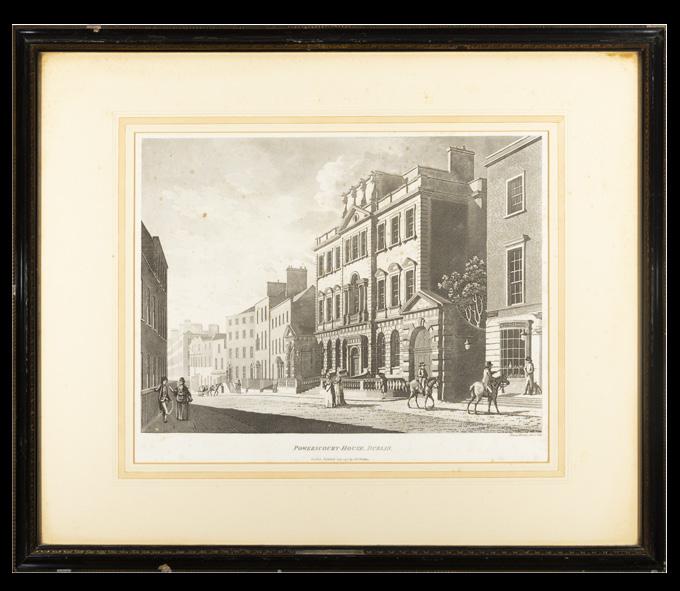
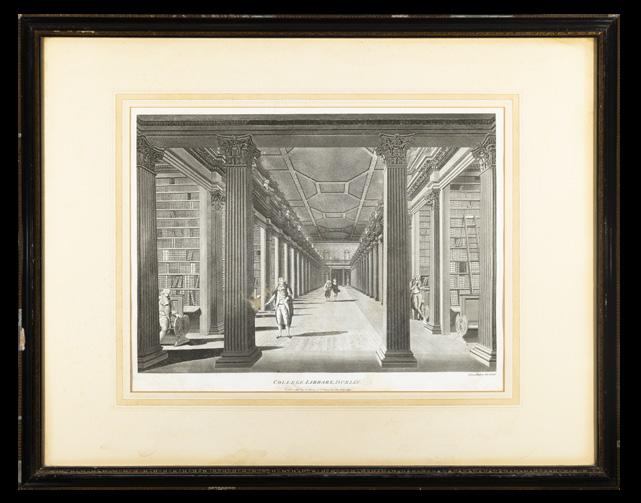

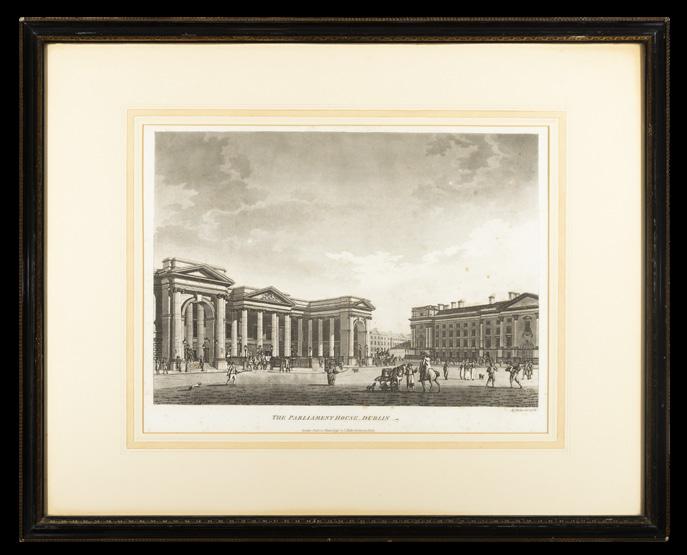

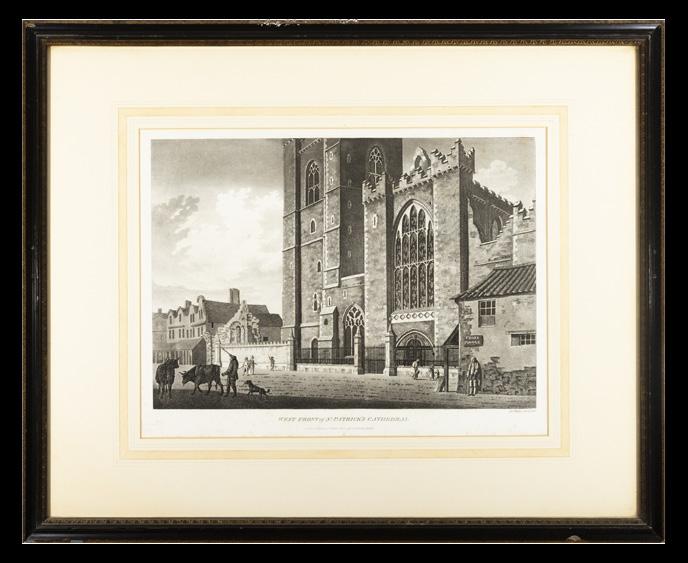
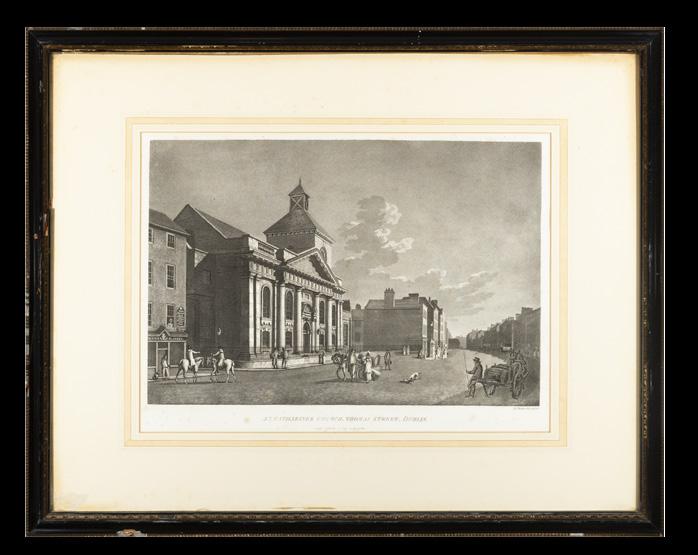
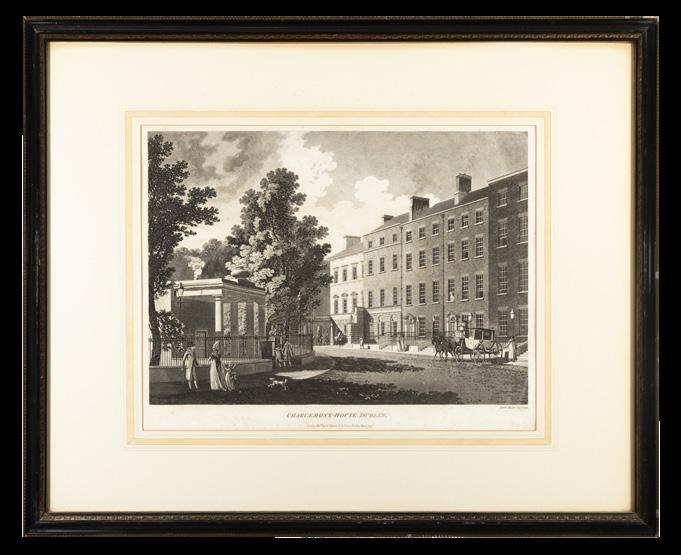

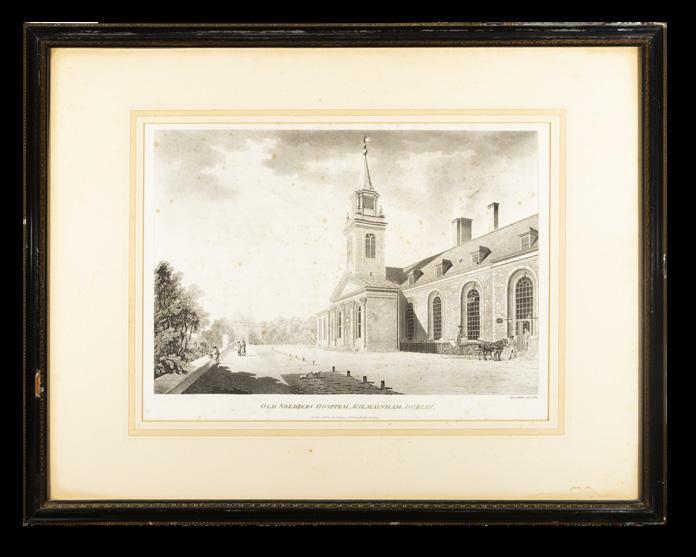


21
GEORGE BARRET
(C.1732-1784)
Figures Sitting Outside a Farmstead
Bodycolour on paper, 18 x 24.5cm
€ 800 - 1,200

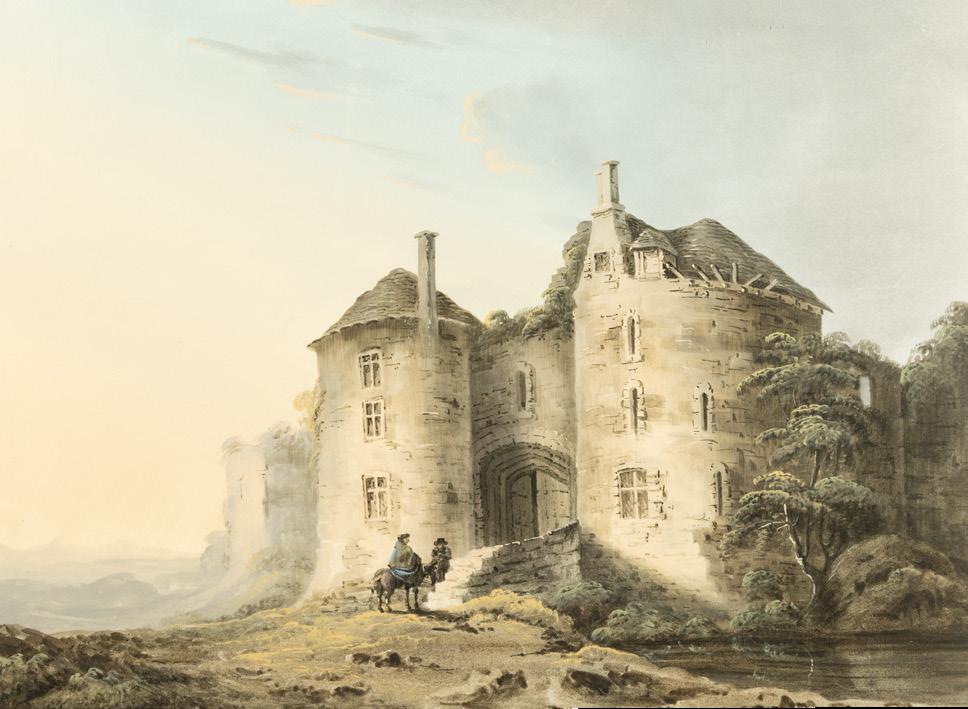
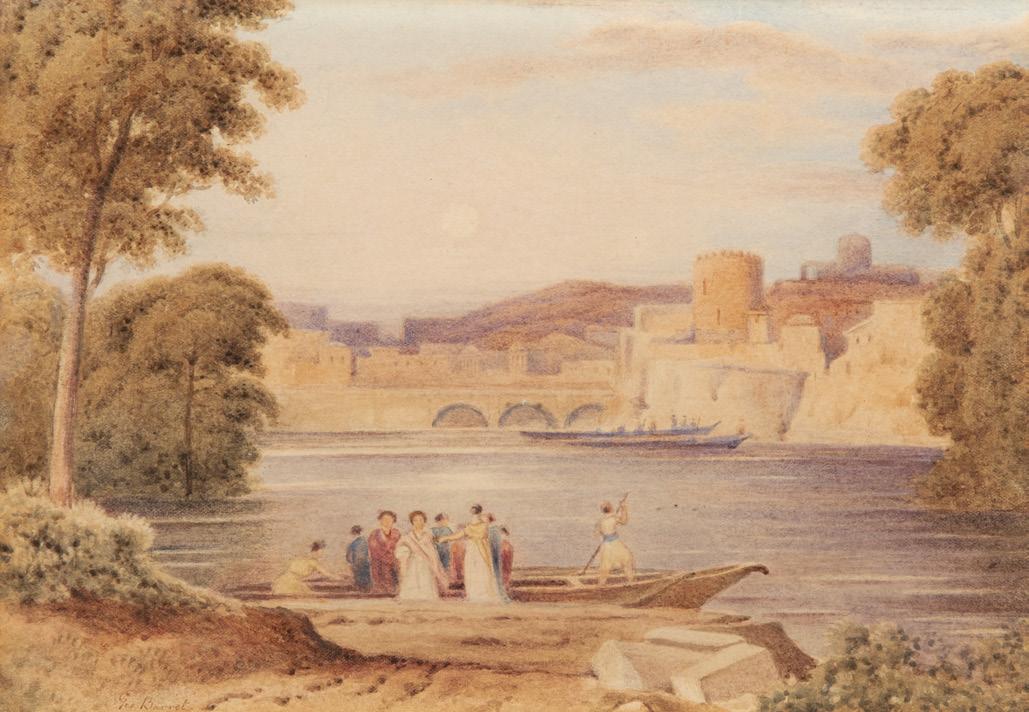
22
GEORGE BARRETT THE YOUNGER (1767-1842)
Figures By A River, A Citadel and Mountains Beyond
Signed 'Geo Barrett' (lower left)
Watercolour, 18 x 24cm
€ 400 - 600
23
THOMAS WAMSLEY (1763-1806)
Front View of St. Briavels Castle, Gloucestershire
Gouache, 31 x 42cm
View of Lady's Tower, Goodrich Castle, Herefordshire
Gouache, 31 x 42cm
€ 800 - 1,200

Figures Struggling in Windy Conditions on an Exposed Hilltop
Blue and grey wash over pencil, 23 x 37cm
Signed and dated 1809
Provenance: Christie’s, London, 25 November 1986, lot 10 (as ‘A Windy Day on the Macgillycuddy’s Reeks’)
€ 800 - 1,200
ATTRIBUTED TO PETER DE GREE (PIETER
(1751-1789)
An Allegorical Scene Oil on canvas - en grisaille, 140 x 144cm
Born in Antwerp, Peter de Gree (d. 1789) was a decorative painter renowned for his large-scale murals and ceiling decorations executed in the grisaille technique. His presence in Ireland is first documented in 1785 in correspondence from Sir Joshua Reynolds to the Duke of Rutland, who employed de Gree as “an agent for purchasing pictures” for himself and the Duke. De Gree was widely regarded as a master of grisaille, a highly illusionistic style imitating relief sculpture that gained popularity during the eighteenth century. This period saw a burgeoning interest in classical antiquity and a demand for interior decorations in the grisaille style. Artists like de Gree adapted this technique into their distinct artistic expressions.
De Gree’s first and most notable commission in Ireland was for David La Touche at his residence, 52 St. Stephen’s Green, Dublin. He decorated the music room with murals of mythological subjects related to music. In the dining room, he created another series featuring six Olympian deities alongside representations of the four classical elements: Earth, Air, Fire, and Water. These works were later relocated by Lord Robert Ponsonby Tottenham to his residence at Woodstock, Co. Wicklow, and subsequently acquired by the State in the 1980s; they are now housed at Dublin Castle. Another significant example of his work survives at Curraghmore House, Co. Waterford, where he painted circular panels of the Gods of Olympus in the dining room and classical medallions of Amorini on the drawing room ceiling. These works exemplify his graceful compositions and adherence to the classical traditions of the period.
The present example, though unsigned, exhibits a strong stylistic resemblance to Peter de Gree’s grisaille work. Its large scale tondo and relief-like composition implies its intended use as an architectural decoration, possibly for a ceiling or an inset wall panel - settings that frequently featured classical or religious themes.
The scene appears to depict a classical or biblical narrative. A seated young man, with a contemplative expression, staff in hand, and animals nearby, evokes the archetype of a shepherd. The standing elder figure, with an uplifted hand gesturing skyward, suggests a prophetic or divine role. The inclusion of a book with radiating Sun - an emblem of Truth- hints at themes of divine revelation or wisdom. Alternatively, within an allegorical framework, this composition might symbolise a philosopher imparting divine inspiration or the manifestation of Divine Truth to the soul.
€ 3,000 - 5,000

NATHANIEL HONE, (THE ELDER) RA (1718-1784)
A half length portrait of a young boy, possibly one of his sons, as a midshipman
Oil on canvas, 61 x 51cm
Provenance: Sale, Adam’s, 6 December 2010, lot 102
The earliest of the dynasty that has given Ireland some of its finest artists, Nathaniel Hone was born in Dublin in April 1718, his parents having emigrated from Holland. Nothing is known of his training, but early pastels suggest that he studied with Robert West while he was running a private academy before the foundation of the Dublin Society Schools. His earliest surviving work, a portrait of George Gostling, is dated 1741, by which date he was probably already in England working as an itinerant portrait painter, mostly in miniature. The following year he married an heiress, Mary Earle, at York Minster. Hone met with early success with his miniatures, particularly after Christian Friedrich Zincke, the leading practitioner of the day, was forced to retire due to failing eyesight.
By the early 1750s, Hone was well established in London, listing almost sixty commissions in his diary for 1752, and was charging ten guineas for a miniature portrait. The following year he visited Paris and completed the life-size Portrait of Viscount Milsington, which demonstrates his increasing confidence on a large scale. From about 1760, when he sent A Brickdust Man to the Society of Artists, he turned away from miniatures and produced a series of suave full-length portraits, notably of the Irish mariner Captain Robert Boyle. Hone was appointed one of the directors of the Society of Incorporated Artists in 1766, but resigned two years later to become a founding member of the Royal Academy, along with George Barret, one of two Irish artists to be so honoured. He sent a total of sixty-nine works to the annual shows, but—as is well known—Hone, a sometimes difficult man, fell out with his fellow academicians and nursed a long-standing feud with the President, Sir Joshua Reynolds. Matters came to a head in 1775 with the controversy surrounding The Conjuror (National Gallery of Ireland), in which Hone cleverly caricatured Reynolds for his supposed plagiarism. The painting was rejected for exhibition, and Hone displayed it instead, along with almost a hundred of his works, in St Martin’s Lane. Despite this episode, he continued to exhibit at the Academy until his death in 1784.
€ 8,000 - 12,000


27
NATHANIEL HONE, (THE ELDER) RA (1718-1784)
Gentleman in a Red Coat and a white neck tie
Oil on canvas, 75.5 x 63.5cm Bearing label verso
Provenance : The Irish Sale, Sotheby's, London, 11 May 2006, lot 2
€ 6,000 - 8,000
28
NATHANIEL HONE, (THE ELDER) R.A (1718-1784)
Portrait of Kitty Fisher
Oil on canvas, 72 x 60cm
Provenance: Senator Edward McGuire, Newtownpark House, Blackrock, thence by descent
€ 2,000 - 4,000
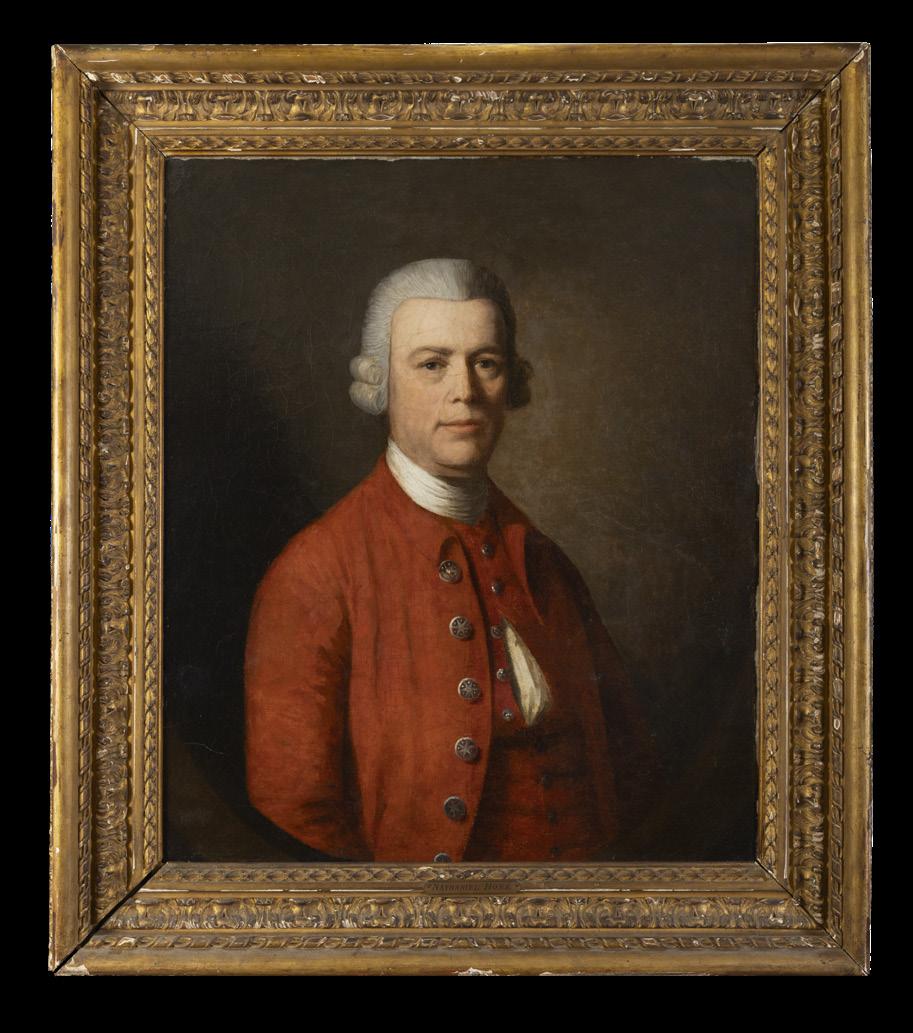

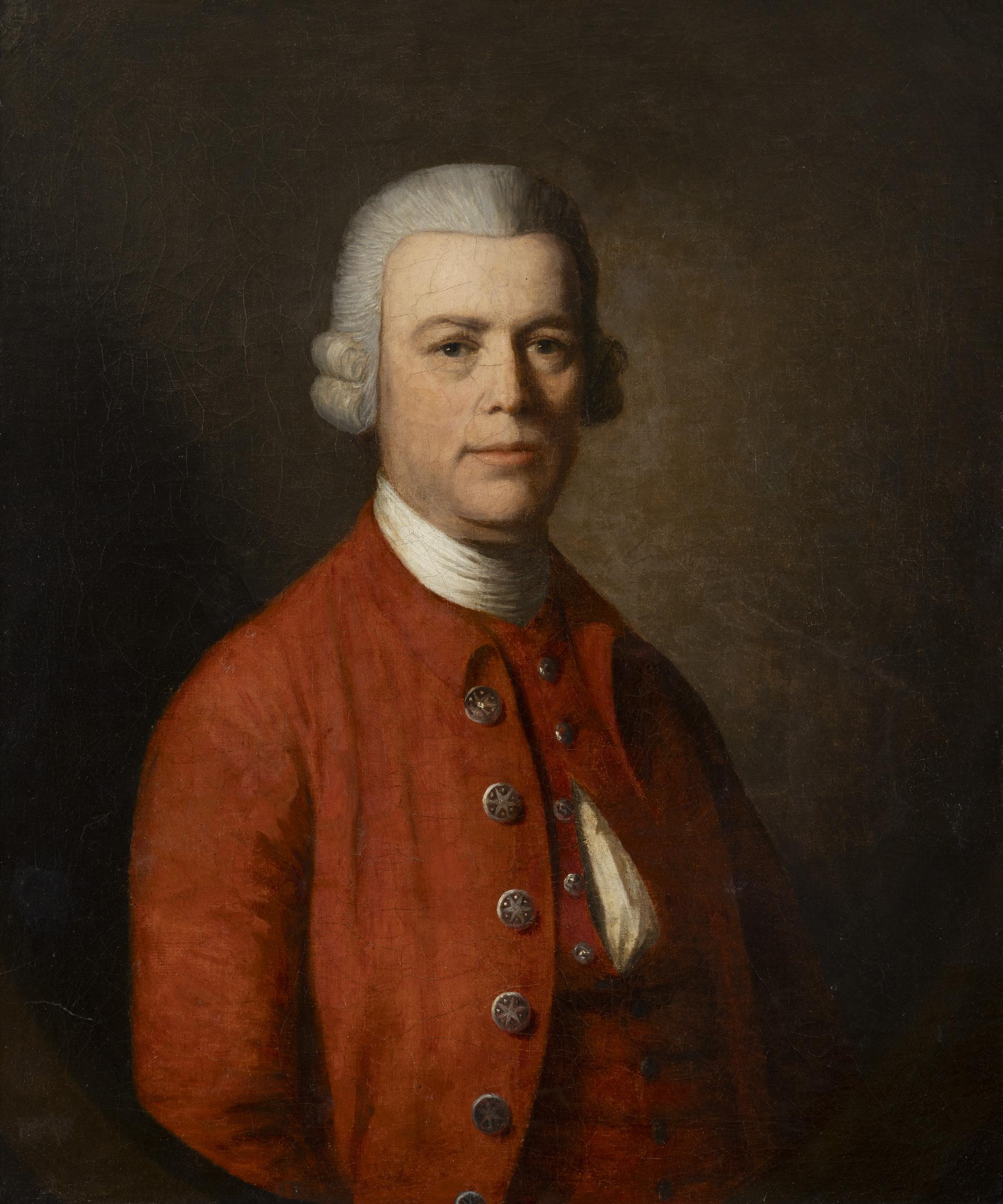
A Group of Five Mythological Landscapes; a preparatory scheme for the murals at Lyons, County Kildare
Pen and ink on paper, the largest 34.5 x 29 cm (5) One signed and dated 1805
€ 10,000 - 15,000
The Italian artist Gaspare Gabrielli was brought to Ireland by Valentine Lawless, Baron Cloncurry (1773-1853), specifically ‘for the purpose of decorating rooms at Lyons’ (Strickland, Vol. 1, p. 390), his great house in Kildare. In addition to bringing an Italian artist home with him from the Grant Tour, rather than relying on one of the talented native practitioners such as William Ashford (1746-1824), Cloncurry further demonstrated his commitment to the classical tradition by importing three shiploads of ancient statuary and artefacts from Rome, including columns from Nero’s Domus Aurea which he incorporated into Lyons’s portico. A fourth consignment was lost with its ship off the coast of Wicklow. Dating to the final months of 1805, this important group of landscape drawings represents an early stage within the progression of Gabrielli’s commission for Cloncurry, which created one of the most beautiful and best-known rooms of any Irish country house. June Eiffe, writing in the Bulletin of the Irish Georgian Society in 1984, judged the murals as ‘the finest painted interior in Ireland’, while Gabrielli’s work at Lyons has been described as of ‘paramount importance for the study of early nineteenth-century art in Ireland’ (Deirdre Phelan, Lyons Demesne, A Georgian Treasure Restored to the Nation (1999) p. 31). The identification of these highly finished preparatory drawings sheds intriguing new light on the project’s genesis, while, at the same time, representing an exceptionally rare survival of graphic evidence for an Irish mural project of the Georgian period.
Gabrielli was a young artist of just twenty-five when he arrived in Kildare and, as Strickland records, ‘he lived at Lyons for a couple of years during the progress of his work, and married Lady Cloncurry’s maid’ (ibid). With one exception, these drawings showing various mythological subjects, including Pan and Syrinx, differ in subject matter from the scenes that Gabriellli would eventually paint, in tempera on gesso, at Lyons, which take for their subject the ‘times of the day’. They share, however, the same upright format and are related to the completed murals in their setting of rocky caverns and landscapes lush with dense verdure, as well as in the distinctly mannerist elongation of the figures. Gabrielli dates one of the sheets to 1805, soon after his arrival in Ireland (he came in autumn of that year), when he was working exclusively for Cloncurry and they were presumably drawn to show his client a possible design which was subsequently refined. The composition of one of the drawings survived into the final work as executed. The drawing showing a nymph sacrificing at an altar was repeated in the mural, with only small differences in the arrangement of the tree’s branches and the positioning of the water. It is noticeable
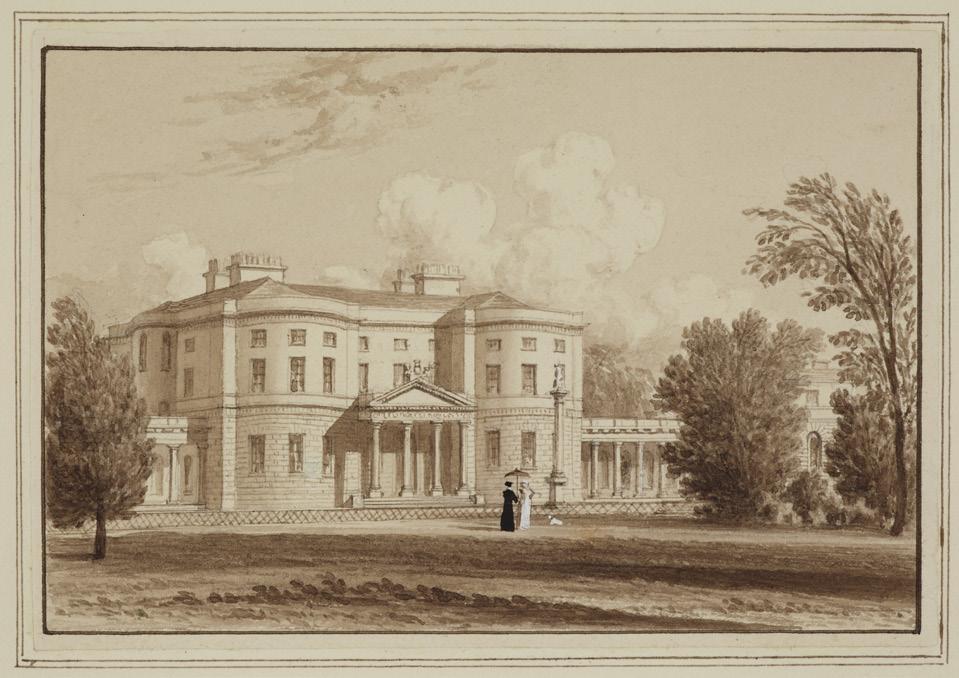

that the landscape backdrop of the finished work is rather more Irish – and deciduous – than the more classically inflected foliage of the drawing. Clearly Gabrielli studied the Irish scenery in the months after his arrival and at Lyons he painted images of Poulaphouca Waterfall and the Salmon Leap at Leixlip while, nicely symbolising the union of the Irish and Italian picturesque to be found at Lyons, he also included images of the equally famous bays of Naples and Dublin. Representing the first stage of the process, and dating from the months after his arrival, these drawings can be associated with a payment to the artist, recorded in the Lyons accounts on 28 December 1805, of eleven pounds and ten shillings. As is well known, when working on the Lyons
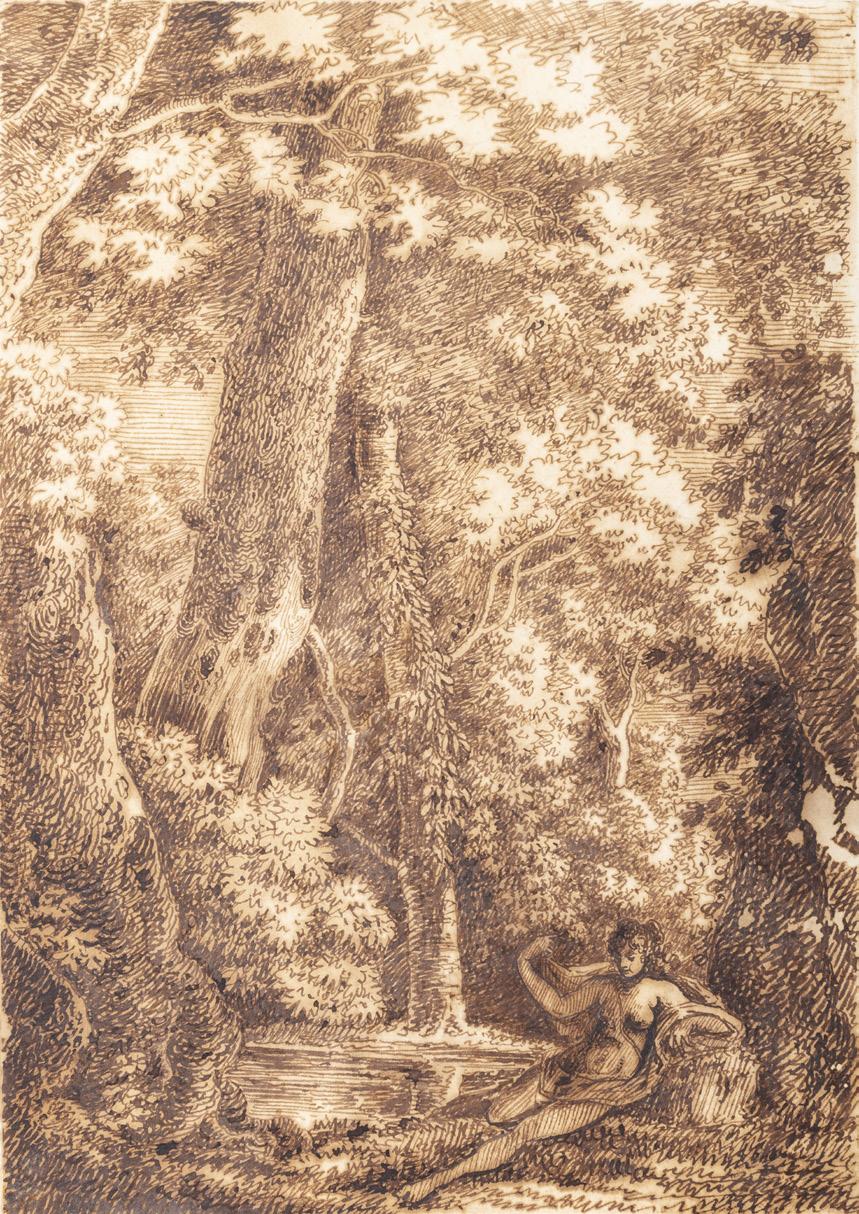

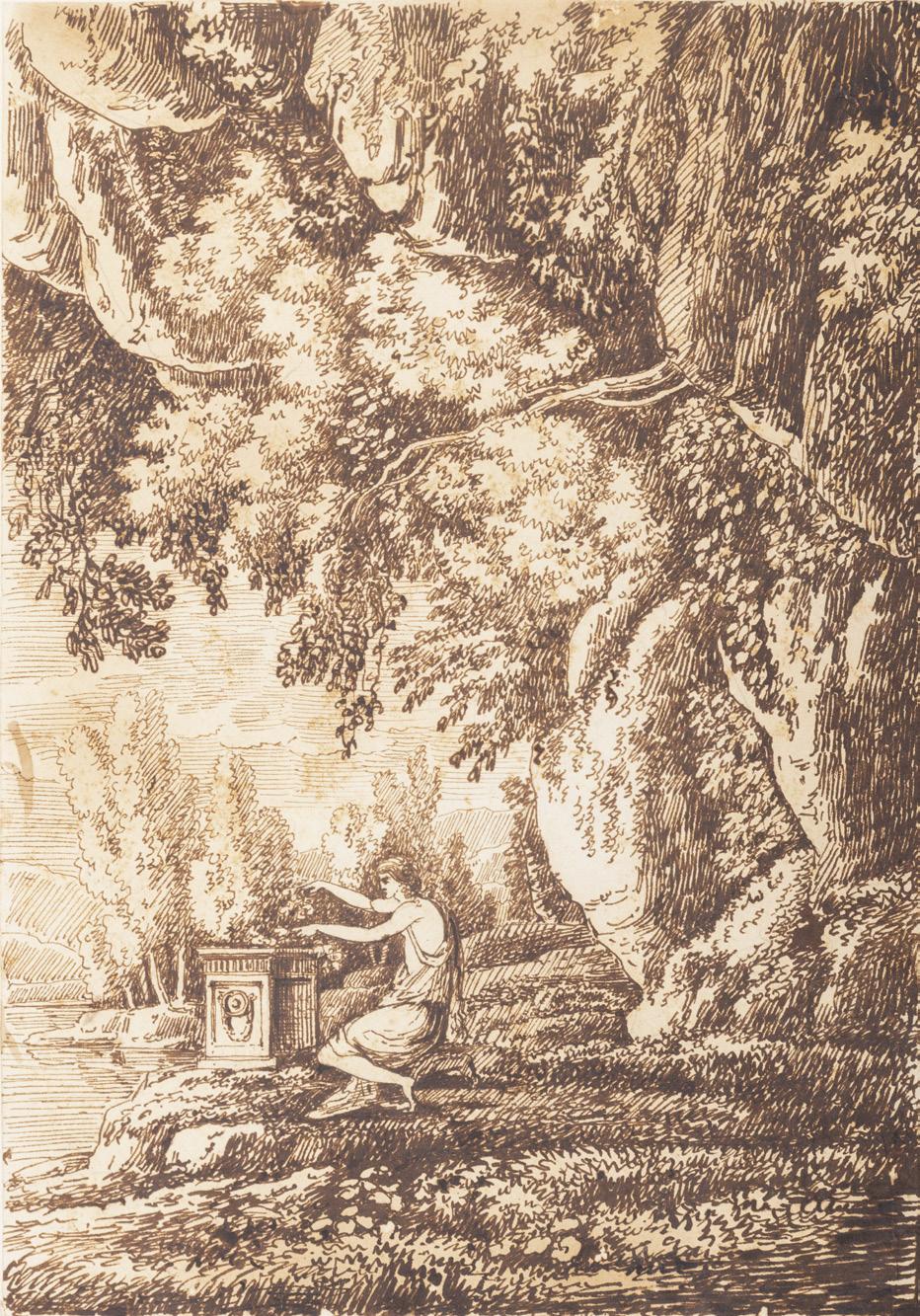
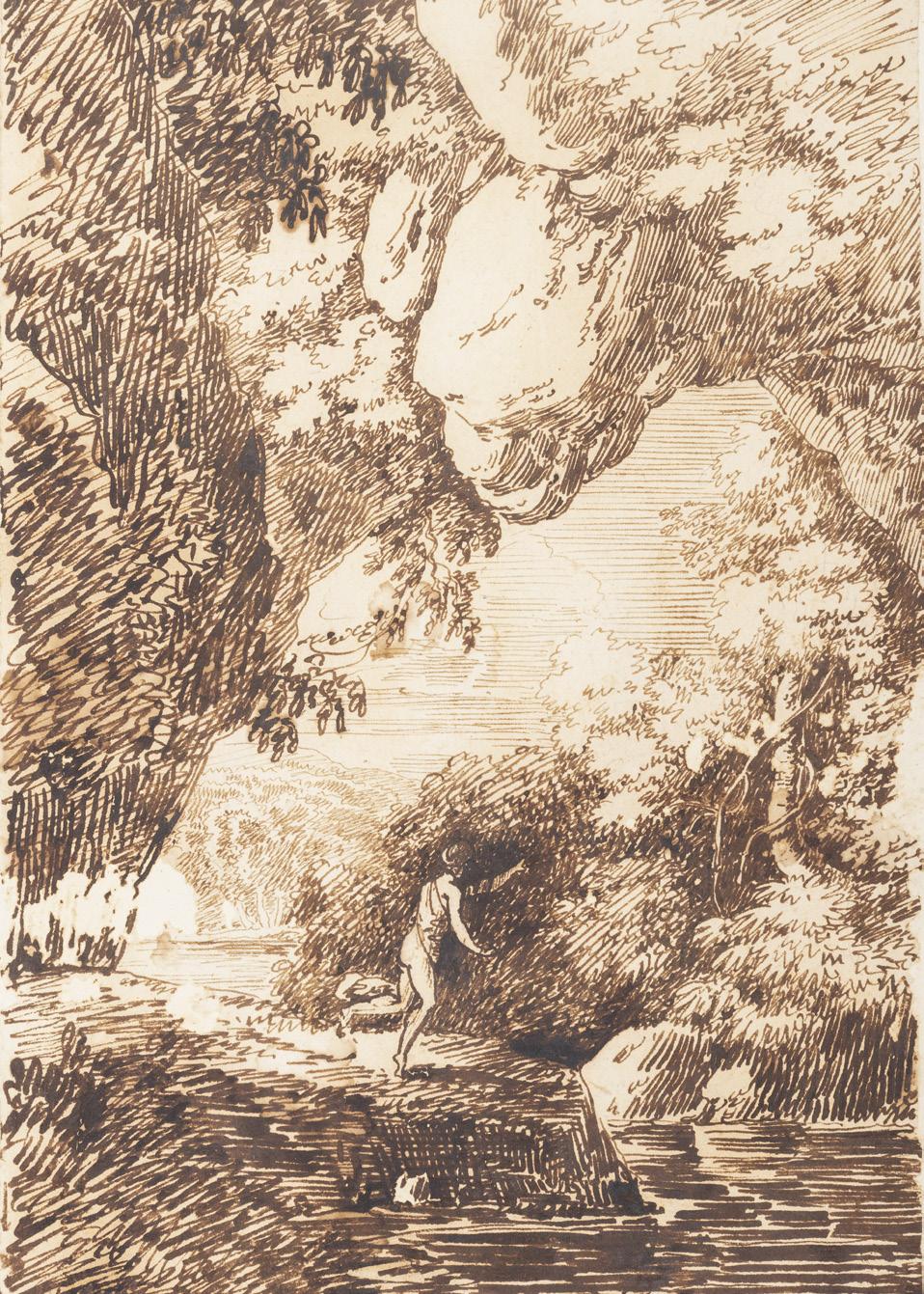
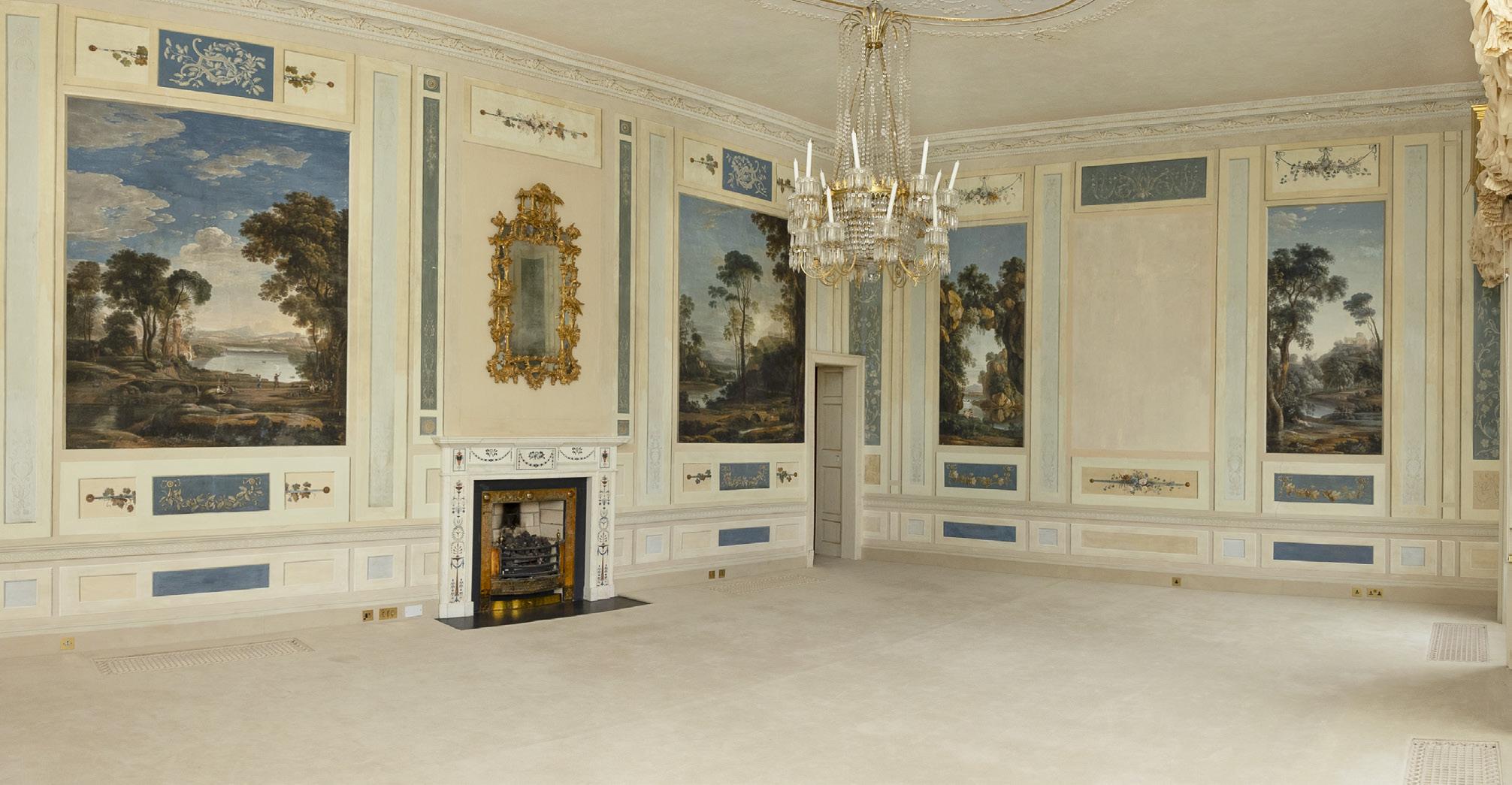
the patron into the design process, no doubt, of course, facilitated by Gabrielli’s residence at Lyons.
murals, Gabrielli witnessed the ‘indiscretion’ of Lady Cloncurry with Sir John Piers (1772-1845), which led to the famous trail for ‘criminal conversation’. The scandal was commemorated in a caricature, showing Gabrielli painting high on a scaffolding while events unfolded below, and later in a famous poem by Sir John Betjeman (1906-84).
Gabrielli’s drawings are resolutely Italianate in their classical landscape vocabulary, with elements derived from Gaspard Dughet (1615-75) and Domenichino (1581-1641) – the fleeing nymph in one of the drawings recalls the figure of Daphne in the latter’s decoration of the Stanza di Apollo at the Villa Aldobrandini, Frascati (National Gallery, London) – while at the same time echoing the more recent room schemes of Hubert Robert (1733-1808). However, Gabrielli offers one nod to his new home country and to the political allegiance of his patron. Cloncurry, despite his privileged position, was radically involved and a sworn United Irishman, indeed he was a member of the executive of the revolutionary organisation. When rebellion broke out in 1798, he was arrested on suspicion of high treason and imprisoned in the Tower of London. Just two years before the Lyons commission, Cloncurry was rumoured to be a likely member of the Provisional Government to be established had Robert Emmet’s (1778-1803) rebellion succeeded (he wisely took the precaution of being in Italy when it erupted). In one of the drawings, a nymph plays not a lyre, as one would expect in the Italian tradition, but a, Irish harp, the instrument which had become an emblem of the United Irish movement, especially after the Belfast Harp Festival of 1795. Here, Gabrielli directly echoes Robert Fagan’s (1761-1816) famous image of another scantily clad young woman ‘as Hibernia’ to produce a similarly charged fusion of Italianate design and Irish political symbolism which anticipates by some years the iconography of the Young Ireland movement. Given the length of time that the commission took, and the differences between these original designs and the finished works – and also taking into consideration what we know of Cloncurry’s personality – it seems that there was considerable input from
After completing the commission for Cloncurry, Gabrielli moved to Dublin, living first on Westmoreland Street and subsequently on Lower Sackville (now O’Connell) Street. He enjoyed much success and became an important figure in Irish artistic circles. Between 1809 and 1814 he showed over sixty works in Irish exhibitions. Gabrielli was elected vice-president of the Society of Artists of Ireland in 1811 and sent landscape paintings of Irish subject matter to the Royal Academy in London. In addition to his famous work at Lyons, Gabrielli decorated a room with views of Herculaneum for the Duke of Manchester (1771-1843) at Tandragee Castle, County Armagh, and may also have been responsible for the landscape murals in the drawing room of 41 North Great George’s Street, Dublin (Georgian Society Records (1909-13) Plate XCII).
In, or about, 1814 Gabrielli returned to Rome with his wife and son, living in rooms on Via Sistina and, the following year, he became a member of the Accademia di San Luca. However, he nurtured the contacts he had made in Ireland and his studio was much frequented by Irish and English Grand Tourists. He served as agent to the 6th Duke of Devonshire (1790-1858) and, in 1822, dispatched seven packing cases, full of antique and more recent sculpture, chimney pieces, and the Roman mosaic floor which is such a feature of its Entrance Hall, back to Ireland for Ballyfin, County Laois, the great house then under construction for Sir Charles Coote (1794-1864). Clearly, he had learned from the example of Cloncurry in shaping the taste for incorporating Roman spolia into the newly built neo-classical country houses of Ireland. It seems that Gabirelli shared networks of patronage with the architects Richard and William Vitruvius Morrison – who had remodeled Lyons for Cloncurry and designed Ballyfin for the Cootes. He also worked for their mutual clients, the Earl of Meath at Killruddery, County Wicklow, and the Smith-Barrys at Fota, County Cork.
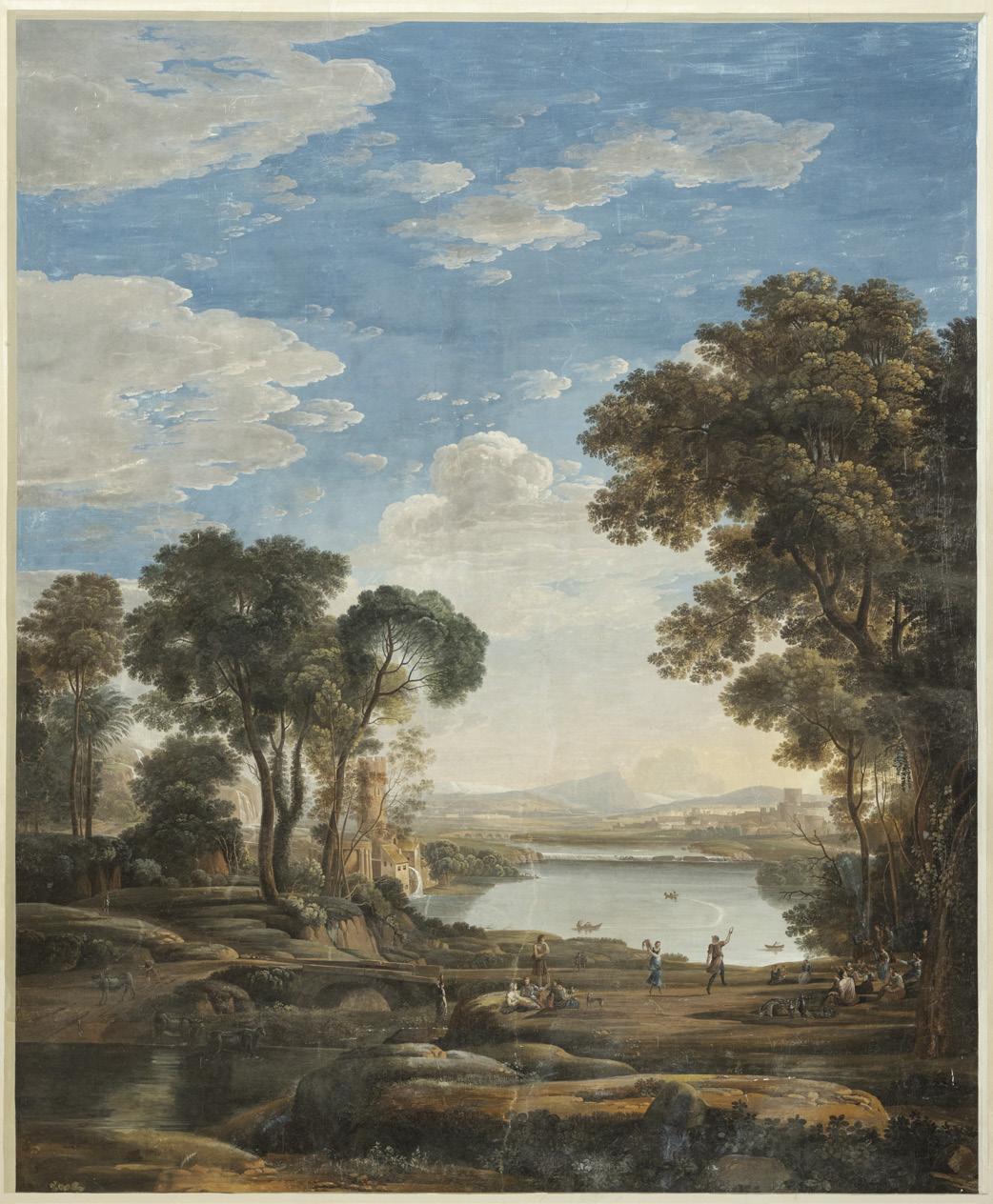
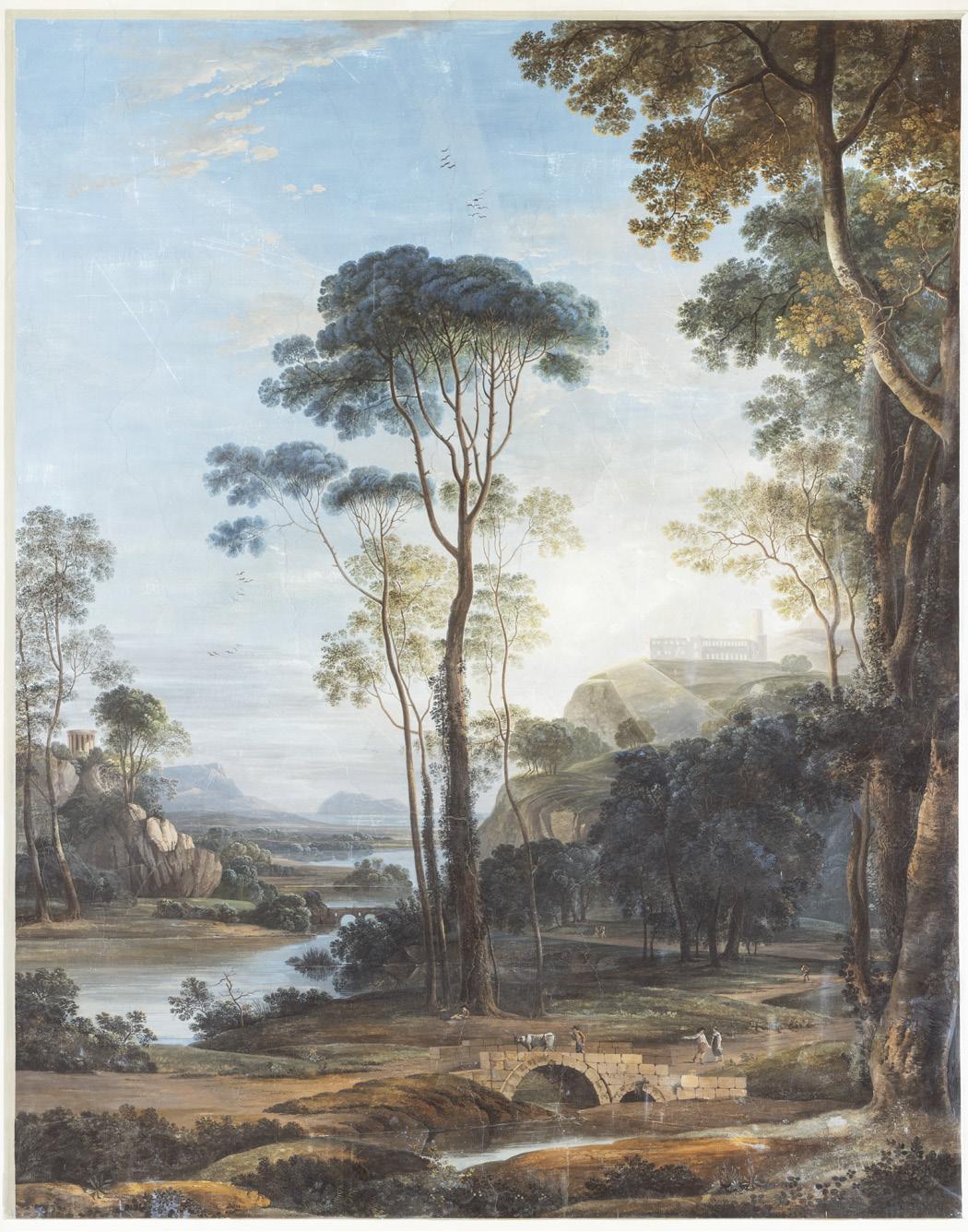
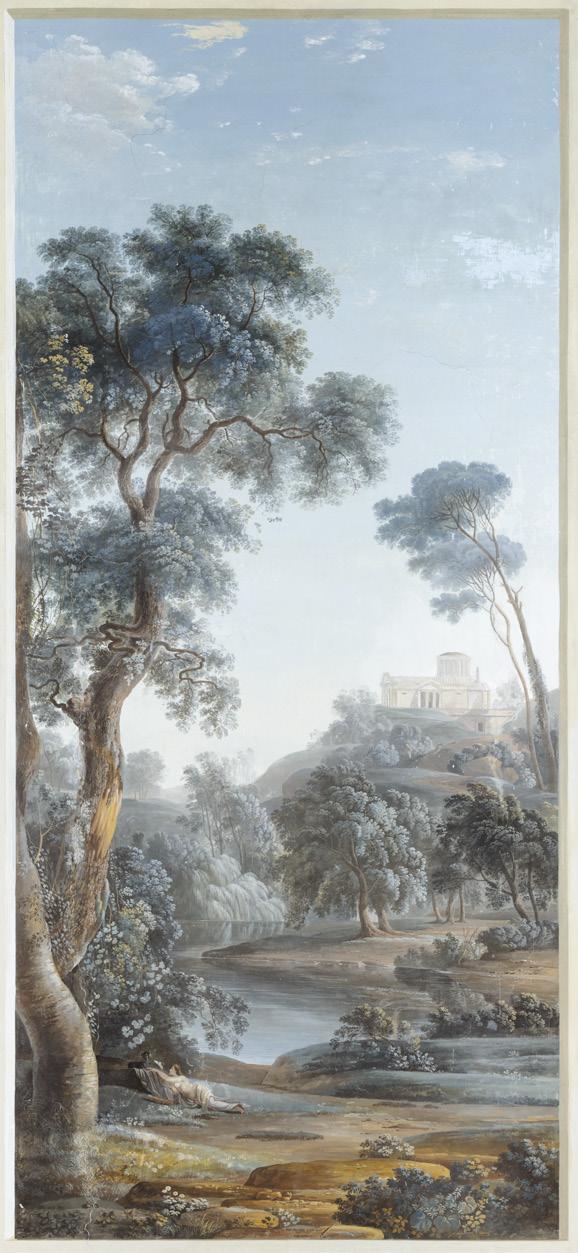


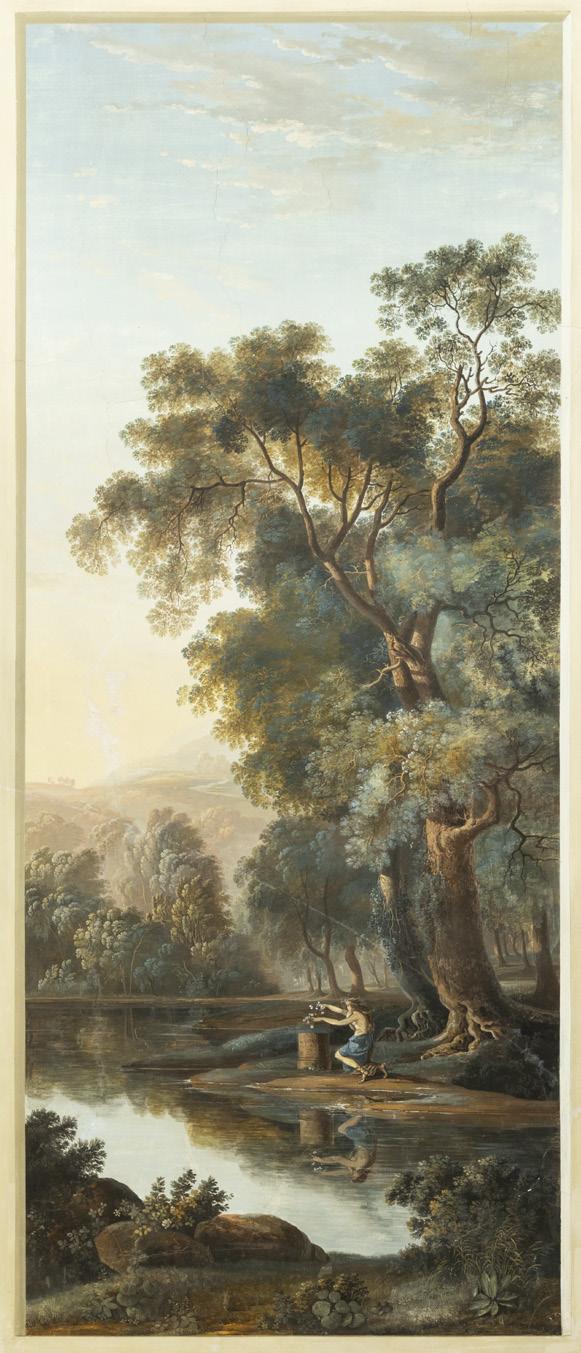
ROBERT HUNTER
(C. 1715/20-1801)
Portrait of Lambert-Brabazon as a Mid-shipman (Young Naval Officer)
Oil on canvas, 75 x 60cm
Signed indistinctly lower left and dated 1765
Provenance : Sale, Adam's, 30 May 2007, Lot 173 (as Irish School)
The leading Dublin-based portrait painter of the 1760s and 1770s, Robert Hunter was a prolific exhibitor at the Society of Artists in Dublin, sending a total of ninety works to its shows, all of which were portraits, except his very first exhibit, Susannah and the Elders—a subject which reminds us that, in 1755, he had won a premium of fifty pounds ‘as the best performer in history painting’. This fine portrait dates from 1765, the year of the first exhibition of the Society, and may be identifiable with one of the two portraits of gentlemen that he exhibited in this inaugural show. A major figure in the Dublin art world, Hunter was described in one nineteenth-century source as ‘a walking chronicle of everything relative to the Irish artists and arts’. However, little is known of his life. In February 1782, he held the first one-man exhibition of art in Dublin and was elected president of the reformed Society of Artists in Ireland. Anthony Pasquin, writing in 1796, states that he was born in Ulster and "studied principally under Mr. Pope Senior."
Lambert Brabazon was an Irish naval commander. He became a Captain in 1782 and, the following year, was flag-captain to Sir Francis Drake (1729–1789) in the Leeward Islands. At the outbreak of the French Revolutionary Wars in 1793, he took charge of naval recruitment in Dublin. Following the death of Sir Alexander Schomberg (1720–1804), he took over command of the Dorset, the Lord-Lieutenant of Ireland’s yacht, until his own death in 1811. Brabazon counted Horatio Nelson (1758–1805) among his friends, even if their respective naval careers left them little time to meet. Nelson wrote to Brabazon towards the end of March 1805: “I can never forget your great kindness…. I hope some day, not very far distant, that I shall enjoy the pleasure of having you under my roof at Merton.” Another, later, portrait of Brabazon by Hunter is in the National Maritime Museum, Greenwich, in which he is shown wearing captain’s full dress uniform. He was also painted by Nathaniel Hone in a work of 1782 (Adams, Irish Old Master, 5th November 2024, lot 41).
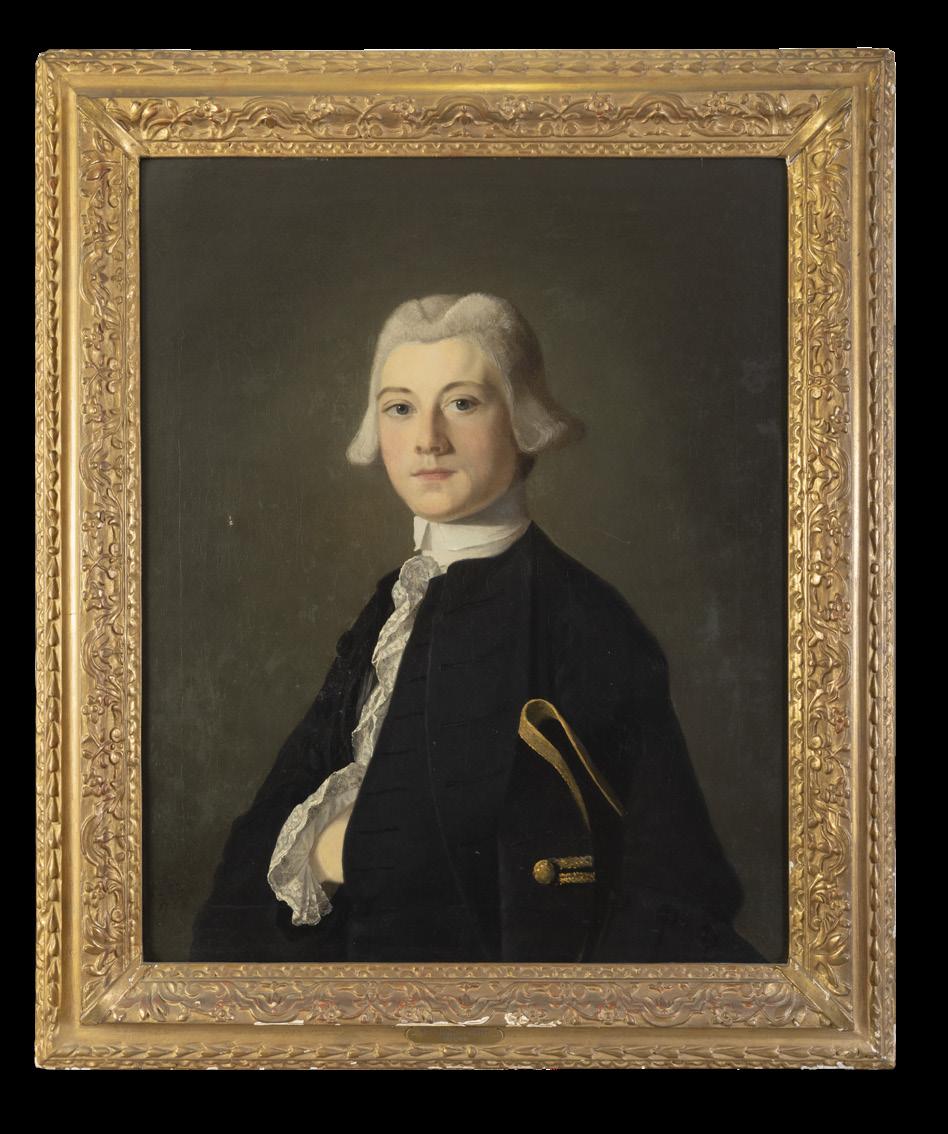
€ 4,000 - 6,000

Full Length Portrait of a gentleman in a blue coat, with tan breeches, his left arm resting on a water trough, view of the Basilica Maxentius beyond, (1787)
Pastel, 93.3 x 66.7cm
Signed, inscribed and dated ‘Hamilton F/Roma 1787 (lower right on the water trough)
Provenance: The Irish Sale, Christie’s, London, 12 May 2005, lot 57
€ 10,000 - 15,000
The appearance of this fine example of Hugh Douglas Hamilton’s work is a rare opportunity to acquire one of the artist’s full-length pastel portraits, which seldom come to market.
While the sitter is unknown, he is evidently a man of some means, procuring a portrait from Hamilton while in Rome, as a fashionable souvenir to bring home from his Grand Tour. Leaning casually on a water trough, with a view of the Basilica Maxentius behind him, Hamilton suggests his subject’s easy confidence in his august surroundings; invoking with a single stance a whole culture of ease and privilege, scholarly discrimination and conviviality.
The portrait is signed and dated 1787. Hamilton had been in Italy for around five years at this point and was at the height of his powers. This pastel was completed not long before he embarked on his large-scale portrait Canova and Tresham – widely considered his chef d’oeuvre – probably completed in early 1788 and now in the V&A collection. By the late 1780s, Hamilton was at some remove from the popular, small-scale pastellist of his early London days. Through his friendship with artists such as Antonio Canova and John Flaxman, he was associating with the Roman avant-garde and was witness to their ongoing attempts to test the limits of their chosen media. This, combined with his relative lack of rivals in the pastel medium in Rome, gave Hamilton both the encouragement and the freedom he needed to try out new ideas and expand his repertoire. He was increasingly interested in pushing the limits of pastel’s possibilities and seemed keen to make it compete in impact with oil painting.
This experimentation is most evident in an expansion of scale in Hamilton’s pastel work during the 1780s. From small head-and-shoulders ovals, Hamilton steadily increased the size of his portraits, until at their largest they measured nearly a metre in height. His sitters were now depicted full-length and the plain blue and brown backgrounds of his early works were replaced by beautifully delineated Roman landscapes and carefully observed natural details.
A new-found grandeur and permanence replaced the more transient and fragile appeal of his youthful work. In particular, Hamilton’s ever-increasing skill in the rendition of textural and colouristic effects reached their zenith in these years. Although some abrasion is evident in this
portrait and the pastel has been subject to a small area of water damage, most of the detailing is intact and exhibits many characteristic Hamilton flourishes. His technical assurance is abundantly evident; in the fine point work on the lace cravat, the mottled shine of the sitter’s coat buttons, and the luminous expanse of the summer sky beyond. The wonderfully observed colour accents - the rich indigo of the sitter’s jacket and the vibrant mustard yellow of his gloves - also give this work an undeniable vigour. No detail appears beneath notice, from the delicate delineation of the scrubby undergrowth at the sitter’s feet to the flashes of bright blue used to suggest sunlight through tree branches. Hamilton’s typical combination of blended and unblended pastels gives the work a remarkable three-dimensional effect.
In its conception, this portrait is strikingly similar to Hamilton’s portrait of Frederick North, later fifth Earl of Guilford, executed in 1790, now in the collection of the National Gallery of Art in Washington DC. Both are dressed in near identical attire and share the Basilica Maxentius backdrop. This repetition of setting was not unusual for Hamilton. He often worked from his own stock of sketches and studies, or took inspiration from those by other artists; adapting elements, with subtle variations, for each new commission. The inclusion of Piranesi’s The Amphitheatre of Verona, Pianta di Roma and Views of Rome in Hamilton’s posthumous sale of effects may indicate a source of background material for the portraits of North and the man in a blue coat; Piranesi etched the Basilica Maxentius many times.
While this artistic duplication can be read as the pictorial strategy of a sharp businessman, eager to turn out as many portraits as possible, the habitual deployment of the same recognisable settings also signified as an act of cultural requisition on the sitters’ part. Treating Italian cityscapes rather like painted theatrical scenery into which any figure could be inserted, Hamilton’s fulllength pastels of English and Irish travellers transposed Northern European mores over an Italian backdrop. The Anglocentric mania for portraiture had not infiltrated Italian society to any significant extent and artists such as Hamilton (and his predecessors Mengs and Batoni) catered exclusively for tourists. Thus, the familiar landscapes of the Roman Forum, and the sheen of cosmopolitan sophistication and learning they offered, were ripe for visual appropriation, signalling the sitter’s unrivalled appreciation of their magnificence.
This portrait has been in the same private collection for several years. Its sale offers the prospect of acquiring a large-scale work by an artist in full command of his medium; a celebration of both Hamilton’s pastel prowess and the beauty of eighteenth-century Rome.
Ruth Kenny
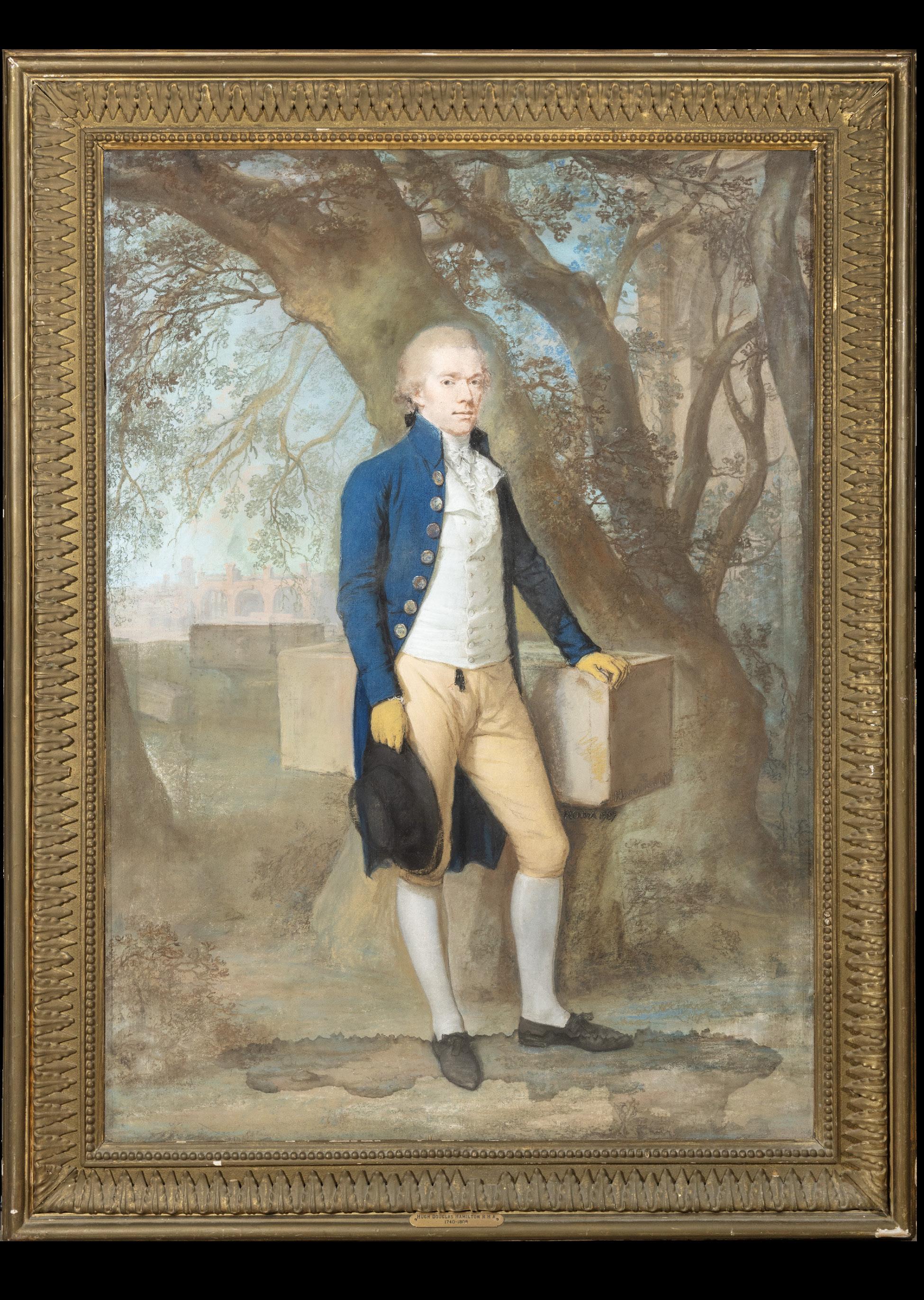
Portrait of William Ormsby, M.P. of Willowbrook, Co Sligo (1718-1781); Portrait of Hannah Ormsby, née Wynne of Hazelwood, Co. Sligo ( - 1798); Portrait of Maria Susannah Ormsby (1745-1827); and Portrait of Jane Ormsby (1750-1802)
Pastel on paper, oval, each 23.5 x 19.5cm, in original giltwood frames (4)
Provenance: Collection of Lord Harlech (Ormsby-Gore), Glyn Cywarch, North Wales; Sale, Bonhams, London, 29 March 2017, lots 154, 411 and 412 (as Anna Tonelli); With Rafael Valls, London, 2018; With Gorry Gallery, where acquired October 2020
Exhibited: Cardiff, National Museum of Wales, Portraits from Welsh Houses, 1948, cat. no. 84.
Literature: Portraits from Welsh Houses, exh. cat., Wales, 1948, p. 32,cat no. 84 (only Portrait of William Ormsby); J. Steegman, A Survey of Portraits in Welsh Houses, Cardiff, 1957, vol. 1, p. 76, no. 66 and 67 (Under Portraits formley at Brogyntyn); N. Jeffares, Dictionary of Pastellists before 1800, London, 2006, p. 519; N. Jeffares, Dictionary of Pastellists before 1800, online, no. J.722.143, J.722.145 and J.722.146
€ 15,000 - 20,000
This fine collection of four pastels, depicting members of the Ormsby family, was attributed several years ago to Hugh Douglas Hamilton. The sitters - William and Hannah Ormsby and their two daughters Maria and Jane - commissioned portraits in both oil and pastel from Hamilton, and their characterful likenesses are assured examples of his distinctive style. The Ormsbys were a well-established west of Ireland Ascendancy family. William Ormsby MP lived with his wife and daughters at Willowbrook, Co. Sligo. Despite William’s pre-eminence, his pastel portrait by Hamilton is strikingly natural and well-observed; from his softly flushed cheeks to the strands of white hair escaping from his wig. His wife, Hannah (née Wynne), was originally of Hazelwood, Co Sligo, the Palladian villa designed by Richard Castle. Her portrait is a fine example of one of Hamilton’s most notable stylistic touches; the way in which he allows his graphite under-drawing to show through the pastel in places. This technique is particularly evident in the wonderfully free rendition of Hannah’s bonnet. The couple’s eldest daughter Maria was herself a keen amateur artist; her oil portrait by Hamilton depicts her holding a sketch book. She must have taken a keen interest in Hamilton’s process, and her pastel portrait is perhaps the finest of the group. The texture of her loose curls is beautifully described and her direct gaze makes for a most striking image. The likeness of her younger sister Jane is also admirably rendered; rich brown eyes lending her portrait a captivating warmth.
The dating of this family group is an interesting puzzle. William Ormsby died in 1781, yet the simple white gowns and hairbands worn by his daughters suggest that they sat to Hamilton in the 1790s. Hamilton’s oil painting of Maria, wearing similar attire, is indeed signed and dated 1796. This suggests, rather poign -
antly, that William’s pastel likeness was either created posthumously, or that his portrait was completed earlier and the family requested similar portraits to accompany it, after his demise. In either scenario, the grouping speaks to the powerful intimacy of pastel portraits and their ability to convey a more informal visualisation of family life. Such images were not intended to replace traditional family portraits in oil but to hang in harmony with them, fulfilling quite a different, complementary role. They functioned as personal documents, strengthening familial bonds in affectionate rather than genealogical ways. The idea of a portrait series of visually uniform, similarly sized and framed works, small enough to hang in close proximity to each other on a single wall, had obvious appeal in enshrining the identity of a group that had, in reality, been separated by death.
Previously given to the artist Anna Tonelli (c.1763- 1846), a Florentine portraitist and pupil of Hamilton’s, the reattribution of the Ormsby group of pastels to Hamilton himself was based on a close analysis of technique. While Tonelli may have completed some of her training under Hamilton’s tutelage, her style is very different. Hamilton uses a more graphic approach –mixing graphite and pastel and often leaving strokes unblended. Tonelli’s application, on the other hand, is far smoother. Though very competent, Tonelli lacks Hamilton’s confidence and bravura in the pastel medium, so evident in the accomplished modelling of this group.
The Ormsby portraits’ distinctive eighteenth-century gilt frames are typical of those used by Hamilton for a period of his career. They are of the type manufactured by George and William Hulbert, carvers and gilders who operated out of premises on Camden Street in Dublin. The glass in at least one of the frames (the portrait of William) is also original, recognisable from a characteristic small bubble apparent to one side; the result of traditional glass-making techniques.
Ruth Kenny
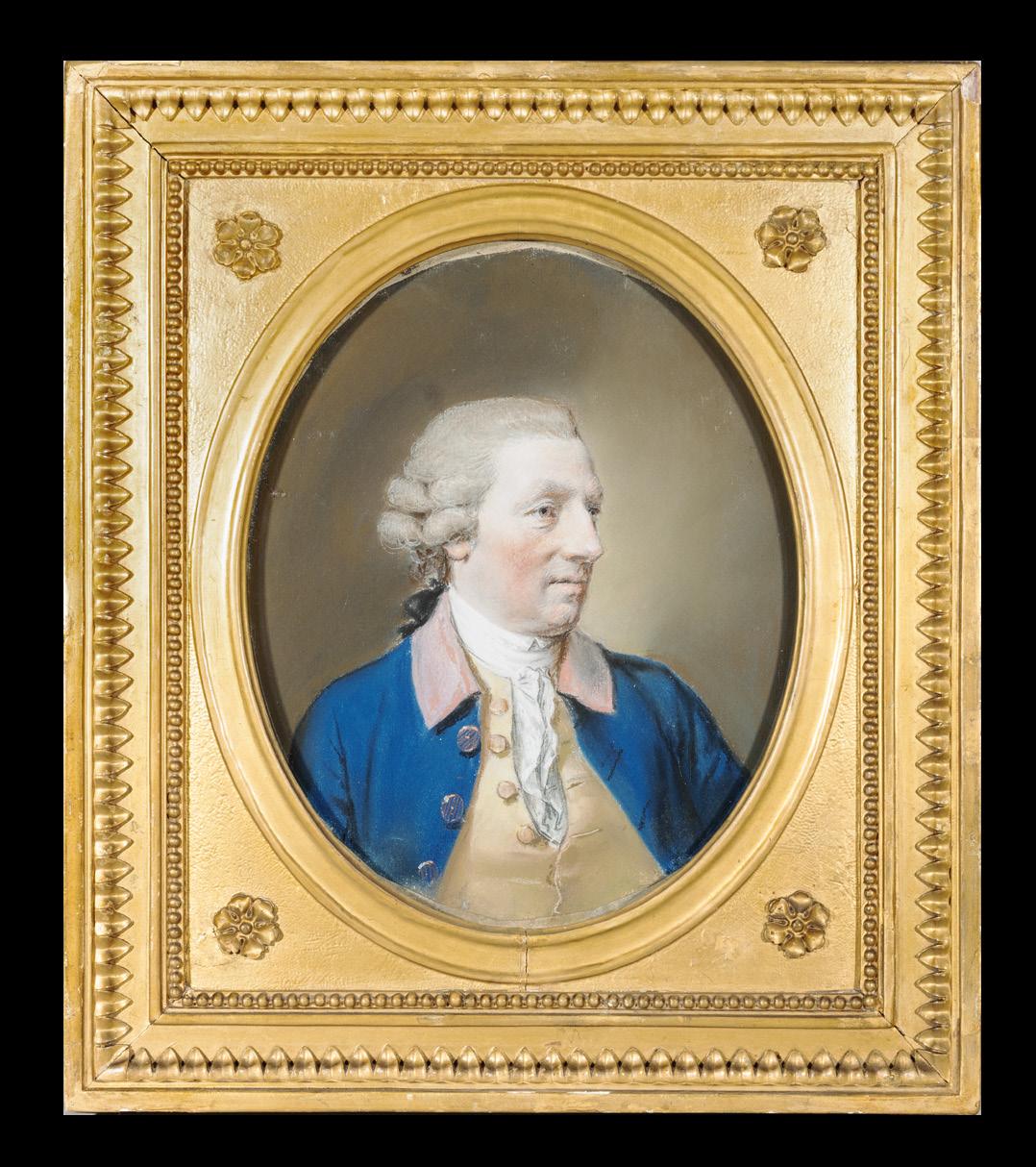
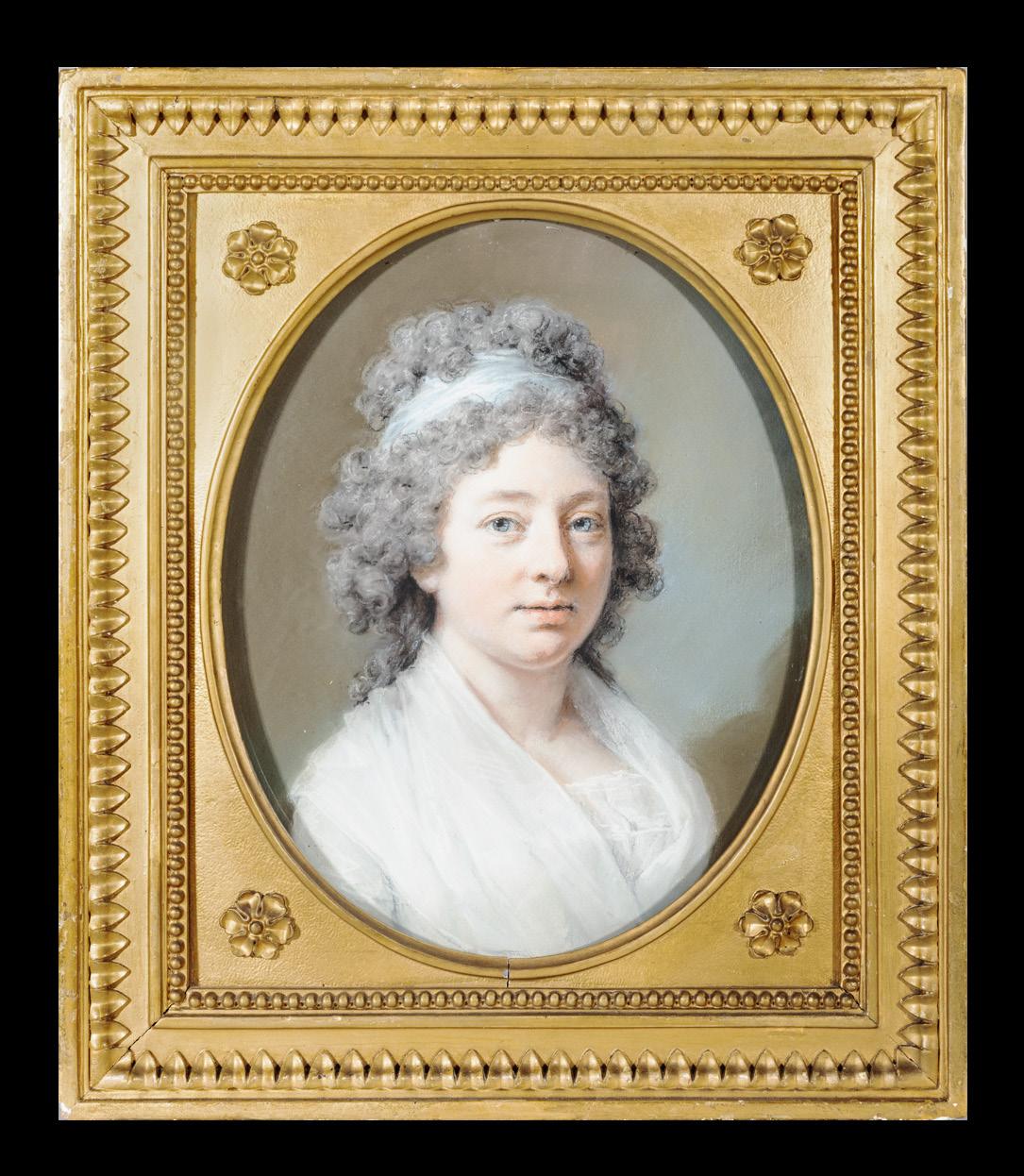

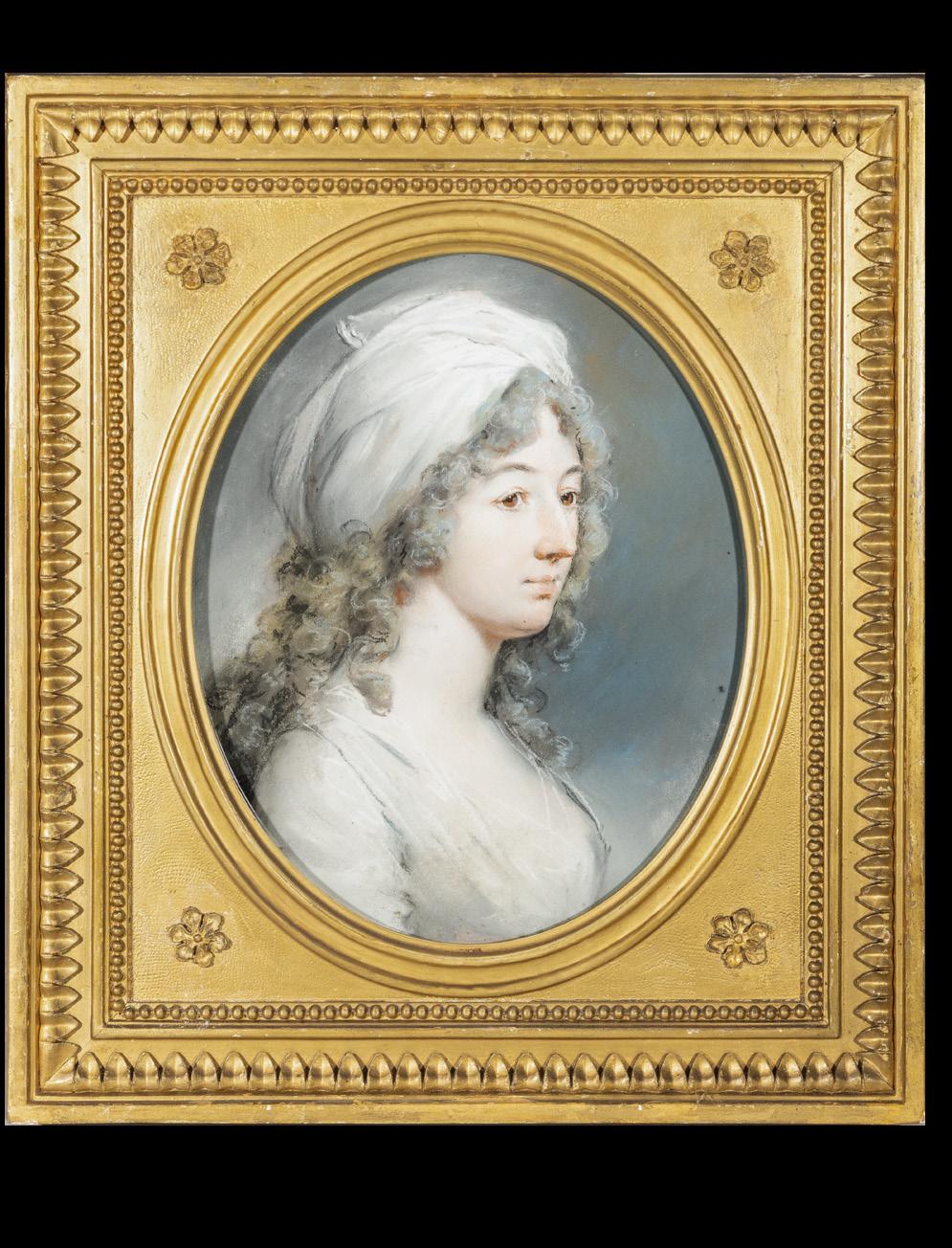
Portrait of Christopher Norton (c. 1740-1799)
Small Half-Length, in a Brown Coat and Blue Waistcoat Oil on canvas, 26.5 x 22.5cm
€ 6,000 - 8,000
Although, Hugh Douglas Hamilton’s Italian sojourn, and particularly his friendship with Antonio Canova (17571822), has been well documented, this choice example of his oil portraiture – rare in its medium and scale for this period of his career – has escaped notice. A pastel by Hamilton of the same subject, the artist and art dealer, Christopher Norton, closely related but seemingly the product of a different sitting, is also recorded (Christie’s 7 Dec 2016, lot 177, GB£11,250). It should not be surprising that Hamilton portrayed Norton on more than one occasion, and this format of a small oil is likely to reflect the painting’s origins as a ‘friendship portrait’, a gift between friends, rather than a commissioned portrait. Both artists were active in antiquarian expatriate circles in the Eternal City and were closely linked by links of friendship, business and shared artistic endeavour in the crucible in which the international neoclassical style was being forged. No doubt, too, the fact that they were almost exact contemporaries helped build the relationship to which this very sympathetic portrait attests.
After training in the St Martin’s Lane Academy, Norton started his career as an apprentice to the landscape engraver Pierre-Charles Canot (c.1710-77), winning a premium from the London Society of Arts in 1760 and in the same year he travelled to Italy, where he would spend almost his entire career. Two years later he was documented as living in Rome with James Byres (1733-1817), the Scottish architect and dealer in old master painting and classical sculpture, who was also an associate of – and, indeed, was also painted by – Hugh Douglas Hamilton. In time, Norton and Byres went into partnership, exporting ancient and more recent works of art from the city
to clients back home, often to very lucrative effect. Eventually, through his marriage to Janet Moir, he became Byres’s nephew. Norton also developed a close relationship with the Welsh landscape painter Thomas Jones (1742-1803), corresponding with him ‘concerning the dispersal of his own pictures in Italy’ (John Ingamells, Dictionary of British and Irish Travellers in Italy, 1701-1800, p. 716). Norton’s diary covering the period 1763-94 survives and includes references to Jones, Hamilton and Thomas Jenkins (1722-98), the painter, dealer and antiquary (Christie’s, 8 Jun 2000, lot 12). When James Martin (1738-1810) visited his Rome studio he saw ‘sev[era]l. copies by him of pictures belonging to Mr Jenkins & some of his own engraving’. In 1766 Norton produced prints for Byres’s Etruria, and he etched several plates for the Views of Italy by Peter Stephens published in 1767, a project on which the Irish artist James Forrester (1730-76) also worked.
The pastel portrait by Hamilton sold at Christie’s in 2016 was recorded in Norton’s house in Rome in 1783 which, taken with the evidence of his age as about forty, suggests a likely date for this oil. An earlier portrait of Norton by Nathaniel Dance (1735-1811) shows him as a younger man holding a palette and brush (Aberdeen Art Gallery). After so many years living in Italy he naturally identified with the country and, while Hamilton went back to Ireland for his last productive period, Norton returned to Rome, writing in 1797, ‘I cannot help feeling very much for a country where I have spent so many happy years and which looked upon in some measure as my own.’
Ruth Kenny

Landscape with a Rainbow Oil on canvas, 31.5 x 43.5cm
€ 8,000 - 12,000
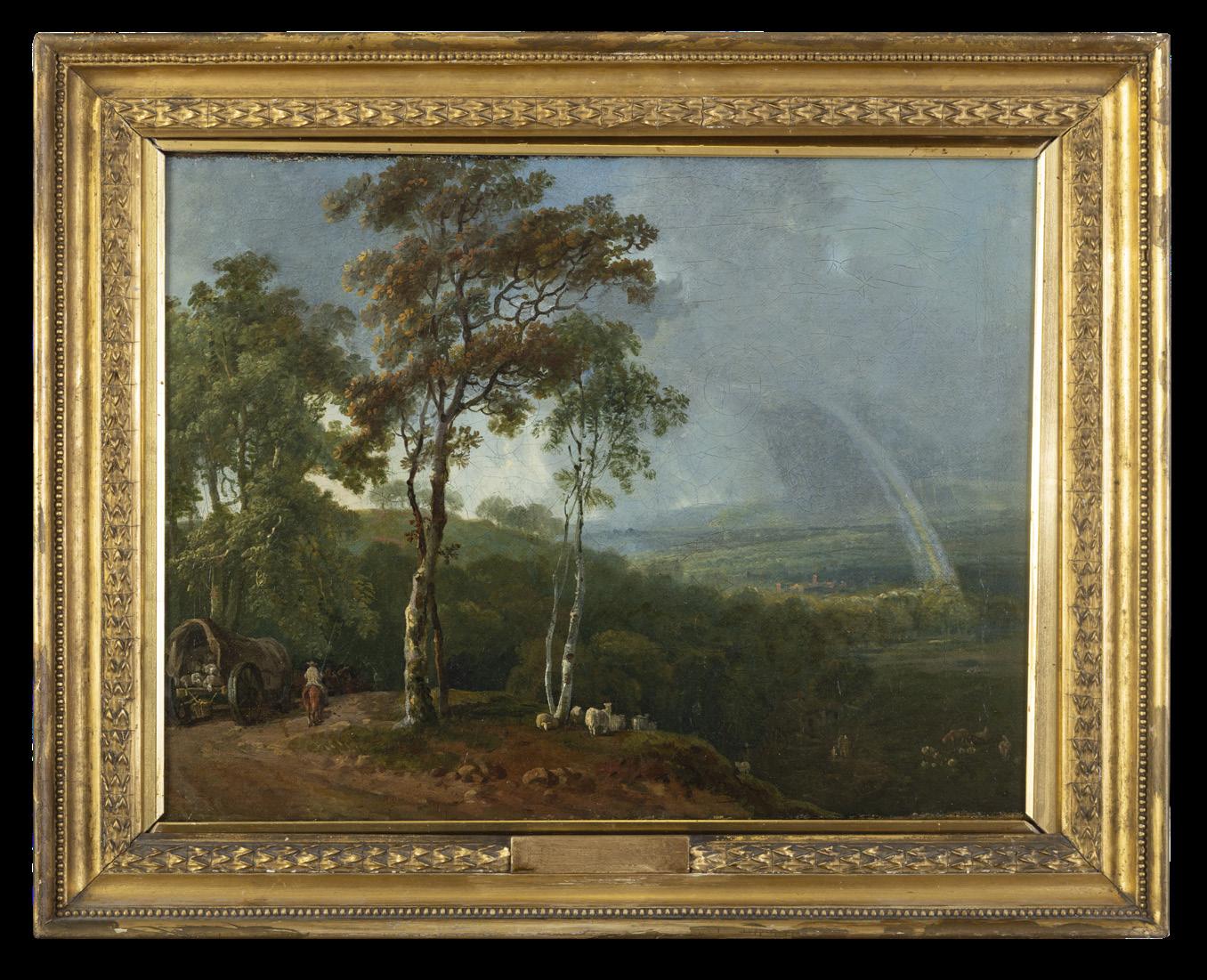
In this small but busy landscape a somewhat tentative rainbow falls through a sky of broken rain clouds and sunny patches. In the foreground a vignette of figures around a cottage can just be discerned with sheep on the surprisingly steep eminence which overlooks it. A shaft of light illuminates areas of the expansive plain leading the eye far into the distance. A wagon accompanied by a man on horseback progresses along the road. A delightful pentimento, painted out when the artist changed his mind, shows a huntsman raising his gun to fire at a bird.
Rainbows, characterised as ‘accidents of nature’, were associated by eighteenth-century theorists with the Northern School. Jonathan Richardson (1667-1745) inked the specifically with Peter Paul Rubens (1577-1640) whom he noted ‘loves to enrich his landscape with certain accidents of nature, as winds, a rain-bow, lightning, &c’. No doubt Richardson was thinking of works such as the famous landscape with a rainbow now in the Wallace Collection, London. For Joshua Reynolds (1723-1792), an interest in such
atmospheric effects would categorise an artist as Dutch-inspired and so incapable of attaining the absolute truths which Reynolds saw as the preserve of the Roman School of landscape. ‘It is certain Claude Lorrain seldom, if ever, availed himself of those accidents’. It is probable, that theoretical distinctions and rigid definitions of the Dutch and Italian Schools were less important to Barret than to the learned Reynolds in London and it seems that he found inspiration for the depiction of the rainbow itself in the Irish countryside, and not in the art of the past. Rainbows had long been associated with the mutability of the Irish climate. This was noted by Richard Twiss in 1775, very close in time to this canvas by Barret: ‘The climate of Ireland is more moist than that of any other part of Europe, it generally rains four or five days in the week, for a few hours at a time; thus rainbows are seen almost daily’.
Other Irish artists, also included a rainbow in their paintings. Thomas Roberts (1748-77) Landscape with a Rainbow (Fota House, County Cork) is among his appealing paintings while in
1769 Roberts’s teacher George Mullins (fl.1756-c.1798) exhibited a landscape with ‘the effect of a rainbow’. Two further examples of a rainbow landscape by Barret are known and Edmund Burke (1729-97) wrote to James Barry (1741-1806) about how their mutual friend was ‘a wonderful observer of the accidents of nature’. While other examples of British portrayals of the rainbows can be instanced – from Julius Caesar Ibbetson’s (1759-1817) Beeston Castle (Nottingham Castle) to, most famously, John Constable’s (1776-1837) Salisbury Cathedral (Tate), these tend to show a magnificent arch, an almost architectural feature in the sky. Here instead, Barret gives but a hint of the rainbow, its fleeting impermanence being as much the subject as the beauty of its prismatic colouring.
We are grateful to Dr Logan Morse, who has recently completed a PhD on George Barret, for kindly confirming the attribution.


35
HUGH DOUGLAS HAMILTON, RHA (1740-1808)
Portrait of a Young Officer
Pastel on paper, oval, 25.4 x 20.3cm
Inscribed verso
Provenance: Sale, Whyte's, 23 September 2019, Lot 111
€ 1,000 - 1,500
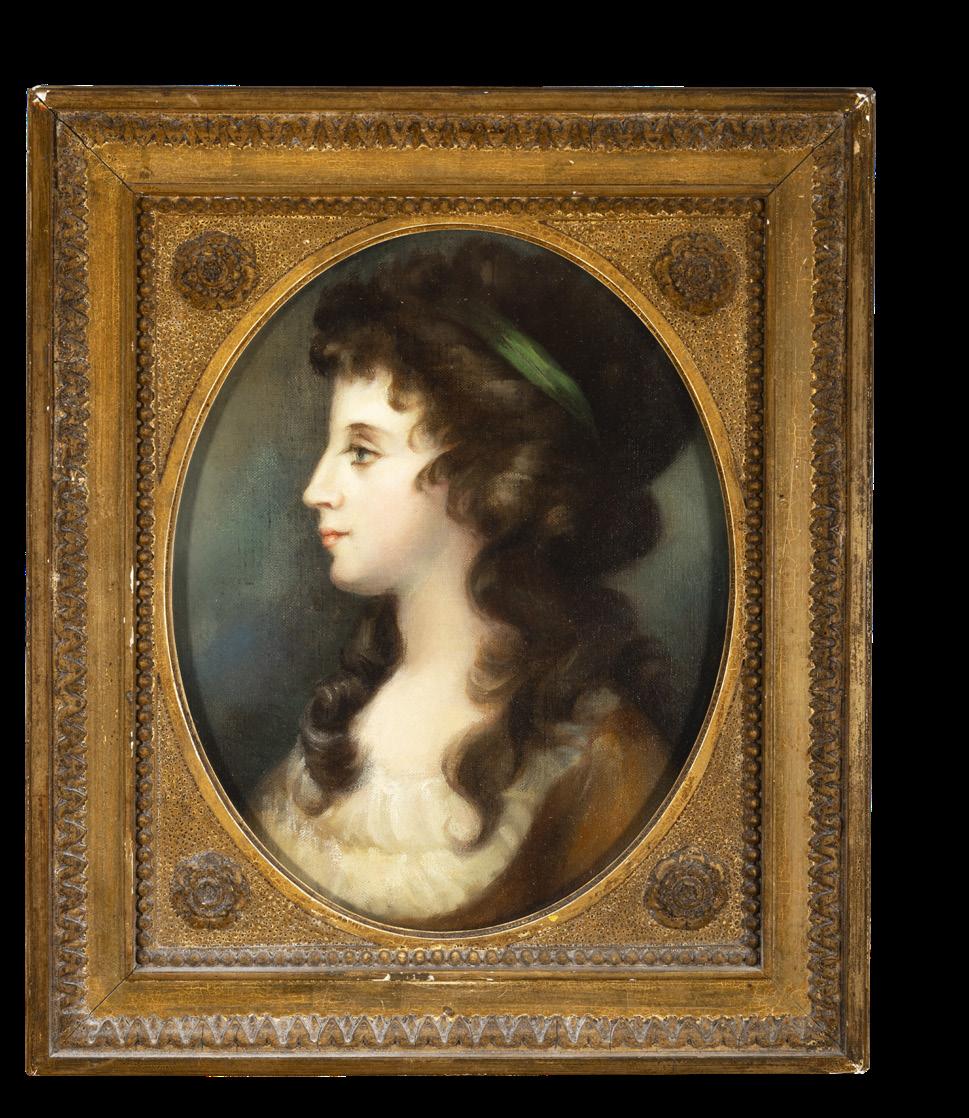

36
HUGH DOUGLAS HAMILTON, RHA (1740-1808)
Portrait of Hyacinthe, Marchioness Wellesley, half-length, in a black dress and muslin scarf
Pastel, oval, 24 x 19cm
Provenance: Sale, Christie’s, London, 12 May 2006, lot 17
€ 2,000 - 3,000
37 FOLLOWER OF DANIEL GARDNER
Portrait of a Young Woman, in Profile
Oil on canvas, oval, 24.5 x 19.3cm
Provenance: With Doig, Wilson & Wheatley, Edinburgh (according to label verso); Captain HCP Hamilton, Moyne, Durrow, Co. Laois; Sale, Adam's, 12 November 2017, lot 465
€ 500 - 800

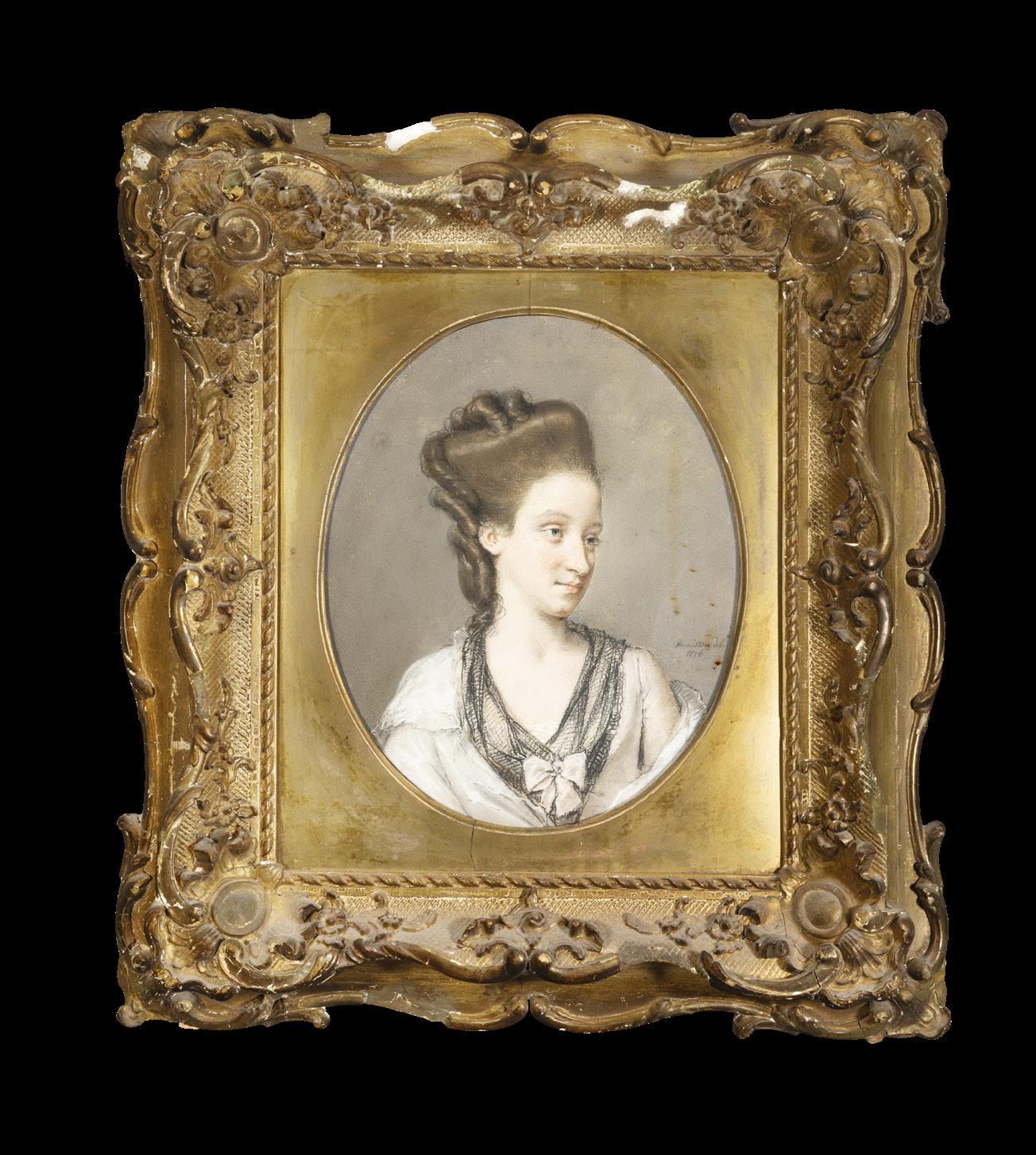
(1740-1808)
Portrait of Mr Playford, bust-length, in a brown coat and white stock; Portrait of Mrs Playford, bust-length, in a white dress and black fichu Pastel on paper, Oval , 23.5 x 19cm (2) Signed and dated 1776
Provenance: Sale, Christie's, London, 19 May 2000, lot 109; With The Oriel Gallery, where acquired April 2003
€ 4,000 - 6,000
WILLIAM HEALY (FL. 1769 - 1778) AFTER ROBERT HEALY (1743 - 1771)
Portrait of Mrs Charles Gardiner, née Florinda Norman (1722-1812) standing by an urn
1770s, after an original 1769 Grisaille pastel on paper, 61.5 x 44.5 cm In a giltwood ribbon frame
€ 8,000 - 12,000
This delicate portrait of Mrs Charles Gardiner in a wooded landscape is an excellent example of the work of the pastellist William Healy, after a drawing by his older brother Robert. William and Robert were born in Dublin, sons of a designer of garden buildings, based on Essex Quay. At an early age they both entered the Dublin Society Drawing Schools, where Robert began to develop his characteristic portraits in black and white chalk; imitating the tonal effects of mezzotint prints, which were then highly fashionable. These early drawings developed into the small full-length grisaille portraits for which he became celebrated. His series of nine outdoor scenes at Castletown are perhaps his best-known works of this type. He won numerous medals during his time at the Schools, exhibited annually with the Society of Artists of Ireland between 1766 and 1770 and was described by a contemporary publication as a ‘gentleman of an excellent taste and original genius’. His promising career was cut short in July 1771, when he died at the age of 28 from a cold caught while sketching cattle at Dangan, Co. Meath, for the first Earl of Mornington.
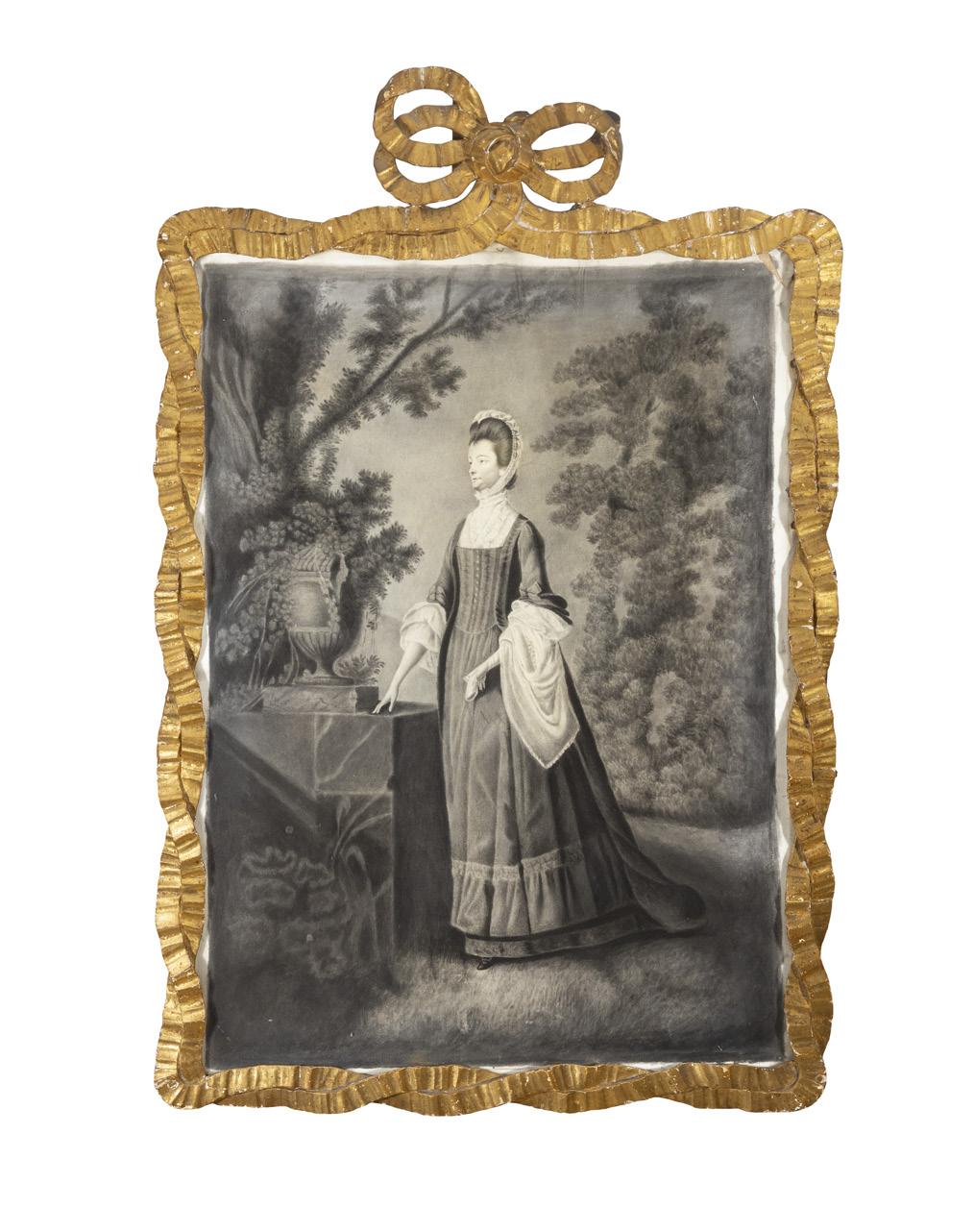
Following Robert’s death, William took over his studio and began to produce copies of his work, such as this, and further works in grisaille pastel, which are largely indistinguishable from his brother’s. In 1774 he held an exhibition of these drawings, which appears to have been successful in gaining him many of Robert’s former clients.
This portrait depicts Florinda Gardiner, originally from Lagore, Co. Meath, wife of The Right Hon Charles Gardiner,
M.P. Together they had three sons and two daughters, among them Luke Gardiner, who famously developed the northside of Dublin city, laying out Mountjoy Square and Henrietta Street, and Anne, who went on to become Lady Clancarty. Florinda died in 1812, at the advance age of 90. She is shown here as a widow in her 40s; the inclusion of the urn commemorates her husband, who died shortly before she sat for Robert in 1769. Her portrait is a wonderful example of the distinctive grisaille technique, promoted at the Dublin Society Drawing schools and particularly associated with Dublin artists of this period. The subtle handling of light and texture, particularly in the foliage of the background trees and the gauzy sleeves of Mrs Gardiner’s dress, are typical of the Healy brothers’ refined style. The elaborate entwined ribbon giltwood frame is original to the portrait.
Ruth Kenny

Robert Healy, 1743–1771
Tom
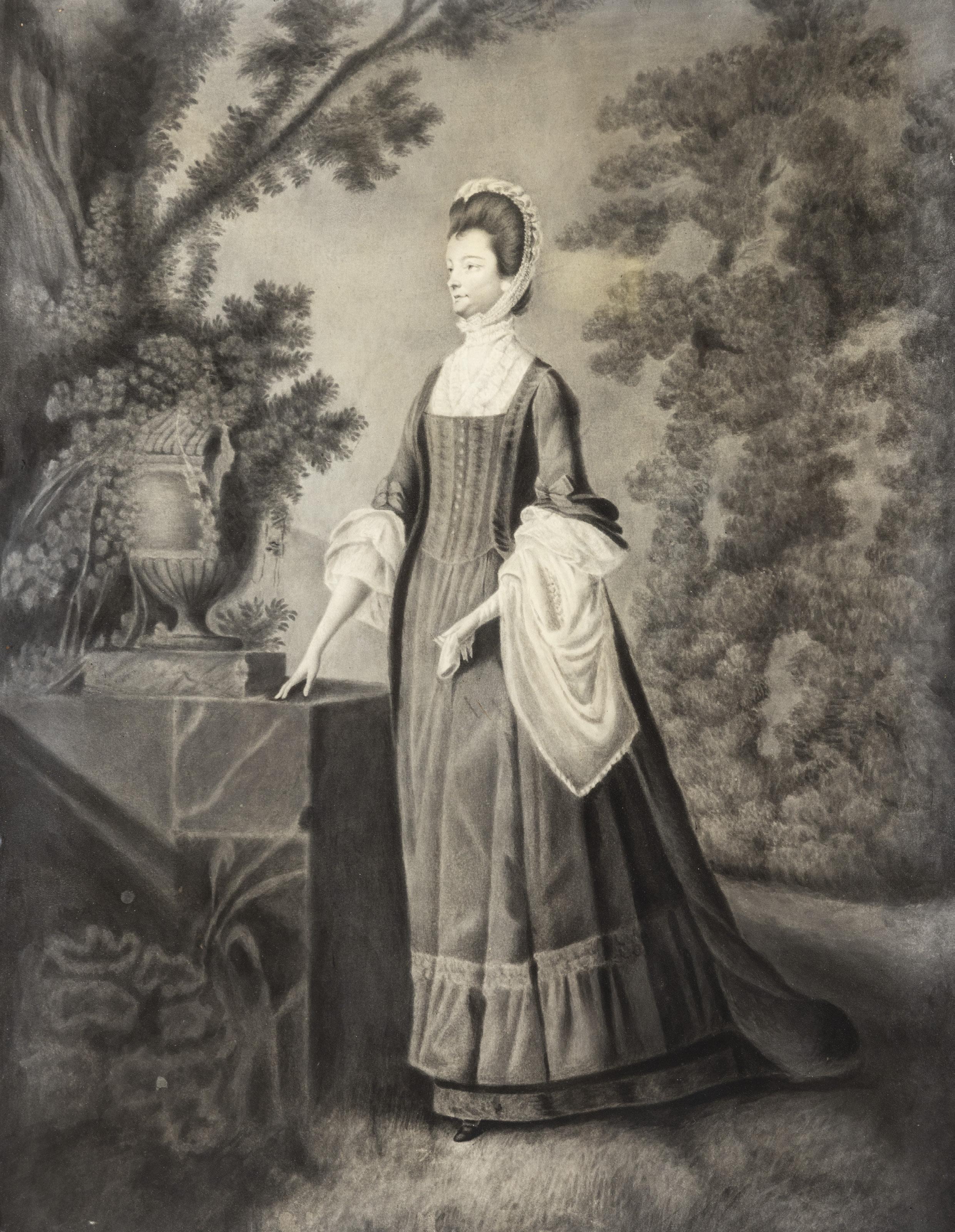
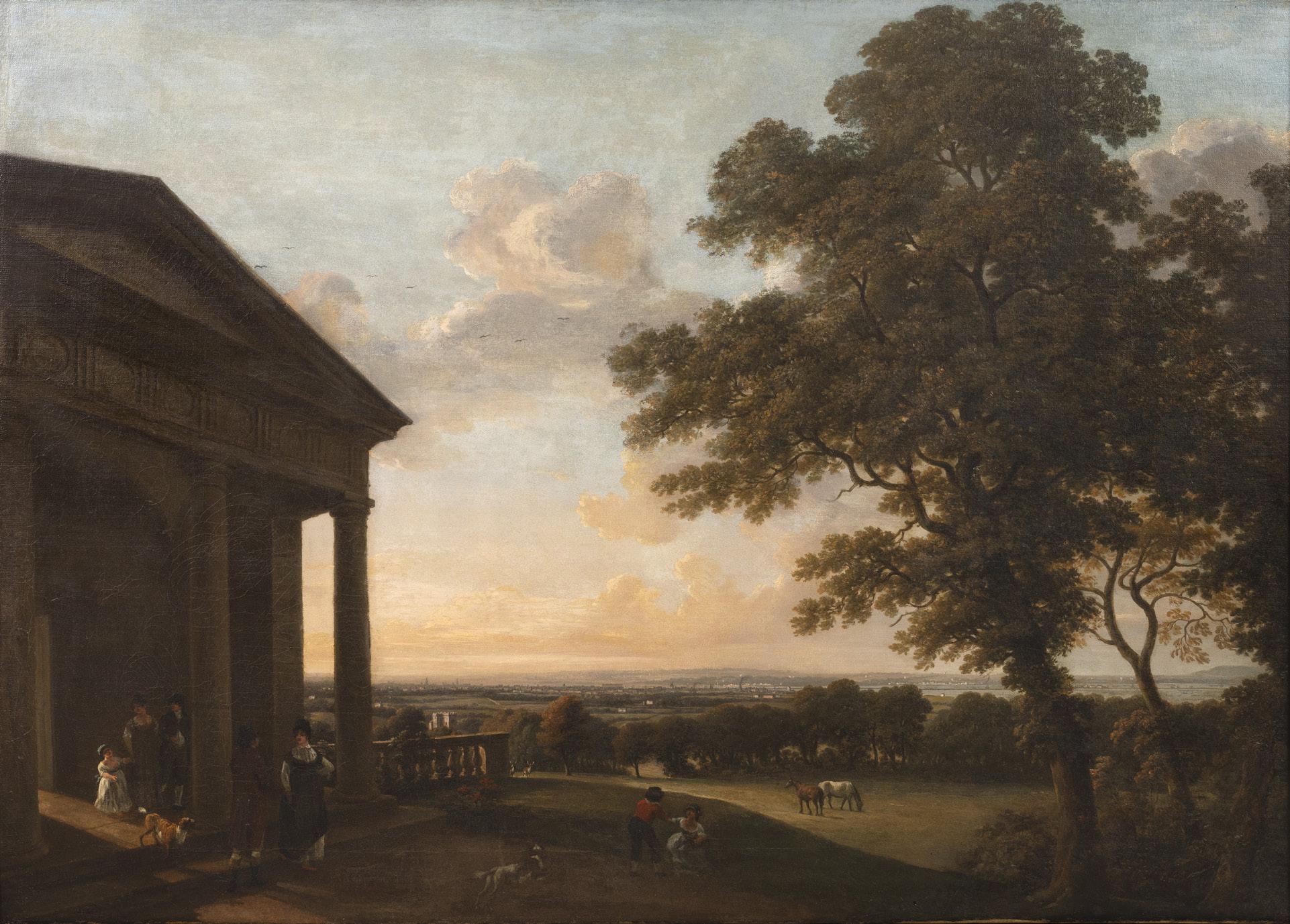
40 WILLIAM ASHFORD (1746 - 1824)
Figures by the Temple in the Park at Mount Merrion, Co. Dublin, with Dublin and Dublin Bay in the background
Oil on canvas, 91.4 x 128
Provenance: Christie’s 17 April 1964 (lot 46); Collection of Desmond Guinness; Christie’s 15 July 1983 (lot 25); Collection of the Hon. Francis D. Murnaghan Jr., thence by descent.
Literature: Edward Malins and the Knight of Glin, Lost Demesnes, Irish Landscape Gardening 1660-1845 (London. 1976) p. 105, fig 116
Anne Crookshank, ‘A Life Devoted to Landscape Painting, William Ashford (c. 1746-1824)’, Irish Arts Review Yearbook (1995) p. 128, no. 45
Finola O’Kane, William Ashford’s Mount Merrion: The Absent Point of View (Tralee, 2012) passim
€ 50,000 - 80,000
Situated on an elevated site to the southeast of the Dublin, Mount Merrion, the suburban retreat of the Viscounts Fitzwilliam, was a comparatively small demesne but it overlooked the 2,700 acre estate of the family which stretched from Merrion Square to Bray. Between 1804 and 1806 Ashford painted for the Fitzwilliams what has been termed his ‘last great commission of estate views’ (O’Kane, op. cit.), a series of oils and an album of twenty-four drawings. Ashford’s patron, the 7th Viscount Fitzwilliam (1745-1816), was described by a contemporary as a ‘great encourager of the Fine Arts [who] was very liberal to those whose merits be appreciated’, among whom was the miniaturist Horace Hone, in whose London house the viscount lodged, and Ashford himself who was on friendly, as much as professional, terms with his patron. At his English home near Windsor, Fitzwilliam assembled ‘a magnificent library of book, prints, and other productions connected with the fine arts’. A somewhat idiosyncratic member of the Irish House of Lords with ‘a more complex life than is initially apparent’ (ibid.), he did not marry but had three children with
the French dancer Mademoiselle Zacharie and, rather more unusually, had, it has been suggested crypto-Catholic leanings. Fitzwilliam was himself an accomplished artist and founder of the museum in Cambridge which bears his name to which he bequeathed six of Ashford’s oil paintings of Mount Merrion in addition to the album of drawings. At least one further example from the series is preserved at Wilton, in Wiltshire, home to the Earls of Pembroke who inherited the Fitzwilliam estate from the 7th Viscount.
Here Ashford paints a summerhouse or teahouse in the form of a classical temple cited to avail of the spectacular views that Mount Merrion afforded. The painting is close in general composition to one of the set in the Fitzwilliam Museum though with numerous differences in the charmingly configured figures and animals which animate the foreground which is further enlivened by the dappled fall of sunlight. The view of Dublin in the distance is captured with great dexterity and it was for this view that Mount Merrion was famed. In November 1761 George Montague wrote to Horace Walpole on the view from this spot, and seems to have been one of the earliest to make what would become a very hackneyed comparison: ‘Nothing near Naples can be more beautiful, with such a view of the sea…as would make your Thames blush for Richmond Hill and Isleworth… such ships, such mountains, such as [the] hill of Hothe [sic] as makes one not wish for any other embellishments’. Ashford was a resident of the area overlooked by Mount Merrion. In, or about, 1782 he had moved from College Green in the city centre to Sandymount (‘a residence more suitable to the habits and taste of a landscape painter’) and commissioned his friend, the great architect James Gandon, to build a villa on a plot leased from Fitzwilliam. Finola O’Kane characterizes the Mount Merrion commission as ‘among the most significant of all the demesne landscape series in the Irish tradition, deftly describing Dublin’s late Georgian landscape at a time when it was veering to the east and moving inexorably towards the sea’.
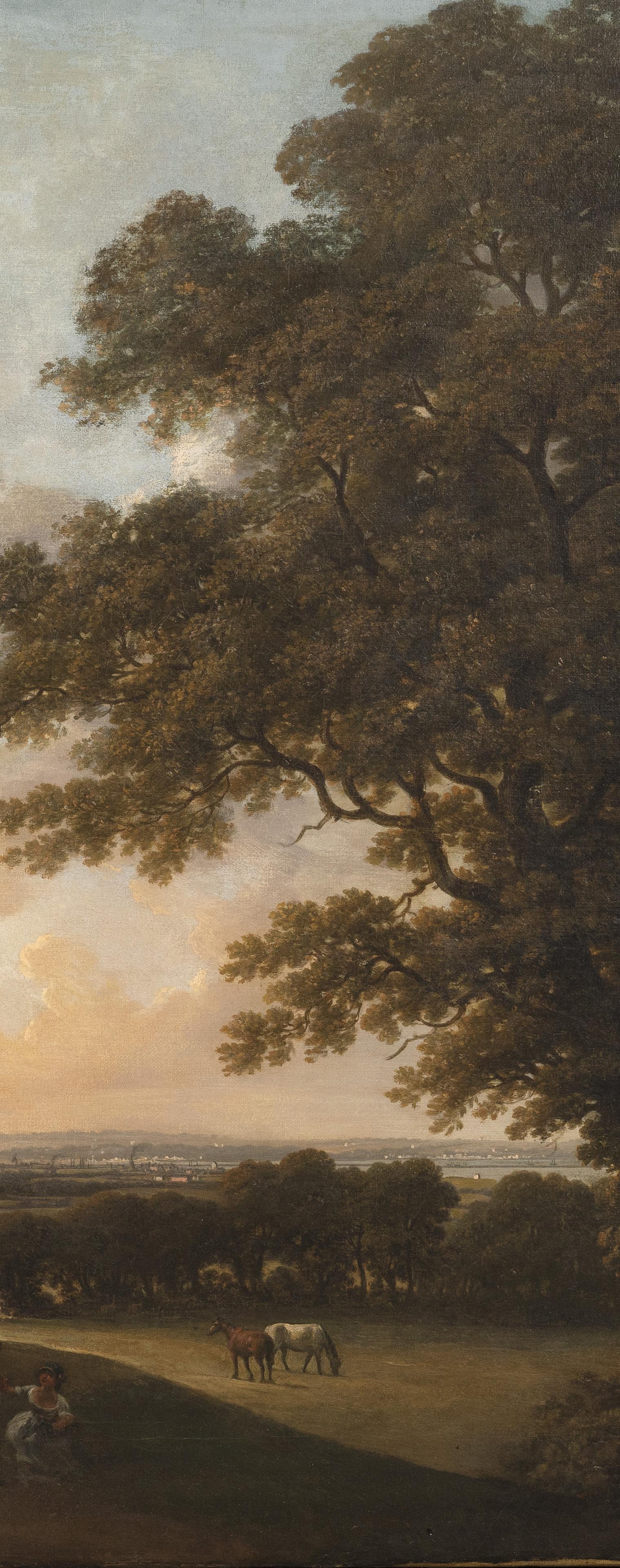

William Ashford was born in Birmingham and christened in St Martin’s parish church on 20 May 1746. At the age of about eighteen, however, he moved to Ireland, taking the position of clerk to the comptroller of the laboratory section of the Ordnance Office in Dublin Castle, which he held until 1788. Apart from occasional visits to England and Wales, it was in Ireland that Ashford spent his lifetime. He became Dublin’s most successful landscape painter of the late eighteenth and early nineteenth centuries, succeeding Thomas Roberts who died prematurely in 1777.
In 1767, aged twenty-one, Ashford submitted his first works to the Society of Artists in Ireland, an organisation of artists who had constructed an octagonal exhibition room for annual displays in William Street, a move which galvanized art production in Ireland. Ashford’s early exhibits were not in the landscape genre for which he is almost exclusively known today. Instead he showed two
still-lifes, both titled A Group of Flowers. A work of this title, dated 1766, survives in the National Gallery of Ireland and is likely to be one of these exhibits. Over the following years Ashford exhibited subjects including dead game, fruit and A Trout from Nature. It was only in 1772 that landscapes, both topographical and demesne, appeared in the exhibitions and hereafter Ashford spent his entire long career painting the Irish landscape in all its manifestations.
On Roberts’s death in Lisbon, where he had sought respite for the consumption which afflicted him, Ashford completed his rival’s great set of views of Carton, County Kildare, with two rather different pictures. Clearly in favour with the ducal Fitzgeralds, he won another important early commission for a pair of views of their ancestral home at Maynooth Castle which he exhibited in William Street in 1780. Ashford also contributed to Thomas Milton’s engraved views of Irish seats including

portrayals of Belan, County Kildare (1783), Bessborough, County Kilkenny (1785) and Ballyfin, County Laois (1787). In the years after 1780 Ashford’s style broadens somewhat and when a group of his works was offered for sale in 1794, his stylistic progression could be assumed as public knowledge with the advertisement referring to ‘two landscapes in his first style’.
Ashford continued to produce exceptional work in the following decades, noticeably the Charleville Forest series of 1801, which illustrates a full understanding of Picturesque theory as it had been codified by William Gilpin (1724-1804) and others in the previous decades.
When the Charleville pictures were exhibited in the former Parliament House on College Green in 1801 an anonymous diarist was full of praise: ‘There is here abundant scope for an exertion of the artist’s genius in the delineation of foliage. The articulation is perfect and the colouring so beautifully rich, and various, that I could with pleasure have spent hours
in viewing them’. In addition to demesne landscapes and topographical views, notable among them a magnificent pair showing Dublin Bay looking north and south (Adam’s, 1 June 2022), Ashford painted a few landscapes with literary narratives, such as Jacques contemplating the wounded stag, a subject taken from Shakespeare’s As You Like It (private collection). One of his most famous works, selected for the cover of Anne Crookshank and the Knight of Glin’s The Painters of Ireland (1978), shows tourists in search of the antiquarian picturesque exploring the ruins of Cloghoughter Castle, County Cavan. Over the course of his long life, Ashford grew rich and painted less, but increasingly became one of the key cultural figures in Dublin in the early decades of the nineteenth. Already in 1801 the anonymous diarist described him as ‘decidedly the first landscape painter’, and it is difficult to cavil at Strickland’s assessment that his ‘pictures justify the reputation he enjoyed as the foremost landscape painter of his time in Ireland’.
A Landstorm with a Ruined Bridge and River in Spate Oil on canvas, 42 x 62cm
Provenance: With The Godolphin Gallery, Dublin; with Solomon Gallery, Dublin; with Grace Pym Gallery, May 1984 where purchased by the Hon. Francis D. Murnaghan Jr., thence by descent.
Exhibited: Possibly Society of Artists in Ireland 1769, no.62;
Dublin, National Gallery of Ireland ‘James Arthur O’Connor’ Nov/Dec 1985, no.7, p.40 (ill.); Belfast, Ulster Museum Feb/Mar 1986; Cork, Crawford Municipal Art Gallery, Mar/Apr 1986; Boston, McMullen Museum of Art ‘ÉIRE/LAND’, 2003, no.21.
Literature: Hutchinson, John, ‘James Arthur O’Connor’ NGI 1985, p.40 (ill); Breeze, George (ed) ‘Society of Artists in Ireland 1765-80, p.47 (ill); Kreilkamp, V. (ed), Exhibition catalogue – ‘ÉIRE/ LAND’, Boston 2003; Laffan, William & Rooney, Brendan, ‘Thomas Roberts – Landscape and Patronage in Eighteenth Century Ireland’, Churchill House Press, 2009, no.7, p.325 (ill).
€ 15,000 - 25,000
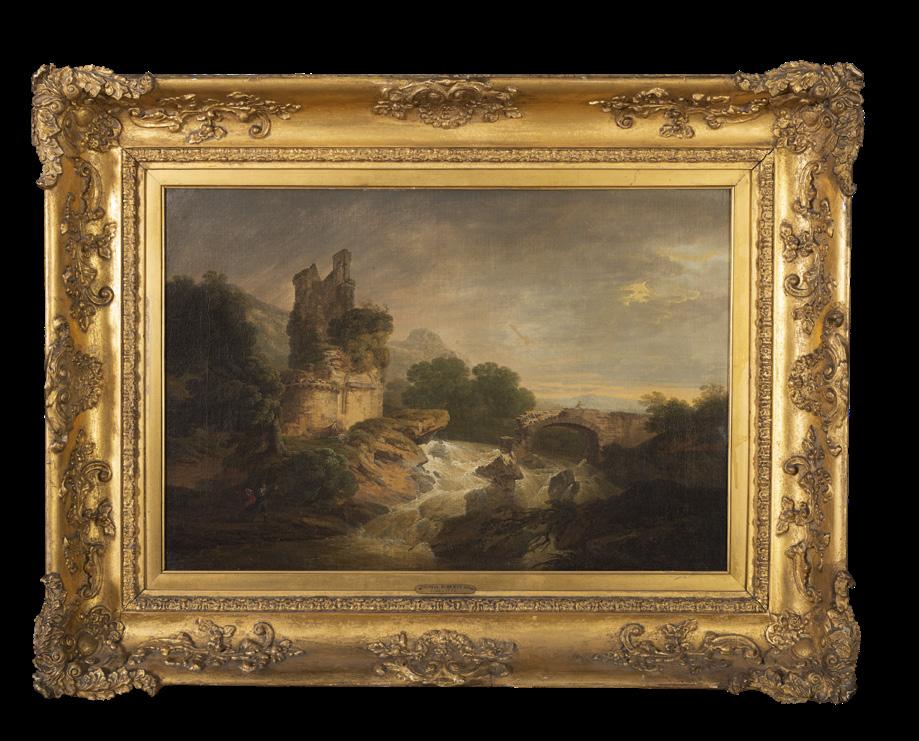
Storm scenes were something of a staple among Roberts’s contemporaries, the sub-genre ultimately owing its popularity to the art of Gaspard Dughet. In the Society of Artists in Dublin, Robert Carver and James Forrester had both exhibited works entitled Landstorm while, in 1769, the Dublin public had the opportunity to compare works in the genre by Roberts and two of his teachers, James Mannin and George Mullins. It has been plausibly suggested (Breeze, op. cit.) that Roberts’s 1769 exhibit, entitled Landstorm with a Waterfall, is identifiable with the present work. A river in spate flows through a bridge, one of the arches of which has been broken by the flood. Beneath a distinctly classical structure, itself ruined and overgrown, two figures in blue and red strike dramatic poses. The landscape is unusual within Roberts’s oeuvre in introducing a tragic note in these travellers who rail against the elements, rather than merely struggle through them. If this dating is correct, the painting coincides with Roberts’s breakthrough 1769 showing at the William Street exhibition room. In this year he moved from his master, Mullins’s, tavern, The Horseshoe and Magpie, in Temple Bar, to his own lodgings off Dame Street. Other exhibits that year included his masterpiece, the Frost Piece, and his View of Rathfarnham Castle.
This is one of a series of storm scenes painted by Roberts, including A Sea Storm (National Gallery of Ireland), probably the picture he exhibited in Dublin in 1771 and something of an imitation of the style of Vernet, who had been patronised by at least three of Roberts’s Irish patrons, the Earls of Leeson and Charlemont, and Richard Dawson, and, in the mid-1770s, a series of variations on the ‘landstorm with travellers’ theme, initiated in one of the upright landscape he painted for Sir Watkin Williams-Wynn’s town house in St James’s Square.
Here in the insignificant powerlessness of man in the face of the hostile forces of natures, Roberts touches, more closely than usual, on theories of the Sublime as articulated by Edmund Burke (1729-97) or David Hartley (1705-57):
‘If there be a precipice, a cataract, a mountain .. in one part of the scene, the nascent ideas of fear and horror may magnify and enliven all the other ideas, and by degrees pass into pleasures, by suggesting the security from pain’. This, more romantic, approach to landscape painting was to be the element in Roberts’s art that his brother Sautelle would take further.
We are grateful to William Laffan and Brendan Rooney for their assistance in cataloguing this lot.
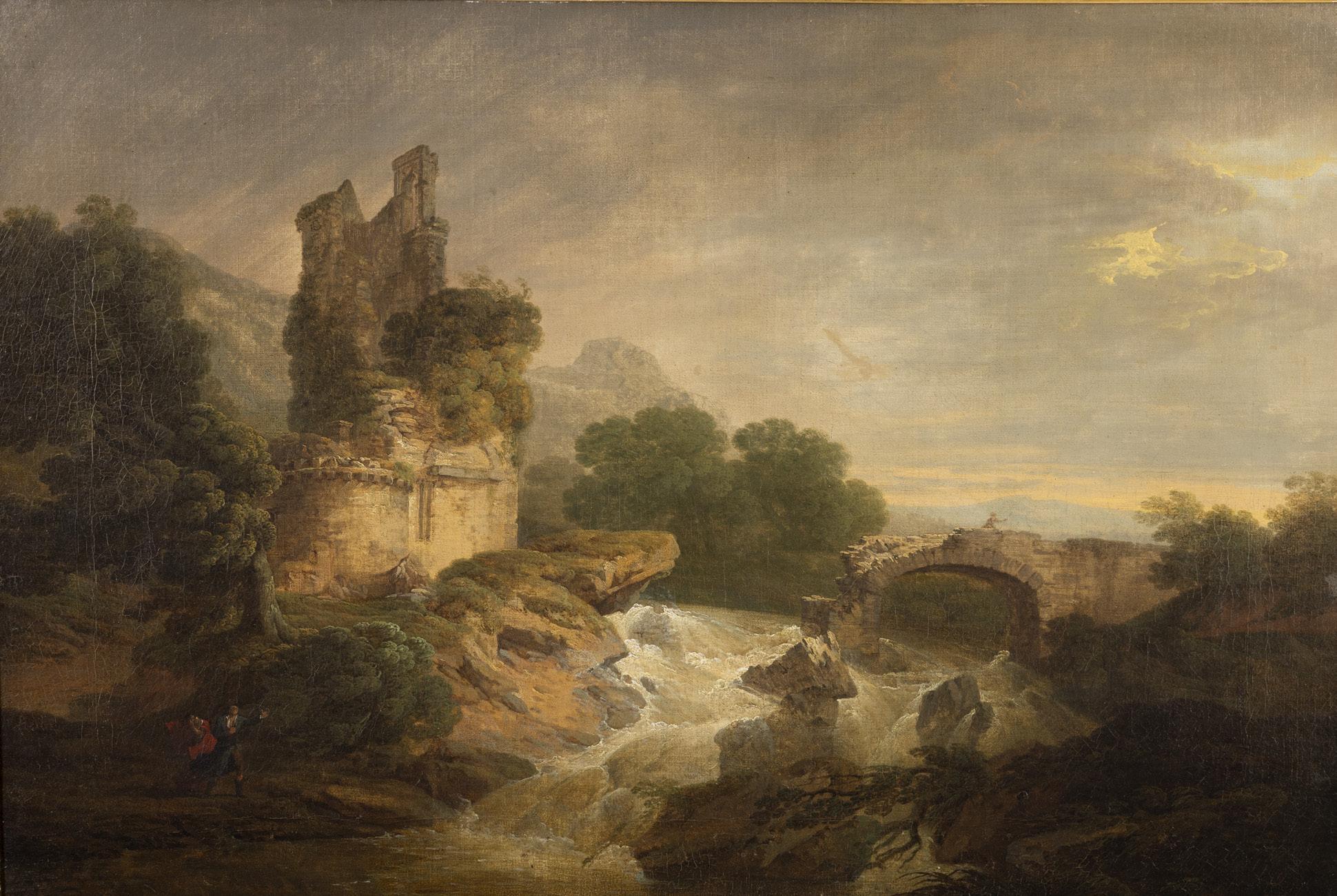
Landscape with Travelling Shepherds
Oil on canvas, 67 x 90cm
€ 15,000 - 20,000
This is one of a small group of closely related landscapes which, with four upright scenes showing the times of the day (Office of Public Works), and a handful of other works, constitute the tiny corpus of certain works (less than a dozen canvasses in total) by the landscape painter George Mullins. Despite this small oeuvre, Mullins is beginning to be better understood as an artist, subsequent to research on his pupil, Thomas Roberts (1778-77). Clearly related are three landscapes, one in a private collection in the United States; one from the collection of the late Patrick Kelly of Fitzwilliam Square (Sold Sotheby’s, 44 Fitzwilliam Square, 10 Nov. 2020, lot 107, GB£63,000) and one sold by Gorry Gallery (October 2020) which include the same elements of an unusually stark crag silhouetted again the sky, an expanse of water crossed by a bridge and a ruinous tower incorporating gothic architectural elements. In each, a group of figures approaches from the side and the composition is framed by a repoussoir tree. Here, the precise handling of the foliage anticipates that associated with Mullins’s great pupil Thomas Roberts. This miniaturising technique is not, however, at the expense of an expansive grandeur of conception and attractive tonality. The blue and red details of the figures in the foreground, repeated in the red blanket covering the donkey’s pack, offer a pleasing chromatic contrast to the variegated verdure. This group of travellers and sheep echoes very closely (though in reverse) that in the ex-Gorry picture.
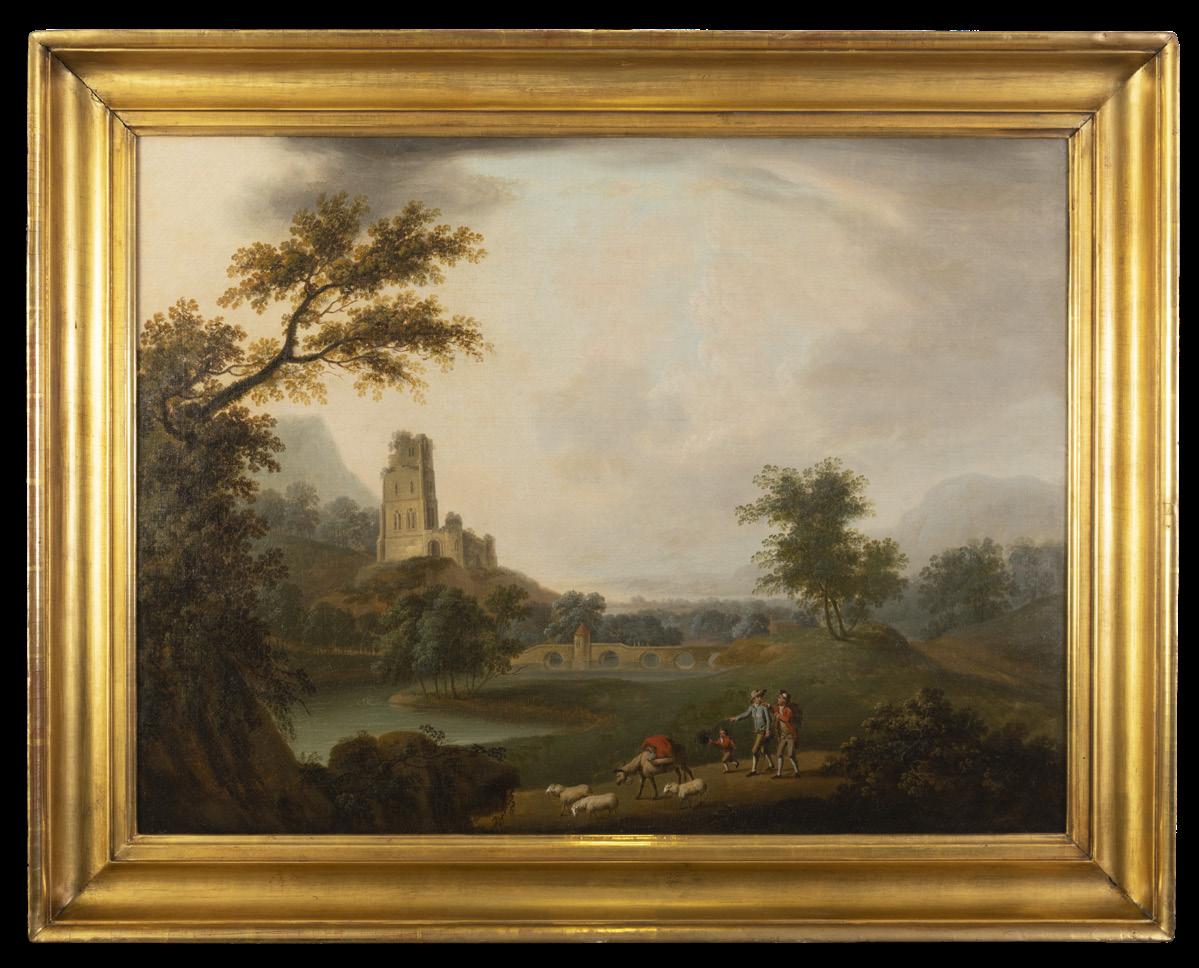
Mullins married the proprietor of the Horseshoe and Magpie, a tavern on the Temple Bar side of Dame Street – Hugh Douglas Hamilton (1740-1808) married her sister – and a generation of young artists lodged with them including Roberts, James Coy (c. 1750-c1780), and Robert Healy (1743-71). It is becoming increasingly clear that the proximity in which Irish artists lived, worked and exhibited profoundly shaped the distinctive aspects of eighteenth-century Irish art, be in the charcoal drawings of artists like Healy or the landscapes of Mullins and Roberts. Mullins exhibited frequently at the Society of Artists close by in William Street but subsequently moved to London, exhibiting works such as a Portrait of a Spaniel Dog and a Portrait of a Beggar in Wales which hint at a wholly different type of subject matter, after which he disappears from the historical record. However, it can now be shown that he returned to Ireland and his death date must be pushed back by almost fifteen years from the circa 1775 that is usually given. Instead, John Warburton’s History of Dublin of 1818, so, close in time to the events to which he refers, notes that ‘after residing in London several years [Mullins] returned, and died in Dublin about the year 1798’. While it is certainly ‘testament to Mullins’s own skills as a landscape painter’ that ‘Roberts became arguably the best Irish landscape painter of the eighteenth century’ (Nicola Figgis in AAI., Vol. 2, p. 377), his own highly accomplished, and very rare, works present a distinctive and appealingly harmonious vision, and Mullins is one of the key, if least appreciated, figures within the Dublin Group of landscape painters.
William Laffan
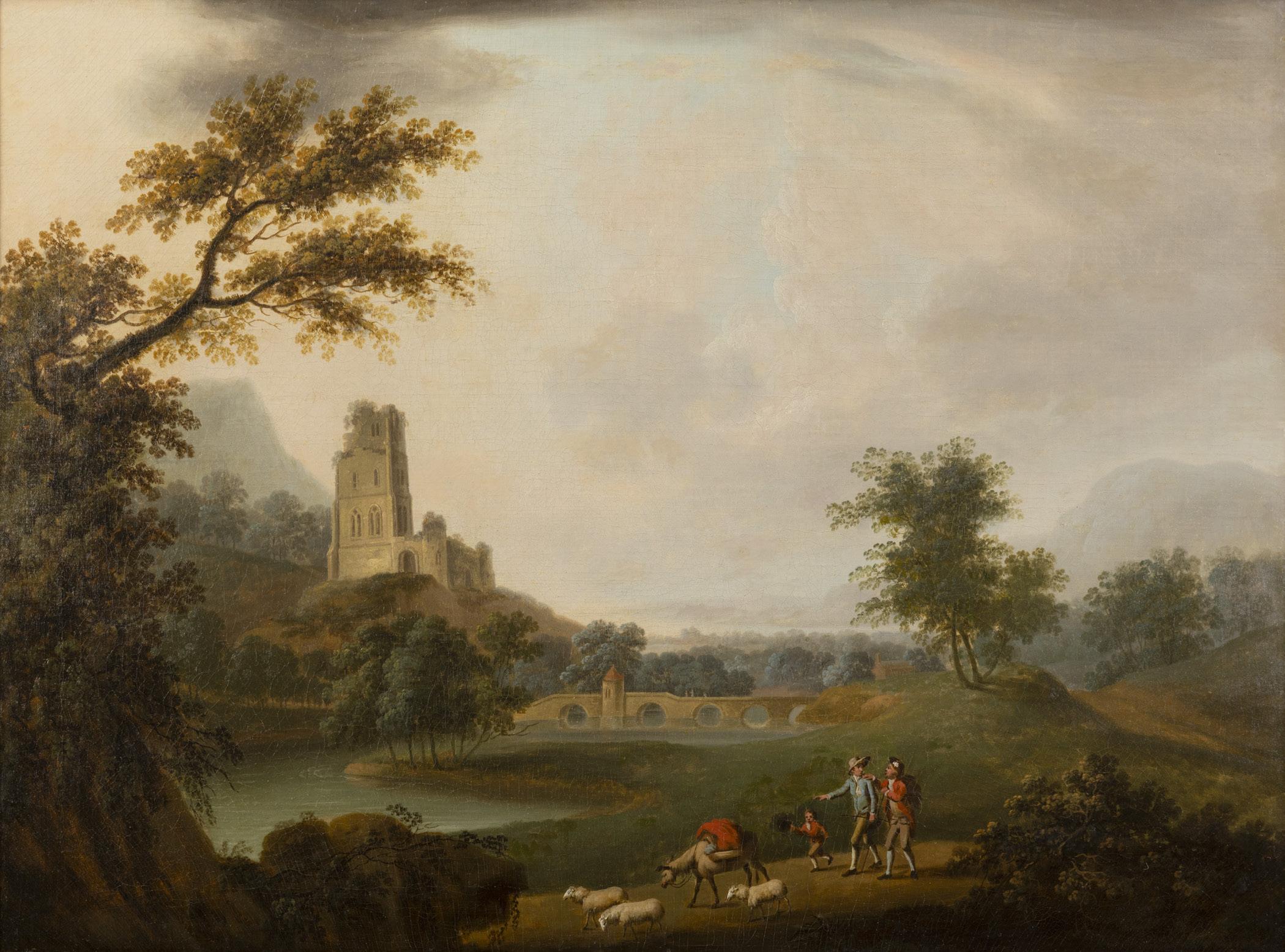
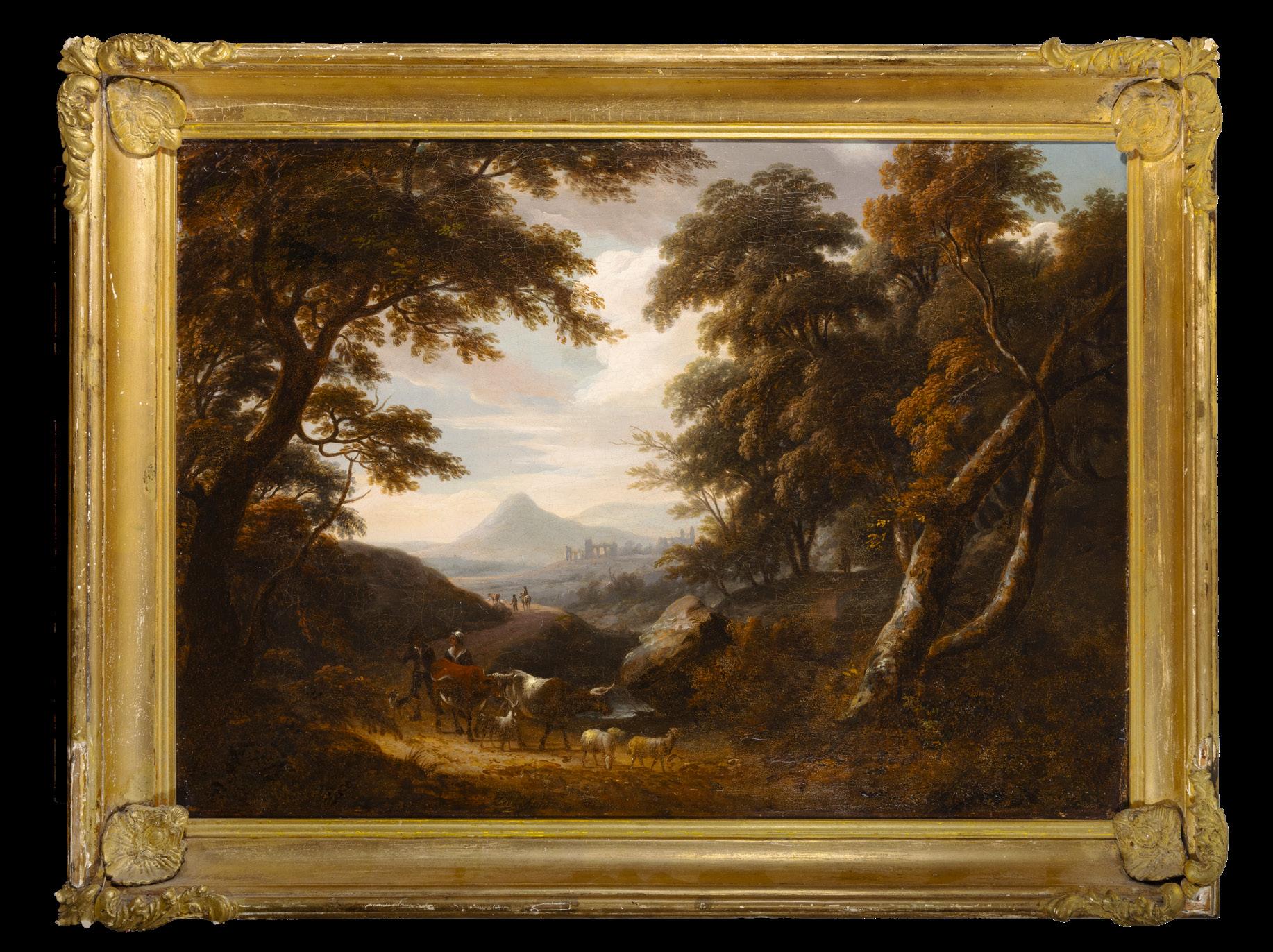
A wooded landscape, with figures and livestock on a path and ruins beyond
Oil on canvas, 53.5 x 74.9 cm Signed and dated ‘W.Ashford 1809’ (lower centre)
Provenance: Christie’s, London, 20 November 1981, lot 75 (sold £4,000); James Adams & Sons, 20 November 1986, lot 118; Christie’s, London, 14 May 2004, lot 23 (sold £20,315);
Literature: A. Crookshank, ‘A Life devoted to Landscape Painting: William Ashford’, Irish Arts Review Yearbook, vol. 11, 1995, p. 130, no. 77.
€ 20,000 - 30,000

William Ashford is one of the key figures in the rise of the eighteenth-century landscape school of the 1760s onwards. Although born in Birmingham he was to spend his entire career in Ireland, ending it as the first president of the Royal Hibernian Academy. He came to Ireland in 1764 and initially followed a government career being appointed Clerk to the Comptroller of the Laboratory of the Ordnance on an annual salary of £40. Ashford started to exhibit four year later showing flower pieces and still lives at the Society of Artists in Dublin. From 1772, however, he started to exhibit landscapes, the genre to which he was to devote his life. Ashford met early critical success winning premiums from the Dublin Society and being noticed in London after showing at the Royal Academy in 1775. After the death of Roberts in 1778 he completed the latter’s important series of View of Carton, which still hang in the house. In another work of the same year, also commissioned by the Kildares, the similarities between the two artists’ approaches are clear. Also in the same year Ashford was elected a member of the Society of Artists. This fine landscape dates from 1809 and in its combination of travellers with ship progressing along a road in a hilly, wooded landscape bears comparison with a large landscape of 1802 formerly in the Richard Wood collection.
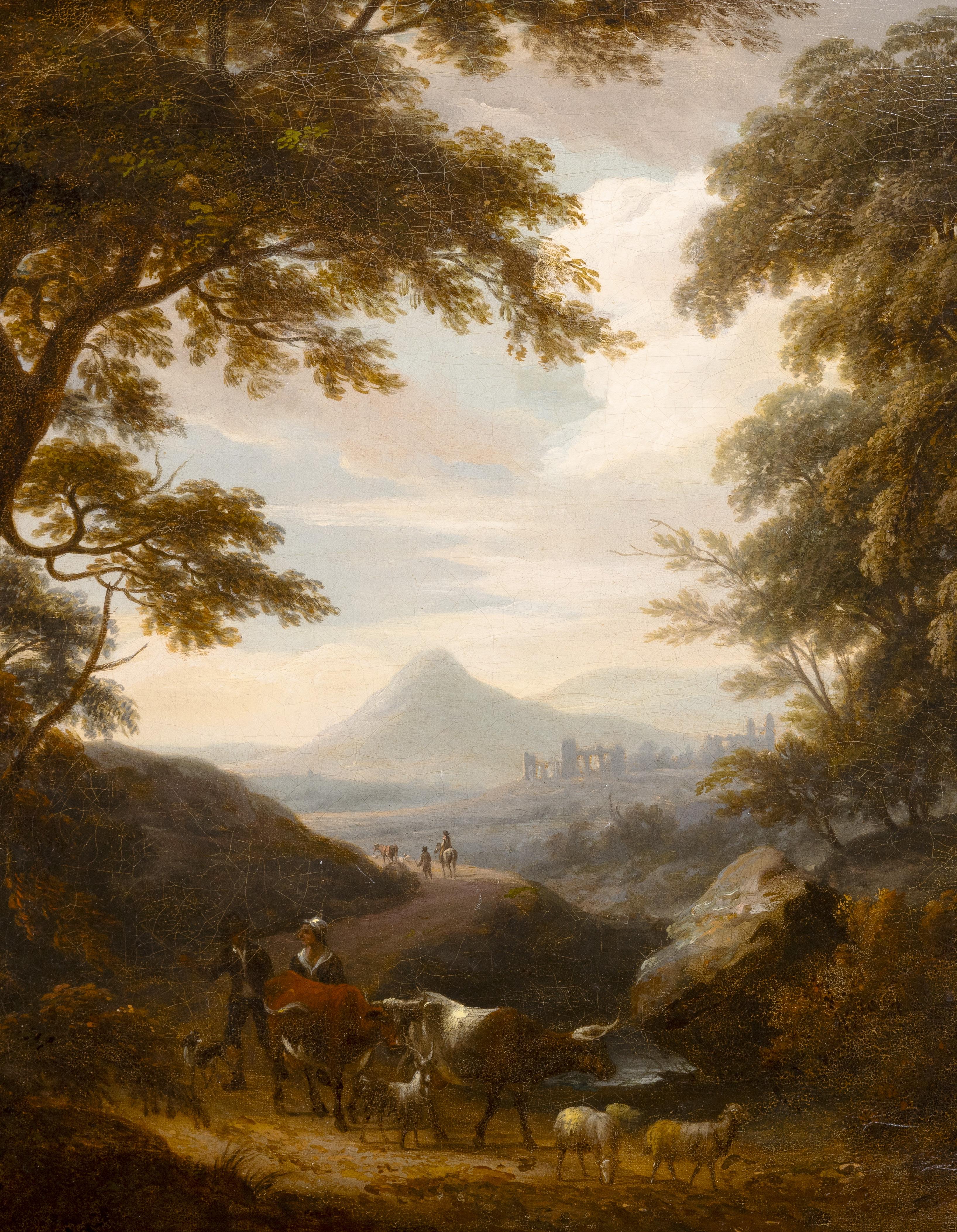
44
SAMUEL FREDERICK BROCAS (1792-1847)
River Landscape with Figures sitting on a Rock, and Distant Castle
Oil on panel, 40.5 x 60.4cm
Provenance: Collection of the Hon. Francis D. Murnaghan Jr., thence by descent
€ 1,500 - 2,000
45
WILLIAM GILLARD (C.1812-1897)
Cattle by a Riverbank, Figures Beyond
Oil on paper laid down on wood, 19.5 x 28cm
Signed and inscribed on label verso
€ 600 - 800
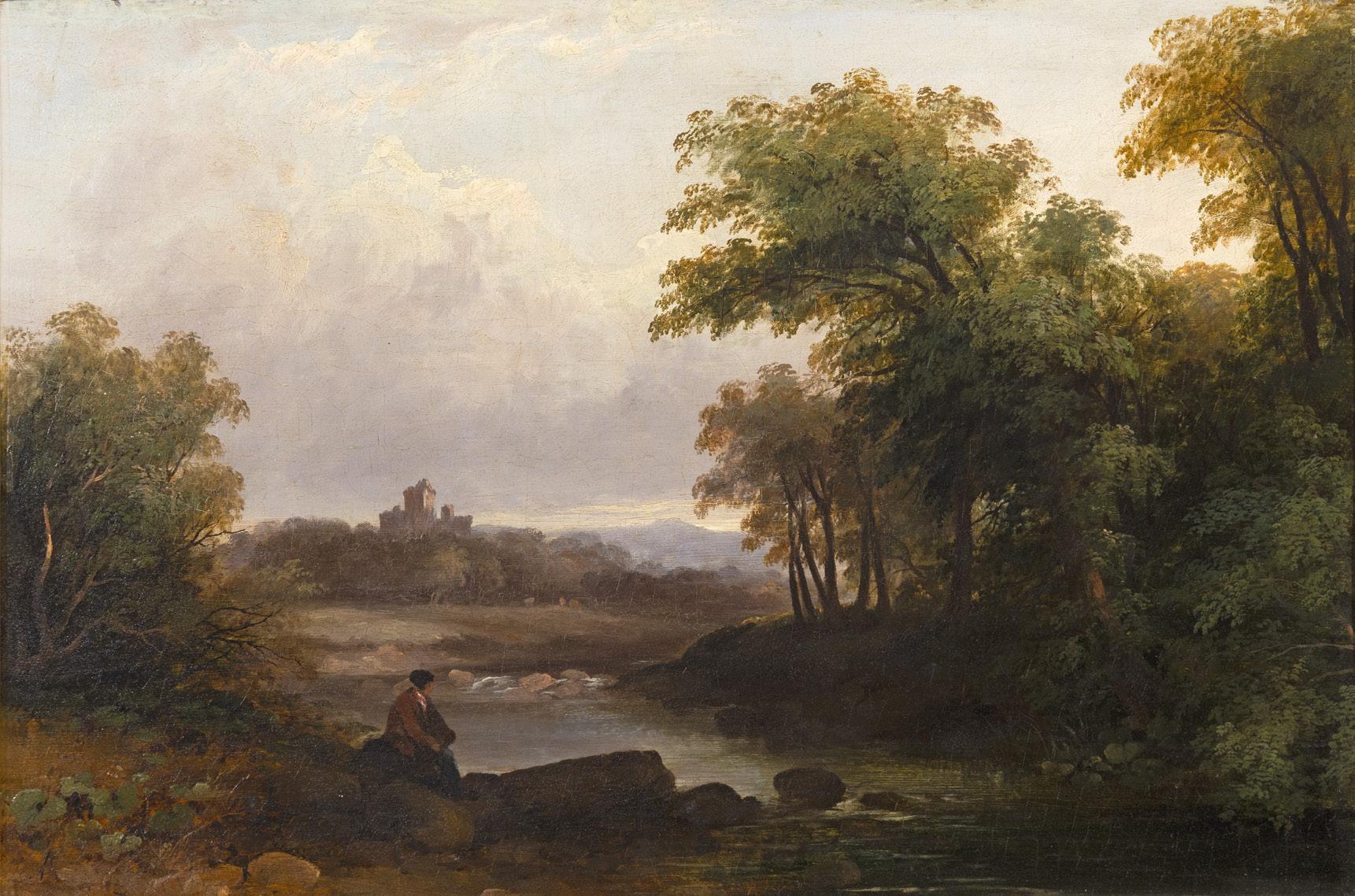
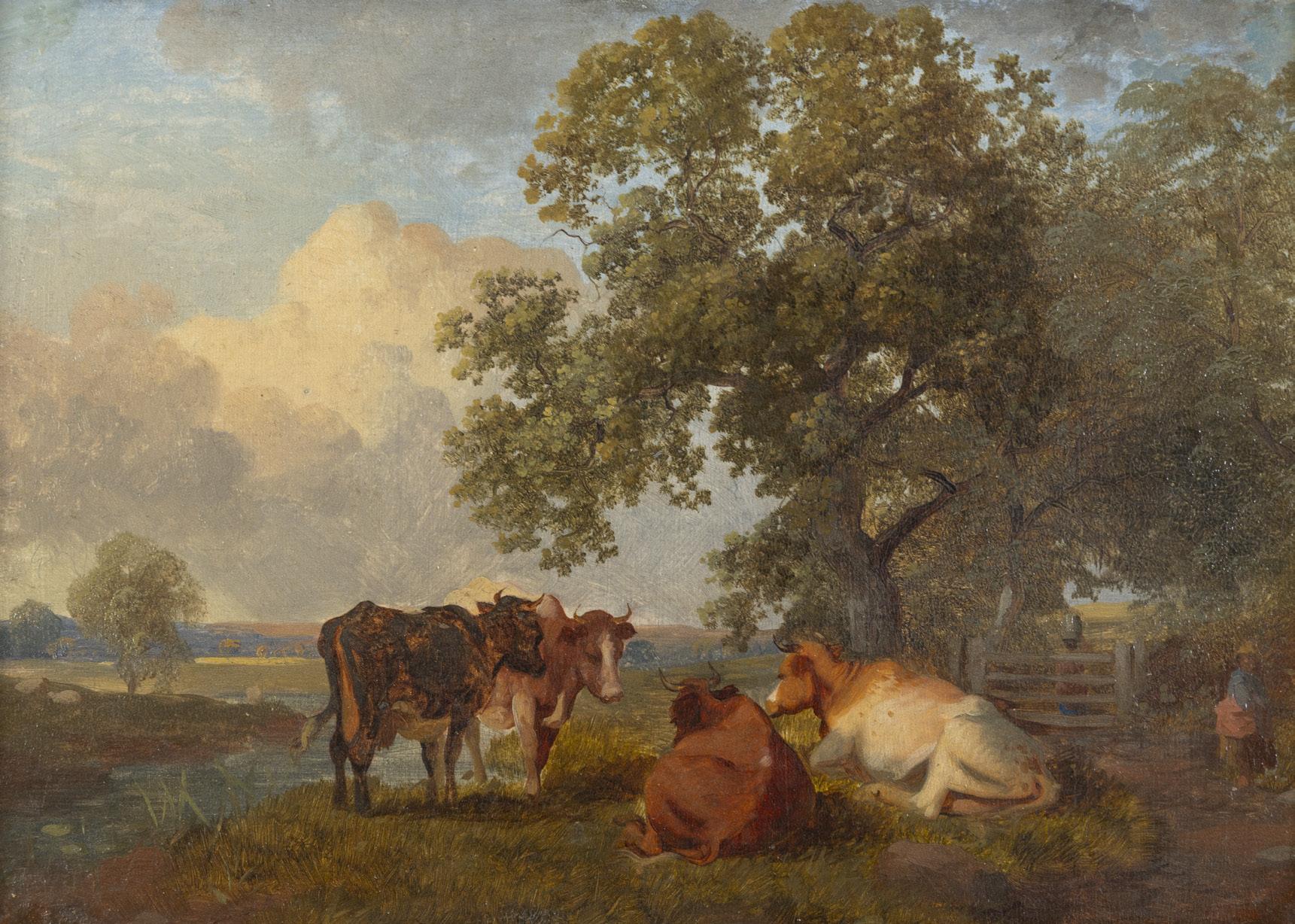
MARIA SPILSBURY (1777-C.1823)
Portrait of Jane Bryan, of Cong, Co. Galway
Oil on canvas, 74.5 x 58 cm
With a pencil sketch by the artist titled ‘Sunday School’ attached verso
Provenance: Sotheby’s, London, 21 May 1998, Lot 238
€ 8,000 - 10,000
This sensitively rendered portrait of Jane Bryan, of Cong, County Galway, represents a compelling example of Maria Spilsbury’s mature portrait practice following her relocation to Ireland in the 1810s. Although biographical details regarding the sitter remain scarce, the Bryan family of Cong were members of the established Protestant gentry in the west of Ireland, likely embedded within the wider Anglo-Irish social and ecclesiastical networks in which Spilsbury herself moved following her marriage to the Reverend John Taylor in 1808.
Born in London in 1776, Maria Spilsbury was the daughter of the Moravian preacher and engraver Jonathan Spilsbury, whose connections to artistic and religious figures such as Sir Joshua Reynolds and Charles Wesley placed her in close proximity to elite cultural circles from an early age. Without formal academic training, she studied under her father in the family’s engraving studio and made her public debut at the Royal Academy at the age of fifteen. Between 1792 and 1808, she exhibited forty-nine works at the Royal Academy. Spilsbury’s early success in London, where her studio at St George’s Row became a fashionable destination frequented by society patrons including the Prince Regent, was followed by her move to Ireland in 1813. In Dublin and Wicklow, she remained artistically prolific, cultivating relationships with Protestant gentry and evangelical communities, who formed a consistent base of patronage. It is within this milieu that the present portrait of Jane Bryan was likely commissioned.
Of particular interest is the pencil drawing attached to the verso, titled Sunday School. This work reflects Spilsbury’s long-standing engagement with the visual culture of evangelical reform and Christian education. Themes of religious instruction and moral virtue were central to her practice,
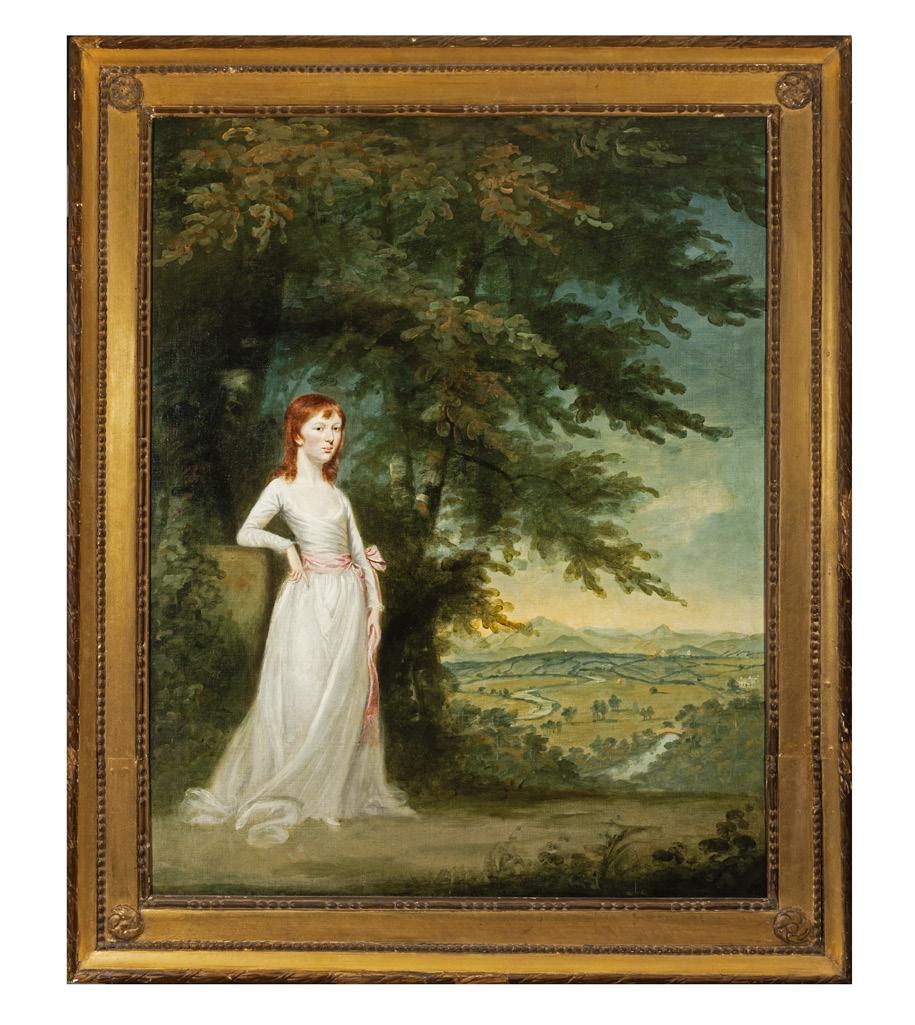
often depicted through scenes set in natural, pastoral environments where nature functioned as both symbolic and spiritual terrain. Comparable works include Going to School and After School (both engraved, 1802), and the widely exhibited The House of Protection for Destitute Females of Character (Royal Academy, 1806; British Institution, 1807).
Spilsbury's commitment to religious themes also shaped her more ambitious multi-figure compositions, such as John Wesley Preaching in the Open Air at Willybank (c.1815, Museum of Methodism, London), and Patron’s Day at the Seven Churches, Glendalough (c.1816, National Gallery of Ireland, NGI.4587), the latter commissioned by the Prince Regent. The Glendalough painting, often regarded as one of the most significant visual records of early 19th-century Irish devotional life, showcases her skill in large-scale narrative and close observation of vernacular life.
Her broader oeuvre spans religious narrative, domestic genre scenes, and refined portraiture. Her works are represented in major institutional collections including the National Gallery of Ireland, the British Museum, Tate Britain, and the Museum of Methodism, London. The pencil sketch Sunday School, attached to the reverse of the present canvas, finds a clear parallel in Spilsbury’s surviving sketchbooks, housed in the Prints and Drawings Department of the National Gallery of Ireland. Despite the brevity of her career, curtailed by her death in 1820, Spilsbury’s work constitutes a vital visual archive of the devotional, moral, and domestic ideals that defined Protestant evangelical culture in Britain and Ireland during the early nineteenth century.

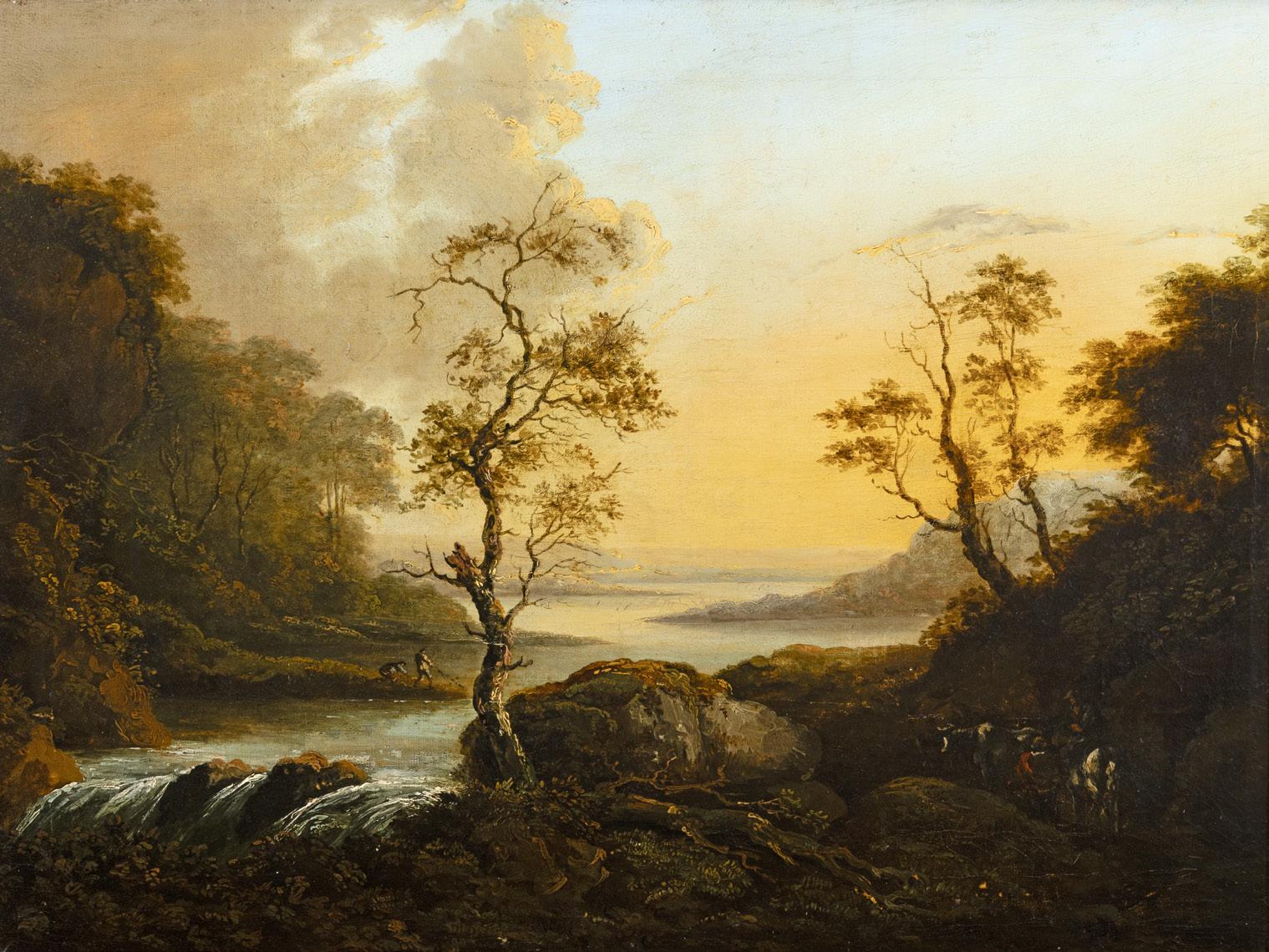
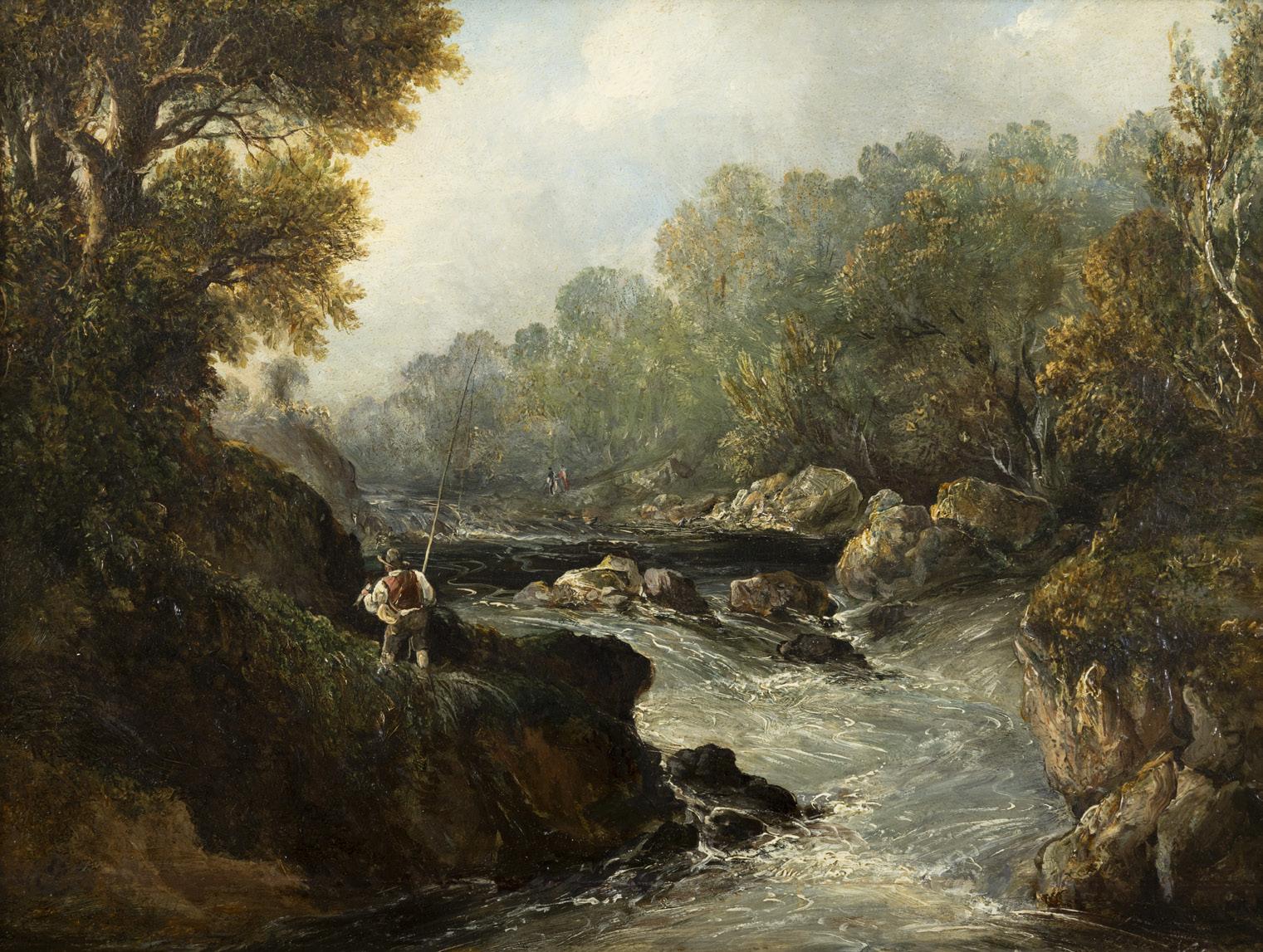
47 WILLIAM SADLER (1782-1839)
A Drover with Cattle in a River Landscape
Oil on canvas, 43 x 61cm
€ 6,000 - 8,000
48
ATTRIBUTED TO THOMAS SAUTELLE ROBERTS (1760-1826)
Fisherman Holding a Fish by a River
Oil on wood, 24 x 34.5cm
€ 800 - 1,200
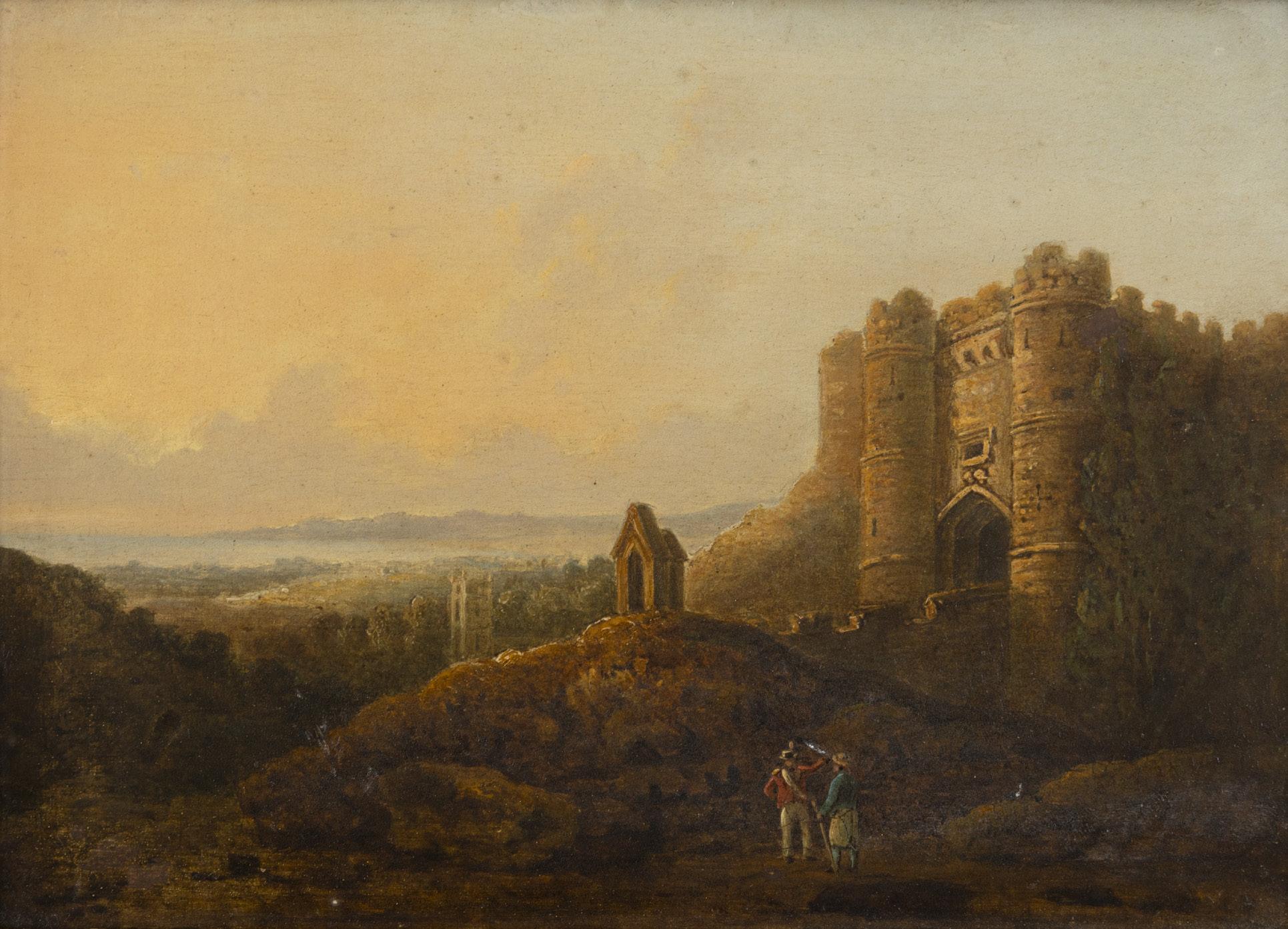
Oil on panel, 14.5 x 21cm Inscribed verso
€ 800 - 1,200

Figures at Powerscourt Waterfall, Wicklow
Oil on wood, 22 x 33.5cm
€ 3,000 - 5,000
Known particularly for his competent, atmospheric and topographically interesting views of the countryside around Dublin, Sadler remains an enigma in the history of 19th century Irish art. This is partially because his father, William (fl.1768-1788) and his own son, also William (b.1808) painted somewhat similar scenes in a vaguely similar style and can be confused. William Sadler II, however, stands out as being a better painter than either his father or his son. He is also credited as having taught painting and counted James Arthur O’Connor as one of his pupils. He is recorded as exhibiting, between 1808 and 1821, many paintings on his trademark mahogany panels. The Royal Hibernian Academy records four paintings by Sadler exhibited at the 1828, 1833 and 1836 annual exhibitions, giving his address as Buckingham Street and later at Merrion Avenue. In his 1913 Dictionary of Irish Artists, Walter Strickland notes however that he finally settled in Manders Building in Ranelagh where he died in December 1839. Sadler was greatly influenced by and painted many copies of the Old Masters, particularly Dutch painters and this influence is seen in his landscape compositions with small figural groups. He also incorporated their technique of painting bright highlights to accentuate the almost three dimensional effect of his figures.
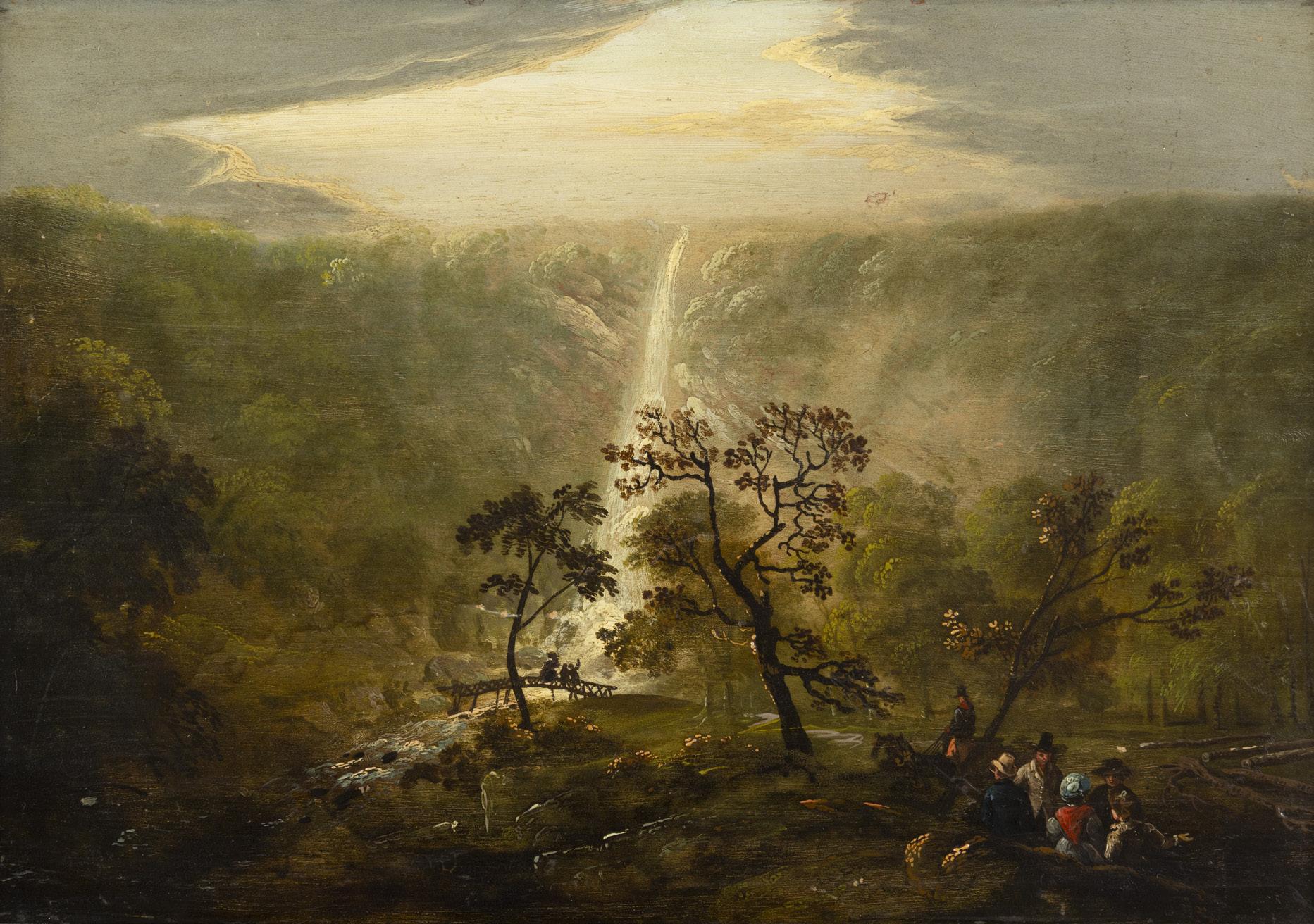
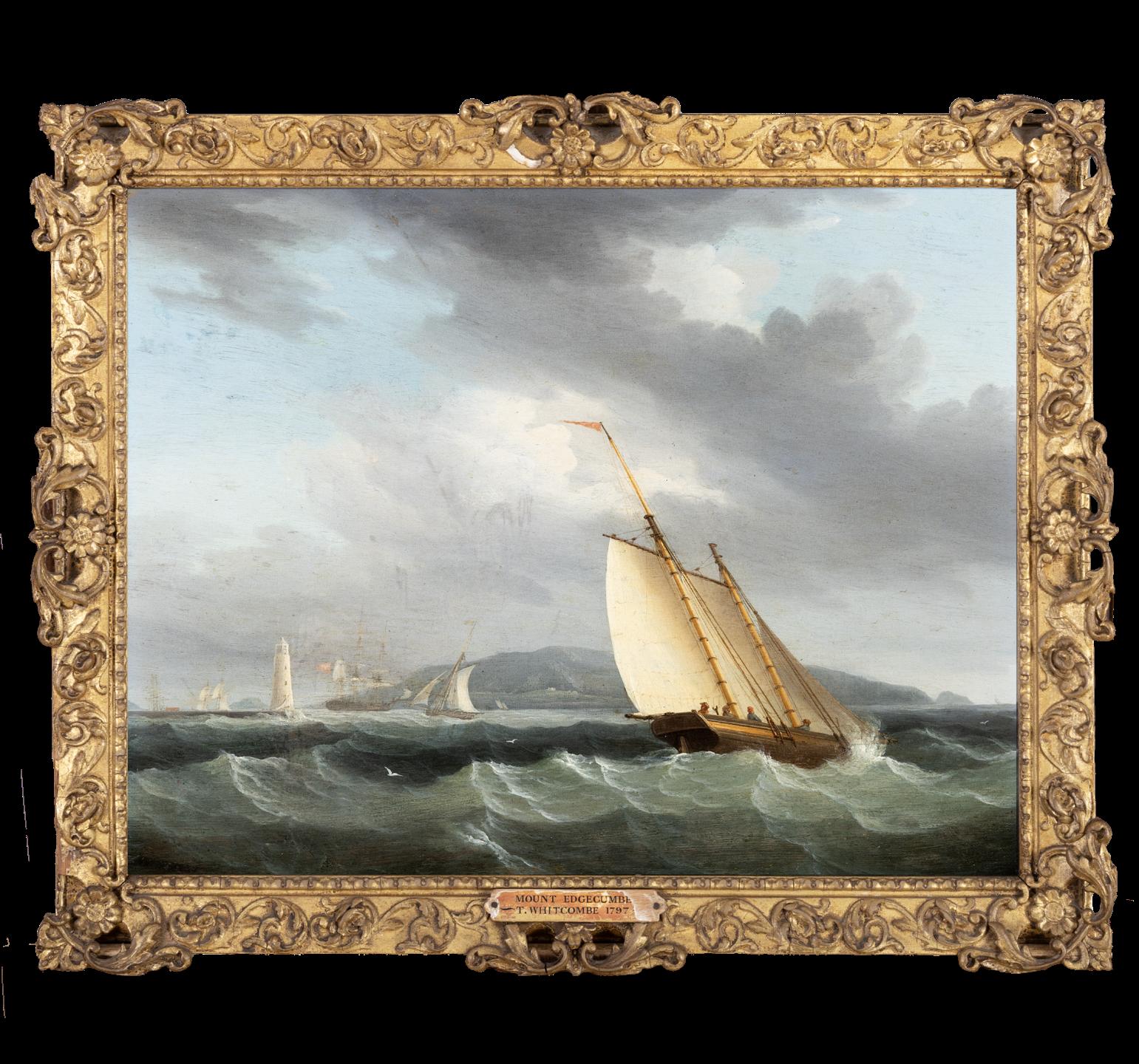
51
ATTRIBUTED TO JOHN THOMAS SERRES (1722-1793)
Shipping off Dublin Bay with Poolbeg and Howth
Oil on board, 29 x 37.5cm
Provenance: Duke of Devonshire wax seal verso
€ 4,000 - 6,000
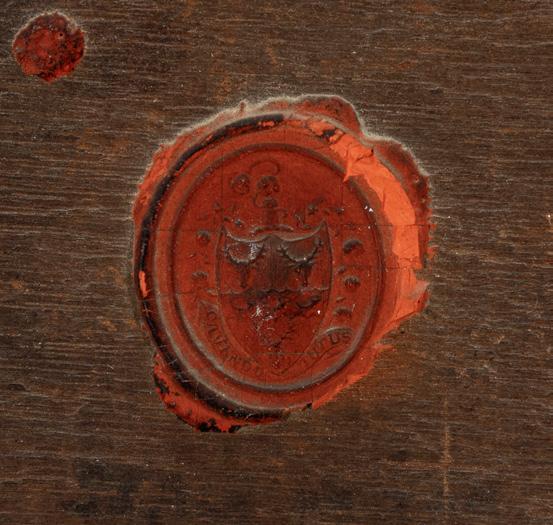

Ireland’s premier 19th century landscape painter James Arthur O’Connor remains as vital today as he did when he first began his artistic career over two hundred years ago. The majority of his work at the time appealed to the fledgling middle classes which has translated into an accessible and unifying oeuvre in today’s market. He was born circa 1792 at 15 Aston’s Quay, Dublin 2 to William O’Connor, a Dublin based print seller and engraver. The young artist had some introduction to the engraving business through his father as evidenced by his own attempts at etchings earlier in his career, notably publishing a series featuring scenes of Dublin in 1810 to some success. O’Connor’s early painting career however, blossomed under the influence of his fellow young Irish artists Francis Danby (1793-1861) and George Petrie (1790-1866) and the three moved to London in 1813 for a period to finish their training. According to Dr. Eric Adam’s in his 1969 thesis on the career of Francis Danby ‘It was normal practice for any Irish artist who could afford it to finish his education by coming to London, and, if he had any ambition to try and settle there. In Ireland there was little art to study beyond the plaster casts of the schools, and little patronage either’. Despite this, O’Connor eventually felt the economic pressure of his stay in London and made the difficult decision to return home to Ireland to care for his now orphaned siblings, leaving Mr Danby behind, he having managed to claim a patron in a Mr John Minthorn of Bristol. O’Connor exhibited frequently with the Hibernian Society of Artists when back in Ireland to general success. In 1818-1819 he completed a number of beautifully executed topographical views of the West of Ireland and the seats of gentry there including Westport House and Ballinrobe House in Co. Mayo, perhaps one of few brushes with the aristocracy he enjoyed during his lifetime. O’Connor’s earlier topographical commissions were inherited from the legacy of Irish artistic stalwarts such as William Ashford (1746-1824), Thomas Roberts (c.1748-1778) and George Barret (c.1730-1784). The purpose of such a commission was to depict the estate as a cultivated and perfectly proportioned paradise in a sweeping landscape. This was often aided by a higher vantage point to infer the idea of a natural order within the civilised 18th century society. The topographical commission became less popular as the socio-economic climate began to change, and solvent patrons became harder and harder to come by and so O’Connor turned towards the Picturesque for inspiration. This accounts for a large number of the views we associate with O’Connor’s legacy, reflected in the National Gallery’s exhibition of 1985-1986 of the artist, compiled by John Hutchinson, which sought to celebrate this Mid Period of his work. Lot 52 is a superb addition to the sales catalogue from this period and a true champion of the Picturesque. It features a lakeside landscape, dramatized by a steep mountainous backdrop. Painted in exquisite detail, this observes O’Connor’s typical use of light and shade to outline the pictorial space. The viewer’s eye is
drawn to the lakeside scene in the background and the minute brushstrokes which indicate a far-off town or village, as of yet, unidentified. The grandeur is softened by the addition of the rustic figures and cattle to the foreground which invokes a bucolic beauty typical of O’Connor’s Mid Period and indeed the gentle sensibilities of the aesthetics of Beauty as interrogated by Edmund Burke (1729-1797) in his seminal essay ‘A Philosophical Enquiry into the Origin of our Ideas about the Sublime and the Beautiful’. There are few comparable scenes outside of the National Gallery’s Collection which espouse O’Connor’s talent in this area. O’Connor’s approach to landscape evolved again in the years following his return to England in 1822 with his wife Anastatia. The effect of monumental Romantic figures such as J.M.W. Turner and John Constable are evident in his output which were still largely Irish in subject though they depict a decidedly more personal response to the landscape, enhanced by his dedication to atmosphere rather than topographical accuracy or Beauty. As Constable stated of his own artistic inclination ‘A gentleman’s park is my aversion. It is beauty because it is not nature’. In these later pictures, shadow and light elevate the drama of the imposing rockfaces, a thicket of trees invites the viewer to disappear into the undergrowth and the sky is blackened by the knot of branches and threatening clouds, invoking drama. The most well-remarked upon example of such drama is ‘A Thunderstorm: the Frightened Wagoner’ which is held in the National Gallery and was exhibited in the 1941 Centenary exhibition of the artist’s death in the Municipal Gallery and later represented in the Crawford Gallery’s Terror and Sublime: Art and Politics in an Age of Anxiety, Cork, 20 November 2009 - 27 February 2010.
As per the prerequisites of the Romantic style, Lot 56 and 60 are heavily influenced by the emotion the artist felt when confronted by the woodland of each scene. It could be argued that the painted figure in the foreground of lot 56, stands outside of the usual requirements of staffage as he surveys the nebulous forest before him. O’Connor has further aligned himself with the Romantic in both by employing the use of the Rückenfigur (figure from the back) commonly associated with the work of Caspar David Friedrich (1774-1840), one of the leading figures of the Romantic movement on the Continent. O’Connor’s career saw him travel to France, Holland, Belgium, and numerous mountain villages in Germany’s Rhine Valley where he would have no doubt been exposed to the influence of Friedrich and his interpretation of the Sublime. O’Connor’s ‘The Poachers’ (1935), a prize piece in the National Gallery’s Collection certainly acknowledges Burke’s treatise through the artist’s generous treatment of the vast sky and expansive moonlit landscape, in which his three poachers are silhouetted huddled in an uneasy stance, exuding a distinct impression of vulnerability. Similarly, the rustic figure of Lot 60 steps out of the shadow to survey the glen before him, a scene that is largely obstructed from us, the viewer. Our
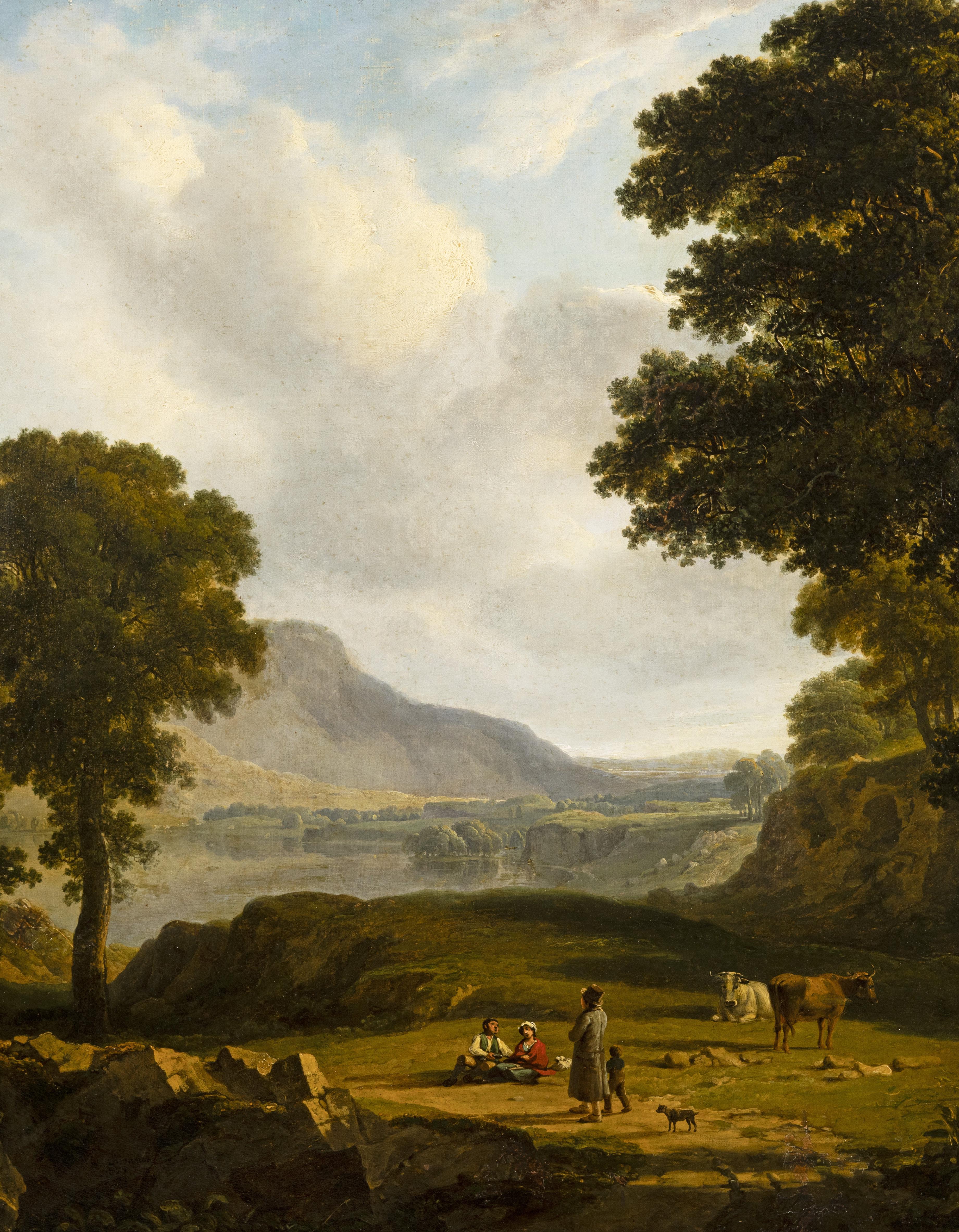
52
An Extensive Landscape with Travellers and Cattle
Oil on canvas, 61.5 x 74.5cm
Signed and dated 1828
€ 20,000 - 30,000
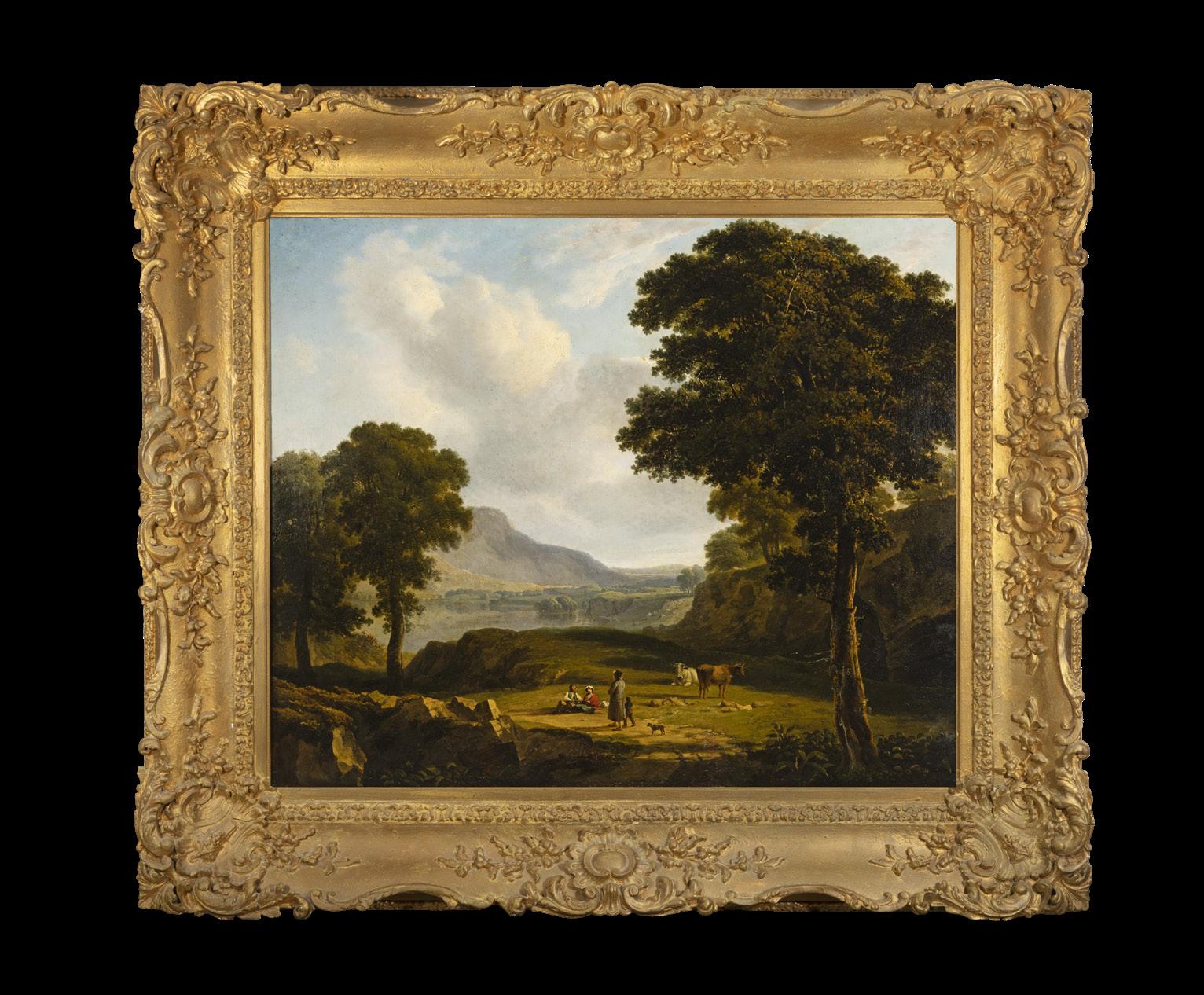
gaze is drawn to his silhouette in a pool of light and the impenetrable shadows in the foreground thereby invoking curiosity. Given that this picture was dated less than a year before the artist’s death, the image of the lone figure and his dog emerging into the light and basking in the heavenly view, is prescient.
O’Connor’s artistic career, though enduring started and ended without fanfare – he being a victim of bad business deals and a gentle, unassuming nature which although industrious did perhaps not enable O’Connor to benefit from his output during his lifetime. He died penniless on January 7th, 1841, nevertheless much-loved by those who knew him. His obituary in Dublin Monthly Magazine described him as ‘A spirit of exceeding mildness, mainly ardent, unobtrusive and sincere; generous in proclaiming
contemporary merit and unskilled and reluctant to put forth his own’. He is remembered now however as a crucial contributor to the Irish art landscape of the 19th century as his dedication to native country was unwavering in a period when his contemporaries had abandoned Ireland for greener pastures and deeper pockets. Despite his travels abroad, O’Connor always returned to Ireland to interrogate the effect of nature’s grandeur on his soul. His paintings remain are beloved in both private and public collections for their abiding honesty and – as John Hutchinson notes, their observation of the evolving tastes of the 18th and 19th century societies.
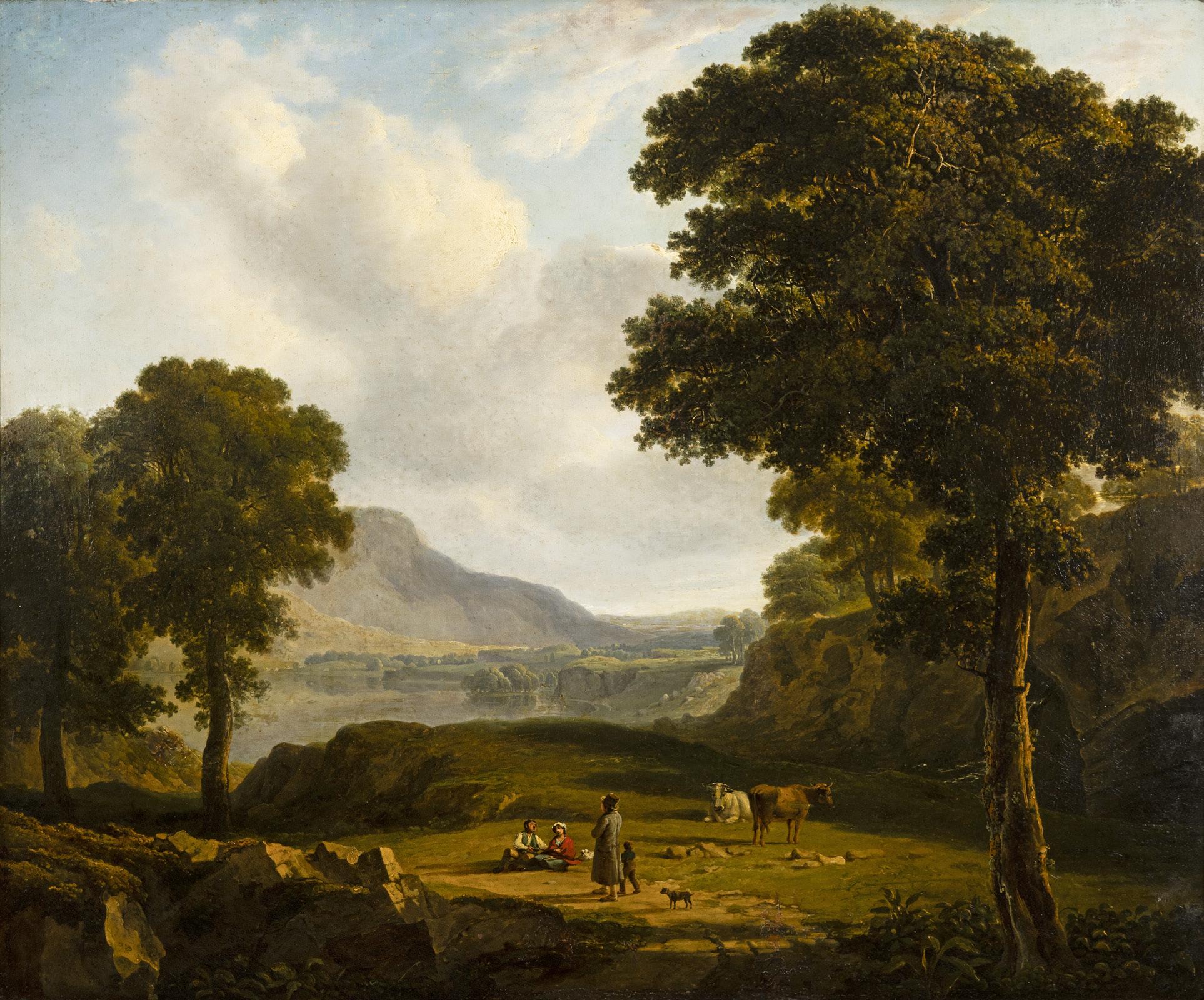
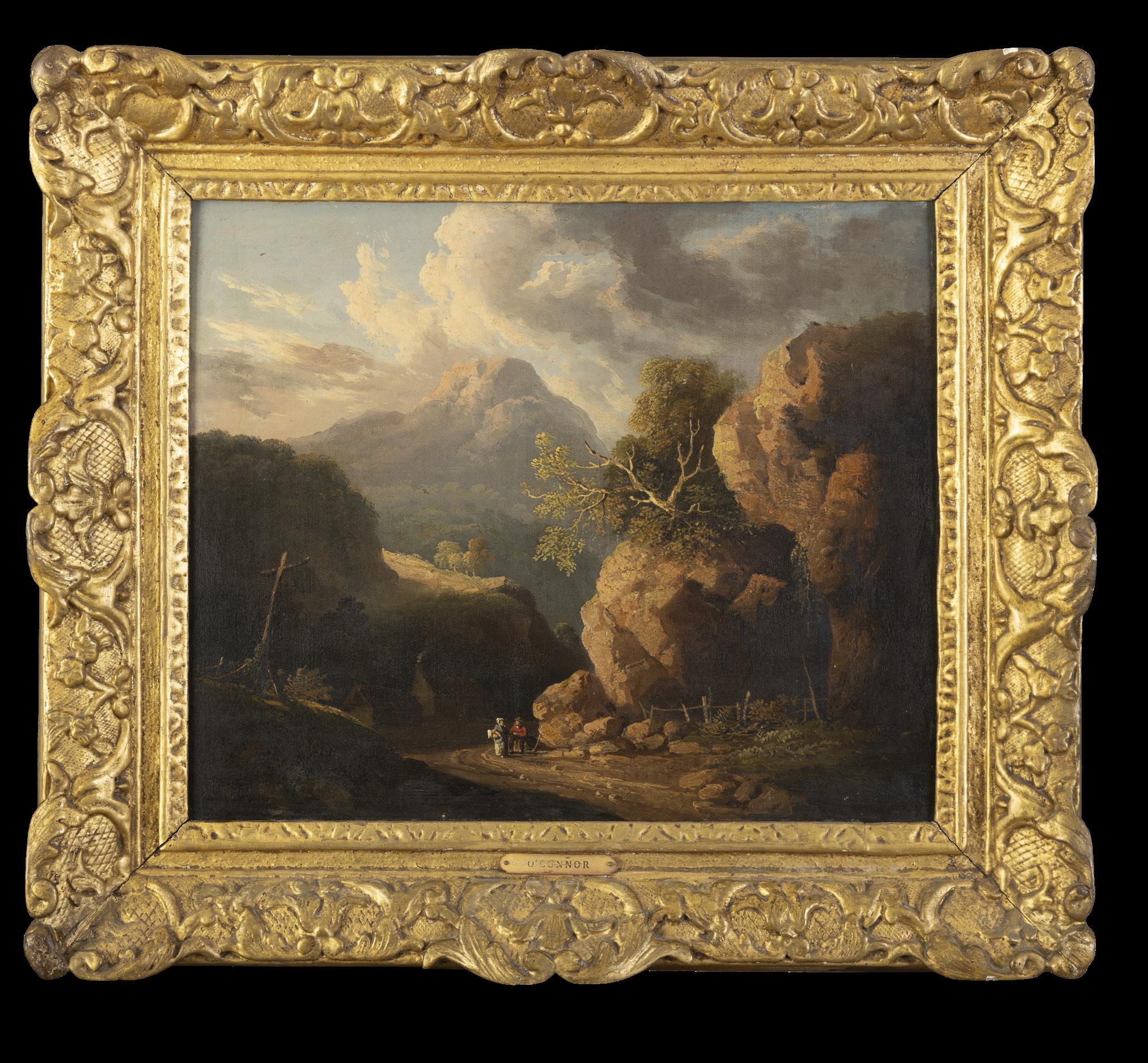
A Mountainous landscape with figures on a track
Oil on canvas, 36cm x 41cm
Signed indistinctly lower right in red, bearing old label verso
Provenance: Sale, Sheppard's, 24-25 Sept 2019, Lot 1061
€ 3,000 - 5,000
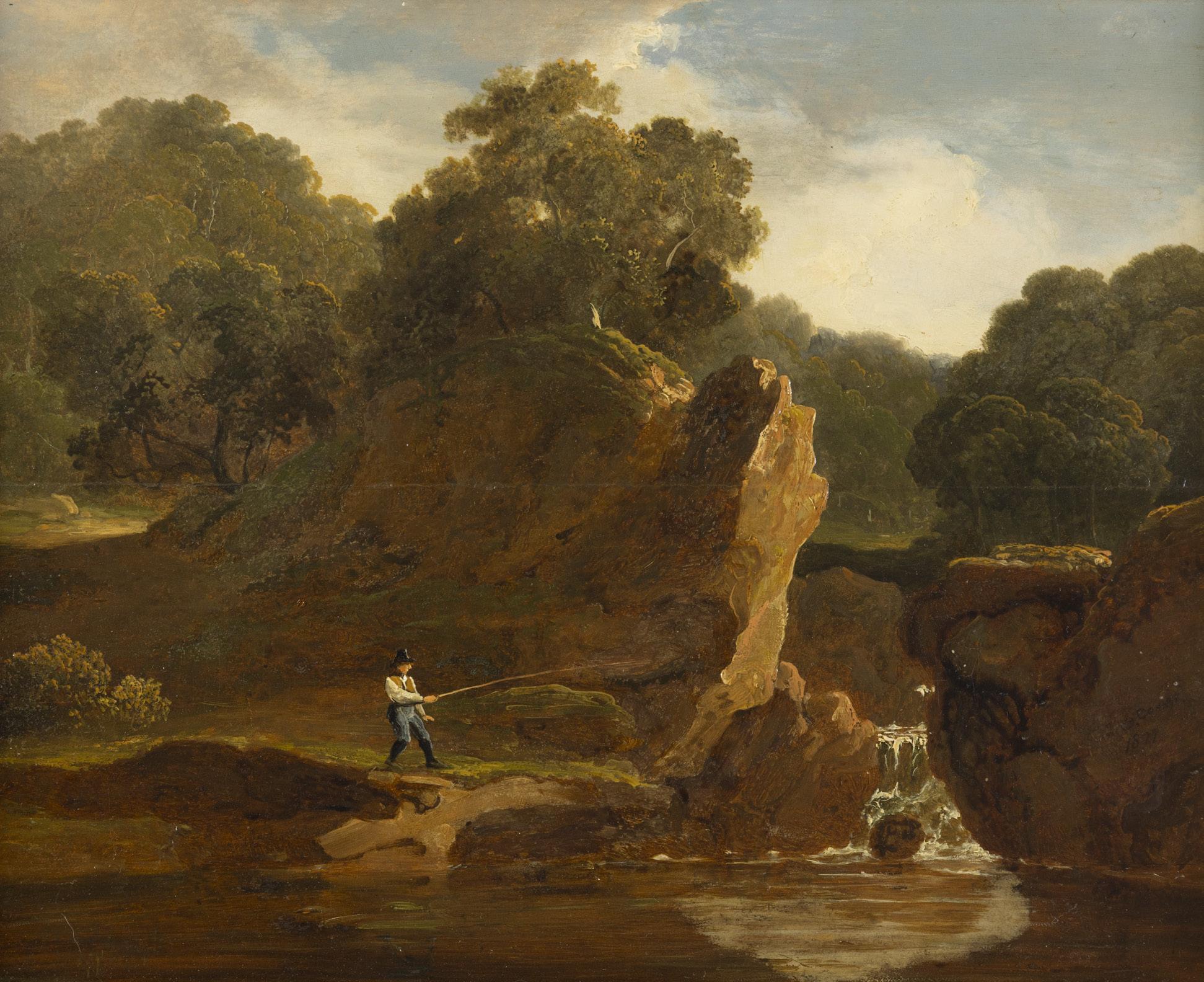
JAMES ARTHUR O'CONNOR (1792-1841)
Waterfall, with Fisherman at Salmon Pool Oil on panel, 31 x 39cm
Signed lower right and dated, 1827
Provenance: Sale, Adam's, 1 April 2009, Lot 60
€ 4,000 - 6,000
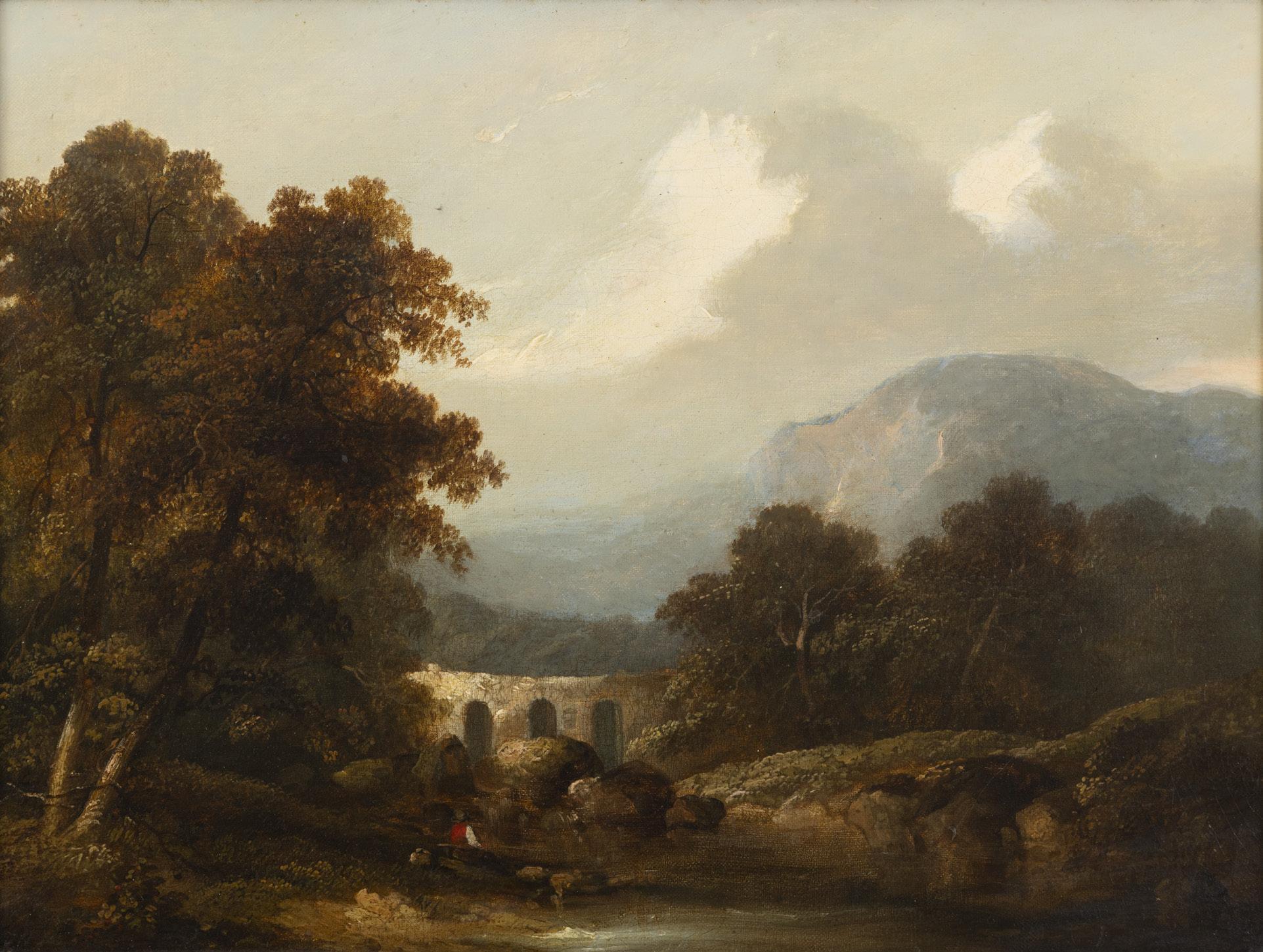
€ 4,000 - 6,000
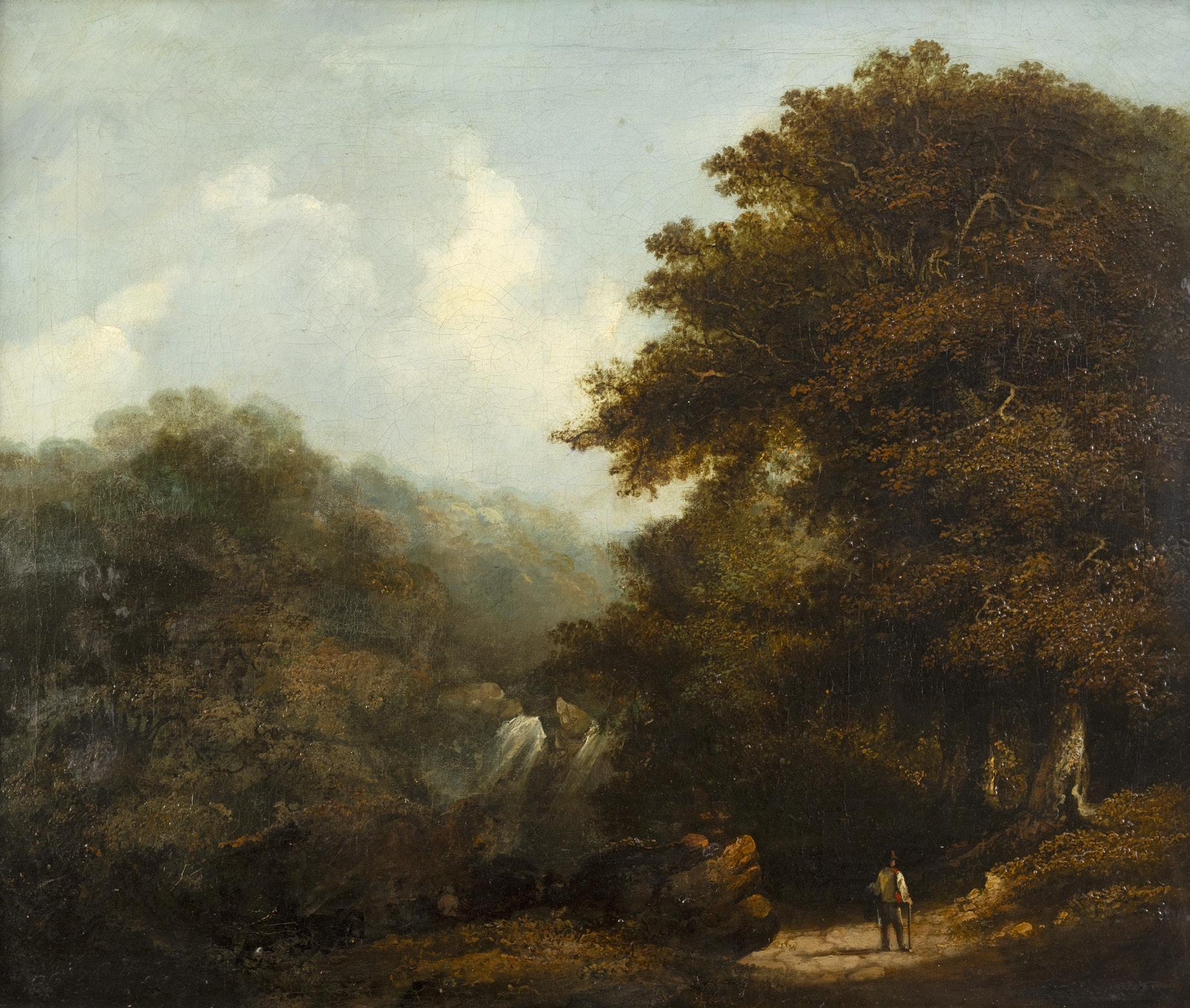
Figure on a Road Bedside a Tree, Waterfall Beyond
Oil on canvas, 50 x 60cm
Provenance: Sale, Sheppard's, 28-29 November 2018, Lot 227
€ 5,000 - 8,000
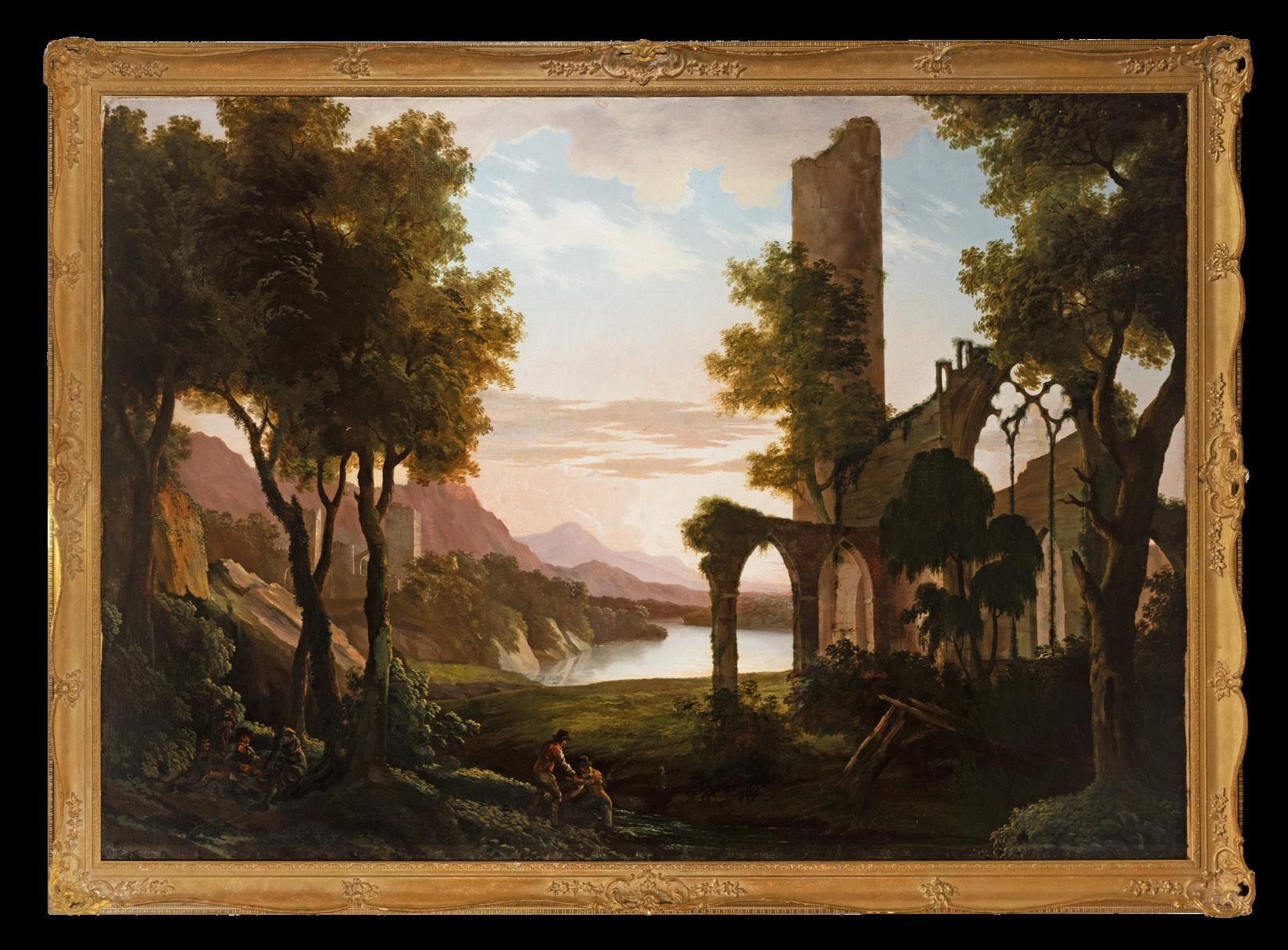
57 IRISH SCHOOL C.1850
Gothic ruin and Round Tower Beside a Lake
Oil on canvas, 127 x 182cm
Inscribed (on arch) with initials ‘B. A. of P.’
€ 8,000 - 12,000

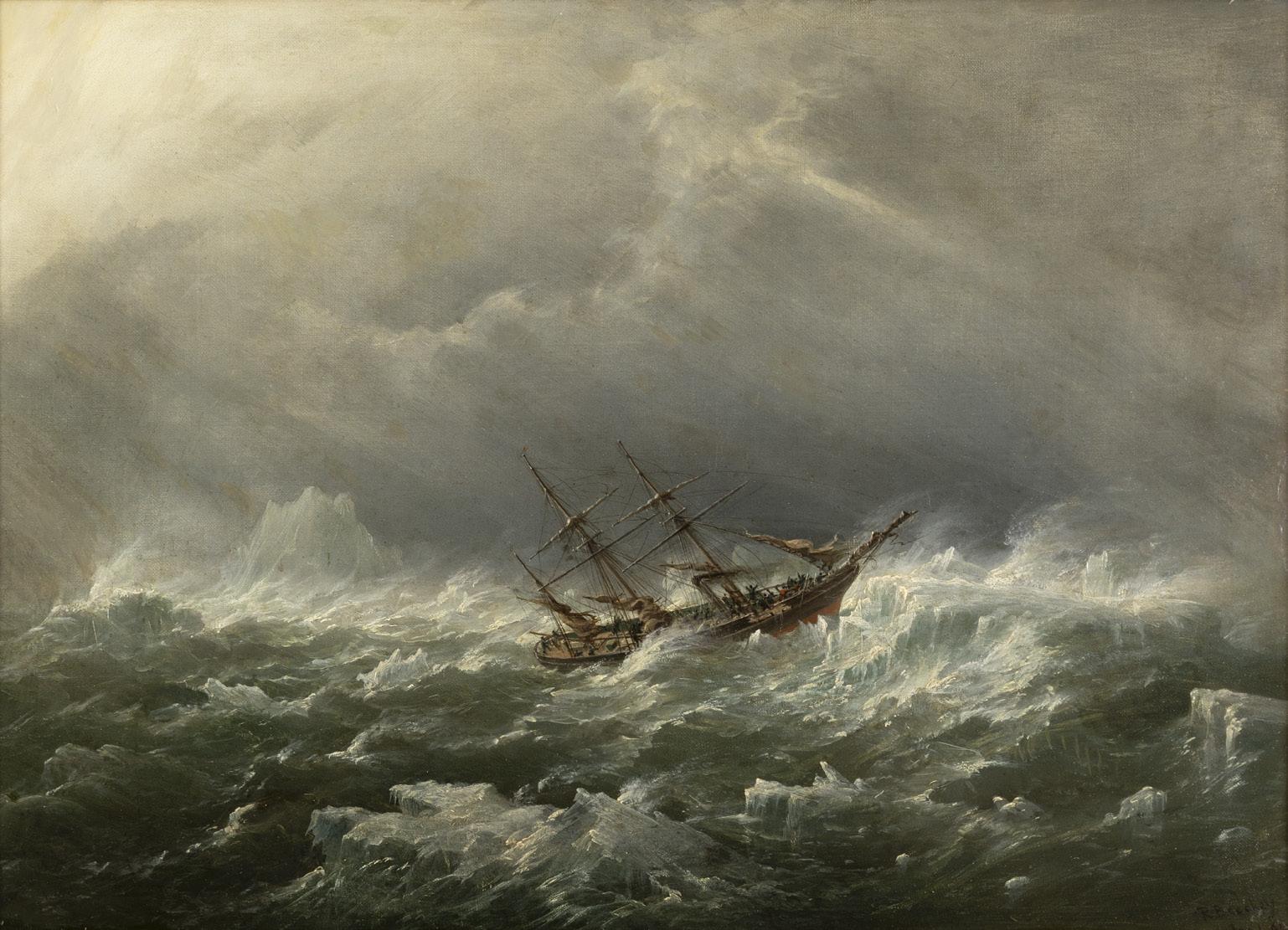
58
CAPTAIN RICHARD BRYDGES BEECHEY RHA (1808-1895)
Ship Struggling Amongst Icebergs
Oil on canvas, 40.5 x 56cm
Signed and dated Jan’1.61. (lower right)
€ 3,000 - 5,000
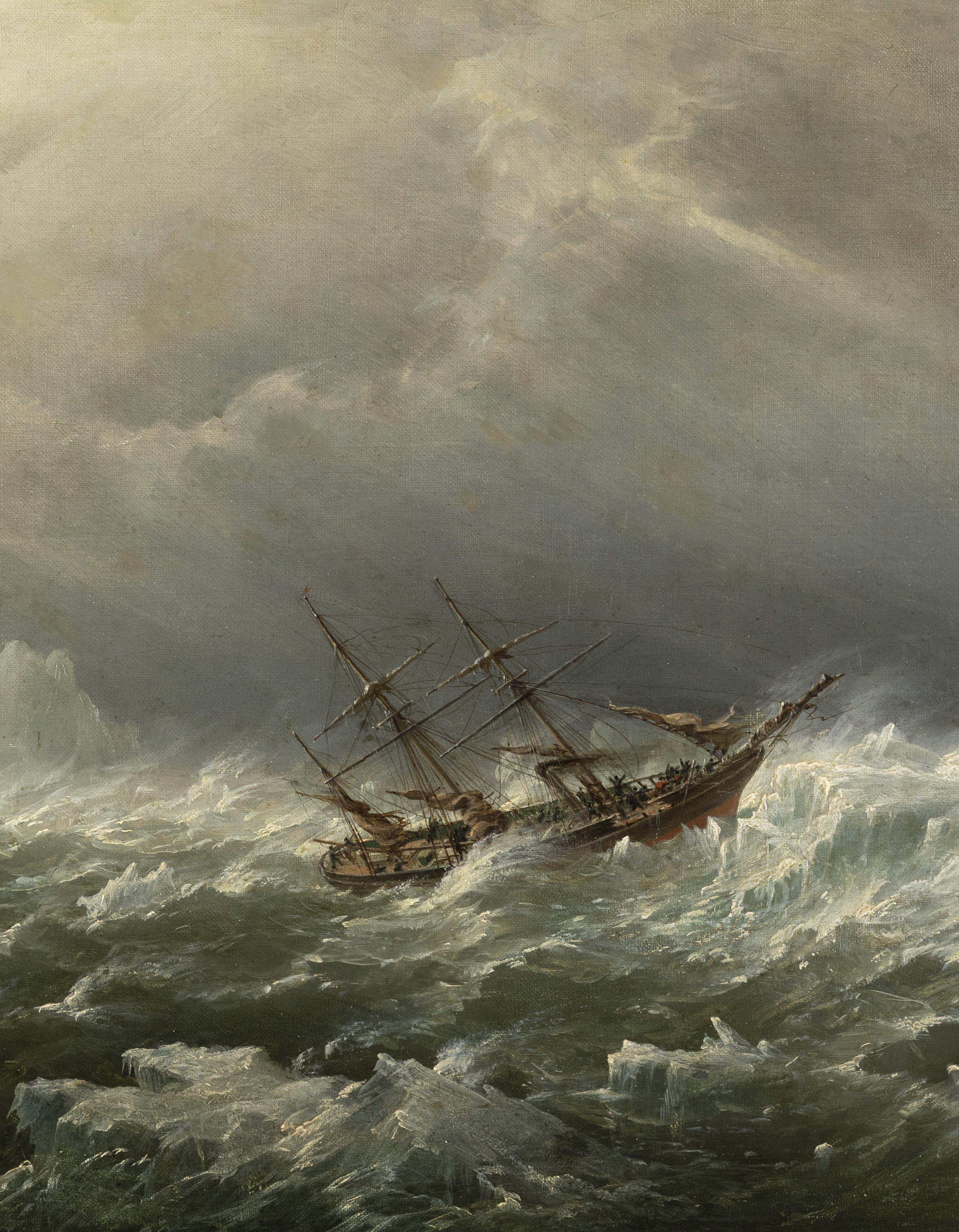
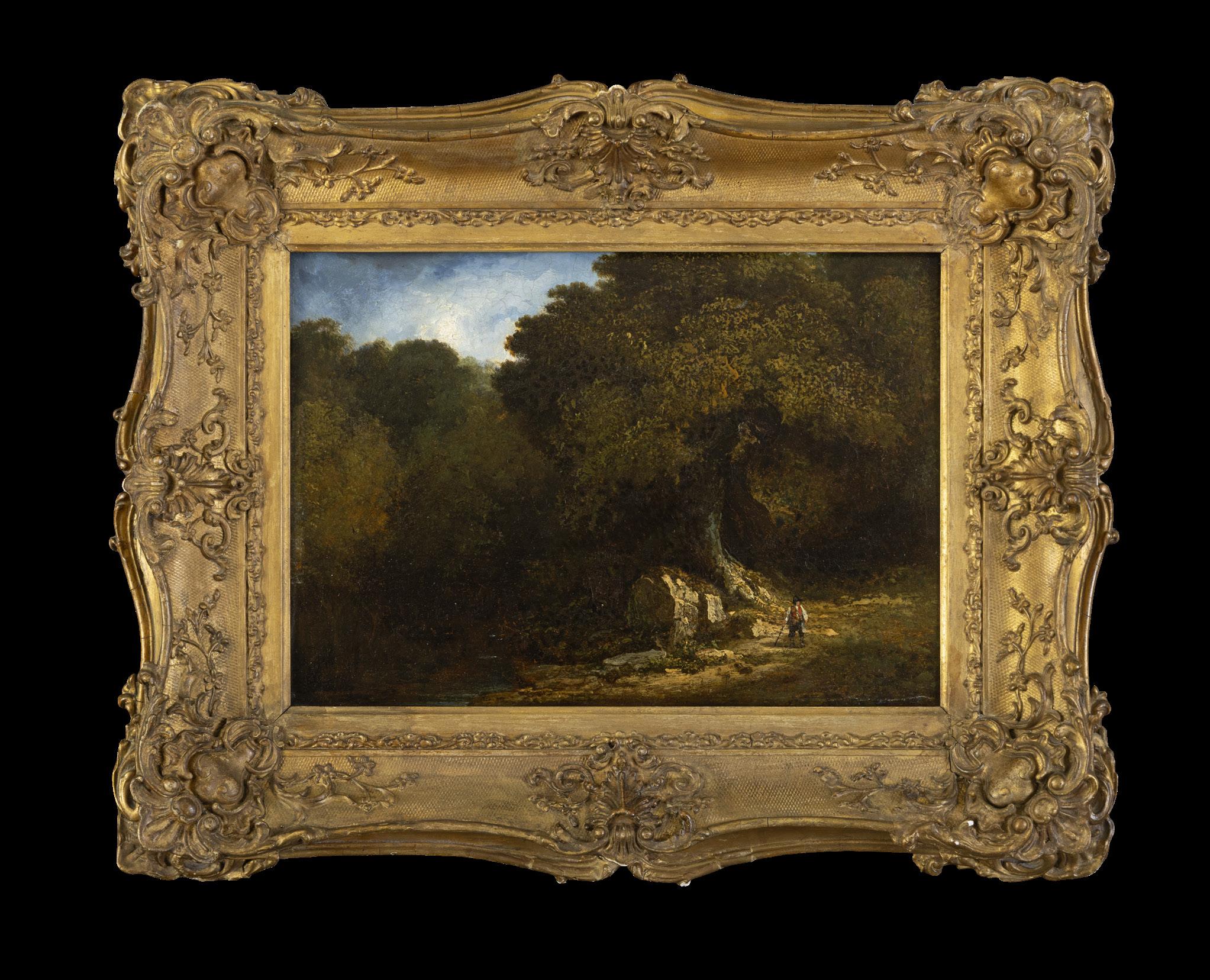
Wooded Landscape with a Figure by a Stream
Oil on wood, 19.5 x 27.5cm
Remnants of the artist’s signature ‘J.A…’, lower right
€ 4,000 - 6,000
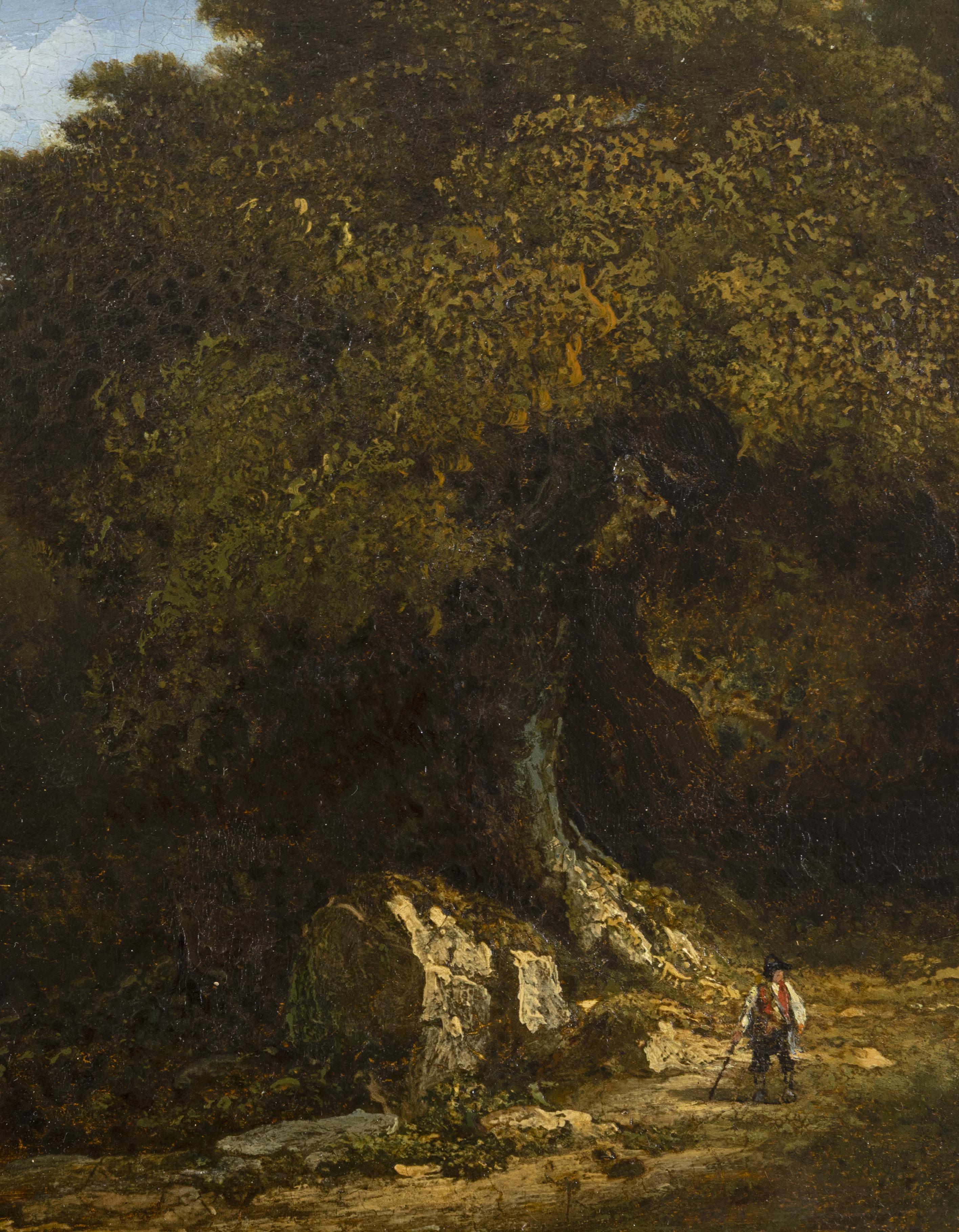
JAMES ARTHUR O'CONNOR (1792-1841)
A man with a dog walking on a path in a wooded landscape
Oil on canvas, 42 x 52cm
Signed and dated 1840 on a rock lower right centre
€ 10,000 - 15,000

SIR MARTIN ARCHER SHEE PRA (1769-1850)
Young Woman Resting in a Autumnal Wooded Landscape, Lavinia from James Thomson’s ‘The Seasons’
Oil on canvas, 77 x 64cm
€ 2,000 - 3,000
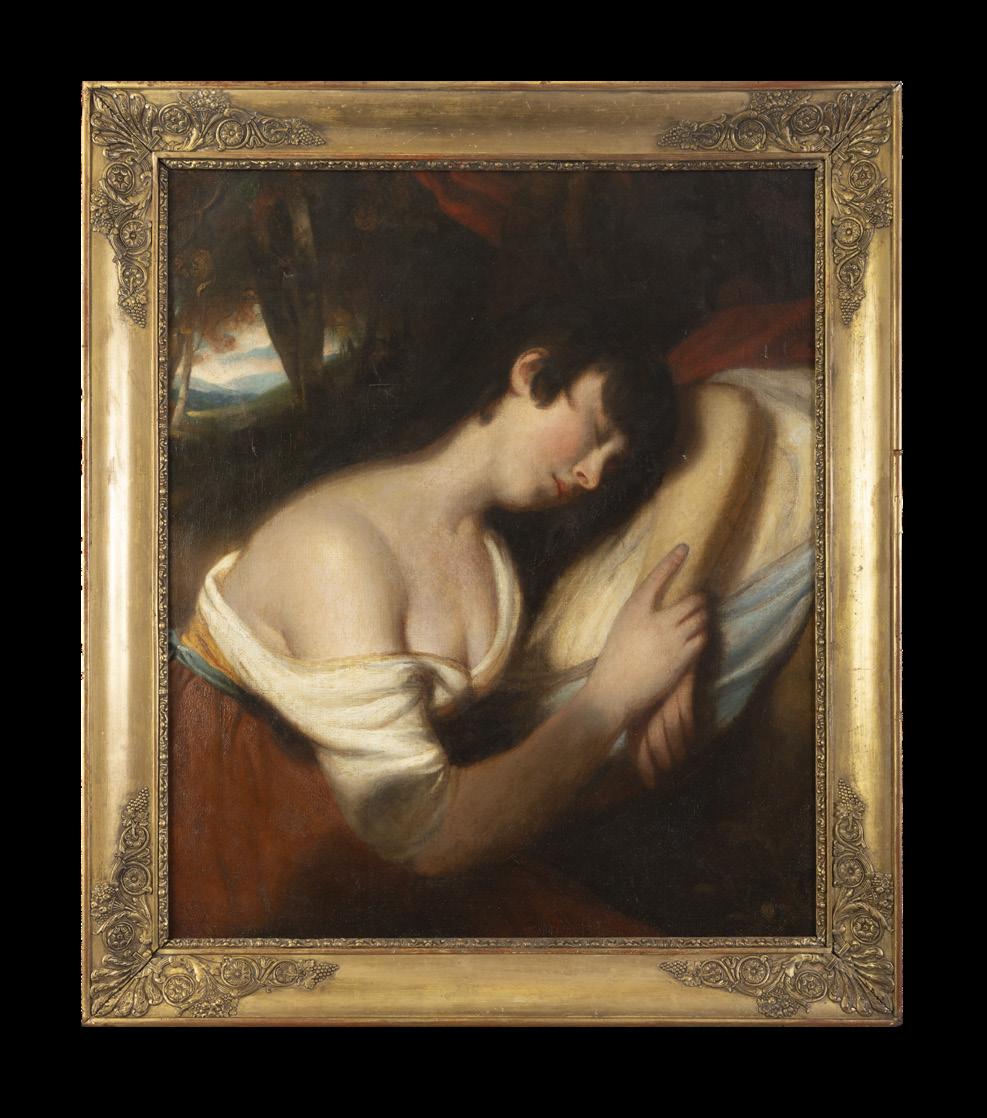

ELLEN CONOLLY
(FL.1873-1885)
A Fruit Seller of Cairo
Oil on canvas, 46 x 35.5cm
Signed, titled and inscribed with the artist’s address verso
€ 800 - 1,200
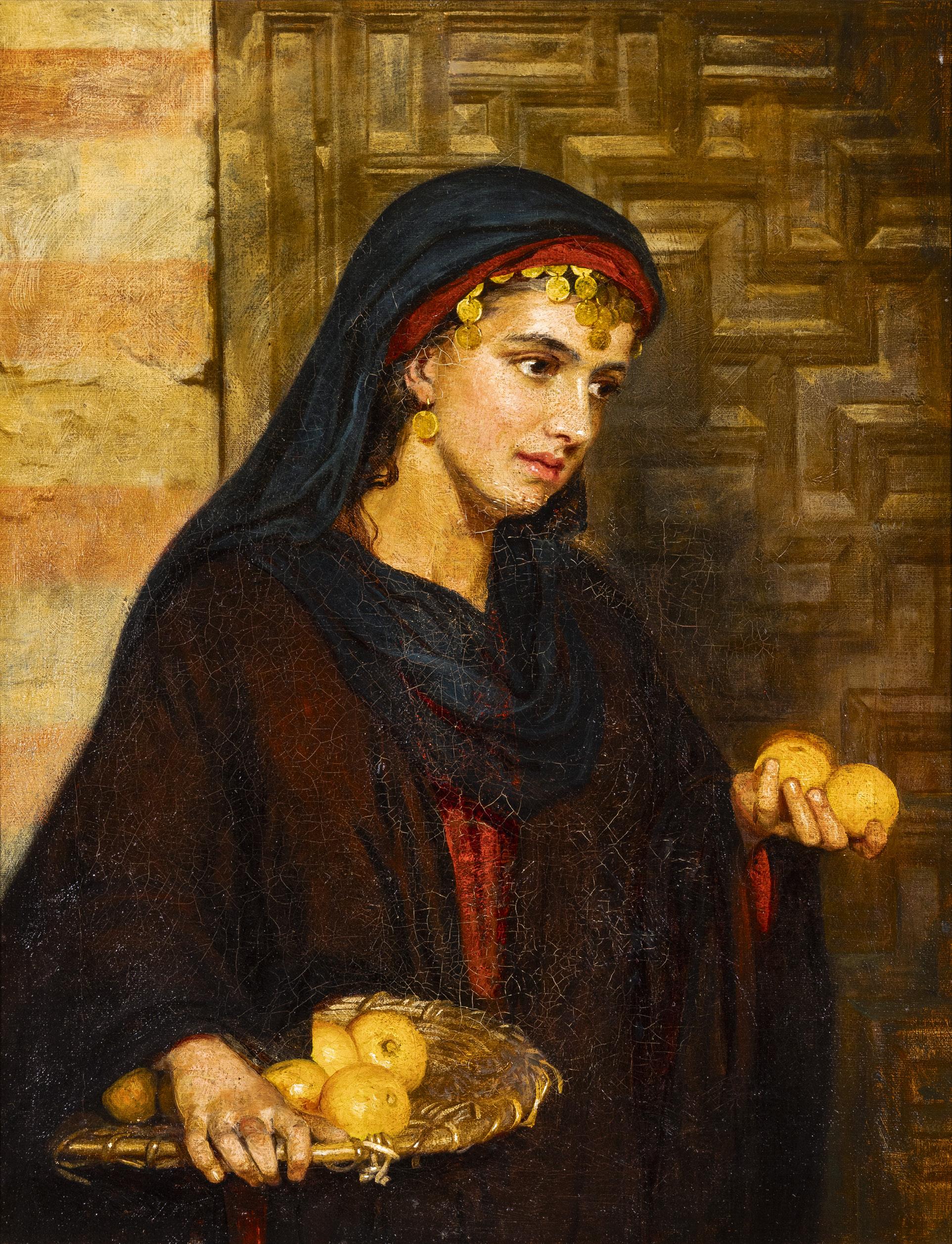
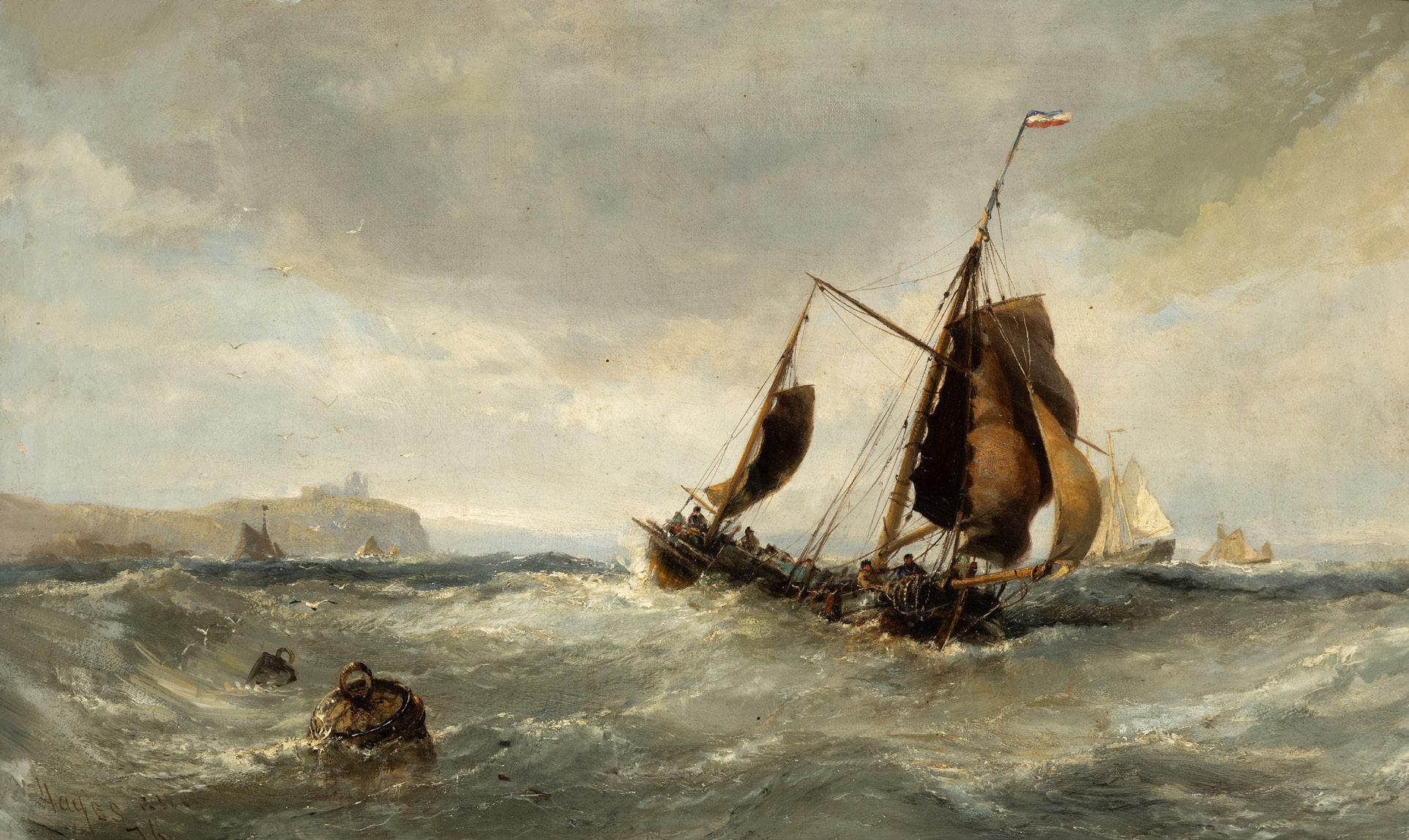
63
EDWIN HAYES, RHA RI ROI (1819-1904)
Dutch Boats Running Free off Tantallan Castle, Isle of Wight
Oil on canvas, 38cm x 61cm (15" x 24")
Bearing partial signature and dated '76 also signed and inscribed verso
Provenance: Homan Potterton - A Life of Collecting, Adam's, 7 September 2021, lot 99
€ 4,000 - 6,000
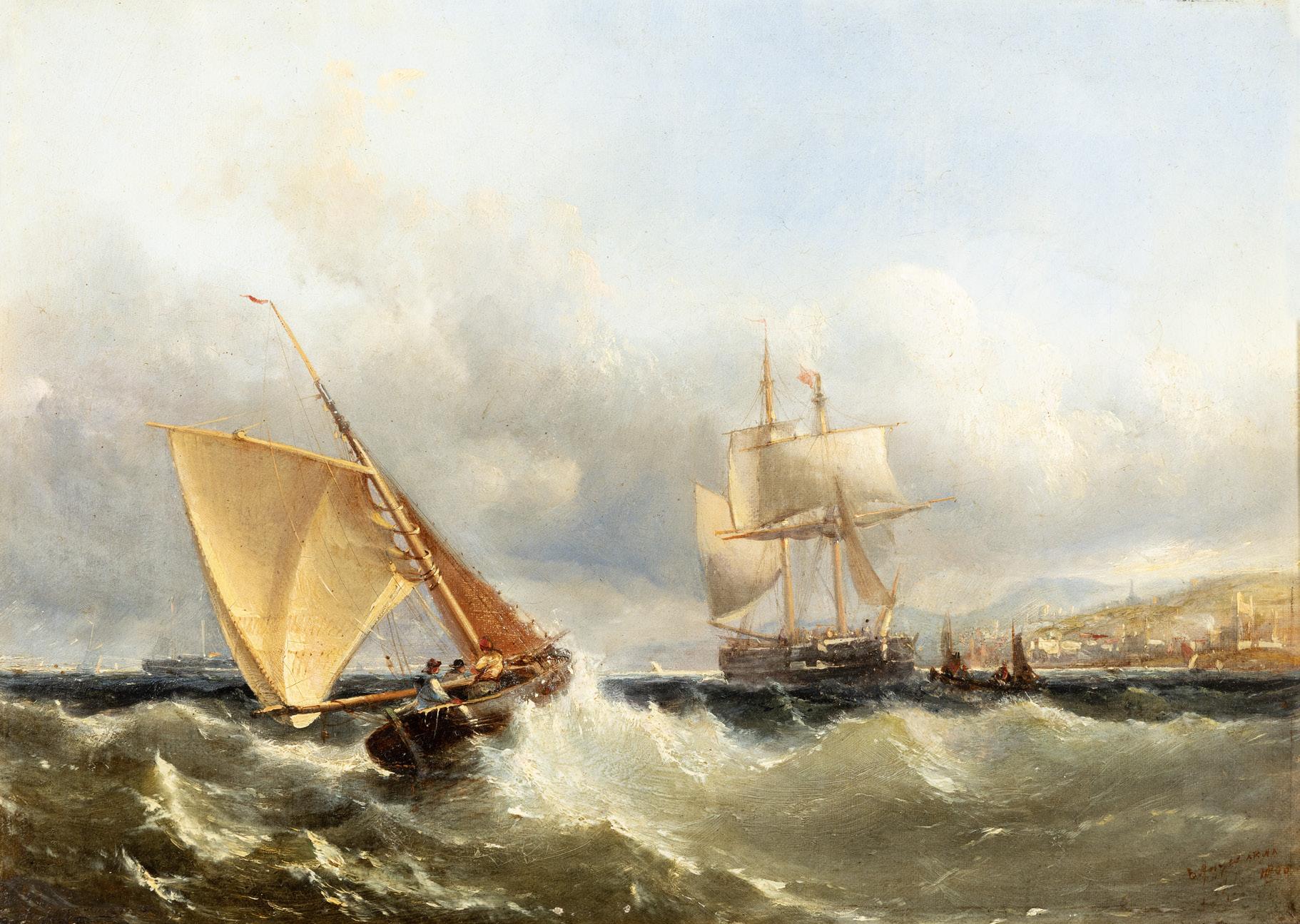
64
EDWIN HAYES, RHA RI ROI (1819-1904)
Fresh Breeze off Kingstown, Dublin Bay (1858)
Oil on canvas, 26 x 36cm
Signed and dated indistinctly 1858, also signed and inscribed verso with title on two labels verso, another label inscribed 'This picture came from Lord Meade' (sic)
Provenance: Sale, Adam's, 8 December 2021, Lot 39
€ 4,000 - 6,000

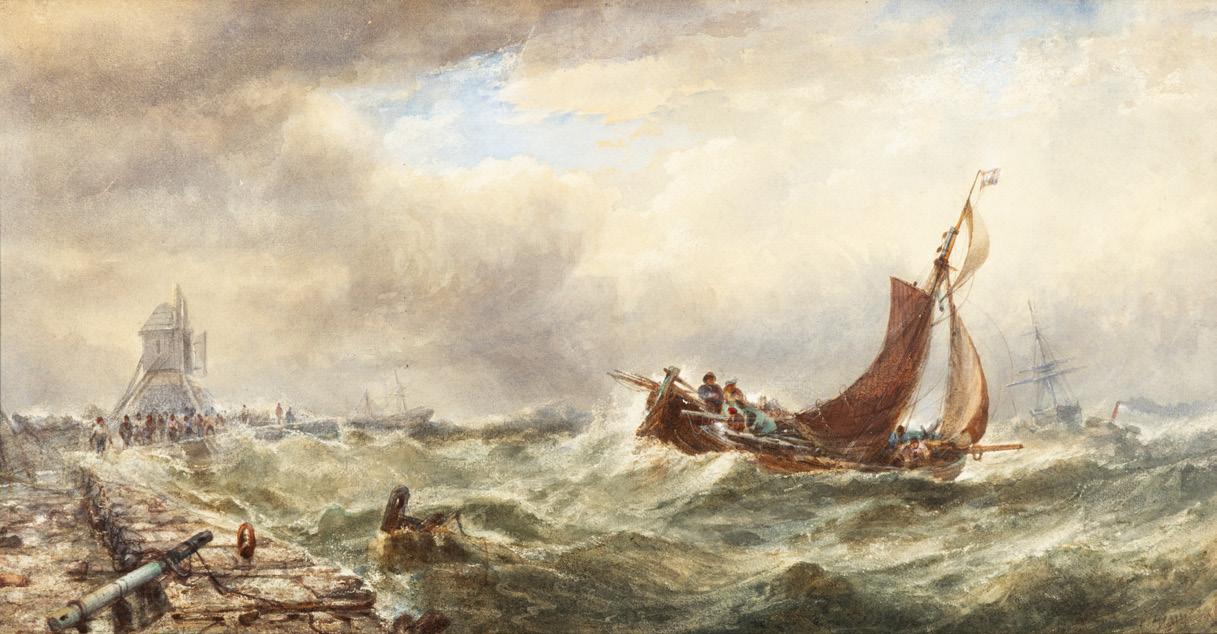
65
HOWARD HELMICK R.B.A.
(1840-1907)
Whiskey by the Hearth
Oil on wood, 30.5 x 25cm
Signed and dated (18)76
€ 1,500 - 2,000
66
EDWIN HAYES RHA (1819-1904)
Fishing Barges in a Rough Sea, Figures and Windmill Beyond
Watercolour on paper, 28 x 54cm
Signed
€ 1,000 - 1,500
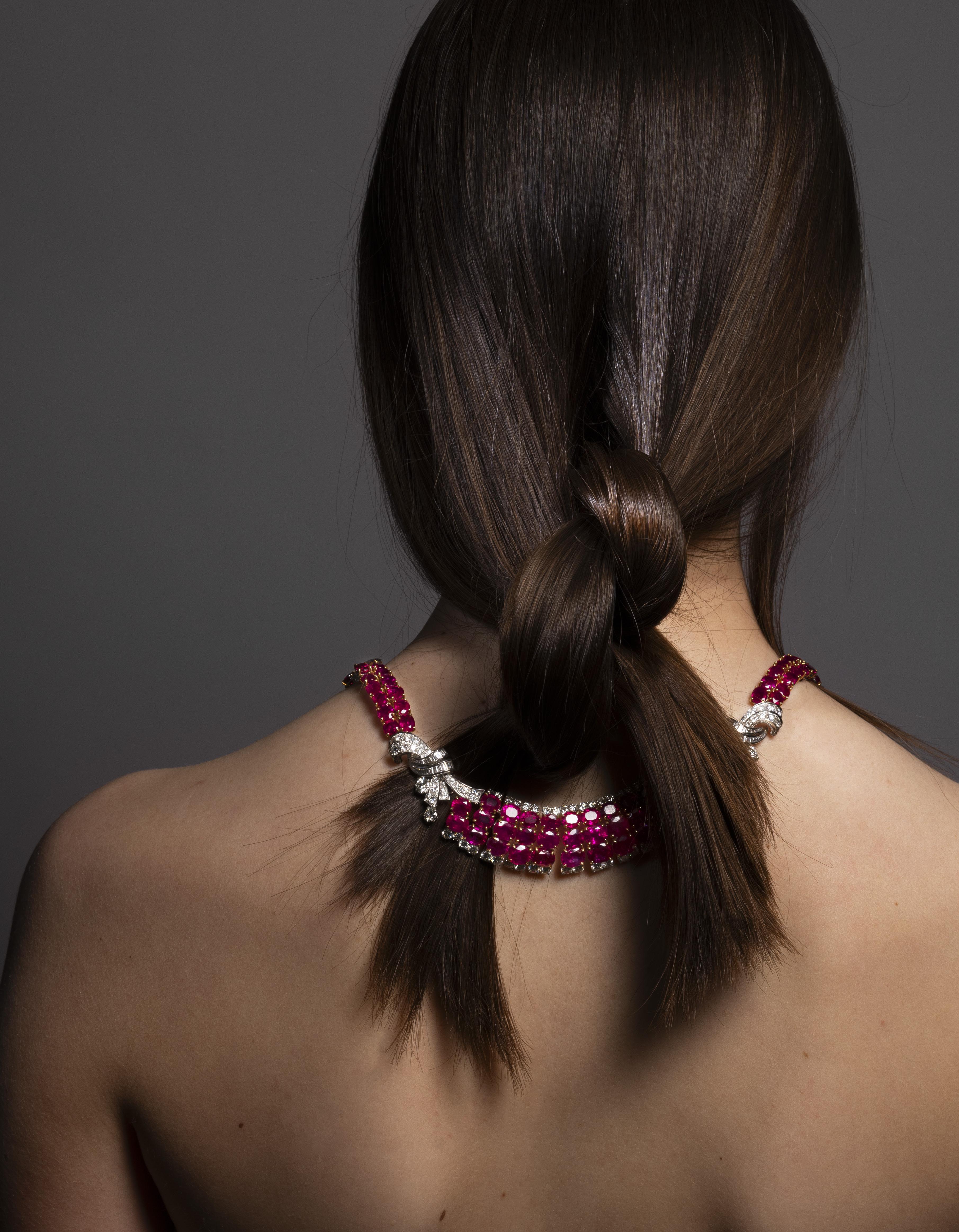
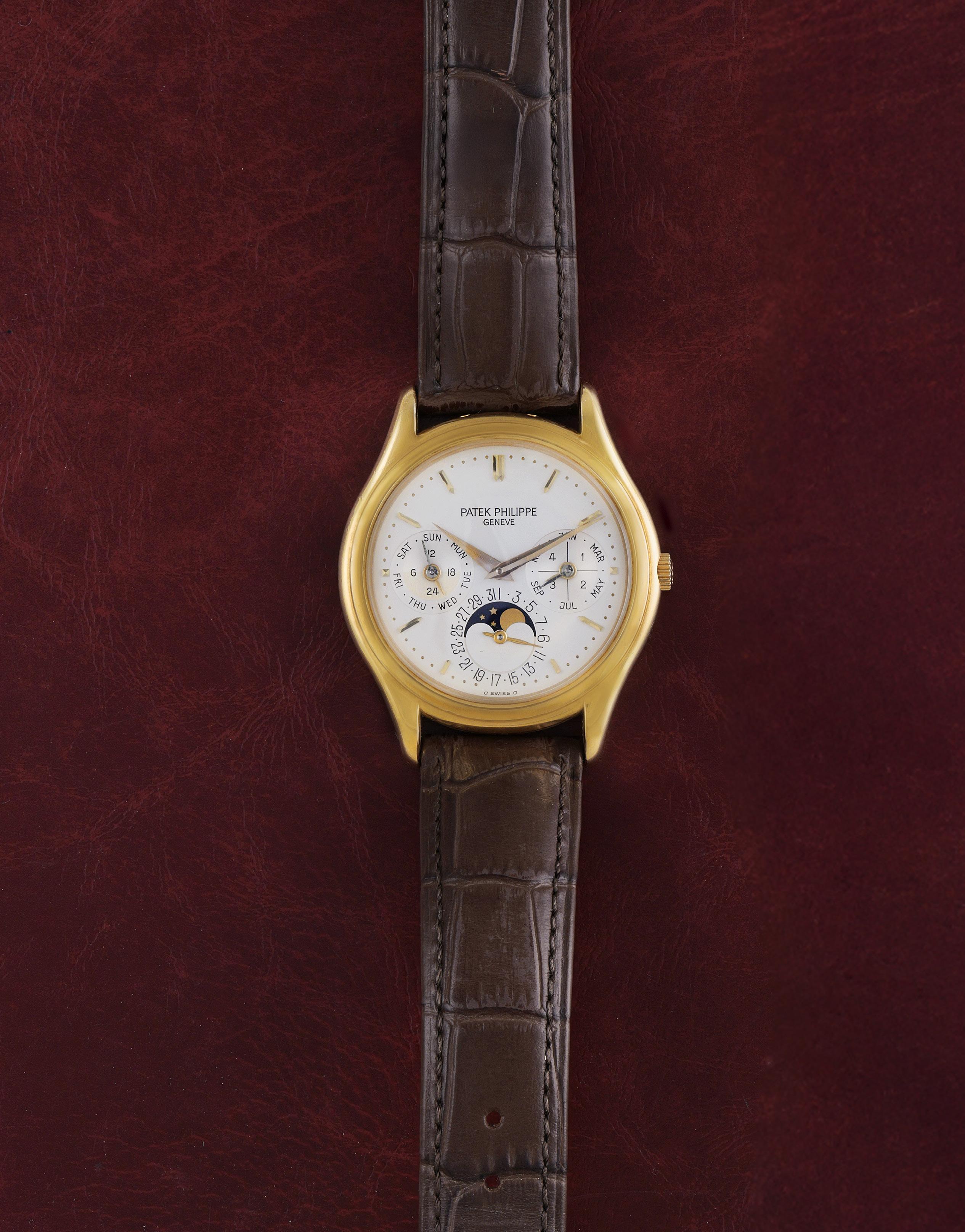
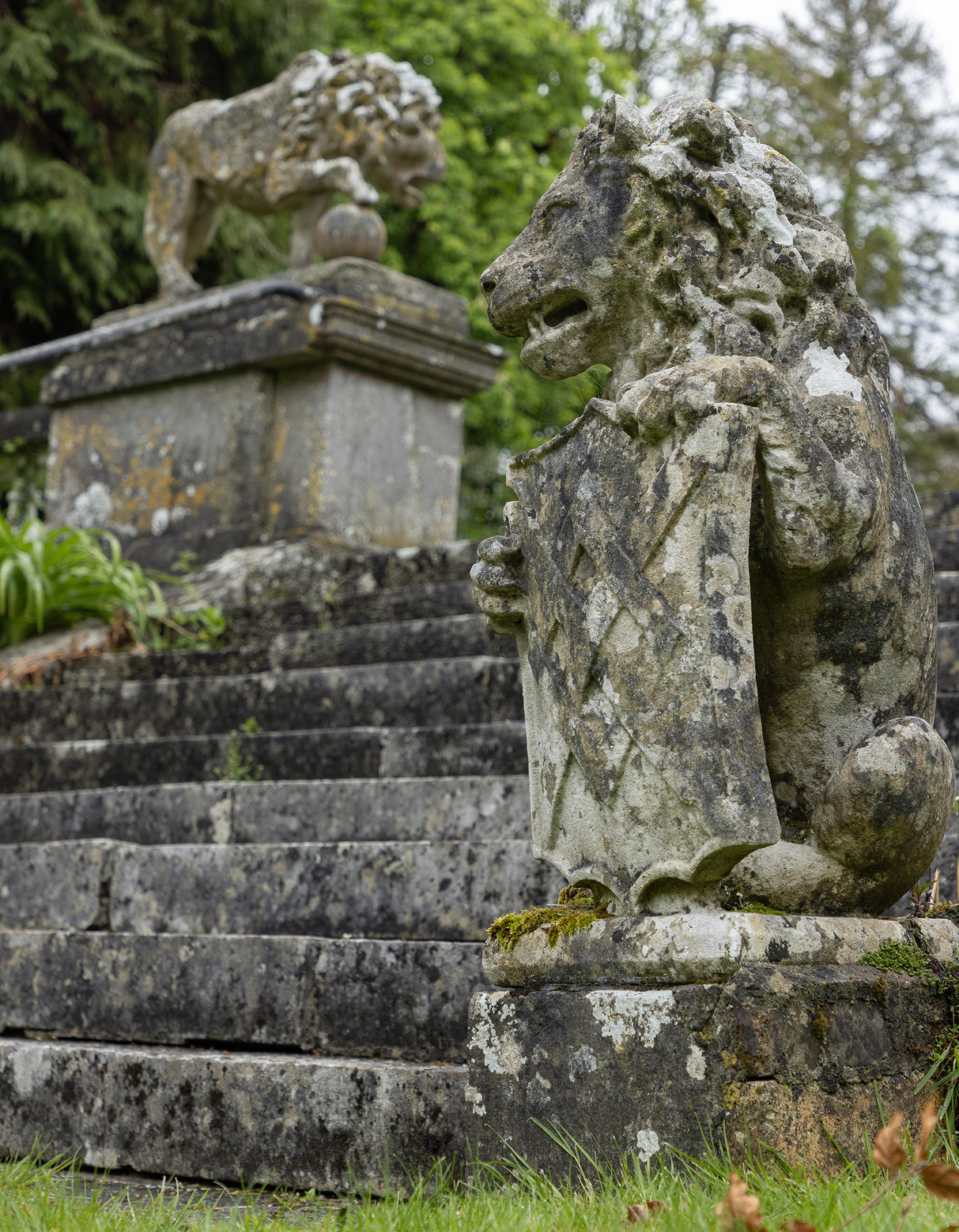
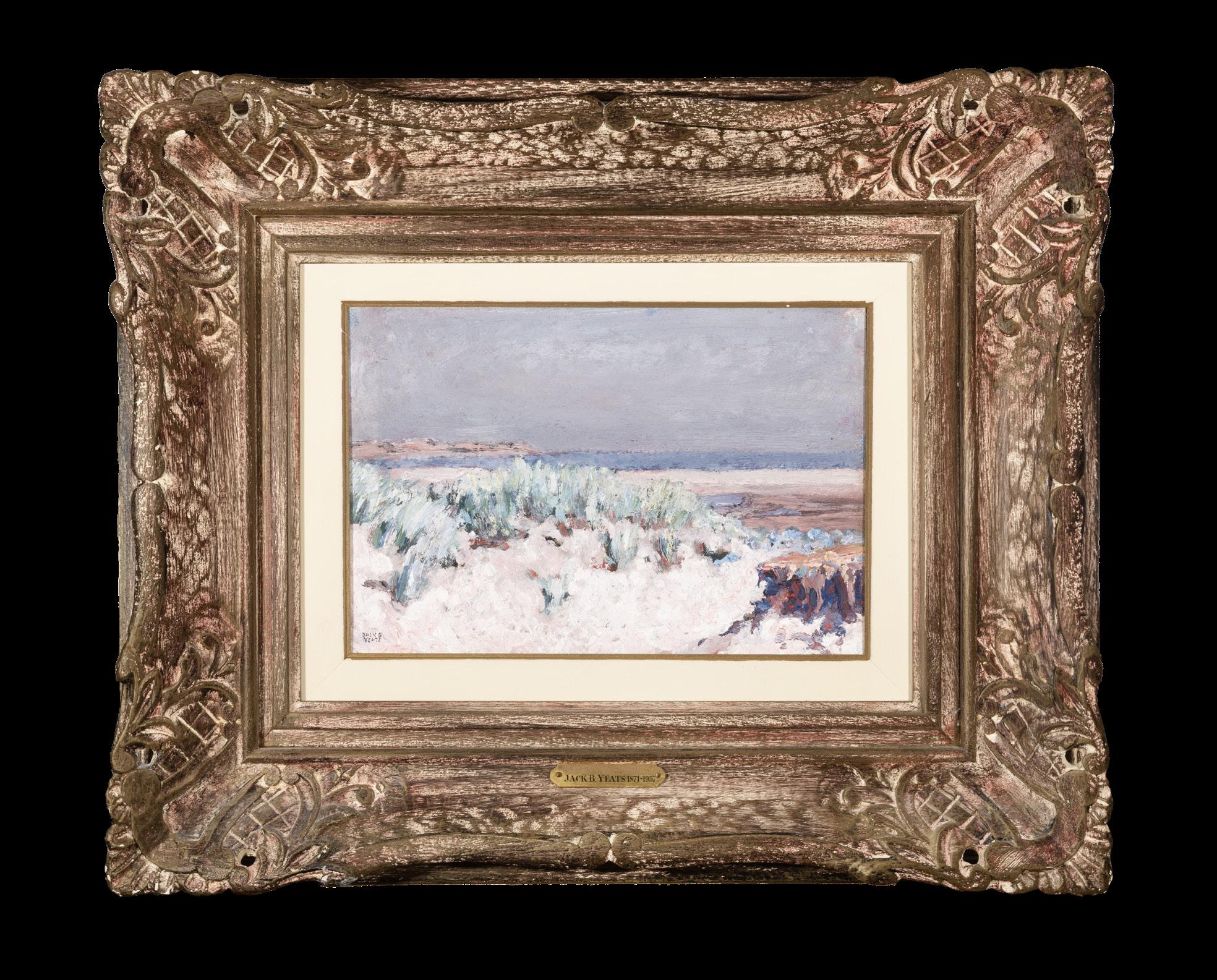
PAUL HENRY RHA RUA (1876-1958)
Mountain Landscape with Cottages c.1926-30
Jack Butler Yeats RHA (1871-1957)
Oil on board, 28 x 35.5cm (11 x 14’’)
Signed
€60,000 – 80,000 AUCTION WEDNESDAY 29TH MARCH 2023 IMPORTANT IRISH ART Auction Wednesday May 28th 2025
Hot Weather / A Hot Day
Oil on board, 19 x 27.5cm (7½ x 10¾”)
Signed
Estimate: €40,000 – 60,000
Enquiries: Nicholas Gore-Grimes at nicholas@adams.ie

LA MISSION HAUT-BRION
From the Cellar of Peter White
Estimate: €12,000 - €16,000
Price Realised: €36,250

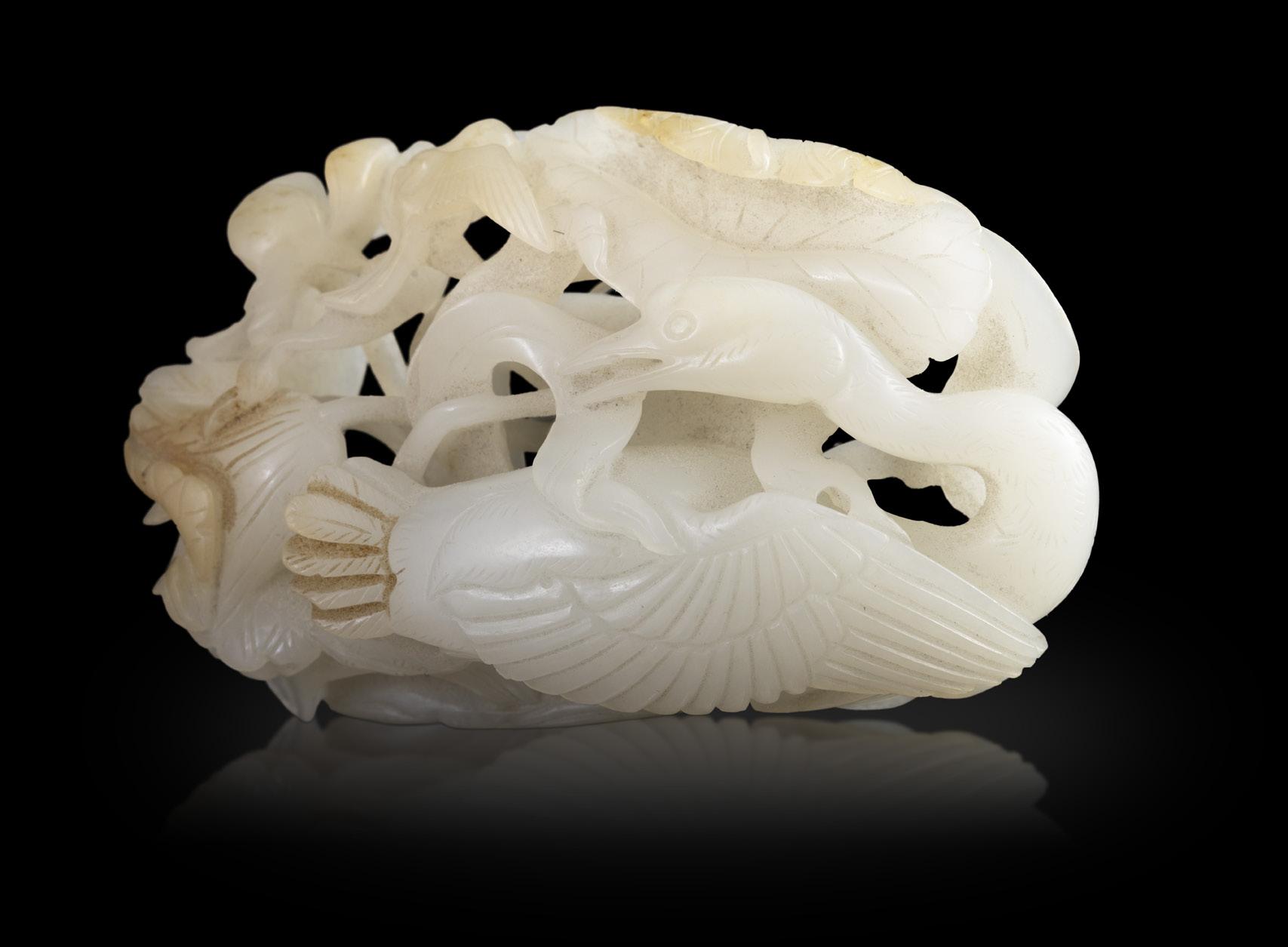
Auction Wednesday 25th June 2025 A RETICULATED WHITE JADE ‘EGRETS AND LOTUS’ GROUP 明代 青白玉透雕 ‘一路连科‘ China, Ming dynasty
Price realised: €42,500
Enquiries: Dr. Wei Wang
wei.wang@adams.ie

26 St. Stephen’s Green, Dublin 2. Ireland
+353 1 676 0261
info@adams.ie | www.adams.ie
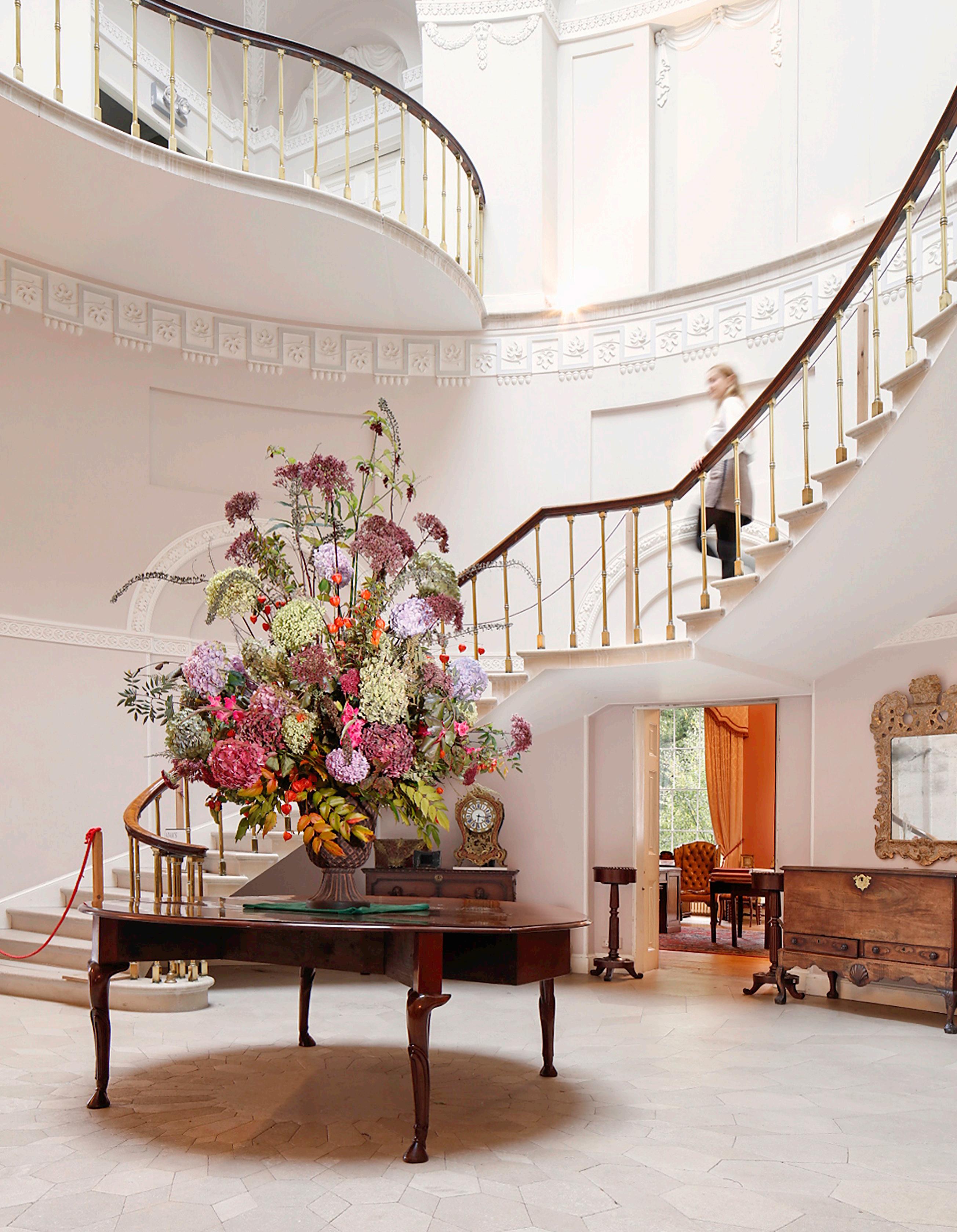
The Auctioneer carries on business on the following terms and conditions and on such other terms or conditions as may be expressly agreed with the Auctioneer or set out in any relevant Catalogue. Conditions 17-22 relate mainly to buyers and conditions 24-40 relate mainly to sellers. Words and phrases with special meanings are defined in condition 1. Buyers and sellers are requested to read carefully the Cataloguing Practice and Catalogue Explanations contained in conditions 2 and 8.
Definitions
1. In these conditions the following words and expressions shall have the following meanings:
‘Auctioneer’ – James Adam and Sons trading as Adam’s ‘Auctioneer’s Commission’ – The commission payable to the Auctioneer by the buyer and seller as specified in conditions 22 and 26.
‘Catalogue’ – Any advertisement, brochure, estimate, price list or other publication.
‘Forgery’ – A Lot which was made with the intention of deceiving with regard to authorship, culture, source, origin, date, age or period and which is not shown to be such in the description therefore in the Catalogue and the market value for which at the date of the auction was substantially less than it would have been had the Lot been in accordance with the Catalogue description.
‘Hammer Price’ – The price at which a Lot is knocked down by the Auctioneer to the buyer.
‘Lot’ – Any item which is deposited with the Auctioneer with a view to its sale at auction and, in particular, the item or items described against any Lot number in any Catalogue.
‘Proceeds of Sale’ – The net amount due to the seller being the Hammer Price of the Lot after deducting the Auctioneer’s Commission thereon under condition 26 the seller’s contribution towards insurance under condition 28, such VAT as is chargeable and any other amounts due by the seller to the Auctioneer in whatever capacity howsoever arising.
‘Registration Form or Register’ – The registration form (or, in the case of persons who have previously attended at auctions held by the Auctioneer and completed registration forms, the register maintained by the Auctioneer which is compiled from such registration forms) to be completed and signed by each prospective buyer or, where the Auctioneer has acknowledged that a bidder is acting as agent on behalf of a named principal, each such bidder prior to the commencement of an auction.
‘Sale Agreement Form’ – The sale agreement form to be completed and signed by each seller prior to the commencement of an auction.
‘Total Amount Due’ – The Hammer Price of the Lot sold, the Auctioneer’s Commission due thereon under condition 22, such VAT as is chargeable and any additional interest, expenses or charges due hereunder.
‘V.A.T.’ – Value Added Tax.
Cataloguing Practice and Catalogue Explanations
2.Terms regarding cataloguing practice used in catalogues have specific meanings, and attention is drawn to these explanations in each published catalogue.
Auctioneer Acting as Agent
3. The Auctioneer is selling as agent for the seller unless it is specifically stated to the contrary. The Auctioneer as agent for the seller is not responsible for any default by the seller or the buyer. The Auctioneer reserves the right to bid on behalf of the seller.
Auctioneer Bidding on behalf of Buyer
4. It is suggested that the interests of prospective buyers are best protected and served by the buyers attending at an auction. However, the Auctioneer will, if instructed, execute bids on behalf of a prospective buyer. Neither the Auctioneer nor its employees, servants or agents shall be responsible for any neglect or default in executing bids or failing to execute bids.
Admission to Auctions
5. The Auctioneer shall have the right exercisable in its absolute discretion to refuse admission to its premises or attendance at its auctions by any person.
Acceptance of Bids
6. The Auctioneers shall have the right exercisable in its absolute discretion to refuse any bids, advance the bidding in any manner it may decide, withdraw or divide any Lot, combine any two or more Lots and, in the case of a dispute, to put any Lot up for auction again.
Indemnities
7. Any indemnity given under these conditions shall extend to all actions, proceedings, claims, demands, costs and expenses whatever and howsoever incurred or suffered by the person entitled to the benefit of the indemnity and the Auctioneer declares itself to be a trustee of the benefit of every such indemnity for its employees, servants or agents to the extent that such indemnity is expressed to be for their benefit.
Representations in Catalogues
8. Representations or statements made by the Auctioneer in any Catalogue as to attribution, authorship, genuineness, source, origin, date, age, provenance, condition or estimated selling price or value is a statement of opinion only. Neither the Auctioneer nor its employees, servants or agents shall be responsible for the accuracy of any such opinions. Every person interested in a Lot must exercise and rely on their own judgement and opinion as to such matters.
Governing Law
9. These conditions shall be governed by and construed in accordance with Irish Law.
Notices
10. Any notice or other communication required to be given by the Auctioneer hereunder to a buyer or a seller shall, where required, be in writing and shall be sufficiently given if delivered by hand or sent by post to, in the case of the buyer, the address of the buyer specified in the Registration Form or Register, and in the case of the seller, the address of the seller specified in the Sale Agreement Form or to such other address as the buyer or seller (as appropriate) may notify the Auctioneer in writing. Every notice or communication given in accordance with this condition shall be deemed to have been received if delivered by hand on the day and time of delivery and if delivered by post three (3) business days after posting.
Conflict of Interest
11. The Auctioneer affirms that no conflict of interest exists that prevents him/her providing the property service for the Client.
Records
12. The Auctioneer will keep a record of the services provided on foot of any Agreement for 6 years. All financial records must be kept for 7 years.
Bank Account
13. The Auctioneer’s “Client Account” is held at: Bank of Ireland 39 St. Stephen’s Green Dublin 2
Client Monies
14. Any interest credited to the Client Account in respect of monies held by the Auctioneer will be dispersed in accordance with the Property Services (Regulation) Act 2011 (Client Moneys) Regulations 2012.
Complaints
15. Any complaint which the Client may have arising under this Agreement may be dealt with by Eamon O’Connor - email: e.oconnor@adams.ie - tel: +353 1 6760261. A response will issue within 10 working days of receipt of the complaint.
Where the Client is dissatisfied with the response to the complaint received from the Auctioneer, the Client may make a complaint to: Property Services Regulatory Authority, Abbey Buildings, Abbey Road, Navan, Co Meath, C15 K7PY.
Statement of obligations on the Auctioneer pursuant to section 42 and 43 of the Criminal Justice (Money Laundering and Terrorist Financing) Act 2010
16. The Auctioneer is obliged under sections 42 and 43 of the Criminal Justice (Money Laundering and Terrorist Financing) Act 2010 to report to An Garda Síochána and the Revenue Commissioners suspicious transactions and transactions involving places designated under section 32 of that Act. The maximum cash accepted per transaction is €8,000. For any cash payments in excess of €500, a PSRA cash origin form will have to completed.
Non-Payment or Failure to Collect Purchased Lots
17. If a buyer fails to pay for and/or collect any purchased Lot by the dates herein specified for payment and collection the Auctioneer shall, in its absolute discretion and without prejudice to any other rights or remedies it may have, be entitled to exercise one or more of the following rights or remedies without further notice to the buyer:
(a) To issue court proceedings for damages for breach of contract.
(b) To rescind the sale of that Lot or any other Lots sold to the buyer whether at that or any other auction.
(c) To resell the Lot or cause it to be resold whether by public auction or private sale. In the event that there is a deficiency between the Total Amount Due by the buyer and the amount received by the Auctioneer on such resale after the deduction of any necessary expenses the difference shall be paid to the Auctioneer by the buyer. Any surplus arising shall belong to the seller.
(d) To store (whether at the Auctioneer’s premises or elsewhere) and insure the purchased Lot at the expense of the buyer.
(e) To charge interest on the Total Amount Due at the rate of 2% over and above the base interest rate from time to time of Bank of Ireland or if there be no such rate, the nearest equivalent thereto as determined by the Auctioneer in its absolute discretion from the date on which the payment is due hereunder to the date of actual payment.
(f) To retain that Lot or any other Lot purchased by the buyer whether at the same or any other auction and release same to the buyer only after payment to the Auctioneer of the Total Amount Due.
(g) To apply sums which the Auctioneer received in respect of Lots being sold by the buyer towards settlement of the Total Amount Due.
(h) To exercise a lien on any property of the buyer in the possession of the Auctioneer for whatever reason.
Liability of Auctioneer and Seller
18. Prior to auction ample opportunity is given for the inspection of the Lots on sale and each buyer by making a bid acknowledges that he has, by exercising and relying on his own judgement, satisfied himself as to the physical condition, age and Catalogue description of each Lot (including but not restricted to whether the Lot is damaged or has been repaired or restored). All Lots are sold with all faults and imperfections and errors of description. None of the seller, the Auctioneer nor any of their employees, servants or agents shall be responsible for any error of description or for the condition or authenticity of any Lot. No warranty whatsoever is given by the seller or Auctioneer or by any of their employees, servants or agents in respect of any Lot and any condition or warranty express or implied by statute or otherwise is hereby specifically excluded.
19. Any amount paid by a buyer in respect of a Lot which, if it is proved within 3 years of the date of the auction at which it was purchased, to have been a Forgery shall be refunded by the seller subject to the provisions hereof, provided that:
(a) The Lot has been returned by the buyer to the Auctioneer within 3 years of the date of the auction in the same condition in which it was at the time of the auction together with evidence proving that it is a Forgery, the number of the Lot and the date of the auction at which it was purchased;
(b) The Auctioneer is satisfied that the Lot is a Forgery and that the buyer has and is able to transfer good and marketable title to the Lot free form any third party claims;
FURTHER PROVIDED THAT the buyer shall have no rights here under if:
(i) The description of the Lot in the Catalogue at the time of the auction was in accordance with the then generally accepted opinion of the scholars or experts or fairly indicated that there was a conflict of such opinion;
(ii) The only method of establishing at the time of the auction in question that the Lot was a Forgery would have been by means of scientific processes which were not generally accepted for use until after the date of the auction or which were unresonably expensive or impratical.
The buyer’s sole entitlement under this condition is to a refund of the actual amount paid by him in respect of the Lot. Under no circumstances shall the Auctioneer be liable for any damage, loss (including consequential, indirect or economic loss) or expense suffered or incurred by the buyer by reason of the Lot being a Forgery. The benefit of this condition shall be solely and exclusively for the buyer and shall not be assignable. The buyer shall for the purpose of this condition be the person to whom the original invoice in respect of the sale of the Lot is made.
Photographs
20. The buyer authorises the Auctioneer at any time to make use of any photographs or illustrations of the Lot purchased by the buyer for such purposes as the Auctioneer may require.
New VAT Regulations
21. All lots are sold within the Auctioneer’s VAT margin scheme. Revenue Regulations require that the buyer’s premium must be invoiced at a rate which is inclusive of VAT. This VAT is not recoverable by any VAT registered buyer.
Buyer’s Premium
22. The Auctioneer may also charge a fee to the purchaser “the buyer’s premium”. The buyer’s premium is a commission paid by the buyer to the Agent in addition to the sale price. The standard buyer’s premium shall be 25% inclusive of VAT, and may be subject to change.
Internet Bidding
23. These terms and conditions apply to all internet bidding at sales conducted by, or in conjunction with, Adam’s, covering both live auctions and online-only timed auctions. Internet bidding conditions are in conjunction to those which are covered in our General Terms and Conditions of Business.
Registration
Before you can bid via Internet Bidding, you must register to bid online by signing up for a ‘My Adam’s’ account. Bidders must be registered at least 24 hours prior to the start of any Sale or you may not be able to bid online in that Sale. You will be liable for any and all bids made via your account.
Internet Bidding Process
Each bid made online shall be final and binding as soon as you click the Bid button. The bidder holds sole responsibility for any bid submitted, including those made in error, and will be held liable for the full payment and collection of the lot if named the winning bidder.
In the event of a tie between a bid placed by you online and any other identical bid(s) (including bids made in person at the Sale, telephone bids, absentee bids, and other internet bids), it will be at the auctioneer’s discretion as to which bid shall be accepted.
Adam’s reserves the right to reject a registration to bid online, withdraw its permission for you to use Internet Bidding, or terminate an Internet Bidding account, for any reason at any time prior to, during or after a Sale without prior notice.
If you choose to use the Internet Bidding service, you do so entirely at your own risk. Adam’s does not take responsibility for any issues regarding internet bidding functionality or delays which may occur due to software or hardware complications.
Auctioneer’s Discretion
24. With regard to the sale of any Lot the Auctioneer shall have the following powers exercisable solely in the discretion of the Auctioneer.
(i) To decide whether to offer any Lot for sale or not.
(ii) To decide whether a particular Lot is suitable for sale by the Auctioneer and, if so, to determine which auction, the place and date of sale, the conditions of sale and the manner in which such sale should be conducted.
(iii) To determine the description of any Lot in a Catalogue.
(iv) To decide whether the views of any expert shall be obtained and to submit Lots for examination by any such experts.
(v) To determine what illustration of a Lot (if any) is to be included in the Catalogue.
Seller’s Warranty and Indemnity
25. The seller warrants to the Auctioneer and to the buyer that he is the true owner of the Lot or is legally authorised to sell the Lot on behalf of the true owner and can transfer good and marketable title to the Lot free from any third party claims. As regards Lots not held by the Auctioneer on its premises or under its control the seller warrants and undertakes to the Auctioneer and the buyer that the Lot will be available and in a deliverable state on demand by the Auctioneer or buyer. The seller shall indemnify the Auctioneer and the buyer or any of their respective employees, servants or agents against any loss or damage suffered by any of them in consequence of any breach of the above warranties or undertakings by the seller.
Commission
26. The Seller shall pay the Auctioneer commission at the rate of 10% on the Hammer Price of all Lots sold on behalf of the seller at Irish Art Sales and 17.5% on all other sales together with VAT thereon at the applicable rate. Minimum charges are detailed below. The seller authorises the Auctioneer to deduct from the Hammer Price, paid by the buyer, the Auctioneer’s Commission under this condition; VAT payable at the applicable rates and any other amounts due by the seller to the Auctioneer in whatever capacity howsoever arising. The seller agrees that the Auctioneer may also receive commission from the buyer pursuant to condition 22.
Minimum Charges: Each individual lot is subject to a minimum fee of €25.00 plus VAT.
27. Subject to the Auctioneer’s discretion, the seller shall be entitled prior to the auction to place a reserve on any Lot. All reserves must be agreed in advance by the Auctioneer and entered on the Sale Agreement Form or subsequently be confirmed in writing to the Auctioneer prior to auction. This also applies to changes in reserves. A reserve may not be placed upon any Lot under €500 in value. The reserve shall be the minimum Hammer Price at which the Lot may be sold by the Auctioneer. A reserve once in place may only be changed with the consent of the Auctioneer. A commission shall be charged on the ‘knock-down’ bid for Lots which fail to reach the reserve price. Such commission shall be 5% of the ‘knockdown’ bid (Buying In Fee). This commission and any VAT payable thereon must be paid before removal of the Lot after the auction. The minimum commission hereunder shall be €25 per lot. The Auctioneer may in its sole discretion sell a Lot at a Hammer Price below the reserve but in such case the Proceeds of Sale to which the seller shall be entitled shall be the same as they would have been had the sale been at the reserve.Unless a reserve has been placed on a Lot in accordance with the provisions set out above such Lot shall be put up for sale without reserve. In the event that any reserve price is not reached at auction then for so long as the Lot remains with the Auctioneer and to the extent that the Lot has not been re-entered in another auction pursuant to condition 36 the seller authorises the Auctioneer to sell the Lot by private treaty at not less than the reserve price. The Auctioneer shall ensure that in such a case those conditions herein which concern mainly the buyer shall, with any necessary modifications, apply to such sale.
Reserve Instructions
Fixed - sell at a pre-determined value, no higher than the low estimate Discretion - sell up to 10% below the low estimate
Wide Discretion - sell up to 30% below the low estimate
No Reserve - sell to the highest bidder
Sell - sell to the highest bidder at any amount irrespective of the Lot value
Loss Warranty
28. Unless otherwise instructed by the seller, all Lots deposited with the Auctioneer or put under its control for sale shall automatically be insured by the Auctioneer under the Auctioneer’s own fine arts policy for the median estimate, as determined solely at the Auctioneer’s discretion.The seller shall pay the Auctioneer a contribution towards such insurance at the rate of 1.5% of the Hammer Price plus VAT. If the seller instructs the Auctioneer not to insure a Lot then the Lot shall at all times remain at the risk of the seller who undertakes to indemnify the Auctioneer and hold the Auctioneer harmless against any and all claims made or proceedings brought against the Auctioneer of whatever nature and howsoever and wheresoever occurring for loss or damage to the Lot. The sum for which a Lot is covered for insurance under this condition shall not constitute and shall not be relied upon by the seller as a representation, warranty or guarantee as to the value of the Lot or that the Lot will, if sold by the Auctioneer, be sold for such amount. Such insurance shall subsist until
such time as the Lot is paid for and collected by the buyer or, in the case of Lots sold which are not paid for or collected by the buyer by the due date hereunder for payment or collection such due date or, in the case of Lots which are not sold, on the expiry of 7 days from the date on which the Auctioneer has notified the seller to collect the Lots.
Professional Indemnity Insurance
29. The Auctioneer holds PI Insurance with:
Insurer’s Name: Hiscox Insurance PLC
Address: The Hiscox Building, Peasholme Green, York, YO1 7PR, UK.
Duration of Agreement
30. Duration of this agreement shall commence from the the date of consignment, as recorded on the sale agreement/receipt, and shall continue in force until the property is either sold or collected (The Contract Period). If terminated before the end of the contract period, 30 days notice shall be given.
Termination of Agreement
31. The Agreement can be terminated at the complete discretion of the Auctioneer at any time, subject to the 30 days notice, as outlined in condition 30. A vendor is able to end an agreement at any point up to the sale of the Lot but will be held subject to charges for withdrawn Lots, as outlined in Article 35.
Recision of Sale
32. If before the Auctioneer has paid the Proceeds of Sale to the seller the buyer proves to the satisfaction of the Auctioneer that the Lot is a Forgery and the requirements of condition 19 are satisfied the Auctioneer shall rescind the sale and refund to the buyer any amount paid to the Auctioneer by the buyer in respect of the Lot.
Payment of Proceeds of Sale
33. It is a condition of sale that payment to the seller cannot be made unless the buyer has paid, and their funds cleared through our bank. The Auctioneer shall remit the Proceeds of Sale to the seller not later than 30 days after the date of the auction, provided however that, if by that date, the Auctioneer has not received the Total Amount Due from the buyer then the Auctioneer shall remit the Proceeds of Sale within 7 working days after the date on which the Total Amount Due is received from the buyer. If credit terms have been agreed between the Auctioneer and the buyer the Auctioneer shall remit to the seller the Proceeds of Sale not later than 30 days after the date of the auction unless otherwise agreed by the seller. If before the Total Amount Due is paid by the buyer the Auctioneer pays the seller an amount equal to the Proceeds of Sale then title to the Lot shall pass to the Auctioneer. If the buyer fails to pay the Auctioneer the Total Amount Due within 14 days after the date of the auction, the Auctioneer shall endeavour to notify the seller and take opinion of the Auctioneer feasible, shall endeavour to assist the seller to recover the Total Amount Due from the buyer provided that nothing herein shall oblige the Auctioneer to issue proceedings against the buyer in the Auctioneer’s own name. If circumstances do not permit the Auctioneer to take instructions from the seller or, if after notifying the seller, it does not receive instructions within 7 days, the Auctioneer reserves the right, and is hereby authorised by the seller at the seller’s expense, to agree special terms for payments of the Total Amount Due, to remove, store and insure the lot sold, to settle claims made by or against the buyer on such terms as the Auctioneers shall in its absolute discretion think fit, to take such steps are necessary to collect monies due by the buyer.
34. If the seller resides outside Ireland the Proceeds of Sale shall be paid to such seller in Euros unless it was agreed with the seller prior to the auction that the Proceeds of Sale would be paid in a currency (other than Euros) specified by the seller in which case the Proceeds of Sale shall be paid by the Auctioneer to the seller in such specified currency (provided that the currency is legally available to the Auctioneer in the amount required) calculated at the rate of exchange quoted to the Auctioneer by its bankers on the date of payment.
35. Once catalogued, Lots withdrawn from sale before proofing/publication of Catalogue will be subject to commission of 5% of the Auctioneer’s latest estimate of the auction price of the Lot withdrawn together with VAT thereon and any expenses incurred by the Auctioneer in relation to the Lot. If Lots are withdrawn after proofing or publication of Catalogue they will be subject to a commission of 10% of the Auctioneer’s latest
estimate of the auction price of the Lot withdrawn together with VAT thereon and any expenses incurred by the Auctioneer in relation to the Lot. All commission hereunder must be paid for before Lots withdrawn may be removed.
36. Where any Lot fails to sell at auction the Auctioneer shall notify the seller accordingly and (in the absence of agreement between the seller and the Auctioneer to the contrary) such Lot may, in the absolute discretion of the Auctioneer, be re-entered in the next suitable auction unless instructions are received from the seller to the contrary, otherwise such Lots must be collected at the seller’s expense within the period of 30 days of such notification from the Auctioneer. Upon the expiry of such period the Auctioneer shall have the right to sell such Lots by public auction or private sale and on such terms as the Auctioneer in its sole discretion may think fit. The Auctioneer shall be entitled to deduct from the price received for such Lots any sums owing to the Auctioneer in respect of such Lots including without limitation removal, storage and insurance expenses, any commission and expenses due in respect of the prior auction and commission and expenses in respect of the subsequent auction together with all reasonable expenses before remitting the balance to the seller. If the seller cannot be traced the balance shall be placed in a bank account in the name of the Auctioneer for the seller. Any deficit arising shall be due from the seller to the Auctioneer. Any Lots returned at the seller’s request shall be returned at the seller’s risk and expense and will not be insured in transit unless the Auctioneer is so instructed by the seller.
Photographs and Illustrations/Marketing Charges
37. The seller authorises the Auctioneer to photograph and illustrate any Lot placed with it for sale and further authorises the Auctioneer to use such photographs and illustrations and any photographs and illustrations provided by the seller at any time in its absolute discretion (whether or not in connection with the auction).
Catalogue illustrations are included at the discretion of the Auctioneer. Marketing charges will be calculated as a scaled fee, working off the hammer price as per the table below. All prices are subject to VAT at the standard rate.
€0-€500 hammer price
€501-€2999 hammer price
€3000 and above hammer price
Outlay Charges
€25
€50
€100
38. Where additional costs from third parties have acrued from the handling and selling of a Lot, the seller authorises the Auctioneer to deduct these charges from the Total Amount Due. These charges include, but are not limited to, charges concerning carriage, restoration, framing and repair and are set by the third party. Where the Lot is not sold, these charges will be billed directly to the client. VAT
39. It is presumed, unless stated to the contrary, that the items listed herein are auction scheme goods as defined in the Finance Act 1995.
Artist’s Resale Rights (Droit de Suite)
40. Government Regulations (S.1. 312/2006)
Under this legislation a royalty (droit de suite) is payable to living or deceased (up to 70 years from date of death) artists of E.U. Nationality on all works resold for €3,000 or more, other than those sold by the artist or the artist’s agent.
The resale royalty payable is calculated as follows:
From €3,000 to €50,000 4%
From €50,000.01 to €200,000 3%
From €200,000.01 to €350,000 1%
From €350,000.01 to €500,000 0.5%
Exceeding €500,000 0.25%
The total amount of royalty payable on any individual sale shall not exceed €12,500.
The seller is liable for payment (paragraph 7.1 of Government Regulations (S.1. 312/2006)) of this royalty on completion of the sale. The artist may request from the Auctioneer any information necessary to secure payment.
Unless otherwise directed by the vendor, the Auctioneer will automatically deduct the amount due from the proceeds of sale and will hold in trust for the artist or their representative the said sum.
Introduction
This guide outlines the Value Added Tax (VAT) treatment of lot(s) sold at auction through Adam’s. It covers the most common types of transactions, although other situations may arise. As every buyer’s situation is different, we cannot offer specific tax advice. In all cases the relevant tax legislation takes precedence. You are advised to, and are responsible for, obtaining independent tax advice where necessary.
Depending on the status of the lot, and your status as a buyer, VAT may be charged on the hammer price, the buyer’s premium or both. Any such taxes will be identified at lot level, therefore it is important to familiarize yourself with the key symbols below.
Most lot(s) are sold in accordance with the Irish Auctioneer’s Margin Scheme and accordingly VAT will not normally be charged on the hammer price. Adam’s must bear VAT on the Buyer’s Premium and hence will charge an amount in lieu of VAT at the standard rate on these premiums i.e., the invoiced buyer’s premium of 25% will therefore include the VAT. Said lots are identified with no symbol denoted beside the lot number.
A limited range of goods, including most books, are subject to a 0% rate of VAT and therefore no amount in lieu of VAT will be added to the Buyer’s Premium. Ɵ
Where Lots have been imported from outside the European Union, and are under a Temporary Admission Authorisation, they will be denoted by the symbol * shown beside the lot number in the catalogue. They may be subject to additional charges on the hammer price which should be the relevant prevailing rate in the jurisdiction of import on the date of importation.
No symbol This is an Irish Auctioneers Margin Scheme lot. 23% Irish VAT will be charged on the ‘buyers’ premium’ only and invoiced on an inclusive basis. Total payable 25%
* Lot imported under Temporary Admission. 13.5% Irish import VAT will be charged on the ‘hammer’ price and 23% Irish VAT will be charged on the ‘buyer’s premium’ and invoiced on an inclusive basis under Irish Auctioneer’s Margin Scheme rules. Total payable 38.5% (See below for more information)
0 VAT Zero-rated items (Ireland only) Total payable 20.325%
General
Exporting Lots from the European Union
Where a Lot is exported from the European Union in accordance with the conditions detailed below the VAT may be cancelled or refunded by Adam’s as follows: 1. Lots sold under the Auctioneers Margin Scheme – the amount charged in lieu of VAT on the buyer’s premium. 2. Lots under the Temporary Admission Authorisation - the amount charged in lieu of VAT on the buyer’s premium PLUS the prevailing Irish import VAT.
Original correct export document is required from the Irish Revenue Commissioners showing that the lot has been exported from the European Union.
A. Cancellation of VAT charges
Where a buyer instructs an Adam’s authorised carrier to facilitate the transportation of the lot then a zero-rated invoice can be issued. The proof of export in the form of an export declaration to the Irish Revenue Commissioners will be facilitated by Adam’s customs agent.
B. Refund of VAT Charges
Where a buyer makes their own arrangements for transportation of the lot(s), the buyer must pay for the lot(s) in full including all elements of the Irish VAT. ONLY upon receipt of satisfactory proof of export (i.e. a copy of the export declaration to the Irish Revenue Commissioners showing that the lot has been exported from the European Union) will Adams then refund to the Buyer the amount of VAT initially paid.
1. VAT TO BE REFUNDED MUST BE €50 OR MORE PER SHIPMENT
2. A PROCESSING FEE OF €20 (PLUS ANY APPLICABLE VAT) WILL APPLY.
Adam’s, upon request and for an administrative fee, may apply for a license to export your lot(s) outside of the EU.
Miscellaneous
1. Buyers from outside the European Union should note that upon importing lots to their final destination outside the European Union, local import VAT, import duties, sales taxes and/or use taxes may be payable. Please consult your local tax advisor.
2. If you purchase a lot which is under a Temporary Admission Authorisation (indicated by a * symbol and intend to export it from the European Union for repair, restoration or alteration, please contact Adams before collection. Failure to do so may result in the import VAT becoming payable immediately and Adam’s being unable to refund the VAT charged on deposit.
3. If you collect the Lot from Adams in Ireland with a view to “hand-carrying” it back to its final destination, you must pay the Irish VAT in full. Adams cannot cancel or refund the Irish tax in these circumstances.
